

All Destinations , Asia , Bali to London Overland , Kazakhstan , Mongolia , Overland Travel , Russia , train travel
How to travel from mongolia to kazakhstan by train.
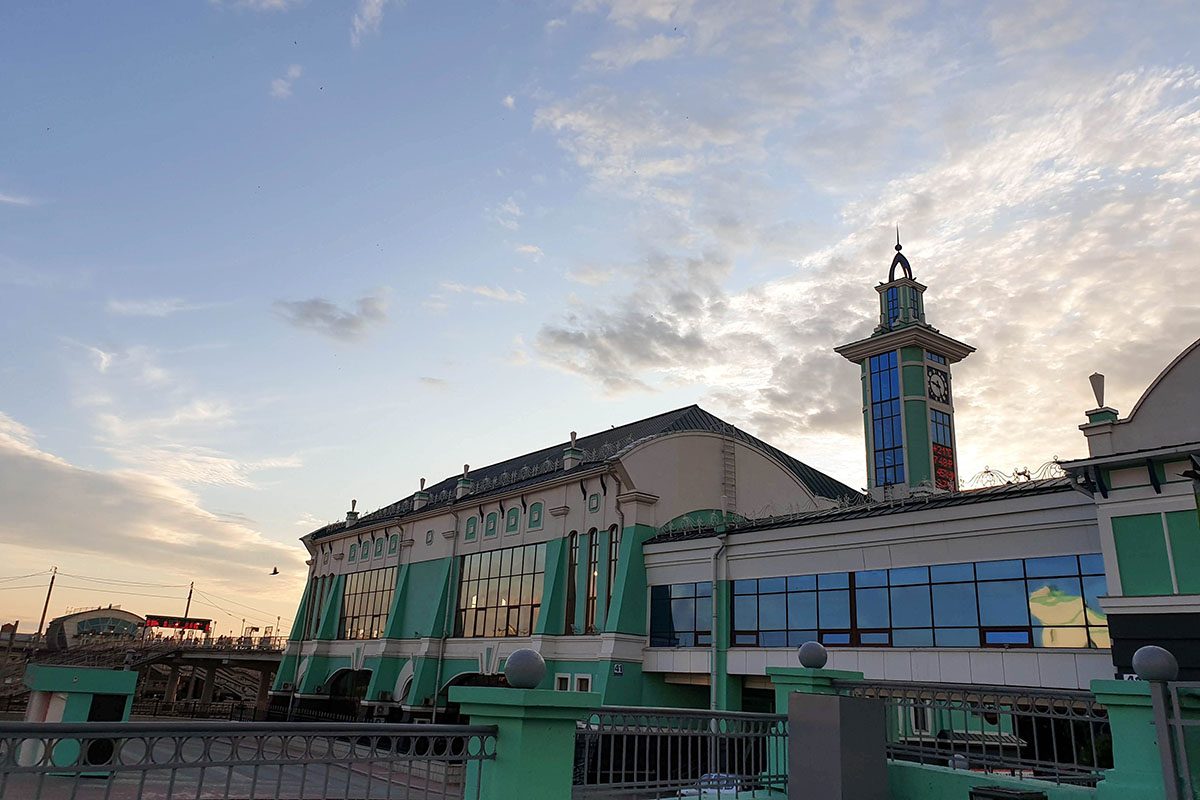
When I was overlanding from Bali to London, I wanted to go to Mongolia, and I wanted to go to Kazakhstan.
So I had to find out the best way to get from Mongolia to Kazakhstan, which obviously didn’t involve a flight.
Simple, right? Actually, it’s not that easy.
On a zoomed-out world map, it looks like the two large landlocked countries share a border – this is actually false.
Russia and China have a short border between the two countries, making travel between Mongolia and Kazakhstan without a third country impossible.
So, I had to assess my options.
How to get from Mongolia to Kazakhstan without flying
From my research, I found two ways to get to Kazakhstan from Mongolia:
- A bus from Olgii, a city in west Mongolia, that travels to Astana via Russia. This is a cheaper option, but it is unreliable – only leaving every 7-10 days, making visa planning a logistical nightmare. Also, getting to Olgii from Ulaanbaatar is difficult.
- A train from Ulaanbaatar to Novosibirsk, and then a train from Novosibirsk to Astana. The trains are a lot more reliable, and reliability is important when securing a Russian transit visa.
So, I chose the second option.
How to take the train from Mongolia to Kazakhstan
I took a train from Mongolia to Kazakhstan via Russia.
The process was relatively straightforward, but there are a few things that are very important to know in advance (like the fact you need to book all your tickets and get a Russian transit visa – you won’t get far without that!).
So I thought I’d share my newfound Mongolia to Kazakhstan train knowledge with the world, for anyone doing a madcap overland journey like mine – or for anyone else who really likes trains.
Book Your Trains
You need to book your trains for the whole journey from Mongolia to Kazakhstan before you apply for a Russian transit visa.
You’ll need to take the tickets with you when you apply for the visa.
After speaking with a Russian Railways agent, I decided that the best option would be to take a train to Novosibirsk from Ulaanbaatar, and then a train from Novosibirsk to Astana in Kazakhstan.
If you want to explore some of Russia on this trip, you’ll need to get a tourist visa which are generally only available in your country.
Your intentions have to be ‘transit only’ for your transit visa to be approved – this means that you need to go for the shortest route with the least amount of changes possible, which at this moment is Ulaanbaatar – Novosibirsk – Astana.
You are allowed to stay 1-2 nights in your transit city – I just booked a night to be safe and spent a day in Novosibirsk. So, my train schedule looked like this:
- 28 th – 30 th June – train from Ulaanbaatar – Novosibirsk
- 30 th June – 1 st July – one night in Novosibirsk
- 1 st July – 3 rd July – train from Novosibirsk to Astana
I booked on Russian Railways.
The train from Ulaanbaatar to Novosibirsk is expensive – it’s part of the Trans-Mongolian route and does take 2 days and 5 hours, which partially explains it. I paid around £200 for the first leg, and £60 for the second.
Get your Russian Transit visa
Unless you’re from a visa-free country, you’ll need a visa to enter Russia for any amount of time.
Transit visas are easily obtainable from Ulaanbaatar – the form and documents they need are a bit time-consuming to sort but the actual application process is really easy and the staff are very nice and helpful.
You can check out up to date information about getting a Russian transit visa in Ulaanbaatar on this forum.
What to do in Ulaanbaatar

I’d recommend 2-3 days in Ulaanbaatar to see all of the best attractions there.
I spent a week there, which was way too much time, but did mean that I could see some of the best day and overnight trips from Ulaanbaatar, like Terelj National Park and Hustai National Park, as well as spend a night in a traditional yurt.
Most travellers to Mongolia will spend time in the Gobi Desert or elsewhere in the country. I spent basically my whole time in Ulaanbaatar, which is unadvisable (there’s a lot more to the country!), but I’d definitely recommend spending at least 2-3 weeks in Mongolia to see all of its best attractions .
Most people visit Mongolia on a guided tour, because it is a rather difficult country to travel in independently. You can click here for details of a GAdventures sustainable guided tour.
Where to Stay in Ulaanbaatar
Get the train from ulaanbaatar.
The train from Ulaanbaatar to Novosibirsk is part of the trans-Mongolian railway that travels all the way to Moscow. You’ll notice a lot of foreigners on this route! But it still feels pretty authentic.
My train left Ulaanbaatar at 15:30 – this might change depending on the season. By 4pm we were in the steppe, wonderful scenery improved by a glowing sunset.
We stopped a few times in Mongolia, at tiny stations which served small communities and eventually approached the Russian border in darkness at about 11pm.
The Russian Border
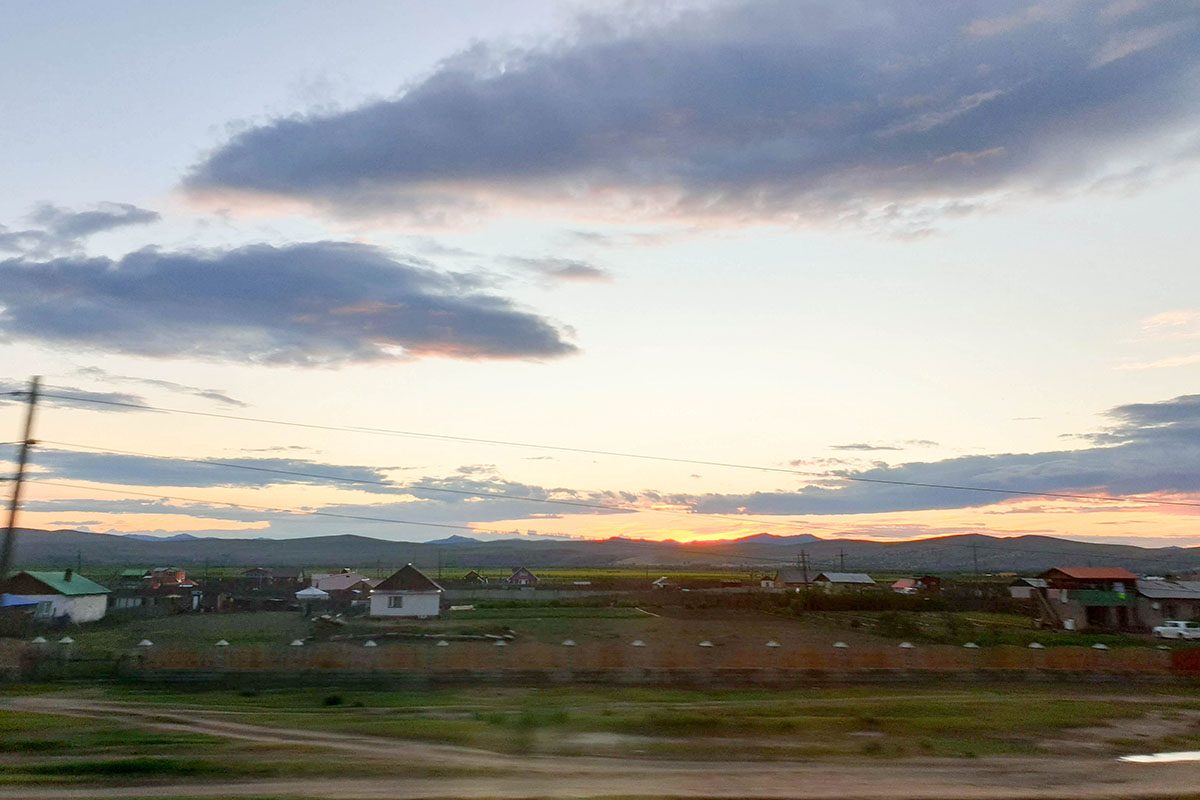
Russian customs are, as you can probably guess, intense.
We didn’t need to get off the train, but just handed our passports over which were checked with the visas and then taken to be scanned.
Our cabin was searched manually and by sniffer dogs. We were asked if we had any narcotics or any other banned items, and had to fill in a declaration form stating that everything we had was indeed permitted.
Once all of that fun was over, we waited for a rather long time, and the train trundled away from the border at exactly when it was supposed to – around 2:10am. Exhausted, I fell into my bunk and settled into sleep.
Welcome to Siberia!

My cabin mates and I woke up at around 10:30am, opened the blind and were greeted by probably one of the most beautiful sights I’ve ever seen from a train cabin (and I’ve been on a lot of trains).
The train was curving around Lake Baikal, with a beautifully sunny sky above us reflecting in the huge body of water. It was a really wonderful welcome to Siberia.
My cabin mates left the train in Irtkusk at about 1pm, which is thought to be the gateway to Lake Baikal and somewhere that I’ll definitely be returning to.
I still had over 24 hours on the train, so I did a little cabin spring clean and waited for my new neighbours.
Except, for some reason my new neighbours never came.
I don’t know why exactly, but the train was nearly empty! So I ended up with an entire cabin to myself for the remainder of the journey – which was quite nice, especially when I wanted to sleep or have some quiet time, although I would also have liked to meet some locals!
I did, however, have some friends on the train, so the rest of my trans-Mongolian journey was spent hopping cabins to see them, trying out the food in the dining car, reading and writing, and just enjoying the view.
The most remarkable thing about Siberia in the summer is just how light it is. It wasn’t fully dark until 11pm, and then started to get light again around 3am.
I woke up at 3:30am and it was bright as day – then I realised the time and went straight back to bed! You can see more about my trip in the video I made here:
Stop Over (Most Likely in Novosibirsk)

The most sensible stopover option when booking my tickets seemed to be Novosibirsk. This is the third-largest city in Russia (after Moscow and St Petersburg) and the capital of Siberia.
There aren’t a huge amount of tourist attractions in the city, and certainly not many tourists, but I was very impressed with the level of English and was also very happy just walking around the city and thinking ‘holy sh*t I’m in Russia’. So that’s what I did.
Things to do in Novosibirsk
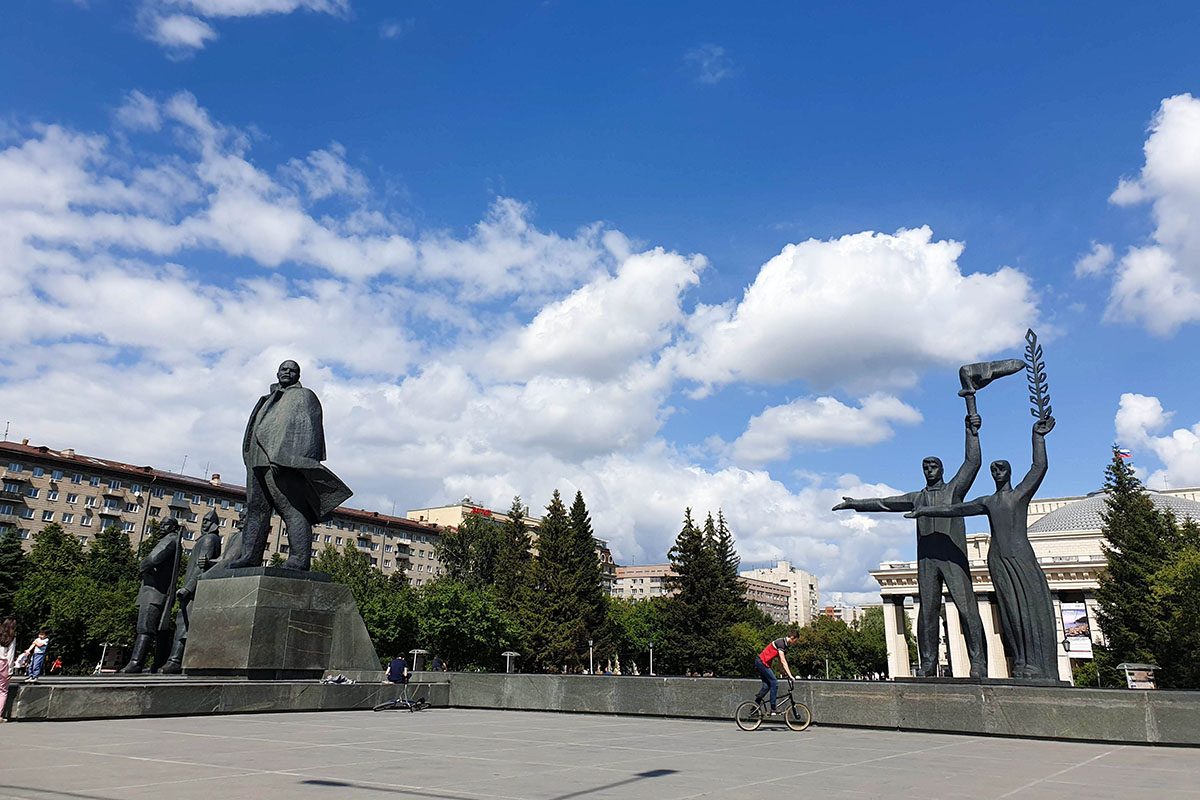
- Lenina Square is the main centre of Novosibirsk, and a fantastic place to people watch.
- The USSR Museum depicts life in the Soviet Union, with all sorts of funky memorabilia transporting right back to the days of the USSR.
- The N. K. Rerikh Museum documents one of Russia’s most famous artists, writers and philosophers. He travelled a lot, which is reflected in his work here, and is an interesting character to learn about.
- The Alexander Nevsky Cathedral is one of the most impressive buildings of Novsibirsk – and was one of the first buildings in the city to be constructed from stone. It’s definitely worth the detour to check out the beautiful facade of the building.
- Central Park is well worth checking out in the summer, when the funfair is on. There was actually so much going on here when I was there, like laser quest and various rides, making it a really fun place to check out in Novsibirsk.
The border crossing
We arrived at the border in the early afternoon.
I was quite easily stamped out of Russia – the border guard spoke a little English and asked me where I was going in Kazakhstan, why I was going there and what my plans for after were, the answers of which all seemed to be satisfactory.
Kazakhstan, on the other hand, was a bit more of a fiasco.
The border staff were horrified that I couldn’t speak Russian, and spent a long time debating my immigration card. This was partly my fault – the train assistant had insisted on filling in the card for me, even though I later learnt that it doesn’t need to be in cyrillic (and I could have filled in the cyrillic myself).
Instead of writing the easily understood Russian word for tourism ‘turismo’, she wrote ‘zaftrak’ which means ‘private’.
I think the whole process would have been about 200x easier if I’d just filled in the thing myself – so if you’re taking the train from Novosibirsk to Astana, I’d highly recommend making sure that the train assistant doesn’t fill it in for you, as nice as their intentions may seem!
After a little while, and after another train attendant had written that ‘Nur Sultan’ had apparently invited me to Kazakhstan, I was permitted in the country.
Potential scams
This didn’t happen to me at this border, but it did when I was leaving Kazakhstan for Uzbekistan. Unfortunatley some border guards (certainly not all) in Central Asia do like to try and catch tourists out.
Know your rights – most countries are now visa-free for Kazakhstan – and if they tell you that you need a visa, you can tell them that you don’t.
The idea is that, if you show any doubt, the border guard will say ‘oh don’t worry, just pay this fine and we’ll let you in’ when really, you don’t need a visa or to pay a fine.
If you know you don’t need one (check on your Government website before travelling to Kazakhstan), you can stand your ground without worrying.
It might help to have something printed saying that you don’t need a visa, or you can do what I did and just persistently say what you know to be right – and eventually, they should back down.
The border to Astana
The train stops a few more times, some of which you can get off at – make sure that you check the times to see how long the train will spend at each station, otherwise it will disappear with anything you have left on it!
There are some places to get food and drinks. However, if you’re vegetarian, vegan or just don’t want to dive headfirst into Kazakh food, be sure to pack your own food for the journey.
This was a rooky error I made, and I ended up not being able to find anything to eat, with no Kazakh tenge, and with a massive migraine to top it off as I rolled into Kazakhstan’s capital.
Arrive in Astana!
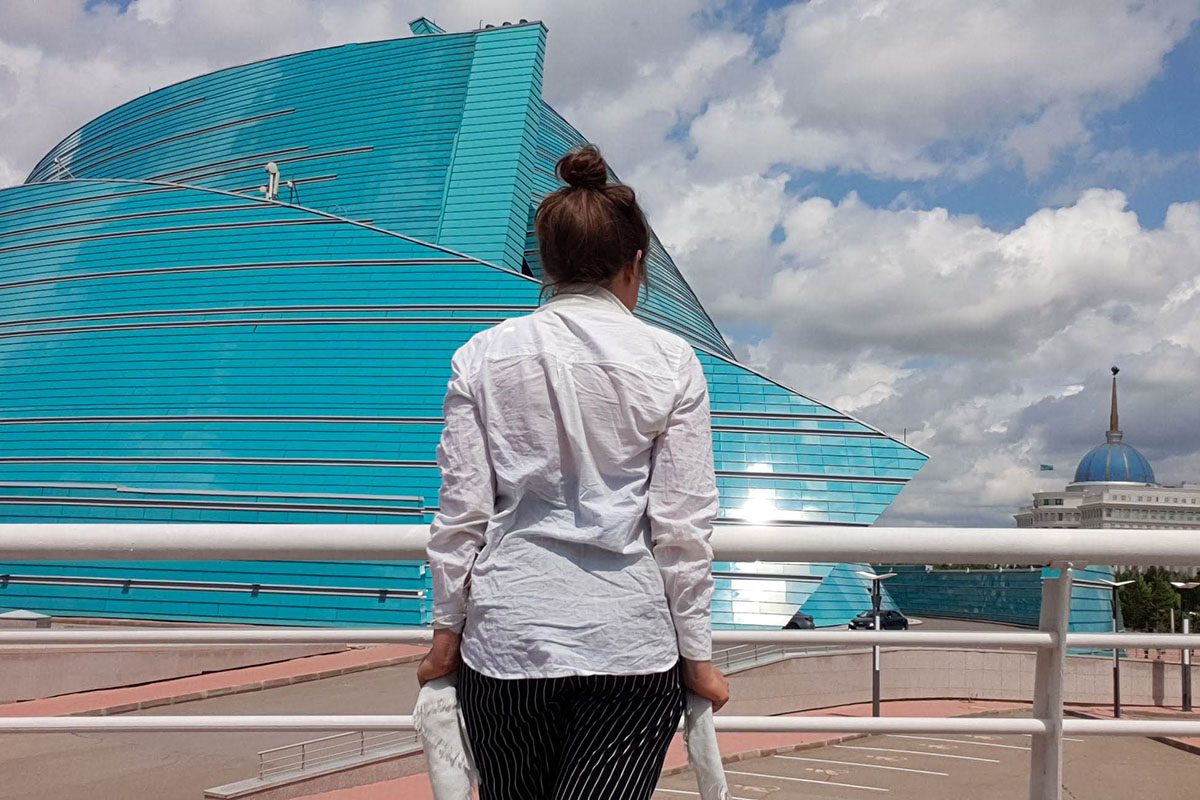
Woohoo, you’ve made it! The train doesn’t get into Astana until around 2am.
The station has WiFi that should be working – if you have WiFi you can order a Yandex taxi which are very affordable.
There were lots of taxi drivers around even at that hour, so if not you’ll be able to get a ride.
I actually pre-booked a driver from my hotel, as it was my first time in Central Asia and I wasn’t sure about how safe it was to hail cabs (I’ve spent a lot of time in Central America which is where my taxi cautiousness comes from), but I think it would have been fine.
Obviously do so at your own caution and risk, but if I did this Mongolia to Kazakhstan via Russia journey again I wouldn’t bother with the hotel pick up as it was kinda expensive.
Things to do in Astana
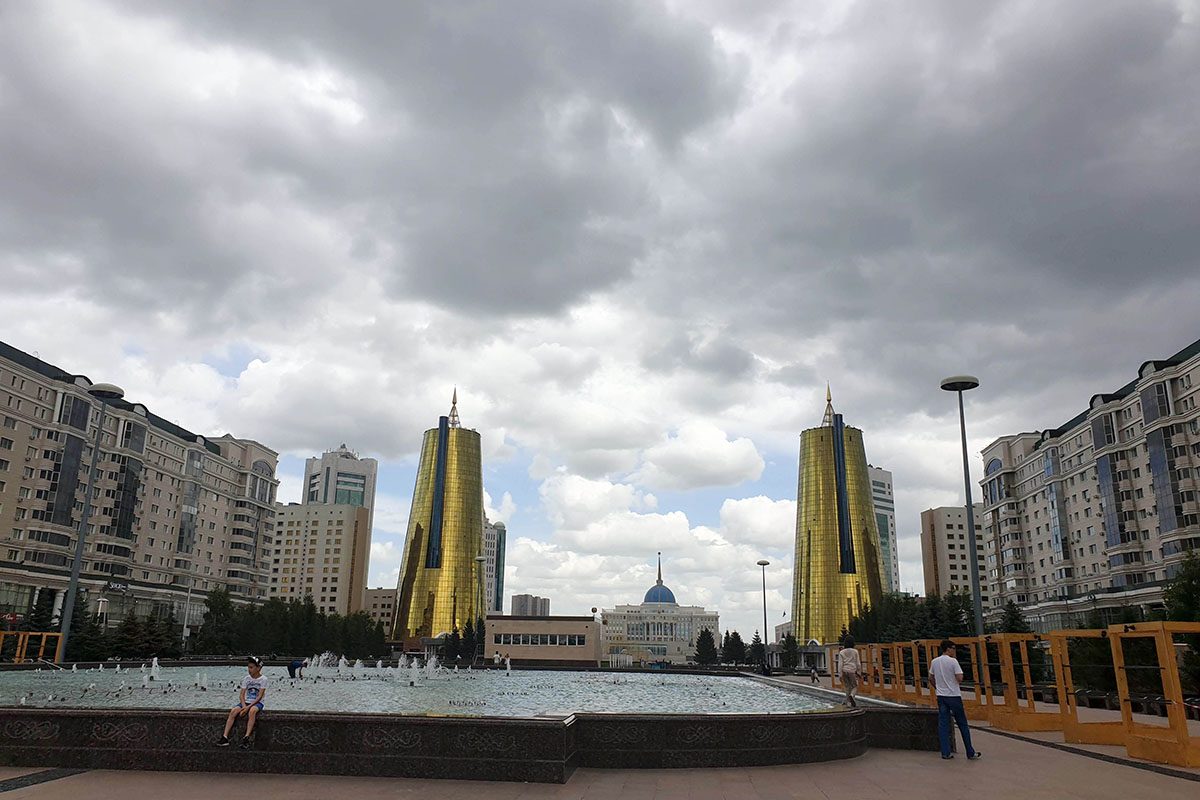
Astana is certainly not loved as much as Almaty, but there are some fun things to do here. I’m going to go more into them in detail in a later post, but some of the main attractions include:
- The National Museum of Kazakhstan – this is a really great, modern museum that gives you an idea of the rapid development of Kazakhstan. I spent about 3 hours in here and learnt a lot about the history of the country – I’m a bit of a museum nerd, but honestly I’d go to Astana just to visit the museum.
- Baiterek Monument – this structure is rather iconic for Astana, and you can go to the top of it to check out the cityscape for 300 tenge. I unfortunatley didn’t make it up there – apparently I couldn’t get change for a 1000 tenge note, which was all I had – but I imagine that the view of all of Astana’s best sights from the top is stellar. Which brings me onto my next Astana attraction…
- The Modern City Buildings – walking around Astana’s modern city allows you to see various buildings and sculptures, including Kazakhstan’s pyramids, the beer cans, and the fish bridge. You’ll have to stay tuned for my Astana blog post to learn about exactly what these are, though 😉
Where to stay in Astana
Where to go from astana.
After a few days in Astana, you’ll probably want to head south to Almaty, Kazakhstan’s culture capital and the most popular traveller hangout in the country, with access to some of the best hikes in Central Asia .
There’s so much to do and see in beautiful Almaty – I’ll be writing another blog post about it so stay tuned! For now, here’s a video about my weekend trip to the Assy Plateau. You can follow me on YouTube for more.
Visiting Mongolia, Russia and Kazakhstan
These three countries make up a beautiful part of the world that I highly recommend visiting.
Although there’s still tonnes more that I need to see in all three countries – they are three of the largest in the world, after all – I got a real sense of how amazing these places are to explore.
For a solo female traveller, they all seemed very safe (albeit confusing at times), and locals were always exceptionally friendly and helpful.
Other Central Asia Posts
- How to travel from Beijing to Ulaanbaatar overland
- Things to do in Ulaanbaatar
- One Day in Tashkent Itinerary
There’s plenty more to come about my time in all three countries and Uzbekistan, so keep updated on here or Instagram for more!
2 thoughts on “ How to Travel from Mongolia to Kazakhstan by Train ”
This is a great blog thanks for sharing! It is very useful as we are looking to do the same thing!
Would you be able to send me the details of the agent you used to book your train tickets please?
Hi ALexandra! It was just the Russian Railways website 🙂 Enjoy the journey, it’s so much fun!
Comments are closed.
- New Zealand
- The Philippines
- The Netherlands
- United Kingdom
- Inspiration
- Overland Itineraries
- Packing Lists
- Travel Tips
- Working Abroad
- Accomodation Guides
- Overland Travel
- Preserving Cultures
- Protecting Animals
- Living Abroad
- Skip to primary navigation
- Skip to main content
- Skip to footer
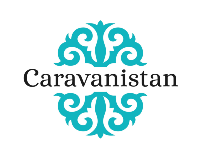
Caravanistan
The Silk Road Travel Guide
Kazakhstan traditionally sits in last place on Silk Road travelers’ must-visit list. That’s not because of a lack of attractions. But it does get trumped by its neighbours on several counts.

While Kazakhstan has beautiful steppe and mountain scenery, there are no yurts like in Kyrgyzstan or Mongolia. Kazakhstan has interesting medieval Islamic architecture, but Uzbekistan has more.
Add to that the sheer size of Kazakhstan, few tourism companies and restrictive government policies (it’s getting better): more limiting factors in attracting tourists.
So why still visit Kazakhstan?

Kazakhstan appeals to different people in different ways. Chinese travelers enjoy the fresh air (outside of the cities) and the lack of people, while Arabian visitors love how it is so green, and kind of Muslim, but not too much. Snow-white, ice-cold winters attract visitors from tropical countries.
For Westerners, the main selling point are Kazakhstan’s unique landscapes, dripping with freedom. On top of that, singular experiences include the Baikonur Cosmodrome, the Semipalatinsk Atomic Test Site , the landscapes of Mangystau, the balbal of the steppe, glitzy Astana and chaste Altai .
If history and politics are your main interests, Kazakhstan is fascinating as the country with the largest Soviet legacy, due to forced population transfers, massive industrialization and subsequent ghost towns, space launches and atomic bomb tests, gulags and banished Russian intellectuals like Dostoyevski, Solzhenitsyn, Eisenstein and Trotsky.

Table of Contents
Where to go?
We understand that many people want easy, bite-sized advice from a travel guide. Gimme 5 highlights and a 2-week itinerary and let me get on with my life. We get that. But Kazakhstan defies any attempt at pigeonholing; on top of that, most visits are part of an overland itinerary, so it all depends on where you’re coming from and heading towards.
Have a look at our list of 40 great things to do in Kazakhstan to get your creative trip-planning juices flowing.

For the majority of visitors, Almaty region and the southern area around Shymkent are the only things they will see of Kazakhstan. There is nothing wrong with that. Kazakhstan is a very big country: in area, these 2 regions put together are bigger than the whole of Italy or Japan.
Together, they provide a great sample of what Kazakhstan is all about, both culturally, historically and in terms of natural beauty. Since they border Uzbekistan , Kyrgyzstan and China, visiting the south and the Almaty region makes a lot of sense in many a overland itinerary.

If you only get to see 1 place: Almaty region has the most attractions and the best infrastructure. 5 national parks offer deserts, steppe, wildlife and high mountains, as well as history stretching back thousands of years, all surrounding Central Asia’s most buzzing city, Almaty .
Off the beaten track
Only those who like to go further off the beaten track (preferably with their own transport or a budget for tours) will want to venture into the other regions of Kazakhstan. If you have a specific interest like history, archaeology, botany or birding, you will also find much to enjoy here.
In the North , Kazakhstan’s brash new capital Astana stands in stark contrast to the modest Altai mountains . Semey surprises with its museums and history, and serves as the gateway to the Semipalatinsk Test Site . Other northern cities like Oskemen , Petropavl , Pavlodar , Ridder and Ekibastuz are trying to acquire a life of their own after being willed into existence by the Soviet state to build up its industrial base.

In the West , the oil towns of Atyrau and Aqtau border the Caspian Sea, but tourists come instead for its hinterland of stark desert landscapes like the Ustyurt plateau, which hides underground mosques like the sanctuary of Beket-Ata . Separated by an enormous expanse of steppeland dubbed by one traveler as “the most boring place on Earth”, in the northwest, visitors to historic Uralsk and boomtown Aqtobe are few and far between.
In the Center , the steppe gets even bigger and more desolate. Remote steppe oddities of niche interest are Kazakhstan’s spiritual heartland at Ulytau, Aralsk and the zombie Aral Sea and space port Baikonur. Main cities are progressive Karaganda and keeper of Kazakh traditions Kyzylorda .
Trains, planes & buses
Kazakhstan is developing its rail network , and several high-speed trains now connect the major cities. Other trains are still slow, their speed reflected by their low prices.
Flights are more expensive, although low-cost airlines now exist in Kazakhstan: FlyArystan, SCAT and Qazaq Air.
For travelers who have the time, the train is a comfortable and budget-friendly alternative to the airplane. For those who don’t, the airplane is the quickest way to get around Kazakhstan with airfields in all corners of the country.

Buses and shared taxis are usually the only way to get to smaller destinations. Less comfortable and more dangerous, we do not recommend taking them for long distances. Like train stations, city bus stations are a good place to store your luggage for the day if you are planning a stop-over.
Within cities, ride-hailing and taxi apps are available.
Self-driving & cycling
Driving Kazakhstan is perhaps the best way to experience this huge country, since many of its attractions are difficult to reach on public transport. It’s the perfect way to experience the freedom of Kazakhstan’s great outdoors. Car rentals have become more affordable in recent years, in case you did not bring your own wheels.
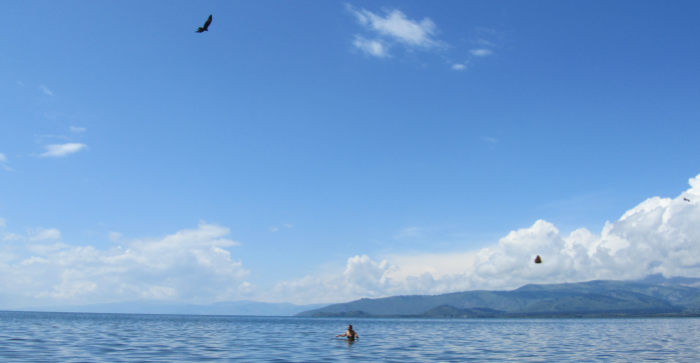
Cycling Kazakhstan – there are some nice routes available, especially in the eastern corners, in combination with Kyrgyzstan and Mongolia. Cycling in the rest of the country is a real challenge.
Winter travel
Although Kazakhstan is less mountainous than some of its neighbours, winters do disturb the transport system. Snow storms can block roads and airports, or delay trains. Between May and October all parts of the country are usually easily accessible.

Cross-border transport
Getting to Mongolia on public transport is a long and arduous journey overland, either via Russia or via China.
For transport links to Russia, Kyrgyzstan, Uzbekistan, Turkmenistan and China, see the border crossings section and the city guides.
- Self-drive in Kazakhstan
- Trains in Kazakhstan
- Cycling in Kazakhstan
- Caspian Sea ferry
Practical details
Kazakhstan’s landscapes are beautiful year-round. In winter, the steppe is covered in a light dusting of snow. Spring brings a brief flush of tulips and green grass, summer a scorching sun and the sound of crickets. In autumn, the golden foliage of mountain trees serves as a final reminder of the fading heat.

If you have the choice, the brief spring and autumn seasons are best in terms of temperature. Kazakhstan’s thermometers do get extreme, and some places cannot be visited in the dead of winter or at the height of summer.
For more details, see when to visit Kazakhstan , and our events calendar for Kazakhstan .
Have a look first to see if you need a visa for Kazakhstan . Kazakhstan is pretty safe, all things considered, with traffic as the main danger. We discuss possible concerns in detail on the safety in Central Asia page .
Health-wise , there are a few things you could worry about: diarrhea, smog, tick-borne encephalitis and rabies.
Generally speaking, food in the region is unhealthy and of little variety, based primarily on meat, fat, pasta and dairy products. Few tourists become fans of the tastes of Central Asia. Almaty and Astana are the exceptions, with a range of international cuisines offering escape from the tired local menu. We discuss your options as a picky eater .

Exchanging money, getting out money from an ATM or paying by card is easy in Kazakhstan. Paying by cash, however, has become a challenge. Kazakhstan these days runs completely on Kaspi, a “super-app” that has replaced most cash transactions. It’s not completely painless to get access as a foreigner, but if you are staying a bit longer, we do recommend making the effort .
Buying a sim card and getting mobile internet is also not an issue at the moment, although you will need a VPN to access all of the internet. More details in our articles on money and banking and communications .
For orientation , Maps.me and 2GIS are often better than Google maps. If you are a reader, have a look at our favourite books on Kazakhstan .
Budget and accommodation

The Kazakh tenge experienced a sharp devaluation in 2015 due to low oil prices and sanctions on Russia. Together with the rise in tourist services like hostels and tours and the subsequent drop in prices, it made Kazakhstan a very affordable place to travel.
Count on 3$ for a basic meal, 3-10$ for a hostel bed and a double room in a decent hotel starting at 20$. For a train ticket in an open carriage, it’s around 15$ per 1000 km. We go in depth on the budget question at the Kazakhstan travel budget page .
Hostels have popped up in every part of Kazakhstan in recent years, and now every mid-sized city has at least 1 good hotel. Almaty and Astana have a lot of options for luxury and business travelers, and there’s also plenty of apartment rentals.
We dive deeper into yurtstays, homestays, winter issues, camping, couchsurfing, … in the accommodation chapter .
Tours and tour operators

We work with a select few tour operators in Kazakhstan, people who can deliver tours to the standards of the discerning Caravanistan audience.
Asya and Alexey are well-traveled mountaineers with their own mountain base who handle our Tien Shan hiking requests. They also run jeep tours in the Almaty region.
Indira comes from the world of logistics: she is our “wrangler of the impossible.” She loves food experiences and original tour requests.
Marat does motorbike tours in Kazakhstan and beyond. Valeriya , finally, is another foodie who is trying to bring the service standards she knows from her tours to France to the villagers of her beloved Altai region.
Have a look at our Kazakhstan tour template suggestions , or simply send us your own ideas for a customised tour .
More country guides
- Turkmenistan
- Afghanistan
More on Kazakhstan
- Kazakhstan starter guide
- Things to do
- Accommodation
- Budget estimates , communication & banking
- Visas & border crossings
- When to visit & events calendar
- Self-driving
- Caspian Sea Ferry
- Northern Kazakhstan
- Central Kazakhstan
- Southern Kazakhstan
- Western Kazakhstan
- Almaty region
Travel Guide
Tours & rental.
- Custom tours
- Search all tours
- Pamir Highway tours
- Uzbekistan tours
- Kyrgyzstan tours
- Car & motorbike rental
Visa invitations
- Russia (tourist)
- Russia (business)
Get to know us
- What people say
- Letter from the Silk Road
- Terms & Conditions
- Follow us on Instagram
Do you have a request for this tour operator? Send a message
Not exactly what you were looking for? Check out our custom tour offer: competitive prices, tailored to your needs and wants. Customize your tour

The Best Guide to Travel in Kazakhstan: 18 things you should know to visit Kazakhstan in 2024
This is the most complete and updated online guide to travel in Kazakhstan. If you find yourself fascinated by this vast, beautiful country and love unusual destinations , this travel guide will tell you everything you need to know to prepare you to visit Kazakhstan.
Kazakhstan , a former Soviet republic, is a Central Asian country that extends West from the Caspian Sea to the Altai Mountains in the East. It’s one of the few countries in the world that can still be considered an off-the-beaten-path destination.
Kazakhstan borders both Russia and China and is the 9th largest country in the world so there’s a lot for you to explore. The word Kazakhstan literally translates to ‘the Land of the Wanderers’.
From arid plains, endless steppes, and dusty desert villages where you’ll see more camels than people; to lush valleys, snow-capped mountains, and modern cities, travel in Kazakhstan will surprise you every step of the way.
This travel guide will provide you with useful and up-to-date travel information regarding Covid 19, Kazakhstan travel tips, and recommendations to visit Kazakhstan.

Disclaimer: This posts might contain affiliate links, meaning that if you make a purchase through these links, I may earn an affiliate commission. Thank you for helping to support this website!
Kazakhstan Travel Essentials & Resources
- 18 useful things you should know to visit Kazakhstan
- Plan your trip: Itinerary Planning for Kazakhstan
- Tours & Experiences: City Tours, Adventure Tours
- Visa: Check the required Kazakhstan travel documents!
- Getting there: Search for flights to Almaty or Nur Sultan
- Where to stay : Find a hotel, hostel, guesthouse or homestay in Kazakhstan
- Travel Insurance: Choose the best travel insurance for Kazakhzstan
- Getting around : Rent a car in Kazakhstan or travel by train
TABLE OF CONTENTS
1. Visit Kazakhstan in 2024 – Kazakhstan Entry Requirements
As the world regains some kind of new ‘normal’ following the global pandemic, it’s really important that you do your research on the current regulations in place regarding Covid-19.
You may be wondering, ‘is Kazakhstan open for tourism?’ and the answer would be yes. The majority of Kazakhstan travel restrictions have been lifted and international flights into and out of the country have now resumed. All commercial flights to and from Kazakhstan are operating as normal too.
1.1 Kazakhstan entry Requirements COVID
Travelers arriving in Kazakhstan no longer need to present a negative PCR test result or proof of vaccination.
Almost all Covid restrictions have been lifted in Kazakhstan, except for medical facilities where face coverings must still be worn.
Upon taking your outgoing flight from Kazakhstan, you may be screened and have your temperature taken and assessed for any coronavirus symptoms. It’s still important that you check with your airline for the latest updated travel information.
1.2 Kazakhstan vaccination requirements
It is not compulsory to get any vaccinations in order to travel to Kazakhstan. You only need proof of a yellow fever vaccination if you’re arriving from a country where there’s a risk of yellow fever.

2. Do I need a visit to travel in Kazakhstan?
2.1 kazakhstan visa requirements.
For the last few years, due to the global pandemic, Kazakhstan’s visa-free regime has been suspended. However, in 2022, it has now been reinstated. If your country is on this list , you’ll have to apply for a visa at the embassy where your residence is.
However, the embassies are willing to make an exception if you don’t have an embassy in your home country. Find out what you need to apply for a visa for Kazakhstan here .
There is a list of the countries eligible to visit Kazakhstan without a visa. If your country is on the list , you’ll get a free visa (in the form of a stamp and a registration card) on arrival at the airport or at any land border.
The Kazakhstan Tourist visa is valid for a single visit of up to 30 days, two visits of up to 30 days each within a 60-day period, or three visits of up to 30 days each within a 90-day period.
Your passport should be valid for a minimum period of three months beyond the expiry date of your visa. Your passport should also have at least 1 blank page for your visa.
When visiting Kazakhstan, no matter if arriving in the country at the airport or at a land border, all visitors must fill in a registration card . This card will then be stamped twice at passport control upon arrival, showing that you’re registered. If you only see one stamp, make sure you ask nicely for the second one.
You must then keep this registration card with you throughout your stay in Kazakhstan. If you don’t have this card with you when you leave the country, you will have to pay a fine or even face deportation.
However, since 10 January 2020, it’s the responsibility of the host or hotel to register travelers. They have to do this within three working days from the date of the guest’s arrival in Kazakhstan and can be done on the Visa and Migration online portal or in writing to the Migration Service.
Travelers who need to obtain a Letter of Invitation (LOI) to visit Kazakhstan, must register with the Migration Police.
2.2 Can I extend my Kazakhstan visa?
It is no longer permitted to enter and re-enter visa-free as many times as you like, indefinitely.
Now all visa-free nationalities are only allowed a maximum of 90 days within 180 days of traveling in Kazakhstan . You can still leave and re-enter the same day. A tourist visa however can not be changed or extended once issued.
2.3 What happens if I overstay my Kazakhstan Visa?
If you happen to overstay your visa whilst in Kazakhstan, you’ll need to go to the nearest OVIR station and pay $4 for an extension and a B20 exit visa valid for up to 15 days.
Extensions are usually only granted for reasons such as flight cancellations or emergency medical care.

3. When is the best time to visit Kazakhstan?
Depending on what you want to do during your trip, you can visit Kazakhstan any time of the year. Kazakhstan has a continental climate with cold winters and hot summers and the temperature will vary depending on the region of the country.
The period between May – October is the best time to visit Kazakhstan, especially the northern region and the southeastern region. The temperatures are not too high to go hiking and camping in places like Charyn Canyon , the Kolsai Lakes and the Tian Shan mountains around Almaty as well as in the highlands of the Altai mountain range.

If you can cope with the heat, it’s also a good period to go on a road trip or a train trip through the steppes and visit other parts of the country .
Spring and Autumn each last for about a month every year: April and October in the south, and May and September in the north.
The temperature on average can be a pleasant 20°C which is ideal for sightseeing in the steppes and visiting the cities and areas in the south of the country.
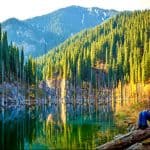
The 26 best and most beautiful places to visit in Kazakhstan

3.1 What is the hottest month in Kazakhstan?
The Summer in Kazakhstan is between late May and September and the hottest month is July. The summers in the south of the country and in the steppes can be scorching hot with temperatures known to reach 40°C (104°f).
4. Kazakhstan Travel Insurance
It’s not mandatory to have travel insurance if you are traveling to Kazakhstan. However, it’s always a good idea to have international travel insurance just in case the unforeseeable happens.
If you don’t have travel insurance yet, I highly recommend IATI travel insurance as it covers both medical costs and theft or the budget-friendly travel medical insurance by SafetyWing .

The 3 best travel insurance companies compared!
5. What is the best way to get to Kazakhstan?
You can fly to Kazakhstan, enter by road via a border crossing, or by taking a cargo ship across the Caspian Sea .
5.1 Flying into Kazakhstan
There are many daily international flights to Kazakhstan.
There are the 3 main international airports in Kazakhstan: Almaty International Airport (ALA), Astana International Airport (TSE) and Shymkent International Airport (CIT).
5.2 How to travel to Kazakhstan by road
Kazakhstan shares borders with Russia, China, Kyrgyzstan , Uzbekistan , and Turkmenistan.
Are you planning to travel overland between the Central Asian countries? Then the following guides will come in handy:
- How to get from Almaty to Tashkent (Kazakhstan to Uzbekistan) by train or bus?
- How to get from Almaty to Bishkek (Kazakhstan to Kyrgyzstan) by bus?
- How to get from Bishkek to Almaty (Kyrgyzstan to Kazakhstan) by bus?
For information about the different border crossings, read this page on Caravanistan
5.3 How to travel to Kazakhstan By boat
I entered Kazakhstan by taking a cargo ship from Baku (Azerbaijan) to Aktau (port in West Kazakhstan) across the Caspian Sea.

8 things you need to know about how to cross the Caspian Sea from Baku to Aktau by ferry.

6. IS Kazakhstan a safe country to visit?
A lot of people are concerned about travel safety in Kazakhstan because of the ‘stan’ part. But I can assure you, it’s very safe to travel in this vast country!
Kazakhstan is not a country where you’ll see a lot of violence. The majority of the locals are very helpful and hospitable and the only way you might get hurt is from a bad hangover from drinking too much vodka.
Some people are concerned about travel safety in Kazakhstan, but it’s very safe to travel in this vast country. There are the normal risks of pickpockets and petty crime, and travelers are advised to be cautious of corrupt police. They are also advised to be cautious at night in and around clubs and bars. However, Kazakhstan is generally a very friendly country and foreigners are respected.
I have walked many times on the streets in Almaty and Shymkent alone at night as a woman and not once did I feel uncomfortable or unsafe. During our road trip through the steppes , I’ve never encountered a person who wanted to harm me and my friends in any way.

There’s not as much corruption in Kazakhstan as there used to be, but if you travel around the country with your own car, the traffic police might stop you and find a reason to fine you.
How do you deal with bribes and corruption? First of all, don’t panic, get angry or be impatient. Stay calm and friendly, keep smiling and act like you have all the time in the world.
Most officials only speak Russian so even if you understand the language a bit, pretend that you don’t. If the office happens to speak English, you suddenly can’t speak English anymore.
Talk to them in a foreign language, and pretend that you have no idea what’s going on. They’ll soon realize they aren’t going to get any money from you and that you’re wasting their time and will eventually give up and let you go.
Remember: never give in and pay a bribe. If you do, you’ll encourage the offices to continue doing this. This doesn’t only affect tourism and travelers in a bad way, it also affects the local people as they become victims of bribery as well.

Is Kazakhstan Safe? 15 useful tips to travel safely in Kazakhstan

7. Money and Currency in Kazakhstan
7.1 what kind of money do they use in kazakhstan.
The official currency of Kazakhstan is the Kazakhstani Tenge (KZT).
- Banknotes circulating in Kazakhstan: 500, 1000, 2000, 5000, 10,000 and 20,000 tenge.
- Coins circulating in Kazakhstan: 1, 2, 5, 10, 20, 50, 100 and 200 tenge.
I always use the Xe.com app to convert and stay up-to-date with the current exchange rates. At this time of writing, the current exchange rates are:
- $1 USD = 451 KZT
- €1 Euro = 475 KZT
- £1 British Pound = 552 KZT
7.2 Which credit cards are accepted in Kazakhstan?
Visa is probably the most widely accepted credit card. However, Kazakhstan has a cash economy which means paying with a credit card can be quite difficult in many places.
Many taxis, restaurants, local tour operators, and small shops will still only take cash, not cards. It’s only been over the last few years that credit card usage has been more widely accepted. So make sure you’re prepared to bring plenty of cash with you if you’re planning a trip.
7.3 ATMs in Kazakhstan
ATMs are very easy to find in the cities but make sure to bring cash money when you visit remote villages and regions. You can use Visa, Maestro, and Mastercard to withdraw cash from ATMs in Kazakhstan.
It’s also worth noting that withdrawing small amounts of cash from ATMs can be costly due to the charges by the credit card companies and the banks handling the transactions.
7.4 Exchanging money in Kazakhstan
There are plenty of exchange offices, especially in the big cities, if you want to exchange some of your currency.
Rates are competitive as soon as you leave the airport and an important tip once you have exchanged your cash into tenge is to hold onto your small change.
Your 10, 20, 50, and 100 tenge will be really handy and useful when paying for bus tickets and snacks, larger notes won’t be accepted in small shops.
7.5 How much money do you need in Kazakhstan?
You may be wondering about how to budget for your trip and asking ‘Is it cheap to travel in Kazakhstan?’. Like most of Central Asia, travel in Kazakhstan is relatively cheap.
A good meal will cost around $3 in a local restaurant, a dorm bed in a hostel for around $7, and a train ticket around $15 every 1000km or so.
Tourism is still pretty new In Kazakhstan but with more visitors coming each year, more services are being offered which means that tours and activities are still relatively cheap.
7.6 Should you tip in Kazakhstan?
Tipping is not compulsory in Kazakhstan because a service charge is usually included in restaurant and hotel bills.
However, it is becoming a more common practice based on the growing number of tourists. Taxis and train travel have a fixed charge already included in the price.
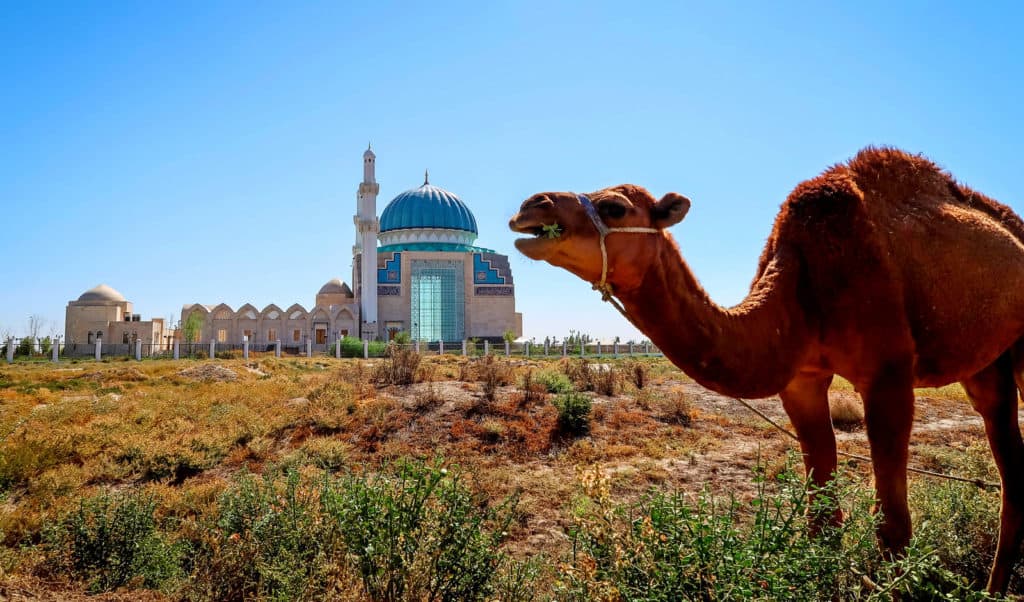
8. Kazakhstan transportation: How to Get around Kazakhstan
8.1 does kazakhstan have good transportation.
The public transport in Kazakhstan is quite well developed. You can get around Kazakhstan by train, bus, mashrutka (min-bus), (shared) taxi, and plane.
8.2 Are there trains in Kazakhstan?
Yes, Kazakhstan has a rather good railway system. As it’s a huge country and the easiest and most comfortable way of getting around Kazakhstan is by taking a train.
Not only is it a cheap way to travel long distances, but there are also regular connections between all of the main cities and towns and you’ll meet many locals along the way.
It’s better to buy your tickets in advance as they tend to sell out during the summer and on holidays. You can book your train tickets on tickets.kz where you can select your seat/bunk bed in advance.
If you’re going on an overnight journey you will get sheets, a pillow, and a blanket. Bring enough food and drinks with you as the food prices on the train are very expensive. It’s also forbidden to drink alcohol on the train.

Kazakhstan Railway Guide: How to travel by train in Kazakhstan
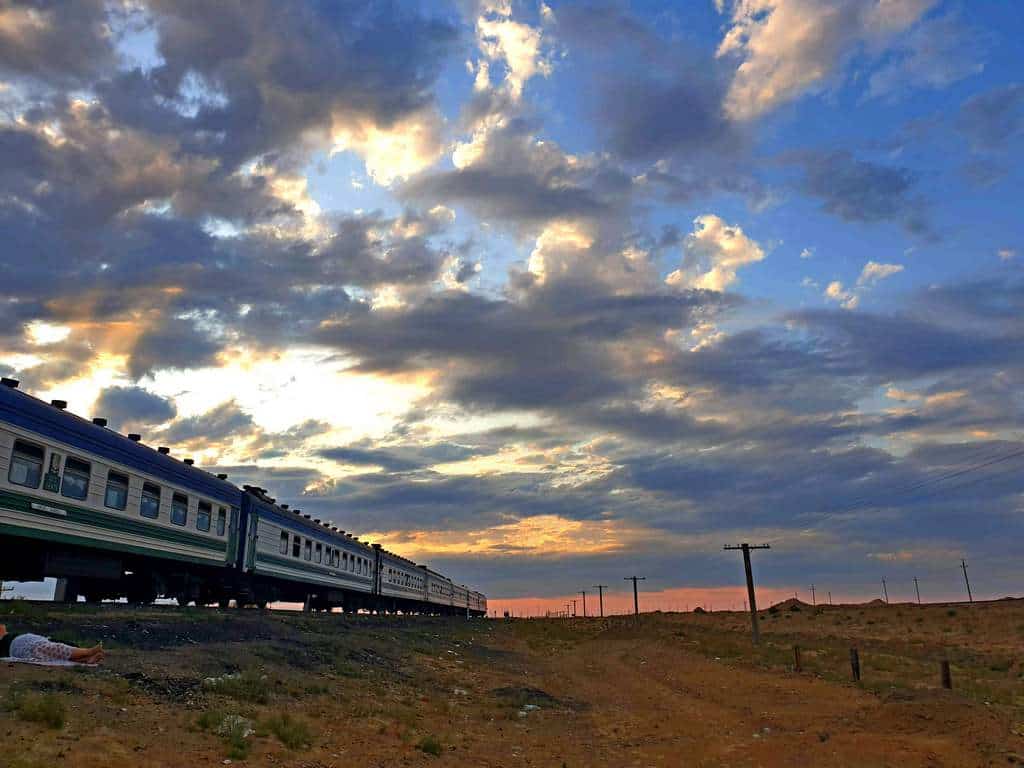
8.3 Getting around Kazakhstan by bus
Buses are great for travel within cities like Almaty , Shymkent and Nur Sultan for short and quick journeys.
The average price for a bus ticket in Almaty is around 200 tenge, which you pay to the driver when you get onto the bus. Don’t forget to ask for a receipt so you can show it to the ticket inspector when he/she comes around.
Every bus has a number and it can sometimes be confusing trying to find out which one to take. You can ask your hostel or hotel which number you need to get on or you check the bus routes within cities via maps.me and wikiroutes .
Just type in the name of your location and destination and the app will show you the number of the bus going there.
For longer journeys and travel in Kazakhstan, I would recommend taking the train for reasons regarding both cost and comfort.
8.4 Getting around Kazakhstan by minibus (marshrutka)
A marshrutka is a mini-bus that looks like a van and is a popular public transport for the locals. It’s not the fastest way to get around but it’s definitely a cultural experience.
They run on fixed routes around a city and you’ll also see many marshrutkas within smaller cities and towns. When taking a marshrutka in a city, each marshrutka has a number, and to avoid any confusement, you can either ask at your hostel or hotel which number to get on or you can download the app called Maps.me .
Just type in the name of your location and destination and the app will show you the marshrutka going there.

8.5 Getting around by (shared) taxi
Taking a shared taxi is more expensive than a bus or a marshrutka (about triple the price) but it is a much faster way to get around in a city. Sharing a taxi means that you share the car with other people and you split the costs so you pay per seat.
As it is a shared taxi, with many seats, it’s important that you tell the driver that you only wish to pay for one seat, not for the entire taxi before leaving. They leave when all of the seats have been filled. You’ll find these taxis everywhere in the cities and near bus and train stations.
You’ll often see locals waving down cars on the side of the road. The drivers that stop for them are often unofficial taxi drivers who earn a bit of extra money by giving locals a ride and charging them for the gas costs. If you want to catch a ride like this, it’s good to know in advance how much you should pay (some drivers like to charge foreigners more).
If you want to take a taxi in a city but you don’t feel confident waving down cars and/or bargaining for a good price, you can always use the Yandex Go app . This app works similar to Uber and these taxis work with a standard rate per kilometer which you can see on the app or on the meter inside the taxi.
8.6 Domestic flights in Kazakhstan
If you don’t have much time to make a long-distance journey by train, you could always take an airplane to fly between the main cities in Kazakhstan. You can book your tickets on this website .
8.7 Hitchhiking in Kazakhstan
Hitchhiking in Kazakhstan is similar to hitchhiking in Kyrgyzstan . Although you’ll see a lot of people standing on the side of the road waving down cars as a sign that they want to get a lift, it’s standard to pay the driver for the costs of the petrol.
If you’re after getting free rides, you’ll have to explain this to your driver before you get in the car.
If you’re hitchhiking long distances in Kazakhstan, you’ll often have to travel across the steppes and desert. Make sure you bring enough water and food in case you’re stuck without a ride in the middle of nowhere!

8.7 Driving in Kazakhstan
Going on a road trip in Kaz akhstan is definitely a worthwhile adventure. It’s a brilliant way to explore this vast country at your own rhythm.
As long as you’re an experienced and confident driver, renting a car gives you the opportunity to reach far and remote places. Since many of the country’s attractions are difficult to reach on public transport, hiring a car gives you the freedom to explore places off of the beaten path.

The state of the roads is generally good if you are driving along the main highways. If you want to drive across the steppes or on secondary roads, you can expect dusty tracks and countless potholes, so take care!

There are a few ‘must haves’ when hiring a car that is important to take note of before you set off on a road trip.
You’ll need an international driving license and proof that you have insurance. You will also need to have the vehicle’s ownership documents with you as most likely, you will meet traffic cops along the way.
If you are driving your own car with a foreign registration plate, you will probably be stopped a few times. As long as you haven’t broken any traffic law, you won’t be fined (see how to deal with bribes in section 6. Is Kazakhstan safe ).
You have to drive on the right side of the road in Kazakhstan and crossing a solid white line is a big no-no. Another traffic law that you should keep in mind is that your car lights must always be switched on when you’re outside of a city. Here’s a great guide with info about driving and traffic rules in Kazakhstan here.
There are several petrol stations along the way but make sure you have enough petrol in the car to drive a distance of a minimum of 300km before you come across the next petrol station. A good tip is to bring a spare jerry can for fuel if you’re planning on driving long distances.
And lastly, be aware that whilst on the road, some Kazakh drivers love to push the gas pedal and overtake other cars in the craziest ways!
Going on a road trip through Kazakhstan is definitely worthwhile as long as you’re an experienced and confident driver! You’ll be able to reach very remote places and camp under the stars!

Almaty City Guide: The 19 best things to do in Almaty
9. Kazakhstan Tours
With more tourists choosing to travel to Kazakhstan, tourism in Kazakhstan is developing slowly.
Because of this growth in tourists, there are more tour companies now than ever before meaning that there are more scheduled tours for you to choose from.
Going on a tour is particularly interesting to get to remote destinations like Charyn Canyon , Kolsai Lakes and Lake Kaindy , Altyn-Emel National Park , etc., as they are hard to reach by public transport.
You can search online for tours in Kazakhstan , organized by local tour companies or you can join my 10-day Best of Kazakhstan-Kyrgyzstan Adventure Tour!
Join the 10-day Best of Kyrgyzstan-Kazakhstan Adventure and visit Almaty, Charyn Canyon, Kolsai Lakes, Lake Kaindy, Karakol, Son Kul lake, and many more!
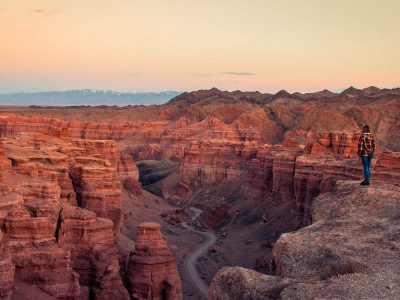
10. Where to stay in Kazakhstan
There are now many great accommodation options in the big cities and towns of Kazakhstan.
10.1 Hostels, hotels, and guesthouses in Kazakhstan
Hostels are the cheapest option for accommodation, starting from $5 per night for a bed in a dorm.
Most of the country’s cities now have at least 1 modern backpacker haunt, Almaty has more than 20 now. These hostels are often located in refurbished apartments in the center of town and run by young people themselves. Hostels in Kazakhstan are a good place to meet other young, budget-conscious travelers.
You can find a nice private room in a guesthouse, starting from $15 per night .
Nur-Sultan and Almaty have many great hotel options ($40-$250) for luxury and business travelers, and there are also plenty of apartment rentals ($15-$50).
10.2 Staying in a yurt in Kazakhstan
Unlike in its neighboring country Kyrgyzstan , it is difficult nowadays to experience real nomadic life in Kazakhstan.
Most Kazakhs have never even slept in a yurt themselves as there are only a few people who still spend time living in a yurt during summer, either herding camels in the Kyzylkum desert, or whilst shepherding in the Altai mountains.
If you happen to have your heart set on staying in one, it is possible through a holiday rental company or you can pay a visit to a pop-up restaurant or shop/market in a yurt but they are no longer homes for nomadic people in Kazakhstan.

10.3 Camping in Kazakhstan
There aren’t many designated camping sites in the country but wild camping in Kazakhstan is permitted anywhere.
If you can, you should definitely experience camping for at least one night in the steppes ( watch this video to get inspired ). It’s an incredibly unforgettable experience! There are so many scenic spots to spend a night under the stars.
It’s important to note that there are some dangers to watch for when it comes to camping. Bears and wolves roam in the wild in Kazakhstan and ticks are very common, especially in the mountains.
There are also some snakes, spiders, and scorpions in the dryer landscapes, and although they shouldn’t stop you from camping in Kazakhstan, it’s wise to be mindful of these creatures when traveling in Kazakhstan.

11. Kazakhstan Food and drinks
The cuisine in Kazakhstan is quite similar to the food in both Kyrgyzst an and Uzbekistan .
The majority of meals consist of beef, mutton, and chicken, either served within dumplings or on top of noodles, rice, or potatoes. However, if you happen to be feeling adventurous, you could try the canned camel or horse meat.
When eating out, food is generally served with either a soft drink or water. Kazakhs love drinking tea and most meals are followed by tea with milk, salt, sugar, and/or butter.
If you happen to be a coffee lover, instant coffee is usually your main option but coffee culture is now rapidly establishing itself nationwide.
11.1 5 Kazakh Dishes you have to try
1) what is the national dish of kazakhstan.
Beshbarmak is Kazakhstan’s national dish which is eaten daily in homes throughout the country. It is a slow-cooked dish made with boiled mutton, beef, horse or camel, and it is served with either boiled or flat dumplings or thin noodles, and onions.
This dish is usually eaten with your hands which explains its name which translates to ‘five fingers.’ Traditionally, the meat is served in small portions to make sure that the male elders can chew it without difficulty.

Pilaf , also known as plov, is a rice dish that is considered to be a sign of wealth and prosperity in Kazakhstan. The dish contains meat that’s cooked together with onions and carrots and then rice is then added and once plated, the dish is then decorated with dried fruits.
Pilaf is very commonly a centerpiece when celebrating occasions that are meant to bring success and happiness, like weddings.

Kazy is a type of sausage made from horse meat along with a mix of spices. The ancestors of modern Kazakhs, who were hunters, consumed large quantities of horsemeat.
They created kazy as they thought it was a clever way in which to preserve meat. It is considered to be an obligatory dish at weddings.
Manti are dumplings that have been stuffed with meat and then boiled are served with dried mint. If you decide to try Kazakhstani manti, be ready to say goodbye to your voice of reason as these are delicious.

Baursak is a type of soft dough made using wheat flour that has been fried in either lamb or beef fat. Different regions in Kazakhstan are known for different-sized baursak. Kazakhstanis love them so much that they celebrate a day dedicated to them called ‘Baursak Day’ every Autumn.
They are normally rounded or diamond-shaped with some recipes incorporating cottage cheese into the dough. Often served with either tea, shurpa (a traditional soup) or as an appetizer or dessert.

11.2 Is vegetarian food available in Kazakhstan?
It might be challenging for vegetarians to find some typical Kazakh dishes without meat. However, it’s not impossible and you can definitely ask for meals to be made without meat.
In cities like Astana, Almaty, and Shymkent you’ll find many small restaurants that serve vegetarian meals.
If you happen to be traveling during summer, you’ll find your dose of vitamins in a wide variety of fruits and vegetables from the markets in the towns and cities.
However, when in the steppes, you won’t find many options when looking for fresh fruits and veggies so be sure to take some with you if you can.
11.3 What is the national drink of Kazakhstan?
Kazakhstan’s national drink is fermented horse (mare’s) milk known as Kumys or Koumiss. A drink that’s been around for thousands of years, this bitter and sour-tasting milk drink is made with yeast cultures and mare or camel milk (known as shubat) and is believed to be medicinal.
It is slightly alcoholic and said that drinking kumys will improve your overall health, make your soul younger and your feet stronger.
Traditionally made by the nomads of Central Asia, this drink still remains important to people in both Kazakhstan and Kyrgyzstan today.
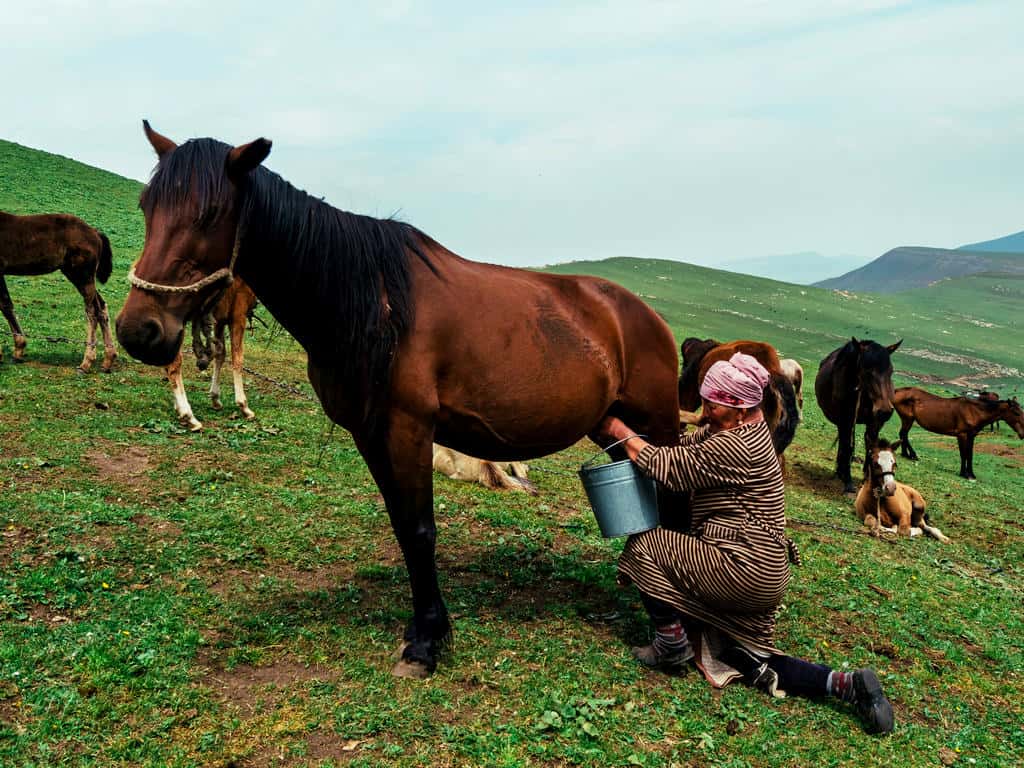
11.4 Alcohol in Kazakhstan
Although the majority of people in Kazakhstan are Muslim, vodka is still a popular drink. Kazakhstan is the world’s seventh-biggest consumer of vodka.
It is customary that young people do not drink alcohol in front of elderly people. The legal drinking and buying age for alcoholic beverages is 21 years old.
11.5 Is tap water safe to drink in Kazakhstan?
I wouldn’t advise you to drink the tap water in Kazakhstan, especially not in small towns and villages. Buy bottles of water in the local supermarkets or better, bring a LifeStraw Water Filter Bottle .
This is a reusable bottle that filters water using a microfiltration device. When you drink water using this bottle, any dirt, bacteria, or parasites will be trapped in the fibers of the filter, while the clean water passes through.
It’s not only good for your belly and wallet, but it’s also great for the environment because you don’t have to buy any plastic bottles of water!
They are very light to carry and super useful for when you go trekking in the mountains . You can use it to drink the water from the rivers and lakes without becoming sick! Another way to filter water is by using a steripen .
12. Packing list for Kazakhstan
12.1 what should i wear in kazakhstan.
The cities in Kazakhstan are very westernized so for the majority of the time, you can wear whatever you like.
However, if you’re planning on visiting rural areas, don’t wear miniskirts, short shorts and revealing tops as most people living there are quite conservative. Also, if you are visiting religious buildings and places, such as Turkestan, wear a long skirt or trousers as well as cover your shoulders.

You should also pack appropriate clothes for the period in which you’re going to travel in Kazakhstan and the type of activities you’re planning on doing.
In winter (November – March) you should always bring warm clothes, a down jacket , a hat, a scarf, thermal underwear , warm boots and maybe a few lighter clothes for the mild days in the southern regions.
The summer (June – September) can be very hot, especially in the southern part of the country so bring light clothes.
If you’re planning on hiking and camping in the mountains around Almaty during the summer, you should also bring warm clothes as the temperature at night can still drop to 0°C.

As Kyrgyzstan and Kazakhstan have similar cultures and climates, you should read The Complete Packing List for Kyrgyzstan to know in detail what to wear and pack.
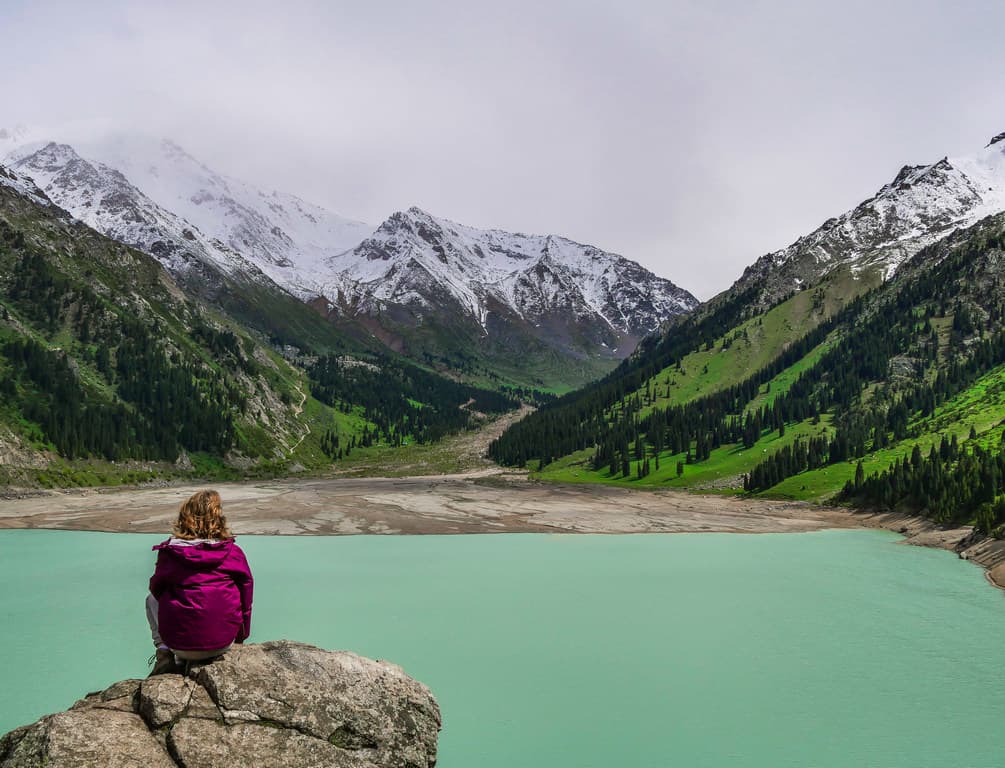
12.2 Travel essentials for Kazakhstan
There are a few items that I would class as essential when traveling in Kazakhstan:
- Water Filter Bottle : I highly recommend bringing a reusable bottle with a microfiltration device (see 11.5 Is it safe to drink the water in Kazakhstan?) . I use and highly recommend the Lifestraw Water Filter Bottle . Another way to filter water is by using a steripen .
- Portable power bank : you won’t always have electricity available to charge your electronic devices, especially not when you’re planning on spending time in the mountains or in the steppes. I use and recommend Anker Power Bank as it has a 20,000mAh cell capacity providing at least 5 full charges for my phone. I can even charge my camera batteries with it!
- International travel adaptor : the power sockets in Kazakhstan are of type C and F (the same as in Europe). The standard voltage is 220 V and the standard frequency is 50 Hz. In case you need an adaptor, I use and recommend this all-in-one Universal Travel Adaptor as you can use it worldwide.
- Biodegradable toilet paper : you’ll have to be comfortable using a squat toilet in Kazakhstan. With the exception of the guesthouses where you’ll have a western-style toilet, most toilets will be outside in the form of a separate small building with a hole in the ground. Sometimes there’s toilet paper but you should definitely bring biodegradable toilet paper with you. I mention biodegradable as the toilet paper disappears in the ground so we can keep it environment-friendly!
- The same goes for biodegradable wet wipes . Some homestays don’t have showers so wet wipes are very handy if you want to refresh.
- Immodium (or any other anti-diarrhea medicine) : a lot of the travelers eventually suffer from diarrhea at one point or another throughout their first trip to Kazakhstan. As prevention, I use activated charcoal (it helps your body get rid of toxins and unwanted substances, ask about it in your local pharmacy).
- a head torch
- a good pair of walking boots
- appropriate clothing depending on the time of year and planned activities
- a good day backpack for walking and hiking
- sun protection (a hat/headscarf/sunscreen)
- passport and a copy of your passport and any other relevant documents
- a copy of your travel insurance policy number written down somewhere

13. Are drones allowed in Kazakhstan?
According to KAA, drones are allowed in Kazakhstan, subject to AAK regulations .
You must register your drone and gain a license for using it whilst in Kazakhstan. If you do not get a license, you could face a fine, detention, or your drone could be confiscated .
You can get a license from the Aviation Committee in Nur-Sultan and there are certain rules you must follow when operating your drone whilst in the country.
Reading Tip: What’s in my camera bag: photography essentials and camera gear for travel photography
14. How is the internet in Kazakhstan?
Kazakhstan is not a place to head to if you depend on the internet for work. Access to a fast-speed WiFi connection is rare and many websites have been blocked by the government.
In January 2022, there were nationwide anti-government protests in Kazakhstan. Some of these protests turned violent and in order to regain control, the government intentionally shut down the internet across the entire country for five days.
This was permitted due to a law that came into place in 2012, regarding national security in Kazakhstan. This law states that the government can disrupt communication channels for the containment of riots.
14.1 Which is the best sim card in Kazakhstan and how to get one?
The Beeline KZ card is a great SIM card to buy whilst in Kazakhstan and you can pick it up in any local shop.
It will give you enough coverage to update your Instagram feed or call your mum on What’s App and tell her that you’re doing fine.
14.2 REcommended apps for traveling in Kazakhstan
- M aps.Me : This is one of the most practical apps you could use in Kazakhstan. You can download the map of the country so you can use it offline. It gives you very accurate directions and shows you where you can find the nearest restaurants, bus stations, ATM, hotels, places with wi-fi, points of interest, etc. It also tells you the number of the marshrutka you need to take when you travel within a particular city. This is also a great app to use while hiking as it shows most of the trails.
- 2GIS : This is very similar to Maps.Me but only works for big cities such as Almaty, Shymkent, and Astana. You can download the map of the city for offline use. This app only works in Russian but it’s the most popular and accurate navigation app in Central Asia.
- Booking.com : You’ll need internet to use this app but it’s a great tool to find (last-minute) accommodation in the country.
- Google Translate: Translates written and spoken Russian or Kyrgyz. Only Russian is available to download for offline usage.
- Xe currency: very handy to check exchange rates, also works offline.
- iOverlander: Great app for when you go on a road trip. This app serves as a database of places for overlanders. It includes information about (free) camping sites, restaurants, mechanics, petrol stations, water sources,…
- Yandex Go : Great app to use if you want to take a taxi in the major cities without getting ripped off. All the Yandex taxis have a meter so you’ll always know how much to pay. It works similarly to Uber. Just enter your location and a taxi will arrive within 5 to 10 minutes.

15. Culture and etiquette in Kazakhstan
The Kazakh people are descendants of ancient Turkic nomadic tribes and used to travel along the Kazakh steppes for centuries. Their culture was very similar to the nomadic culture that we can still see in Kyrgyzstan today.
The word “Kazakh” means “a free and independent nomad” in Turkic. However, their way of life has changed dramatically over the past century.
When Kazakhstan was still a republic of the former USSR, it rapidly developed its agricultural and industrial sectors because of its massive oil and gas reserve. The majority of the Kazakh people left their nomadic lifestyle and moved to the cities to work. Unlike in its neighboring country Kyrgyzstan, it’s nowadays very difficult to experience the nomadic culture in Kazakhstan.
Many people from other USSR republics were sent to Kazakhstan to work in the industrial sector. That’s why Kazakhstan became a multinational state inhabited by 17.8 million people belonging to more than 120 nationalities !
Kazakhstan is doing economically very well, better than any other country in Central Asia and when you visit a city like Nur Sultan and Almaty, you can tell that there’s money in the country!
It’s therefore important to tell you that the people of all ethnic groups living in Kazakhstan are called Kazakhstani . Only the people of the Kazakh ethnic group are called Kazakhs and they are becoming a minority in their own land!
The Kazakh are extremely hospitable people. In ancient times, there was an unofficial law that said ‘ Meet a guest as God’s messenger’ and hospitality is seen as a type of sacred duty.
If you are invited to someone’s home, it is customary to be served tea and bread even if you have not been invited for a meal. The serving of bread is seen as a sign of respect in Kazakhstan culture. Meals tend to take a long time as they are seen as social events.
It is common to greet people with a handshake using both hands. The majority of rules and social etiquette circle around the country’s Muslim faith and nomadic traditions.
If you want to learn about the Kazakh people and their traditions, you should go on a road trip and visit the small villages in the steppes. Most people there still live and work as shepherds. But you’ll see that their culture has become a mix of Kazakh and Russian traditions.

16. What is the Religion in Kazakhstan
The vast majority of the Kazakh people are Muslims, but the Islamic religion came late to the area.
The practice of the religion differs from region to region and is in general not so strict. You won’t see many women wearing a hijab and the majority of the men won’t say no to a good shot of vodka.

17. Do people in Kazakhstan speak English?
In the cities and more tourist areas, you will find more and more people who know and understand English.
However, it’s mostly the younger generation who seem to know more, with the percentage growing since the fall of the Soviet Union.
If you want to talk to the locals, it would serve you to learn some Russian. A Russian phrasebook would definitely come in handy.
17.1 Which languages are spoken in Kazakhstan?
The official languages of Kazakhstan are Kazakh and Russian. Only 64.4% of the population speaks Kazakh while Russian is spoken by almost everyone.
You’ll notice that the people living in the Almaty region and northern areas are predominantly Russian speakers. If you want to be able to communicate with the locals, I’d suggest you learn some Russian.
l study Russian by using the audio classes of Pimsleur . This is a great learning method to study a new language.
A phrasebook will definitely be useful. I recommend both the Lonely Planet Central Asia Phrasebook and the Lonely Planet Russian Phrasebook & Dictionary . I also recommend installing the Google Translate app and downloading the Russian language pack for offline use.
18. Recommended books about Kazakhstan
I recommend the following books and guides for traveling in Kazakhstan:

Kazakhstan Bradt Travel Guide is one of the most comprehensive travel guide books about Kazakhstan.

Kazakhstan – Culture Smart! offers an insider’s view of Kazakhstan’s fascinating history, national traditions, various cuisines, and cultural scene.

Lonely Planet Central Asia is ideal if you’re also planning on visiting other destinations in Central Asia

Apples Are from Kazakhstan: The Land that Disappeared is Christopher Robbins’ both hilarious and grim travelogue of his travels in Kazakhstan. He finds Eminem-worship by the shrinking Aral Sea, hears the Kazakh John Lennon play in a dusty desert town, joins nomads hunting eagles, eats boiled sheep’s head (a delicacy), and explores some of the most beautiful, unspoiled places on earth.

Dark Shadows: Inside the Secret World of Kazakhstan is a compelling portrait of Kazakhstan by journalist Joanna Lillis. This book explores how a president, Nursultan Nazarbayev, transformed himself into a potentate and the economically-struggling state he inherited at the fall of the USSR into a swaggering 21st-century monocracy.

I wish you such wonderful and fantastic adventures in Kazakhstan! If you still have questions about your upcoming journey, let me know in the comments below, or don’t hesitate to send me an email . I would love to help you plan your visit to Kazakhstan.
Related Posts

Best Tips and complete Packing List for Traveling in Central Asia in 2024 – When to go and what to wear when visiting Central Asia
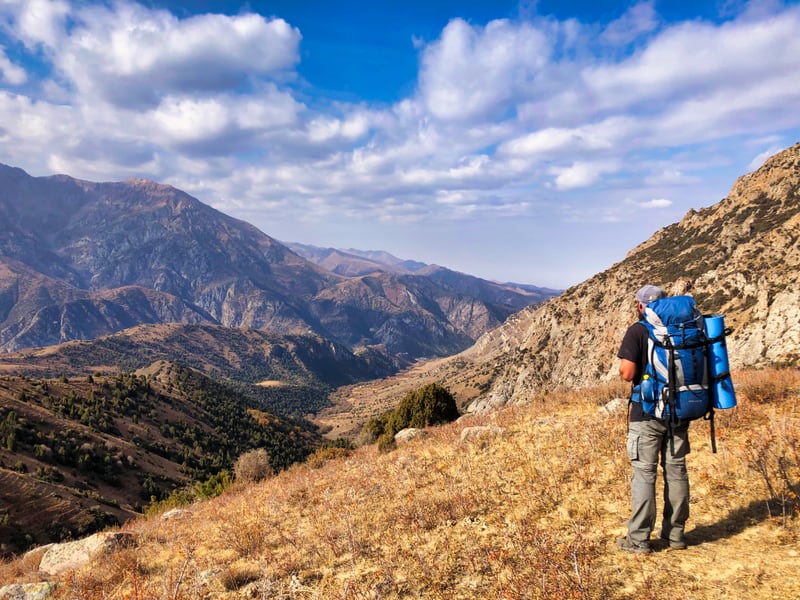
The Complete Hiking Guide to Sayram Ugam National Park, one of the most beautiful Kazakhstan National Parks
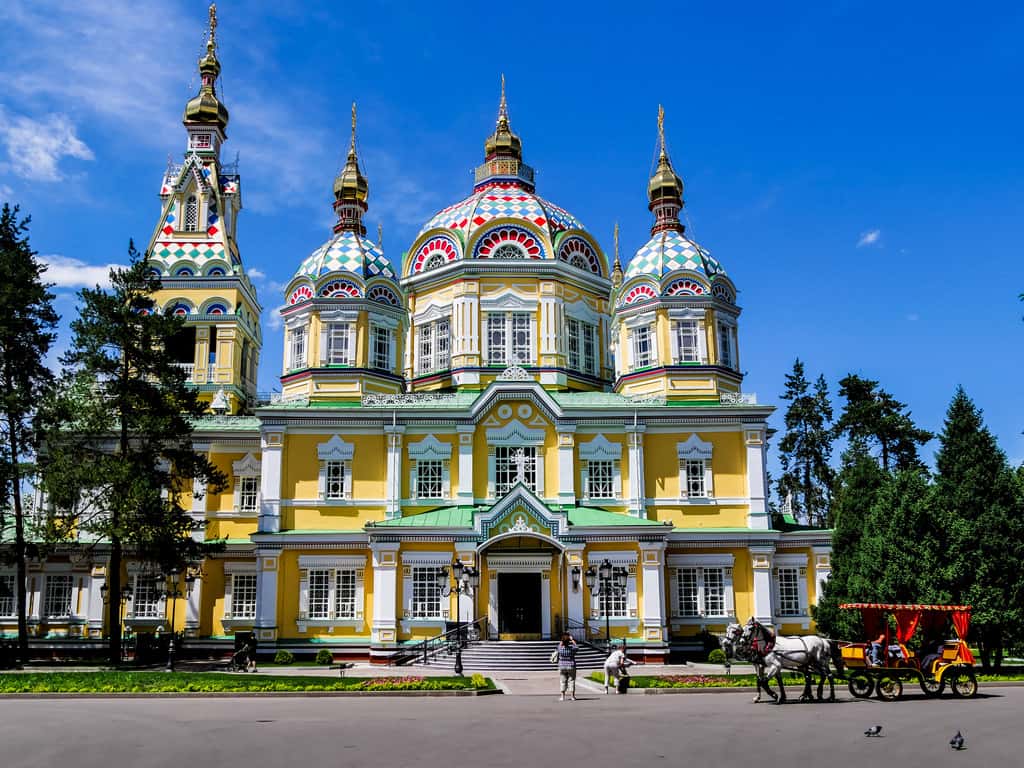
19 Best Things to do in Almaty Kazakhstan – The Complete Guide to visit Almaty City
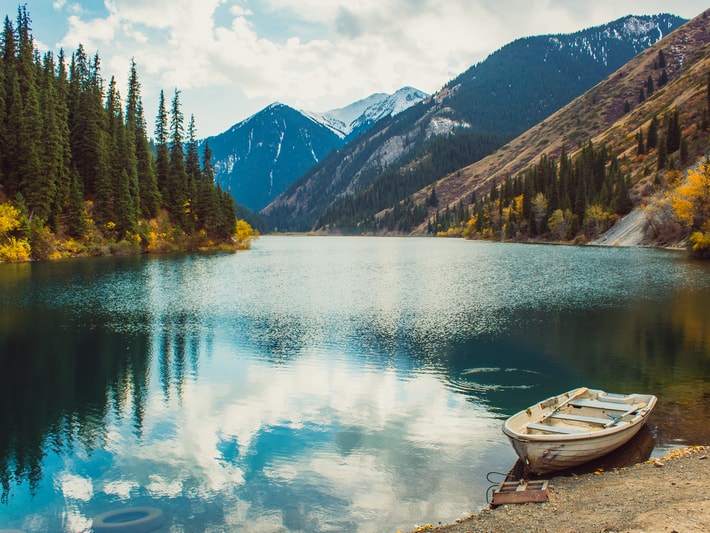
How to visit the Kolsai Lakes and Lake Kaindy, The most beautiful lakes in Kazakhstan
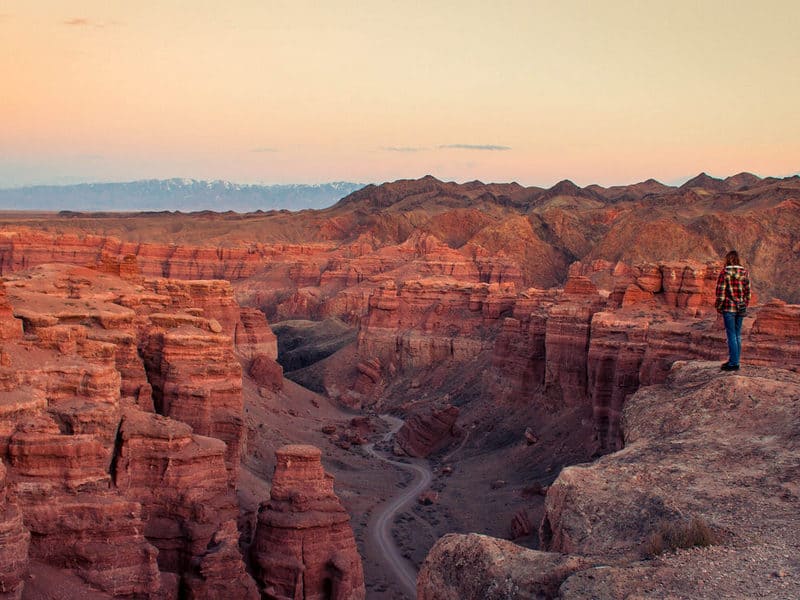
Blown away by the beauty of Charyn Canyon – The Complete Travel Guide

How to get from Almaty to Bishkek by public transport in 2024: Best way to Cross the Kazakhstan – Kyrgyzstan border
More kazakhstan travel resources:.
- The Travel Guide to Kazakhstan: 18 things you should know before you go
- The 26 most beautiful and interesting places to visit in Kazakhstan
- Is it safe to travel to Kazakhstan: 15 useful safety tips
- Almaty City Guide: The 19 best things to do in Almaty
- The 5 best and most beautiful hikes in the mountains near Almaty
- Charyn Canyon Travel Guide
- Kolsai Lakes and Lake Kaindy Travel Guide
- Sayram Ugam National Park Travel Guide
- Turkestan Travel Guide: discover the spiritual center of Kazakhstan
- Visiting the ship graveyard of the Aral Sea in Kazakhstan
- Trekking in Kazakhstan: 5-day hiking itinerary in the Northern Tian Shan Mountains
- A beginner’s guide to skiing in Shymbulak, Almaty
10 thoughts on “The Best Guide to Travel in Kazakhstan: 18 things you should know to visit Kazakhstan in 2024”
Very useful and comprehensive information
Excellent informative article…
Hi. I want to thank you for good article. I hope you liked Kazakhstan. I would like to add a few comments: You wrote, “Despite being a Muslim country …” Kazakhstan is not a Muslim country, it is a secular state. I know that many people confuse Turkic and Turkish. The word “Kazakh” means “free and independent nomad” in Turkic (non-Turkish). The Kazakh people are a descendant of the ancient Turkic nomadic tribes. Thank you!
Hello Kamshat, thank you! We really enjoy traveling in Kazakhstan 🙂 And thank you for your feedback, I’ve adjusted it in the text! Much appreciated!
Hi! Great article and very useful! Just few comments: Kazakhstan is not Muslim country, even though its true that majority of people are Muslims; Kazakhs are not becoming minority in Kazakhstan, we (Kazakhs) represent almost 70% of the Kazakhstan’s population; there are more than 3 international airports in Kazakhstan (minimum 10).
Hi Zhuldyz, thanks for your comments. I’ve re-read this article and can’t see where I wrote that Kazakhstan is a Muslim country. I mention that the majority of the people are Muslims. I’ve talked with people in Kazakhstan and read several reports on the population of Kazakhstan that tell that the Kazakh ethnic group is becoming a minority. With this I don’t mean the Kazakhstani people. And there are indeed more international airports in Kazakhstan, I’ve just mentioned that those are the 3 main ones 🙂
Cheers to that ability to share your inner-riches got a good tip. nice website I will bookmark this. I like these type of article which enhances my vocabulary keep it up ill be looking forward to your next articles.
Leave a Comment Cancel Reply
Your email address will not be published. Required fields are marked *
Save my name, email, and website in this browser for the next time I comment.

One Week in Kazakhstan – A Step-by-Step Kazakhstan Itinerary
Plan your visit with this in-depth Kazakhstan itinerary.
Many people believe that Kazakhstan is a country full of indefinite flatness. And, in some ways, that’s true, there is a lot of flatness to be seen here.
However, Kazakhstan also boasts bustling cities, amazing mountains, sparkling alpine lakes, and stunning canyons. In just one week in this vast country, I saw all of the above (and more!).
Some Americans claim that Kazakhstan is an inaccessible destination because of where it’s located. However, it’s not that much farther from the USA than Thailand or South Africa, both of which see thousands of American tourists each year.
In fact, in just one week, you can experience a lot of the best things this country has to offer! Read on to hear my tried-and-tested 7-day itinerary if you only have one week in Kazakhstan.
A few guidelines about this itinerary:
- Outdoor lovers
- Hikers of all levels
- Adventure travelers
- Extreme foodies
- People who don’t like hiking
- City people (I’ve only given you one day in Almaty here)
One Week in Kazakhstan: A Sample Itinerary
Day 0: arrive in almaty.
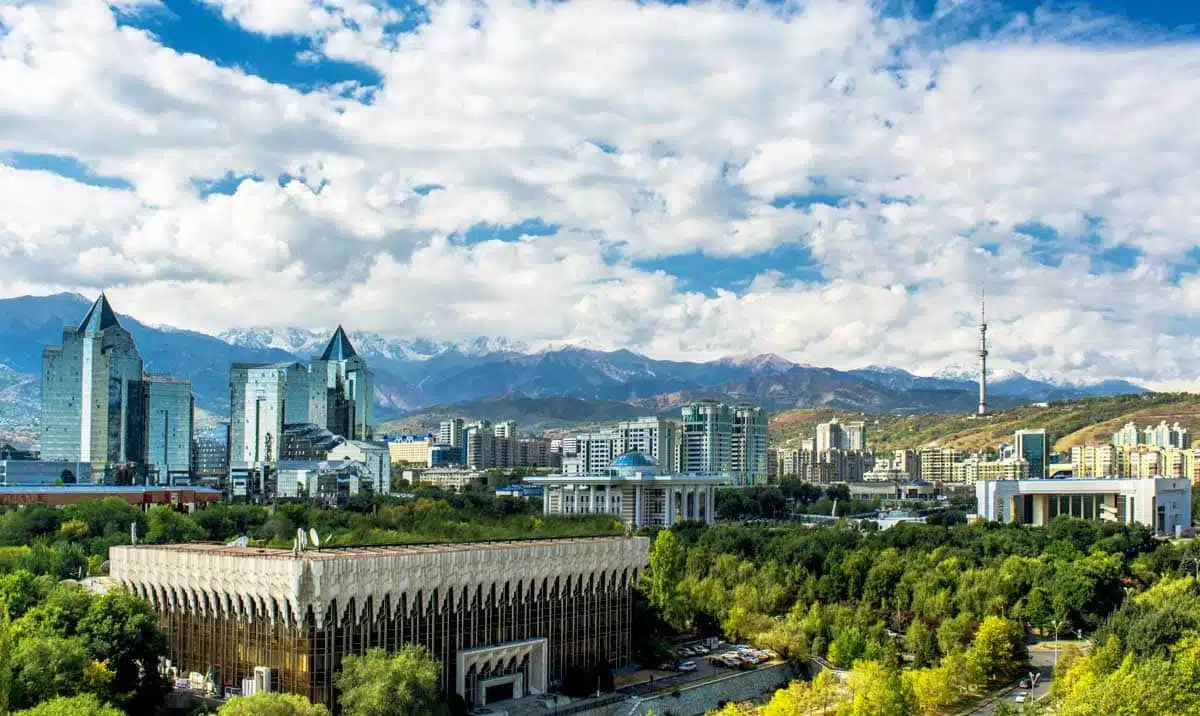
If you’re flying into Almaty, you’ll arrive into Almaty International Airport (ALA). From there, a taxi to the city center costs up to ~3,000 KZT and takes about 30-45 minutes. In Almaty, I’ve heard great things about FM Hostel Almaty (budget) or Renion Park Hotel (mid-range), which are both centrally located and reasonably priced.
Day 1: Almaty City Tour
As one of the largest cities in Central Asia , Almaty feels like the “New York” of Kazakhstan.
With crowded streets, upscale shopping malls, and a widespread public transit system, Almaty is easy to get around and explore. While you’re recovering from jet lag, you can get to know some of the areas that make Almaty such a beloved city in Central Asia.
You can roam the city independently, or register for this well-renowned walking tour in the city.
One of the city’s most notable sights, the Ascension Cathedral is a colorful Russian-style church located in one of the city’s most picturesque parks (* Note: as of my visit, the Ascension Cathedral is closed and covered in scaffolding for renovations ).
Even if you don’t enter the cathedral, the surrounding Panfilov Park is the perfect place for a morning stroll or some light people-watching. There are many museums in the area, like the Kazakhstan Museum of Musical Instruments or the Central State Museum.
In the late afternoon or early evening, head to Kok-Tobe by cable car for sweeping views of the city and some prime people-watching activities.
Or, alternatively, stroll along the Zhibek Zholy walking street and grab your dinner there.
Day 2: Hiking in Medeu and Shymbulak (Chimbulak)
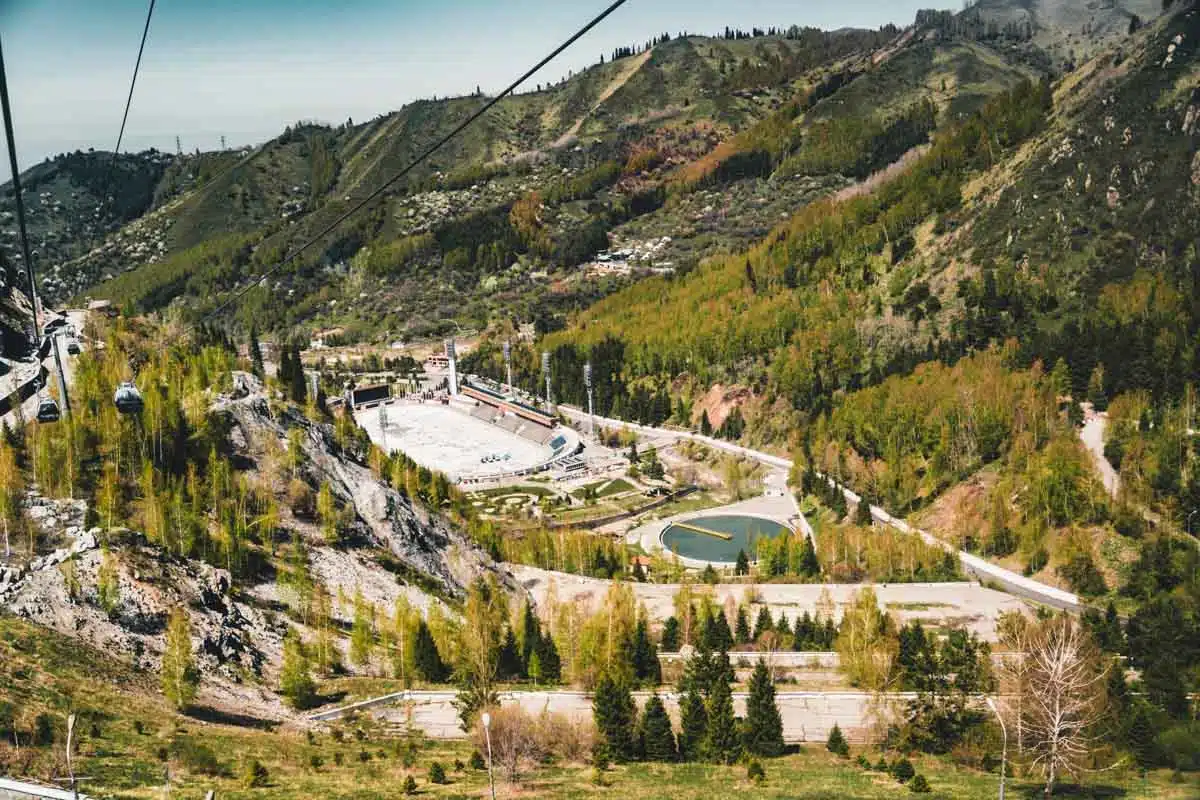
I didn’t actually make it up to Medeu and Shymbulak when I was in Almaty, but I heard from many fellow travelers that this was one of the best things to do while visiting Almaty.
Medeu is the city’s outdoor ice skating rink, and Shymbulak is the nearby ski resort. In the winter, they serve these exact purposes, but in summertime, the grounds open up for a variety of walks and day hikes.
Many people told me it was akin to hiking in the Alps (which is a pretty raving review coming from Swiss people themselves).
So, if you feel like getting outdoors, I’d recommend taking a day of your week-long itinerary to go up to Medeu to do some hiking.
To get to Medeu, you can take the Medeu cable car or travel by public bus/taxi.
Day 3: Day Trip to Big Almaty Lake
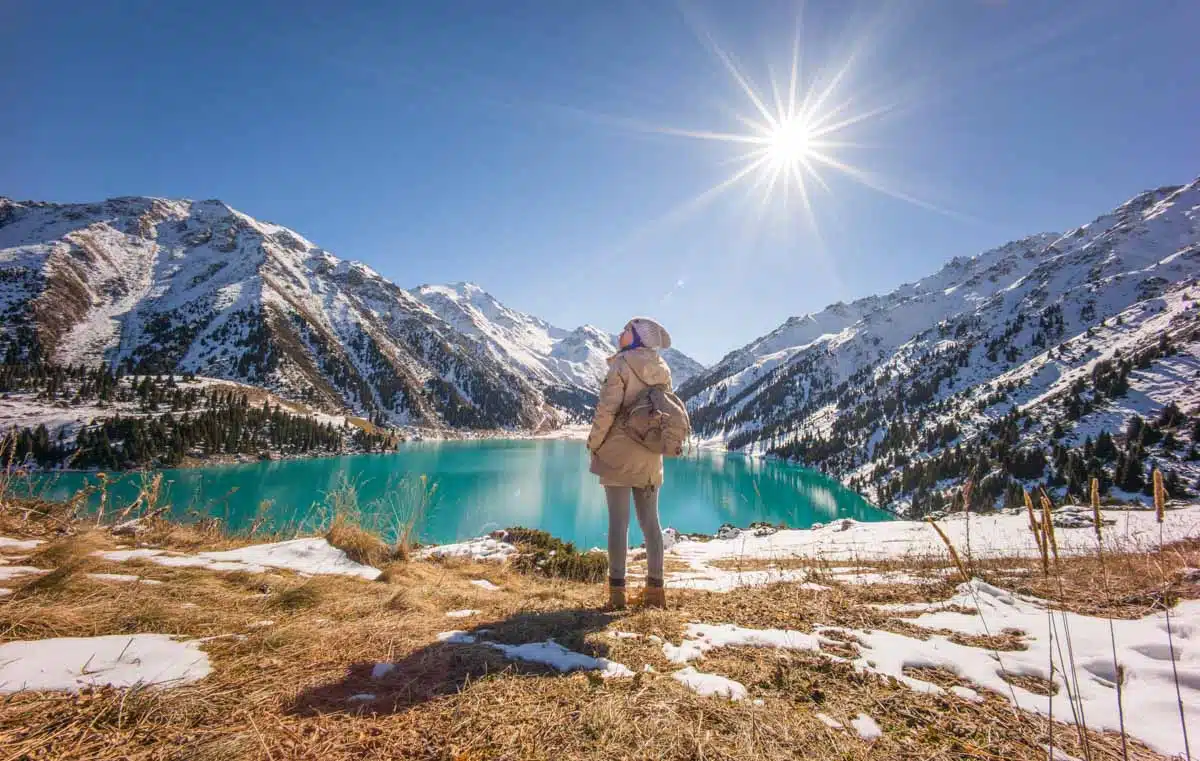
One of the most beloved local hangouts in the Almaty region is Big Almaty Lake. Known to locals simply as ‘Bao,’ this water reservoir is located high in a mountainous area.
Depending on the time of year and the lighting, the water ranges from a pale blue to a deep turquoise. It’s the perfect place to enjoy a picnic by the lakeside and people watch. However, don’t go near this precious drinking water – it’s guarded by soldiers and is illegal to enter.
To get to Big Almaty Lake, you can hire a taxi from the city each way for ~3,000-4,000 KZT each way. Yandex Taxi is an app that works really well for ordering taxis over a WiFi or cellular connection.
I STRONGLY recommend organizing your transport to and from the lake in advance, as taxis can be somewhat hard to come by up at the lake. If you have trouble communicating with your driver, you can also ask your hotel/hostel to organize it for you (usually at a slightly more expensive price).
Alternatively book a day-long tour to Big Almaty Lake
Day 4: Charyn Canyon
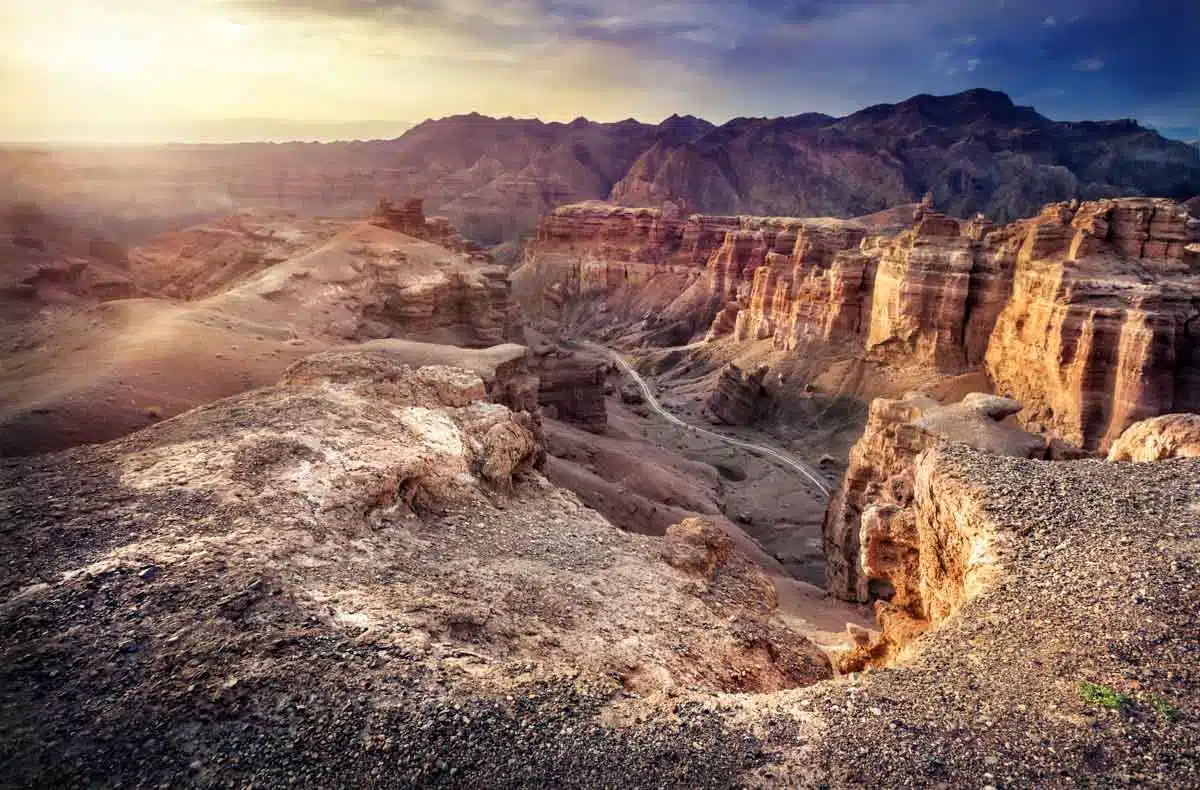
Charyn Canyon is a huge surprise in the middle of otherwise steppe-like terrain.
It’s a large, jutting canyon that’s a beautiful shade of red-orange. Inside the canyon, there are amazing and somewhat extraterrestrial-looking rock formations. It’s really spectacular, especially if you can manage to go when the sun is low in the sky.
Inside of the canyon, there’s a hiking trail that takes you to a small river and campground, but you can also hike the rim, which gives you amazing bird’s eye views of the canyon below.
To get to Charyn Canyon, you have a couple of options:
Take a day tour from Almaty – According to other travelers, you can find a day trip to Charyn Canyon from Almaty for a very reasonable price. However, you’ll be really time-constrained and the tours don’t actually run regularly so you need to book in advance.
Join a multi-day tour which includes Charyn Canyon – This is the option I did, and the one I recommend for people who are both budget-conscious and time-constrained. I paid ~$300 USD for a 4-day trip, including all meals and accommodation. Tours generally cost less per person with more passengers.
Hire a private driver – This is the most expensive option, but is also the safest, most flexible, and most convenient.
Rent a car and self-drive – Iron Horse Nomads and European Backpackers Hostel.
As a side note, I took a 4-day tour to Charyn Canyon, Kolsai Lakes, Kaindy Lake, and Altyn Emel Sand Dune. I highly recommend doing the tour if you’re short on time, so you can see everything in one fell swoop.
However, during my tour, our group had some run ins with terrible disorganization and our driver once come to pick us up while drunk. Therefore, I can’t recommend – and actively dissuade you from attending – the tour I went on (with Almaty Backpackers). This tour looks like a good alternative , even though it’s shorter – or ask at your hotel or hostel.
Day 5: Kaindy Lake
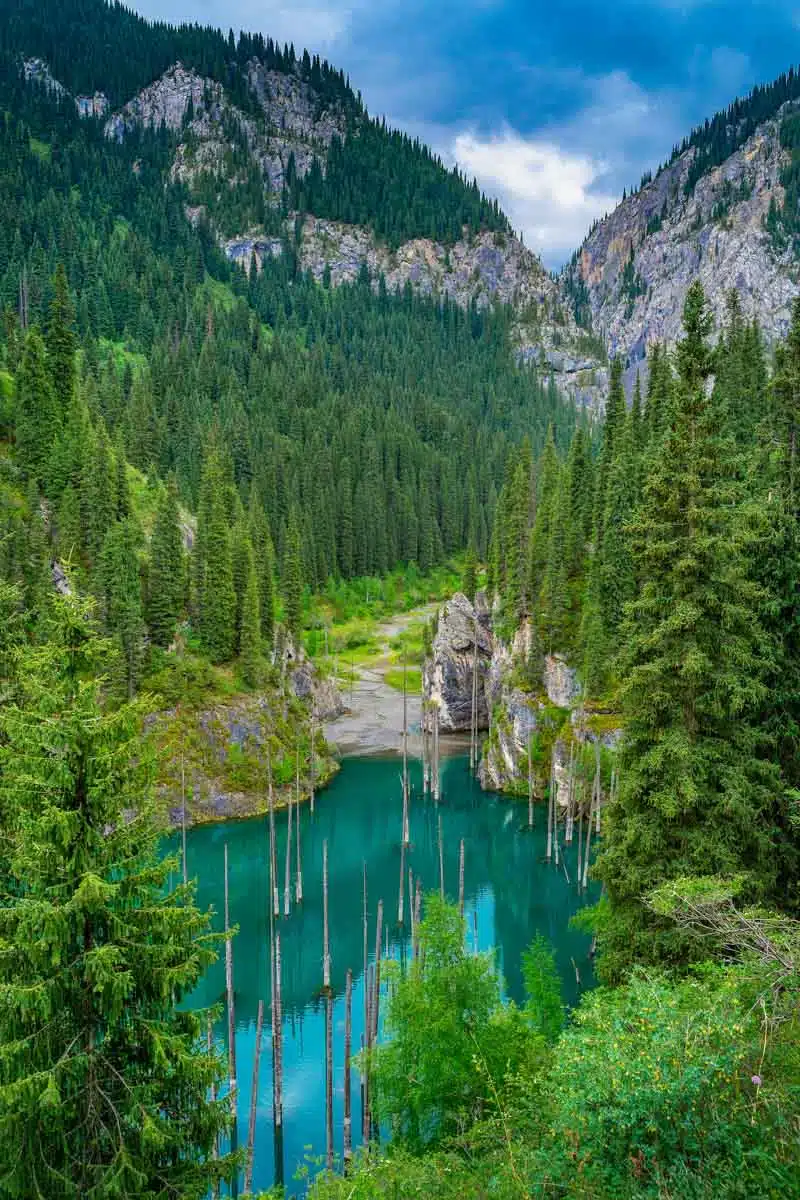
Kaindy Lake was my favorite place in all of Kazakhstan, and it should be pretty easy to see why.
It’s one of the most brightly-colored and strange lakes I’ve ever seen, with an outcropping of white tree trunks sticking out of its otherwise glass-like waters.
These trees used to stand in the valley before it was a lake, and remained there after the waters and glacial melt started to enter the region.
To do this, you’ll need to take a bus, taxi, or private car to Saty village. There’s a rumor about a bus at 9 am from Almaty to Saty, but I was never able to confirm this. I came to Saty as part of my tour.
From Saty, you need to take another marskrutka (4WD) to Kaindy Lake. From the parking lot, you can walk around the lake, to the front viewpoint (pictured above) or the back side, where swimming is permitted.
After your adventure at Kaindy, you’ll need to spend the night in the area. You have two options for accommodation here: camping at Kaindy Lake (a prime spot by the lakeside) or staying in a yurt/guesthouse in Saty village.
Day 6: Kolsai Lakes National Park
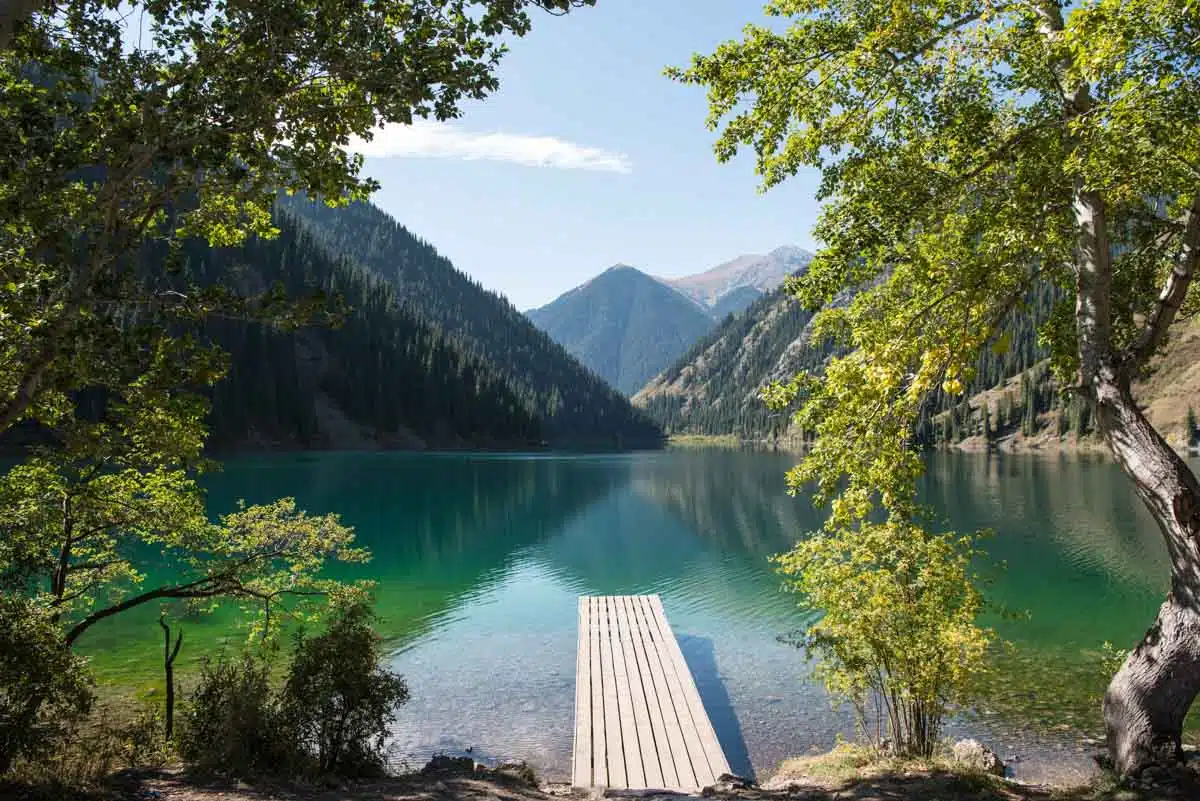
Avid hikers – you shouldn’t miss Kolsai Lakes on your Kazakhstan itinerary.
Filled with 3 magnificent glacial lakes surrounded by mountains and endless miles of emerald evergreen forests, Kolsai is the perfect place to spend a day (or two) hiking. You can also go for a swim in the second lake, but keep in mind that it’s VERY cold.
Here, there are dozens of miles of trails you can take to 3 different glacial lakes within this national park. I did a day hike to the second lake, which was ~17 km round trip.
To get here, you can drive (4WD) or take a marshrutka from Saty village. Upon arrival, there’s a small fee to enter the park. You’ll spend another night in Saty.
Day 7: Altyn-Emel & Singing Sand Dunes
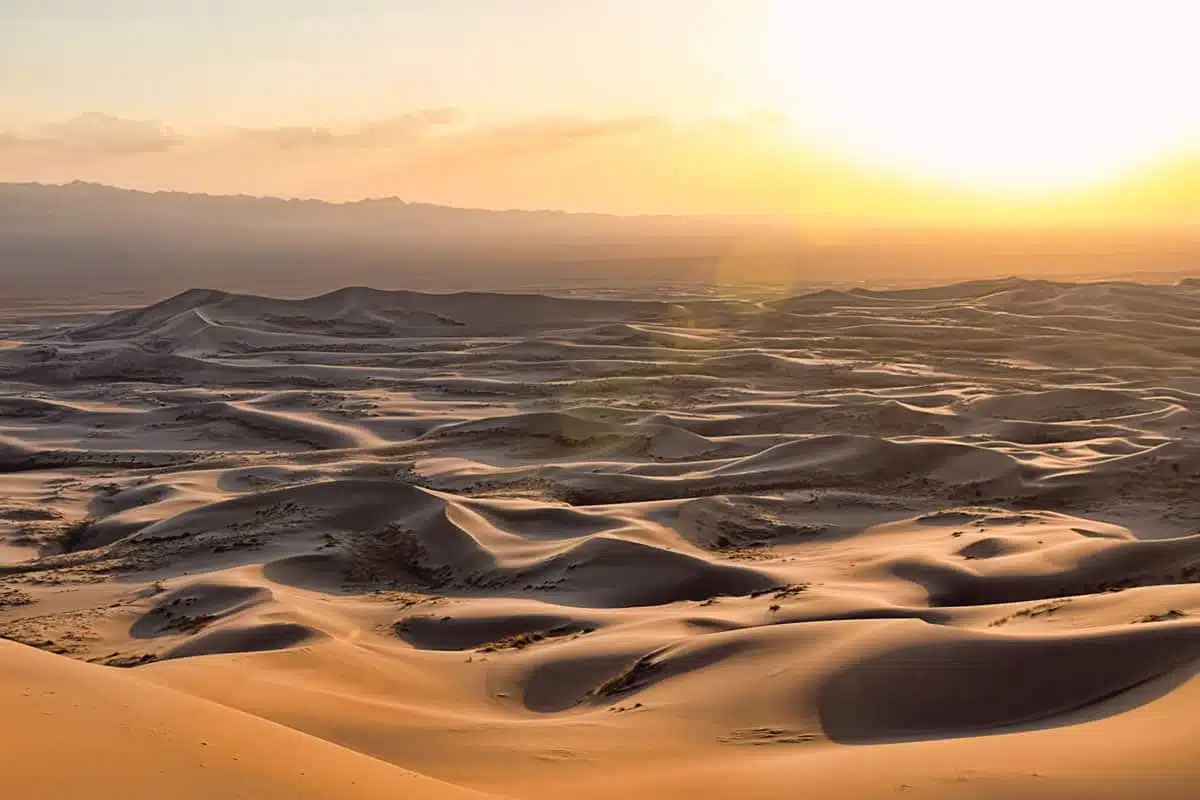
The next day is a driving day – you’ll be headed to the giant sand dunes of the Almaty area in Altyn-Emel National Park.
Start early because the drive is really long – likely 4-5 hours or more. However, once you get to Altyn-Emel, you won’t be disappointed. It’s not a huge complex of sand dunes, but the unique thing about it is that it’s surrounded by flat steppe.
You drive for miles on the flattest, most open road ever, and BOOM, you suddenly see a giant golden sand dune pop up out of nowhere. It’s called the “singing sand dune” because the winds cause a low, rumbling hum if the conditions are perfect.
After you’ve hiked up and around the sand dunes, you can head back to Almaty and spend the night there at FM Hostel Almaty (budget) or Renion Park Hotel (mid-range).
Day 8: Departure
On your last day, you’ll head to the airport for departure. One week in Kazakhstan flies by, doesn’t it?
If You Have More Time in Your Kazakhstan Itinerary
One week in Kazakhstan is definitely enough to get a feel for the culture and nature of the country, but if you can take an extra week here, I’d highly recommend it. If you have an additional week in Kazakhstan, here are a couple more places you can explore.
Shymkent & Turkestan
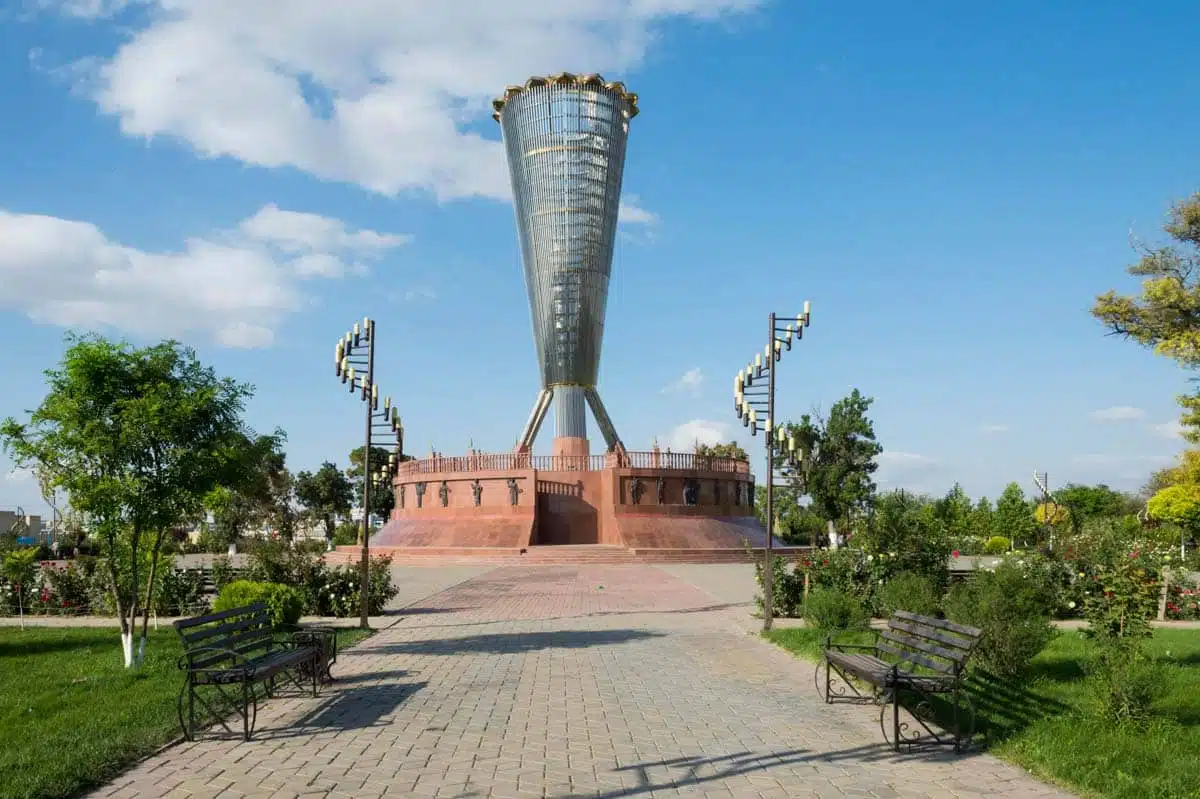
If you’ve got a few more days, Shymkent and Turkestan are the easiest places to visit from Almaty.
In Shymkent, you can experience the most hospitable people in all of Kazakhstan (true story), and use it as a jumping off point to experience the Aksu Canyon, Aksu-Zhabagly Nature Reserve, and the Tian Shan Mountains.
Turkestan is famous for its Silk Road-style mausoleum, adorned with gorgeous tiles and magnificent architecture.
To get to Shymkent/Turkestan, you can hop on an overnight train, a marshrutka, or a flight to get to Shymkent from Almaty. Then, Turkestan is just a few hours on a minibus from the main bus station.
Where to Stay in Shymkent
For budget travelers, I recommend Hostel Sweet Home in Shymkent. Albina, the owner, is one of the kindest and most hospitable people I met in Kazakhstan, and she makes a delicious breakfast, too. The hostel is affordable and clean, and there’s air conditioning in all of the bedrooms. Book Hostel Sweet Home now
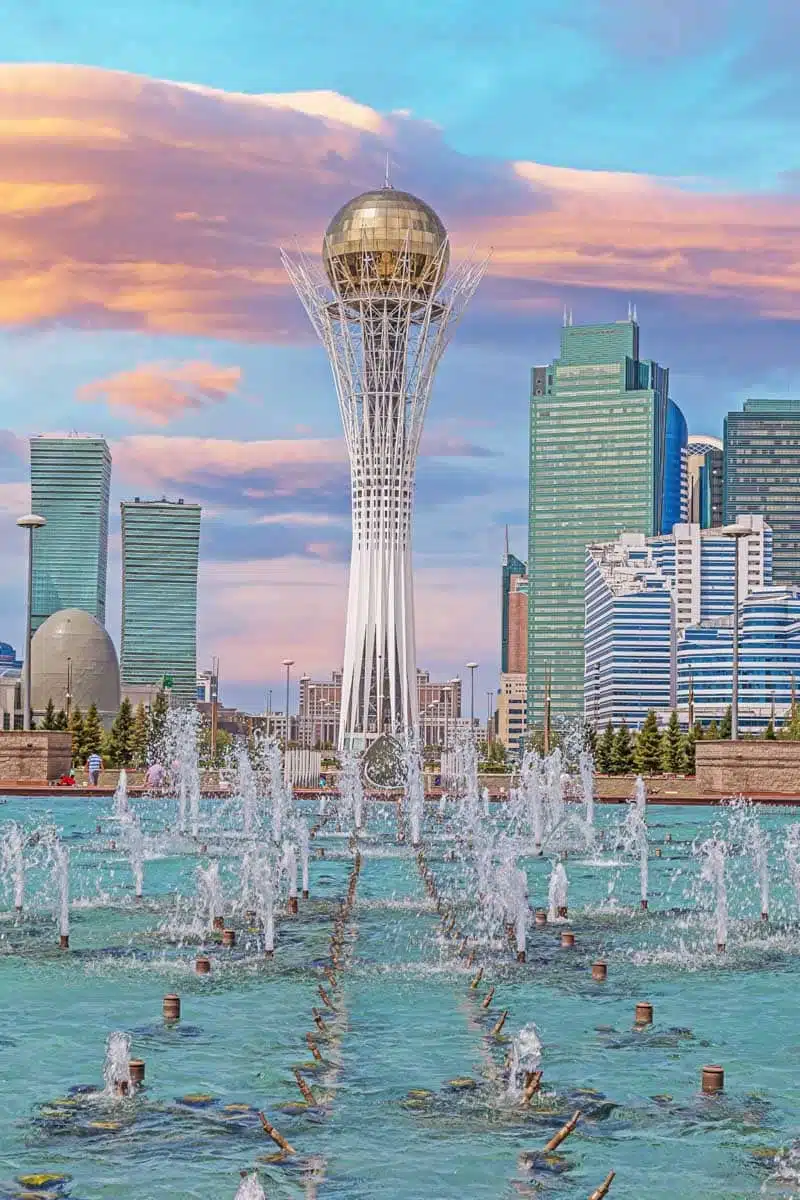
Astana is Kazakhstan’s capital, and it’s unlike any other city I’ve ever seen.
With shiny, modern, almost outer-space-like architecture and some of the most amazing mosques and museums in the country, it’s definitely worth a visit if you’re craving a city vibe.
There are a surprising number of things to do in Astana considering it’s pretty far off the typical tourist track.
From Astana, you can also take an overnight trip out to Burabay National Park, a beautiful, lake-filled park at the very northern part of Kazakhstan.

Where to Stay in Astana
For budget travelers, I recommend Hostel Forum . It is clean, cozy, and private, the staff speaks English fairly well, and it’s very affordable. It’s also easily accessible by taxi or public transportation from many of the main sites. Book Hostel Forum now
One Week in Kazakhstan: Practical Tips
How to get to kazakhstan.
While there’s no direct flight from the USA to Kazakhstan (yet), Kazakhstan is fairly easily accessible with just one layover from most major airports. It’s also easy to find direct flights from large European cities. The major international airports of Kazakhstan are in Almaty (ALA) and Astana (TSE).
Getting Around Kazakhstan
This is by far the easiest and quickest way to get around Kazakhstan, but it’s also the most expensive. Compared to domestic flights in the United States or Canada, however, inter-city flights in Kazakhstan are reasonably affordable. Local airlines Bek Air and Air Astana offer domestic flights within Kazakhstan.
Between Astana, Almaty, and Shymkent there are slow trains that run regularly. However, they are really slow. Like 20+ hours slow. It’s much, much more time efficient to take a plane or even a bus.
If you really want to experience trains in Kazakhstan, I recommend taking one between Shymkent and Almaty (or vice versa), as that ride only takes 11-12 hours. You can choose from first class (2-berth), second class (4-berth), and the platzkart (open berth car).
Obviously the platzkart is the cheapest, but you can choose your service class depending on your desired level of comfort. You can look at schedules and book train tickets on tickets.kz . You can also purchase tickets in person at any train station.
By Bus/Marshrutka
Marshrutkas, or mini buses, leave from the main bus station of every city and go to a variety of towns and cities around Kazakhstan and Central Asia. You can expect to pay anywhere from <$1 (local marshrutkas) to $7-10 (long distance marshrutkas) per ride)
Kazakhstan Itinerary: Read Next
- The Best Things to do in Astana
Love This? Save and Share on Pinterest
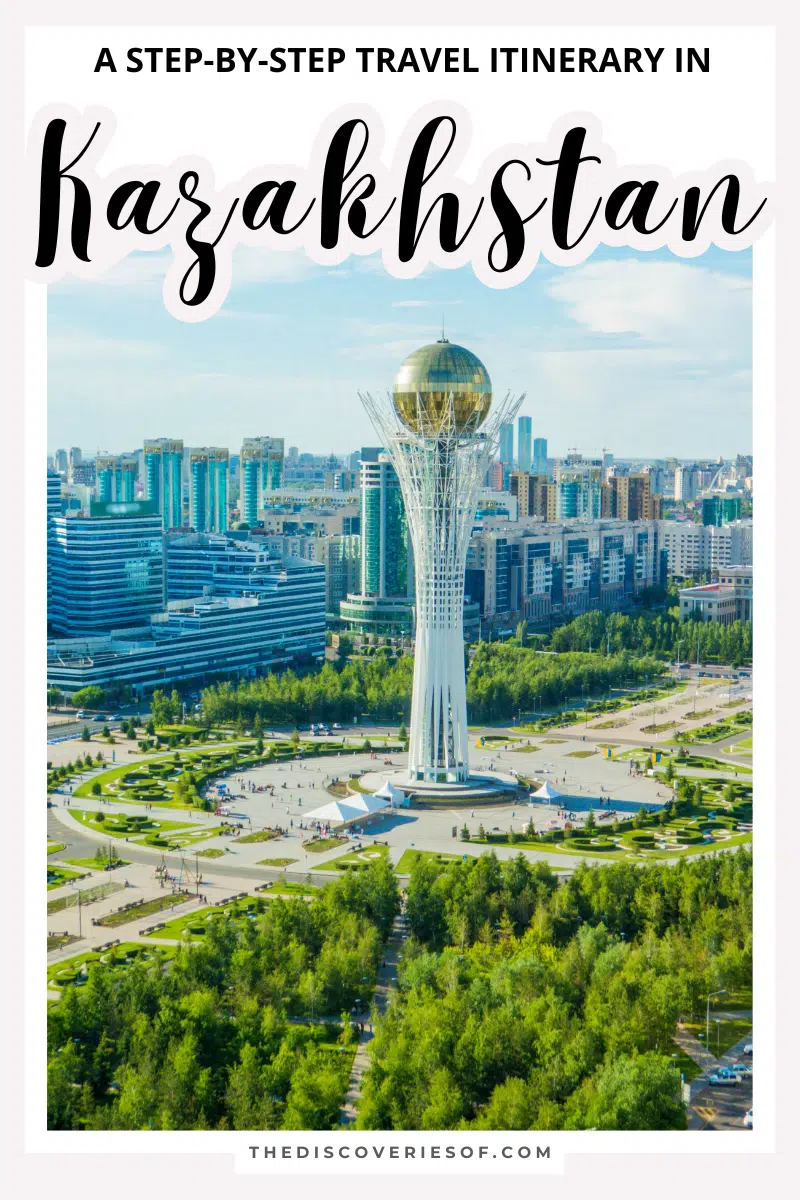
I’m Kay. I’m originally from small town Virginia, but have moved all around the East Coast and the United States for basically my entire life. I spent my childhood days blissfully wandering through the Blue Ridge Mountains, rolling in leaves, playing in creeks…you know, the usual overly adventurous 5-year-old stuff.
But those early years spent outside gave me a real problem: I’m now an adventure addict. Basically, if I’m not at my computer banging out articles or photos, I’m probably out hiking, biking, or camping somewhere beautiful.
Related Posts
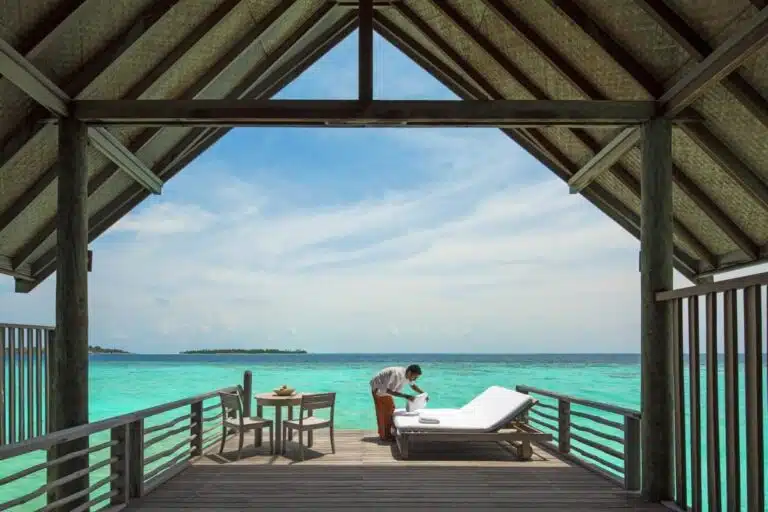
The Best Hotels in the Maldives: The Definitive Guide
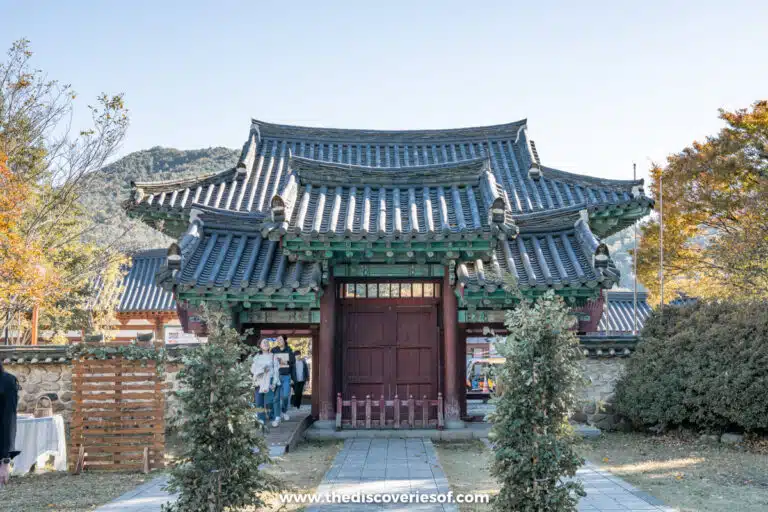
22 Things to Do in South Korea
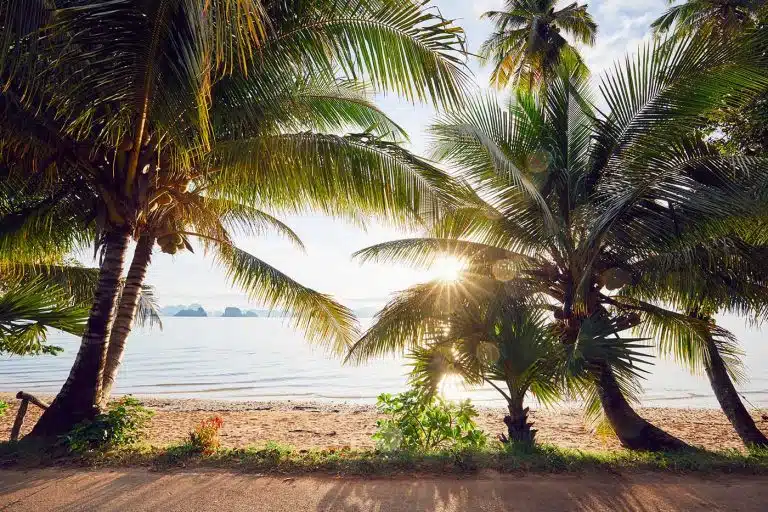
Where to Stay in Phuket: A Complete Guide to the Best Places to Stay in Phuket 2024
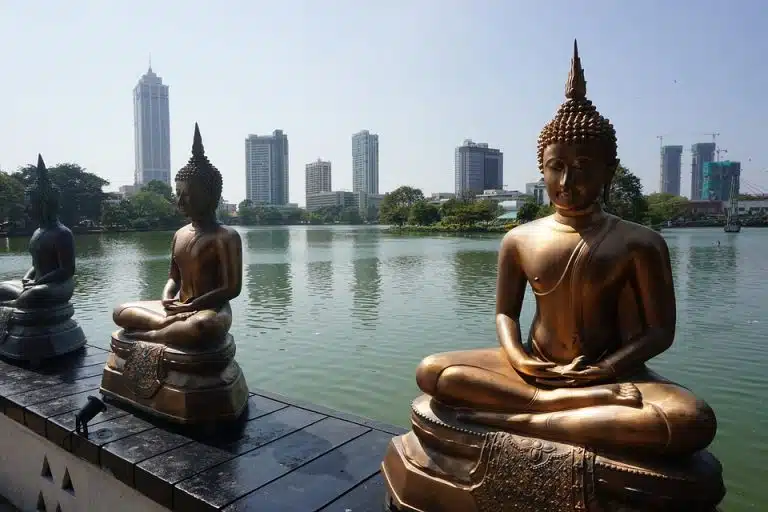
The Best Things to Do in Sri Lanka: 20 Top Sri Lanka Attractions
Thanks for sharing the info. I’m gonna use it to plan a trip to KZ soon!
Hey. Awesome guide! Very helpful blueprint for any visit. Just sharing an update. The scaffolding around the cathedral is gone, the interior is accessible and beautiful, but the center of the sanctuary is closed off.
Leave a Reply Cancel reply
Your email address will not be published. Required fields are marked *

Follow me on Instagram for travel inspiration, tips, and guides.
APRIL SALE: Book now and get up to 60% off!
Central Asia 5 Stans and Mongolia
- In-depth Cultural
- Fully Guided
- Personalized
- Sightseeing

- Introduction
- Day 1 Tashkent
- Day 2 Tashkent
- Day 3 Tashkent –Samarkand
- Day 4 Samarkand
- Day 5 Samarkand - Bukhara
- Day 6 Bukhara
- Day 7 Bukhara – Farab – Turkmenabat – Mary
- Day 8 Mary – Ashgabat
- Day 9 Ashgabat – Nissa – Ashgabat
- Day 10 Ashgabat – Dashoguz
- Day 11 Dashoguz – Kunya – Urgench – Khiva
- Day 12 Khiva – Urgench – Tashkent
- Day 13 Tashkent - Khujand (Leninabad)
- Day 14 Khujand – Dushanbe
- Day 15 Dushanbe
- Day 16 Dushanbe – Almaty
- Day 17 Almaty
- Day 18 Almaty – Bishkek
- Day 19 Bishkek – Issyk Kul
- Day 20 Issyk Kul – Chopon Ata – Grigorevka Gorge – Bishkek
- Day 21 Bishkek - Ulaanbaatar
- Day 22 Ulaanbaatar
- Day 23 Ulaanbaatar – Yol Valley – Mt. National Park
- Day 24 Hugnu Khan Mt. National Park – Bayanzag Gobi
- Day 25 Bayanzag - Ulaanbaatar
- Day 26 Ulaannaatar – Hugnu Khan Mt. National Park
- Day 27 Hugnu Khan Mt. National Park – Bayan Gobi – Karakorum
- Day 28 Karakorum – Hustai National Park & Wild Horse Park - Ulaanbaatar
- Day 29 Ulaanbaatar
- Day 30 Ulaanbaatar
- Day 31 Ulaanbaatar
Want to read it later?
Download this tour’s PDF brochure and start tour planning offline
What's Included
- Accommodation
- Additional Services
Adventure Type
- Group of 10 travelers max.
- Fast booking confirmation
- Carefully planned itineraries
- Travel with like-minded people
- Choose your preferred dates and duration
- Upgrade your accommodation
- Customize the itineraries
Operated by East Site Inc
All inclusive tour packages with no hidden costs.
Your Peace of Mind Options
Cancellation policy.
A transparent overview of applicable fees.
Customer Reviews
- Overall Rating Excellent 5.0
- Itinerary Excellent 5.0
- Guide Excellent 5.0
- Transport Excellent 5.0
- Accommodation Excellent 5.0
- Food Excellent 5.0
- Tour Operator East Site Inc 5.0
- Most Recent
- Most Popular
- Highest First
- Lowest First
- G GeorgeBaker · 25th June 2021 We took 5 Stans and Mongolia with them. During the whole trip East Site provided us with professional guides, 4* nice hotels and free bottled water. At our request East Site changed our yurt camp to a luxury camp in Mongolia without problems. Best guys... Show more Trip date: August 2019
- T TayaBennett · 10th May 2021 I took 5 Stans and Mongolia in 2019. Mongolia is the most epic region I've ever traveled. It's something to see! Trip date: September 2019
- C CynthiaBarnes · 10th May 2021 Great tour service provider! Did whatever it takes to really understand their customers and what they want and need. We traveled with East Site in 2019. Trip date: May 2019
- S SheylaBell · 16th April 2021 Traveled with East Site's team 2 times (2016 - Mongolia, 2019 - Central Asia). The Mongolian-Manchurian grassland, also known as the Mongolian-Manchurian steppe completely captivated our Sense of Nature! Trip date: April 2019
- M MasonGonzales · 30th December 2020 I took a long "5 Stans and Mongolia" trip in July 2019. Still alive :). The opening ceremony of The Festival of Naadam in Ulaanbaatar was epic! It's Mongolia's biggest cultural event, focusing on horse racing, Mongolian style wrestling and archery. Took... Show more Trip date: July 2019
- P Philip · 30th December 2020 My spouse Ella Best and I, we took 5 Stans and Mongolia in 2019. Mongolia - one of the best regions I've ever traveled. During the whole trip East Site provided us with professional guides, 4 * nice hotels and free bottled water (it was a hot, sunny... Show more Trip date: July 2019
Dates & Availability
Pay-by-instalments
Take advantage of our 0% interest instalment plan on selected departures. Learn More
- Upcoming departures
- Tuesday 18 Jun, 2024 Thursday 18 Jul, 2024 English €12,648 Confirm Dates
Frequently Asked Questions
We are there for you! If you have any questions about this tour, then please don't hesitate to contact us 24/7 and we will get back to you latest within 2 hours!
Got a question about this tour?
Reach out to our travel experts.
Keep Exploring Asia
- 10 Best Cultural Travel Companies
- 10 Best Cultural Experiences in The World 2024/2025
- Asia from Tashkent
- Asia In-depth Cultural
- Small group tour
- 31 days Asia
- Operators in Asia
- Central Asia 5 Stans and Mongolia Tours in Central Asia
- In-depth Cultural Tours
- 5 stans Tours
- Central Asia Tours
- Group Tours
- Fully Guided Tours
- Personalized Tours
- Sightseeing Tours
- Uzbekistan tours
- Turkmenistan tours
- Tajikistan tours
- Kazakhstan tours
- Kyrgyzstan tours
- Mongolia tours

- South Africa
- Czech Republic
- United Arab Emirates
- Puerto Rico
- South Dakota
- West Virginia
- Accommodation
- Travel Gear
- Itineraries
- Travel Blogging + Photography
- Where I’ve Been
- Bucket List
A Local’s Mongolia Itinerary for First Timers (and Why it Needs to Be on Your Bucket List)
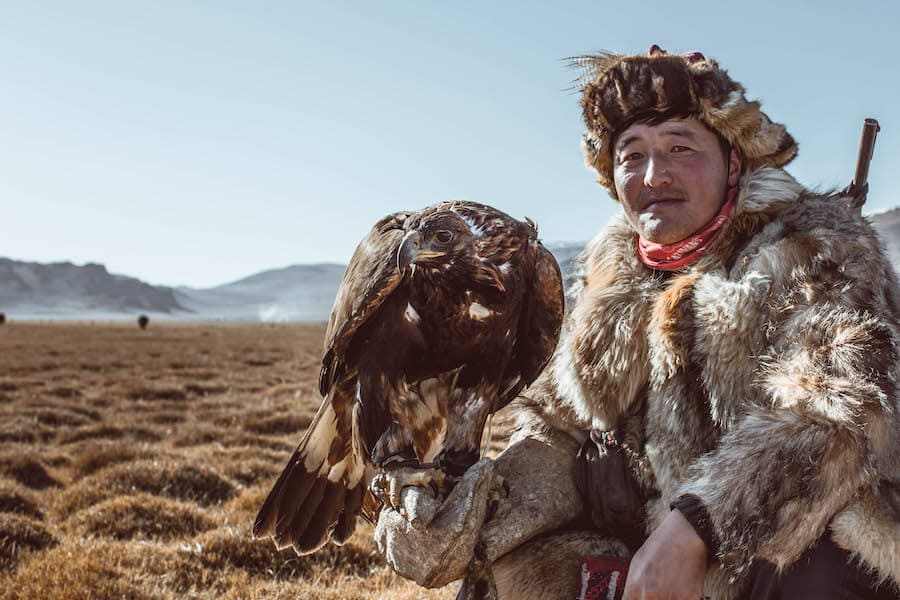
Ever dreamed of visiting Mongolia? The thought might seem daunting or a bit out of your comfort zone, which is why I’ve enlisted Mongolia expert Breanna Wilson to share her top tips and Mongolia itinerary–3 in fact–to jumpstart your planning process. Keep reading for a deep dive into everything you need to know about exploring this vast country.
It was by accident that I visited Mongolia a few years ago. I knew nothing about the place (except for some hazy memory from high school history of a Mongol ruler named Genghis who did that one thing, that one time, 800 years ago).
But I had just quit my full-time job, had a hefty tax refund in my bank account, and had just been introduced to some guy on Instagram. “That guy” quite literally changed my life. (And not in some mushy rom-com kinda way. We’re better than that, girls. He’s now one of my dearest friends in life as well as a badass business and adventure partner. We all need an Erik Cooper in our lives.)
Today, Mongolia is my part-time home (I split my time between Ulaanbaatar and Tbilisi, Georgia) and is a place that I’ll forever have a fascination with and passion for. It’s not an easy place to live (by any means), but that’s what I love about it.
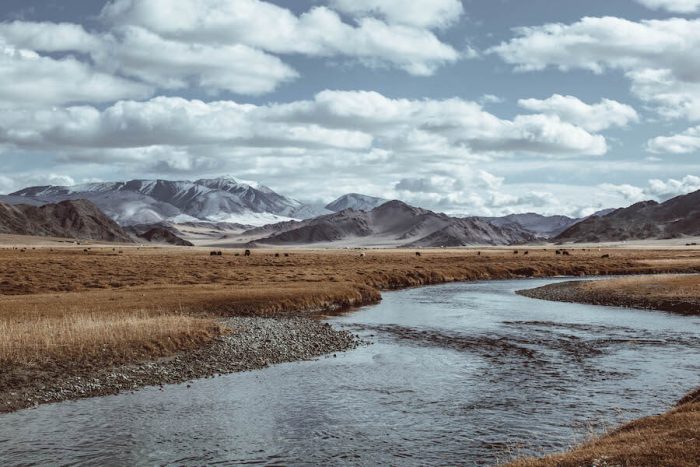
Everything about Mongolia pushes you. Pushes you to your limits. Pushes what you thought you knew about yourself. Pushes you to open your eyes and your mind. Mother Mongolia, as I like to call her, doesn’t mess around; just when you think you have everything under control, she throws something unexpected your way.
It’s a place where you truly have to let go–let go of control, schedules, and yourself. The only way to truly experience Mongolia and everything she has to offer is to let go. Once you do, she’ll show you everything you’ve ever wanted to know about yourself, and so much more.
After two years in the country, I still discover new things every day. From befriending reindeer riders, Kazakh eagle hunters, and Gobi Desert camel herders to uncovering unexpected street art and fashion scenes, underground jazz clubs, and experimental cuisines, I never grow tired of what this country has to offer.
Which is exactly what led me to launch Meanwhile in Mongolia –to share my experiences of scuba diving in the world’s most landlocked country to hiking volcanic craters, and everything in-between.
That’s why I love Mongolia and why I think it should be on everyone’s bucket list. But don’t just take it from me, it’s a place that you need to experience for yourself. And when you do, well, here’s everything you need to know about visiting Mongolia for the first time.
See you there.
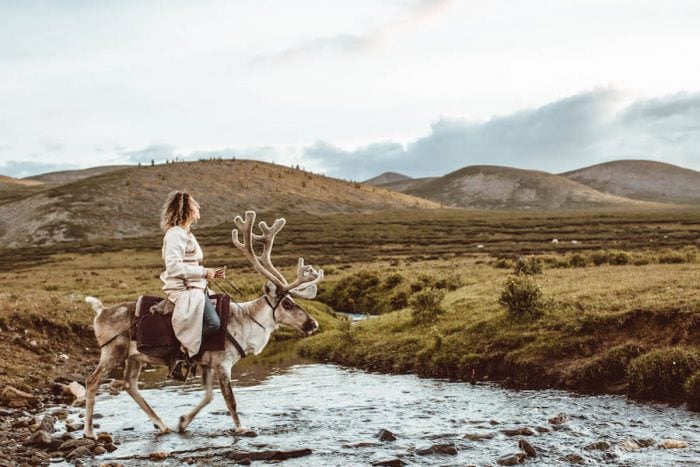
Why Mongolia Should Be at the Top of Your Bucket List
From riding reindeer to hunting with eagles, swimming in color-changing lakes or cruising on camels across the Gobi Desert, visiting Mongolia puts your wanderlust into overdrive.
Some of my favorite adventures include:
- Winter Dog Sledding in Gorkhi Terelj National Park
- Motorcycling Across Mongolia in Vintage Russian Urals
- Learning to Hunt with Eagles from the Kazakh Eagle Hunters in the West
- Riding Reindeer Across the Taiga in the Northern Provinces
Is Mongolia Safe for Female Travelers?
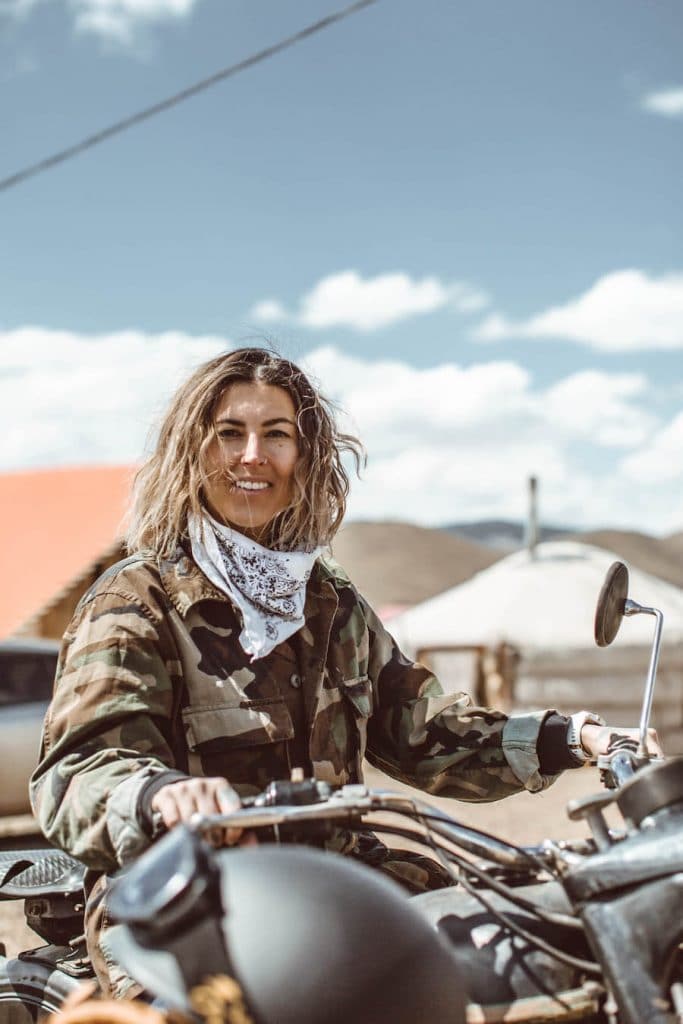
Is Mongolia safe? It’s the number one question people have about traveling to Mongolia, especially solo female travelers like myself (it was my biggest fear about moving here as well).
Mongolia is like any other country–there are parts that are extremely safe, and parts where you’ll need to be cautious. There’s no point in sugarcoating this: foreigners absolutely stand out here. Because of this, I do not recommend females travel around the country by themselves. I say this for a few reasons.
First, you’re remote. Like, remote, remote. There’s no one around for miles and miles. So, if you’re driving solo in a rental car and get a flat tire (or worse), you’re all alone. No AAA. No 911. It’s up to you to figure out this problem, and I can almost guarantee it won’t be a little one. Mongolia is a rough and rugged place.
Second, alcoholism is very common among locals. I’m not saying this to make you think all Mongolians are alcoholics, but only to provide 100% clarity on what you’re getting into.
So, if you’re staying in a ger (also known as a yurt) with a family, be aware of both your and the family’s alcohol consumption. We all know that alcohol can increase aggression, and miscommunication without a clear understanding of cultural nuances or the language leads to increased frustrations. Create a safe experience for yourself by avoiding these situations altogether.
Overall, Mongolia is a place where guns are rare (unless you’re in the countryside protecting a herd), and although pick pockets and petty theft are common, that’s the worst of it. Wars and political unrest are practically unheard of, and natural disasters are nearly impossible.
Read More Travel Guides:
7 things you have to do on your first trip to morocco, an india bucket list for photographers, how to spend one day in abu dhabi, a 1-day north bali itinerary from ubud.
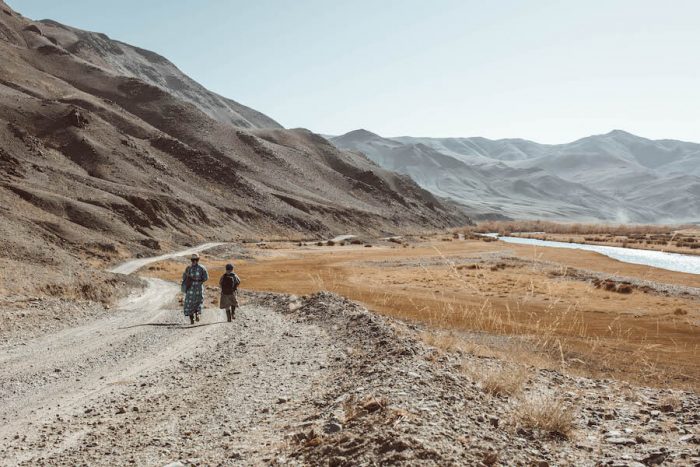
When to Go to Mongolia
Summer is the absolute best time to visit Mongolia (unless you really enjoy -40 C/F weather).
In May you still face the risk of getting stuck in a snowstorm, but by June temperatures are warm. Rain is common, but it won’t ruin your trip.
July is when Naadam, the biggest festival of the year, takes place. The entire country shuts down for about two weeks usually starting around the second weekend of the month. Horse races, wrestling matches, and archery all take place across the country during this time. It’s an incredible way to experience Mongolian culture.
August is hot and a great time to escape north to higher elevations or to Lake Khovsgol, the second largest freshwater lake in Mongolia (after Lake Baikal).
September and October are just as wonderful but be prepared for cold nights. Ger camps start to close down for the season during this time, and some nomads begin moving towards their fall and winter camps.
Summer summary: Nights are chilly. The weather is dry, and usually in the 80s F. Overall, it’s a place where layers are your friend and you can adventure freely without delays.
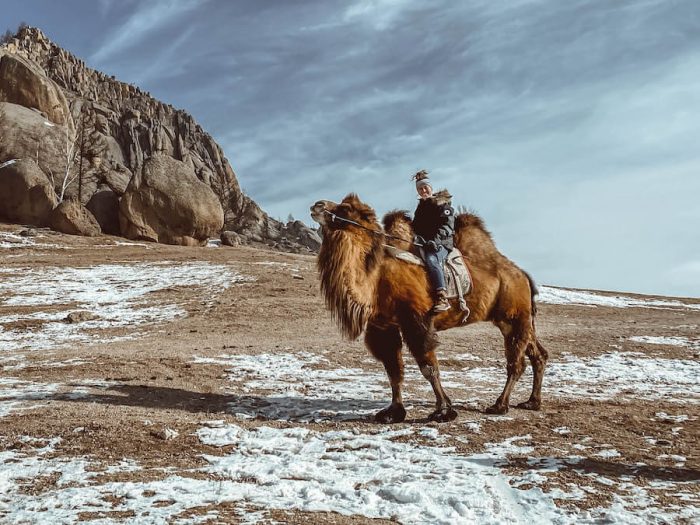
How to Get There
Getting to Mongolia from the US is, well, a journey. It’s going to take at least 24 hours, and you’ll have to go through Istanbul (my preference), Hong Kong, Beijing, Seoul, or Moscow. ( Note : these are all pre-Coronavirus flight patterns and not all of these routes may have reopened, so research accordingly.)
The country’s main international airport is located in Ulaanbaatar, Mongolia’s capital. Though there’s a smaller international airport in Bayan Olgii, it’s mostly for “local” international flights out of Kazakhstan and Russia.
The main airlines that fly to Ulaanbaatar include Turkish Airlines, Korean Air, Cathay Pacific, Aeroflot, and Air China. Turkish Airlines is my airline of choice as flying through the new Istanbul airport offers plenty of food options and quiet corners for sleeping.
Aeroflot flights typically leave from New York City through Moscow, but I know more people than I’d like to tell you about who’ve lost their baggage on this route. If you’re heading out of the city shortly after landing, I’d recommend avoiding Aeroflot since it’s a bit of a process to recover lost luggage once in Ulaanbaatar.
From the west coast, flying through Seoul, Beijing, or Hong Kong are fairly good options. Layovers in Beijing or Hong Kong can be 12 hours, but if you’re on a budget, it usually offers a good fare.
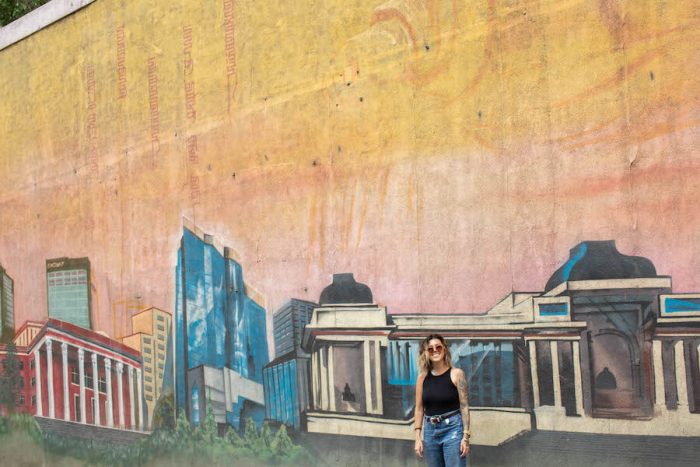
Where to Eat, Sleep, and Play in Ulaanbaatar
If you ask me, Ulaanbaatar is one of the most misunderstood cities in the world. It’s not exactly pretty at first glance. There’s an insane amount of traffic. Things don’t open early–or even on time. It’s a place–like the rest of Mongolia–where you have to go with the flow.
Service is slow (or nonexistent). Food quality is hit or miss. And complicated orders are a recipe for disaster (sorry vegans and eaters with dietary restrictions, this is not going to be an easy place for you).
But, when it comes to things to do in Ulaanbaatar, the possibilities are endless. It’s the hidden gems that really make this place stand out. No matter where you stay, most activities are either walking distance or a short taxi ride away. Plus, you’ll have to fly in and out of Ulaanbaatar regardless, so adding it to your Mongolia itinerary is non-negotiable.
Where to Stay:
- Budget: Zaya Hostel
- Mid: Holiday Inn
- Luxe: Shangri-La Ulaanbaatar
Search for more Ulaanbaatar hotels on Booking.com:
Where to Eat:
- La Rosa Tapas & Tequila Bar
- Rosewood Ulaanbaatar Kitchen + Enoteca
- ROC Caffeine Bars (Coffee)
Where to Play:
- Fat Cat Jazz Club
- MB Beer Plus
- Republik Pub
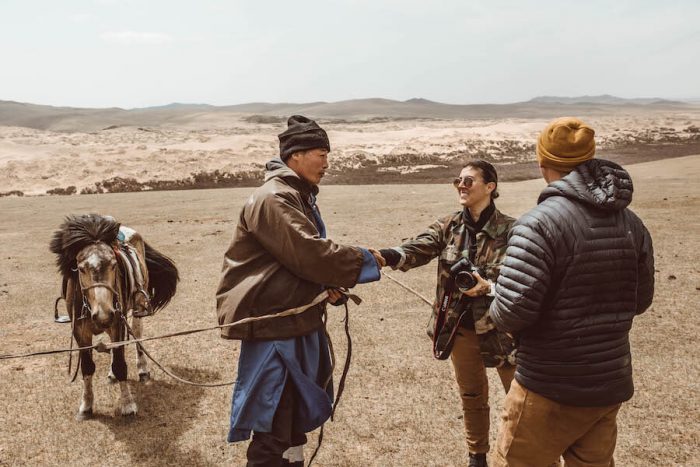
Quick Tips for Planning Your Mongolia Itinerary
Here are a few quick tips for planning your trip that will make your Mongolia itinerary run more smoothly:
Plan *almost* everything in advance
Mongolia is not a place to “wing it”. You won’t find hotels everywhere. Or water, for that matter. Wi-Fi won’t necessarily work once you leave the city. And don’t expect people to speak English.
Stock up on some solid gear
While I hate pushing gear on travelers, I’d recommend stocking up on some solid staples before leaving. You DO NOT need the best of the best to travel/hike/adventure/overland here, but it can get cold at night so a down puffer jacket is an absolute must.
A portable water purifier just might save your life. And never underestimate the power of quick-dry socks, a waterproof rain jacket and pants, and a knife.
Buy travel insurance
Just do it. Trust me. It personally saved me $3,000 when I broke my collarbone in Mongolia last summer.
[Note: For travel insurance, Live Like it’s the Weekend recommends World Nomads or SafetyWing for the best budget options with the most coverage. If you want to read more about my experience with travel insurance, click here ).
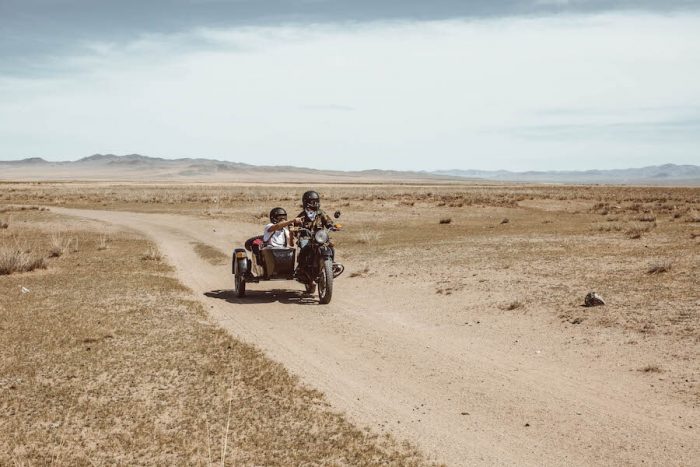
Three Bucket List Mongolia Itineraries for First Timers
Mongolia isn’t an easy place to plan for or explore on your own. Here are three ways to explore Mongolia without feeling overwhelmed, because these badasses have done the work for you.
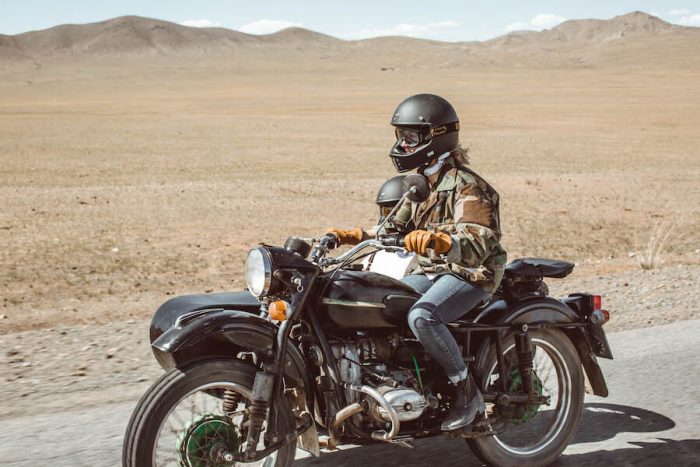
How to Explore Mongolia by Motorcycle: Moto Trip Mongolia
Who this trip is perfect for: New and experienced motorcyclists looking to adventure in style.
I may be biased since I designed this trip with some friends, and I personally lead this adventure … but it’s good .
Along with the nomadic herders and translators we bring along who will open your eyes to Mongolian life and culture in one of the most unique ways possible, this experience will make you rethink everything you thought you knew about life, travel, and most importantly–yourself.
What to expect on a Moto Trip Mongolia itinerary :
- A vintage Ural motorcycle with sidecar (so, 2 riders per motorcycle– perfect for bringing a friend).
- A motorcycle driving experience that includes off-roading across the Mongolian steppe.
- All drivers must have a motorcycle license and proof of travel insurance. Riders in the sidecar do not need a motorcycle license but must have travel insurance. The tour is set up so that drivers and riders will switch throughout the trip, but if someone doesn’t want to drive (or doesn’t have a motorcycle license), that’s okay too–they can be the passenger the entire duration of the trip!
- While it is required that you have a motorcycle license for this trip, this is a great trip for new and beginner motorcyclists! These Urals are easy to manage since you’re on three wheels, and there isn’t much chance of a traffic accident out on the steppe–it’ll be just us out there!
- And I can’t forget to mention, this is a great trip for females since it’s led by me !
- All meals, accommodations, transportation, motorcycles, and fuel are included.
- The trip also includes a follow car for carrying luggage, a translator, and motorcycle mechanic who will repair and tune up the bikes all along the way.
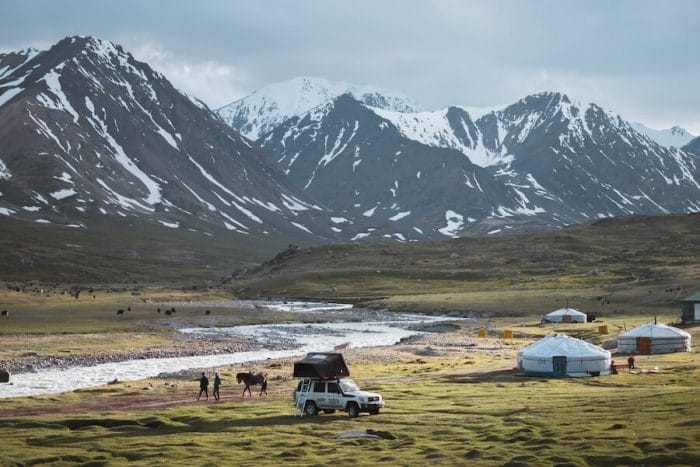
Self-Drive Mongolia and Take a Photography Masterclass Along the Way: Follow the Tracks
Who this trip is perfect for: Self-sufficient explorers looking for great photos for the ‘gram.
I really, really like the Follow the Tracks model. It’s a self-driving tour plus a photography masterclass designed by Max Muench, a guy you’ve almost certainly seen (more like, stalked) on Instagram .
You can choose from a few different routes (I recommend the Gobi Desert one), all of which start and end in Ulaanbaatar. You’ll have your own rental car, car camp essentials, and an iPad loaded with everything you need to make the most of this go-at-your-own-pace adventure.
I recommend grabbing enough friends to do this trip with at least two cars so you can tow each other in case of any hairy situations. Plus, more people equal more fun.
What to expect from the Follow the Tracks experience:
- A rental car from Sixt Rent a Car will be waiting for you in Ulaanbaatar at the start of your trip.
- Each car has 4-wheel drive and is equipped with a rooftop tent for sleeping.
- The car will have a GPS system loaded onto an iPad for your use during your self-driving adventure. This iPad will also act as your photography masterclass workbook, pointing out the best spots to capture photos along the route, and the best camera settings to do so.
- Additionally, the car will have camping and kitchen equipment, but you are responsible for purchasing your own food–and fuel–for the duration of your trip. (I suggest stocking up on food in Ulaanbaatar before hitting the road. Once you reach the tiny soums (tiny villages) in the countryside, you never quite know what you’re going to find.)
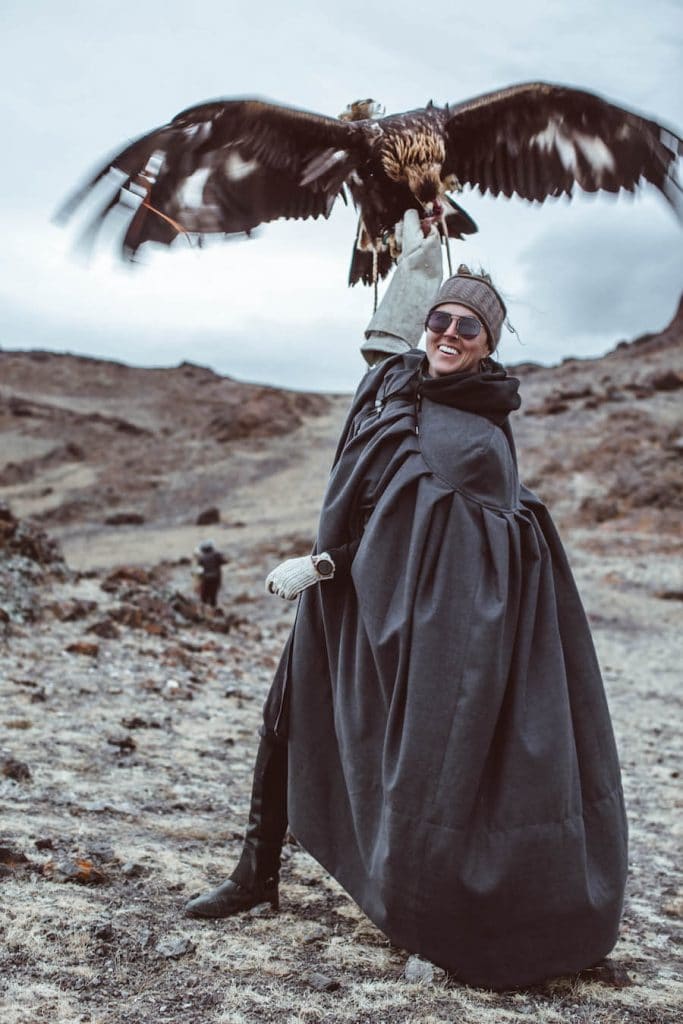
Ride Reindeer and Learn the Ancient Tradition of Hunting with Eagles: Erik Cooper Adventures
Who this trip is perfect for: Equestrians looking to really embed themselves with Mongolia’s unique–and very remote–tribes.
Erik is the gateway to the Tsaatan Tribe and Kazakh eagle hunters (he’s also the reason I fell head over heels in love with Mongolia). He’s spent the last eight summers in Mongolia and his connections are truly the reason why his tours are the most immersive, unique, and bang-for-your-buck.
You are thrown into the lifestyle, into the steppe, and into everything Mongolia has (for better or worse) to offer, with a touch of boujee along the way. There isn’t anyone that I trust more in Mongolia–or with my life. You can tell him I said that.
What to expect on an Erik Cooper Adventures Mongolia itinerary:
- All meals, accommodations, and transportation included. A translator will also accompany you during the duration of the trip.
- You MUST be comfortable on a horse. Because there are no roads where you’re going, you’ll be riding semi-wild horses for two days just to get to the Tsaatan Tribe’s home on the taiga, for example. If you are inexperienced on a horse, or afraid of riding, this trip is not for you. Erik will vet you before the trip, so don’t expect to fake your way into this experience, it’s simply too dangerous to do that.
- Each of Erik’s trips is different. You never know if you’ll get to ride reindeer across a glacier, watch locals compete in a reindeer race, or watch on as Eagle Hunters battle in ancient Kazakh games. No matter which trip of Erik’s you join, each one is specially curated and pulls out all of the stops.
Hope to see you all in Mongolia. You know where to find me when you do.
Planning a trip right now don’t miss my go-to websites for booking everything from flights and tours, to accommodation and more:.
- Booking.com for the best hotel deals
- World Nomads for flexible travel insurance
- VRBO for awesome rentals
- Skyscanner for finding the best flight deals
- Hostelworld for budget accommodation
- Rentalcars.com for easy car rentals

You Might Also Like
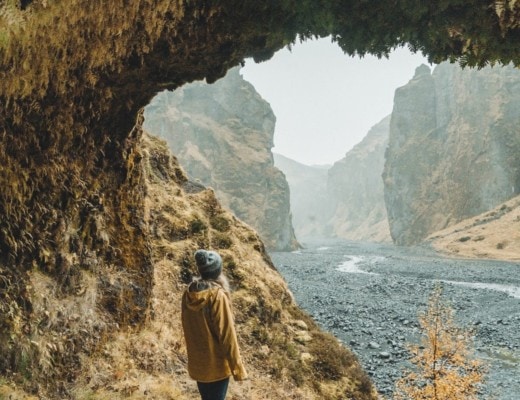
What to Pack for Iceland in the Fall (A Practical + Stylish Guide)
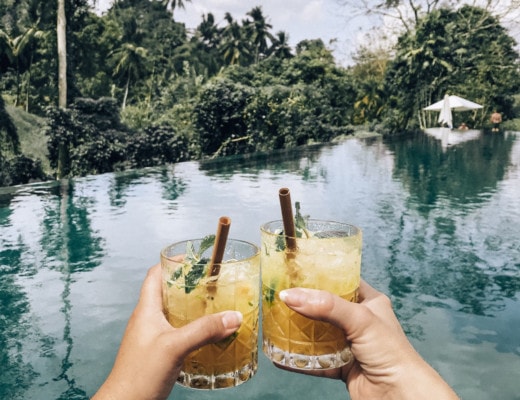
How to Travel More in 2019 (Actionable Tips and Tricks)!
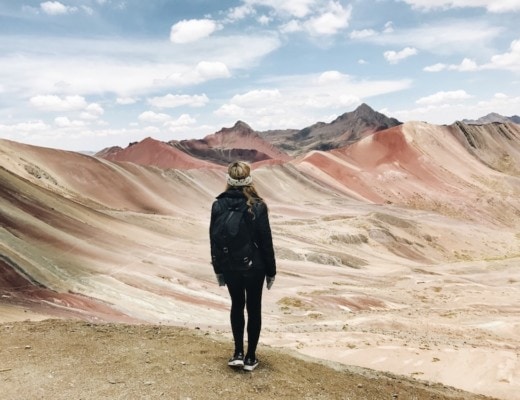
These Amazing Peru Landscapes Will Blow Your Mind
On the contrary, it’s very easy to eat vegan in Ulaanbaatar. There’s plenty of great vegan spots to eat there.
That’s helpful to know, Joe thank you. Can you share some of your favorite vegan spots and maybe we can update the post?
That’s an incredibly detailed and well thought out guide. Thank you
Leave a Reply Cancel Reply
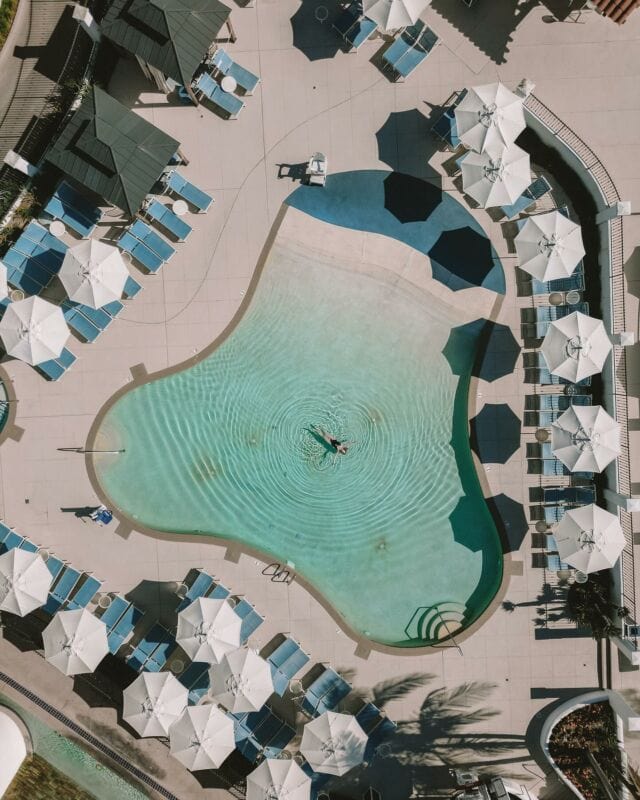
2023 © Live Like It's the Weekend - All Rights Reserved
Privacy Policy • Affiliate Disclaimer • Terms of Service
Update April 12, 2024
Information for u.s. citizens in the middle east.
- Travel Advisories |
- Contact Us |
- MyTravelGov |
Find U.S. Embassies & Consulates
Travel.state.gov, congressional liaison, special issuance agency, u.s. passports, international travel, intercountry adoption, international parental child abduction, records and authentications, popular links, travel advisories, mytravelgov, stay connected, legal resources, legal information, info for u.s. law enforcement, replace or certify documents.
Before You Go
Learn About Your Destination
While Abroad
Emergencies
Share this page:
Travel Advisory June 30, 2023
Kazakhstan - level 1: exercise normal precautions.
Reissued after periodic review with updates to the Travel Advisory Level. Exercise normal precautions in Kazakhstan.
Read the country information page for additional information on travel to Kazakhstan.
If you decide to travel to Kazakhstan:
- Enroll in the Smart Traveler Enrollment Program ( STEP ) to receive Alerts and make it easier to locate you in an emergency.
- Follow the Department of State on Facebook and Twitter .
- Review the Country Security Report for Kazakhstan.
- Visit the CDC page for the latest Travel Health Information related to your travel.
- Prepare a contingency plan for emergency situations. Review the Traveler’s Checklist .
Embassy Messages
View Alerts and Messages Archive
Quick Facts
Three months.
Yes, for stays longer than 30 days
Embassies and Consulates
U.s. embassy astana.
Rakhymzhan Koshkarbayev Avenue 3 Astrana 010010 Kazakhstan Telephone: +(7) (7172) 70-21-00 Emergency After-Hours Telephone: +(7) (7172) 70-21-00 (or 011-7-717-270-21-00 from the U.S.) Fax: +(7) (7172) 70-22-80 Email: [email protected]
U.S. Consulate General Almaty Zholdasbekov Street 97 Samal-2 Almaty, Kazakhstan 050051 Telephone : +(7) (727) 250-49-01 Emergency After-Hours Telephone: +7 727-250-76-12 (or 011-7-727-250-76-12 from the U.S.) Email: [email protected]
Destination Description
See the Department of State’s Fact Sheet on Kazakhstan for information on U.S.-Kazakhstan relations.
Entry, Exit and Visa Requirements
Please see the visa page of Kazakhstan’s Embassy in Washington for the most current visa information.
- U.S. travelers may enter Kazakhstan without a visa for stays up to 30 days on each visit and may not stay more than a cumulative 90 days within a six-month period.
- Individuals seeking to stay beyond the 90-day limit within a six-month period may apply for a 10-year Kazakh tourist or business visa. These visas contain restrictions, permitting maximum stays of 60 or 30 days per visit, depending on the type of visa.
- Violating the authorized period of stay in Kazakhstan or engaging in activities inconsistent with your visa category may result in fines, imprisonment, and/or delays upon exit.
If you wish to apply for a permanent residency permit in Kazakhstan, prior to travel you should determine what documentation is required, including criminal background checks, and obtain any necessary authentication for those documents.
- For information about U.S. background checks, refer to the Federal Bureau of Investigation’s website . The U.S. Mission in Kazakhstan does not fingerprint U.S. citizens.
- For information on authentication of documents, please see the Department of State Website .
- You must receive permission from the Kazakh government before traveling to certain areas bordering China and cities close to military installations. Please check the Ministry of Internal Affairs website for the list of closed areas or contact Kazakhstan’s Embassy in Washington, DC .
Russian Arrest Warrants: Kazakhstan and Russia have law enforcement cooperation agreements in place that obligate information sharing on certain security and law enforcement matters. Russian authorities may request that their Kazakh counterparts give increased scrutiny to former and current U.S. government and military personnel with prior work in Russia. Additionally, Russian law enforcement or security services may request that the Kazakh authorities detain U.S. citizens upon entry or exit based on existing mutual assistance agreements.
HIV/AIDS Entry Restrictions: Some HIV/AIDS-related restrictions exist for foreign residents and workers in Kazakhstan.
- Visitors who receive a Kazakh work or residency visa must submit a health certification form, including negative HIV test results, with their application to the Migration Police in the city where they intend to work or reside in order to receive a work or residency permit after arriving in Kazakhstan. The results must be less than three months old.
- The city HIV clinic in the place of registration can conduct the test or may certify test results performed abroad.
- If the original test results are in a language other than Russian or Kazakh, they must be accompanied by an official, notarized translation.
- Please verify this information with Kazakhstan’s Embassy in Washington.
Find information on dual nationality , prevention of international child abduction , and custom regulations on our websites.
Safety and Security
Demonstrations may occur. They may take place in response to political or economic issues, or on politically significant holidays. They may be accompanied by internet outages, and communications may be disrupted.
- Demonstrations can be unpredictable. Avoid areas around protests and demonstrations.
- Even demonstrations intended to be peaceful can turn confrontational and escalate into violence.
- Past demonstrations have ended in mass arrests.
- Check local media for updates and traffic advisories.
Terrorism: Terrorist groups and those inspired by such organizations are intent on attacking U.S. citizens abroad. Terrorists are increasingly using less sophisticated methods of attack – including knives, firearms, and vehicles – to target crowds more effectively. Frequently, their aim is unprotected and/or vulnerable targets, such as:
- High-profile public events (sporting contests, political rallies, demonstrations, holiday events, celebratory gatherings, etc.)
- Hotels, clubs, and restaurants frequented by tourists
- Places of worship
- Shopping malls and markets
- Public transportation systems (including subways, buses, trains, and scheduled commercial flights)
For more information, see our Terrorism page.
Crime: The most common crimes encountered by foreign visitors are purse snatching, pickpocketing, assaults, and robberies, although all of these incidents are rare. Be vigilant and do not carry large sums of money or valuables on the street. Financial fraud, such as ATM skimming, is prevalent.
The police sometimes conduct identification checks in public areas. Police are not required to demonstrate probable cause to detain individuals. Upon request, you must produce either a passport or an Embassy or Consulate-certified copy of your passport.
Kazakh security personnel may at times place foreign visitors under surveillance. Hotel rooms and telephones may be monitored, and personal possessions in hotel rooms may be searched.
Harassment and extortion by imposters, genuine law enforcement, and other officials does occur. Never voluntarily give your wallet to anybody. If pressured by a police officer, tell the officer that you will report the behavior to the U.S. Embassy or Consulate and to the officer’s supervisors. Try to obtain the officer's name, badge number, and license plate number, and note where and when the incident happened.
Do not use unmarked taxis. At the airport, do not leave with anyone who does not show pre-arranged identification, even if the person is holding a sign with your name.
The U.S. Mission in Kazakhstan is aware of isolated incidents when foreigners have been drugged, robbed, and physically assaulted at bars and nightclubs as well as in unmarked taxis.
International Financial Scams: See the Department of State and the FBI pages for information.
Victims of Crime: U.S. citizen victims of sexual assault are encouraged to contact the U.S. Embassy or Consulate for assistance. Report crimes to the local police at 102 and contact the U.S. Embassy at (+7) 7172-70-21-00 or the U.S. Consulate at (+7) 7272-50-49-01. Remember that local authorities are responsible for investigating and prosecuting crime.
See our webpage on help for U.S. victims of crime overseas .
- Help you find appropriate medical care.
- Assist you in reporting a crime to the police.
- Contact relatives or friends with your written consent.
- Provide general information regarding the victim’s role during and after the local investigation.
- Provide a list of local attorneys.
- Provide information on victim’s compensation programs in the United States.
- Provide an emergency loan for repatriation to the United States and/or limited medical support in cases of destitution.
- Help you find accommodation and arrange flights home.
- Replace a stolen or lost passport.
Domestic Violence: U.S. citizen victims of domestic violence are encouraged to contact the Embassy or Consulate for assistance.
Tourism: The tourism industry is unevenly regulated, and safety inspections for equipment and facilities do not commonly occur. Hazardous areas/activities are not always identified with appropriate signage, and staff may not be trained or certified either by the host government or by recognized authorities in the field. In the event of an injury, appropriate medical treatment is typically available only in/near major cities. First responders are generally unable to access areas outside of major cities and to provide urgent medical treatment. U.S. citizens are encouraged to purchase medical evacuation insurance. See our webpage for more information on insurance providers for overseas coverage .
Local Laws & Special Circumstances
Criminal Penalties: When traveling to a foreign country, you are subject to that country’s local laws. If you violate local laws, even unknowingly, you may be expelled, arrested, or imprisoned. Individuals establishing a business or practicing a profession that requires additional permits or licensing should seek information from the competent local authorities, prior to practicing or operating a business.
- Penalties for possessing, using, or trafficking in illegal drugs in Kazakhstan are severe, and convicted offenders can expect long jail sentences and heavy fines.
- You may be taken in for questioning if you don’t have your passport with you or if you take pictures of certain buildings or other sensitive infrastructure.
- Kazakh customs authorities may enforce strict regulations concerning the export of items such as antiques. Please see our Customs Information page for more information.
- Kazakhstan has a zero-tolerance policy for driving under the influence of alcohol. You can be detained immediately if you are driving under the influence of alcohol.
Furthermore, certain acts of U.S. citizens overseas are prosecutable as crimes in the United States even if they are not illegal under the local law. For examples, see our website on crimes against minors abroad and the U.S. Department of Justice .
Arrest Notification: If you are arrested or detained, ask police or prison officials to notify the Embassy or Consulate immediately. See our webpage for further information.
Counterfeit and Pirated Goods: Counterfeit and pirated goods are prevalent in many countries and they may be illegal according to the local laws. Counterfeit and pirated goods may pose significant risks to consumer health and safety. You may be subject to fines and/or have to give up the counterfeit and pirated goods if you bring them back to the United States. See the U.S. Customs and Border Protection website and the U.S. Department of Justice website for more information.
Faith-Based Travelers: Visitors to Kazakhstan engaging in missionary work or other religious activities must register with the Local Executive Authority office (Akimat) where the activities will take place. Kazakhstan also imposes restrictions on the importation of religious literature.
You may be fined and deported from Kazakhstan for performing any religious work without proper religious worker registration. Representatives of faith-based non-governmental organizations are considered subject to the registration requirement, even if their activities are not religious in nature.
- Faith-Based Travel Information
- International Religious Freedom Report – see country reports
- Human Rights Report – see country reports
- Hajj Fact Sheet for Travelers
International Volunteers:
- Best Practices for Volunteering Abroad
LGBTQI+ Travelers: There are no legal restrictions on same-sex sexual relations or the organization of LGBTQI+ events in Kazakhstan; however, these events may be disrupted by local authorities or members of the public. Negative social attitudes towards LGBTQI+ persons are widespread, and local LGBTQI+ persons are sometimes subject to physical and verbal abuse, as well as unwanted attention from police. See our LGBTQI+ Travel Information page and section 6 of our Human Rights report for further details.
Travelers with Disabilities: The law in Kazakhstan prohibits discrimination against persons with disabilities, and the law is enforced. Social acceptance of persons with disabilities in public is not as prevalent as in the United States. Expect accessibility to be limited in public transportation, lodging, communication/information, and general infrastructure.
Students: See our Students Abroad page and FBI travel tips .
Women Travelers: Domestic violence is common and sexual assaults do occur, though there have not been recent reports of sexual assault committed against U.S. citizens. See our travel tips for women travelers .
Options for medical care are limited and well below U.S. standards. U.S. citizens often depart Kazakhstan for medical treatment, including many routine procedures. Some prescriptions and over-the-counter medicines are not widely available in Kazakhstan.
For emergency services in Kazakhstan call the Rescue Service by dialing 112. Other provider numbers are: 101 for Fire, 102 for Police, 103 for Emergency Medical Assistance, and 104 in the event of a gas leak.
Ambulance services are:
- not present throughout the country and are unreliable in most areas except in major cities.
- not equipped with state-of-the-art medical equipment.
- not staffed with trained paramedics and often have little or no medical equipment.
Injured or seriously ill travelers may prefer to take a taxi or private vehicle to the nearest major hospital rather than wait for an ambulance.
The U.S. Embassy maintains a list of doctors and hospitals . We do not endorse or recommend any specific medical provider or clinic.
The Department of State does not pay medical bills. Be aware that U.S. Medicare/Medicaid does not apply overseas. Most hospitals and doctors overseas do not accept U.S. health insurance.
Medical Insurance: Make sure your health insurance plan provides coverage overseas. Most care providers overseas only accept cash payments. See our webpage for more information on insurance providers for overseas coverage. Visit the U.S. Centers for Disease Control and Prevention for more information on type of insurance you should consider before you travel overseas. Doctors and hospitals often expect cash payment for health services.
We strongly recommend supplemental insurance to cover medical evacuation.
Always carry prescription medication in original packaging, along with your doctor’s prescription. Check with Kazakhstan’s National Center for Expertise to ensure the medication is legal in Kazakhstan.
Water Quality : In many areas, tap water does not meet U.S. standards for potability. Many restaurants and hotels serve tap water unless bottled water is specifically requested, and ice for drinks may be made using tap water. Bottled water and beverages are generally safe. Be aware. Surface waters (streams, rivers, and ponds) are likely to be contaminated with animal waste. Try to avoid contact with these waters.
Vaccinations: Be up-to-date on all vaccinations recommended by the U.S. Centers for Disease Control and Prevention.
Further Health Information :
- World Health Organization
- U.S. Centers for Disease Control and Prevention
Air Quality: Visit AirNow Department of State for information on air quality at U.S. Embassies and Consulates.
Earthquakes: Kazakhstan is an earthquake-prone country. The U.S. Department of State has ranked the earthquake threat level within the Almaty region in particular as Level 4 (the highest level assigned). Building practices within Kazakhstan do not generally meet U.S. seismic standards. Local authorities do not have sufficient resources to respond to a large-scale disaster.
Adventure Travel
- Visit the U.S. Centers for Disease Control and Prevention website for more information about Adventure Travel .
Travel and Transportation
Road Conditions and Safety: Roads in Kazakhstan may be in poor repair, especially in rural areas. Signage and lighting on roadways can be poor.
- Potholes are common and are often dangerously deep.
- Mountainous roads, including the highway between Almaty and Bishkek, Kyrgyzstan, should be avoided at night or during poor weather.
- Roads outside urban areas are often closed in winter months due to high winds and drifting snow.
Traffic Laws: Drivers sometimes disregard traffic signals, ignore lane markings, drive after excessive alcohol consumption (despite official “zero tolerance”), drive into oncoming lanes of traffic, and move at excessive speed – including during adverse weather. Pedestrians sometimes ignore crosswalks and dart in front of cars.
- Visitors should drive defensively at all times, as many local drivers do not follow traffic laws. Road rage can be a problem, and we recommend a non-confrontational response to such behavior.
- Accidents involving severe injury and/or death do occur.
- Traffic police have reportedly stopped cars to extort bribes on city streets and at periodic checkpoints on major highways.
Public Transportation: Buses can be crowded and unsafe.
Due to the danger of theft or assault, be selective regarding which taxi you use, and always avoid entering a cab that already contains persons other than the driver. The U.S. Mission highly discourages hailing unlicensed private vehicles on the street and negotiating a fee with the driver on the spot. Ridesharing applications are widely available.
See our Road Safety page for more information. Also, visit the website of Kazakhstan’s national tourist office for additional information on road safety.
Aviation Safety Oversight: As there is no direct commercial air service to the United States by carriers registered in Kazakhstan, the U.S. Federal Aviation Administration (FAA) has not assessed the government of Kazakhstan’s Civil Aviation Authority for compliance with International Civil Aviation Organization (ICAO) aviation safety standards. Further information may be found on the FAA’s safety assessment page .
U.S. government personnel are prohibited from traveling for official duties on Kazakh airlines without prior approval, except for Air Astana and FlyArystan, due to safety concerns.
For additional travel information
- Enroll in the Smart Traveler Enrollment Program (STEP) to receive security messages and make it easier to locate you in an emergency.
- Call us in Washington, D.C. at 1-888-407-4747 (toll-free in the United States and Canada) or 1-202-501-4444 (from all other countries) from 8:00 a.m. to 8:00 p.m., Eastern Standard Time, Monday through Friday (except U.S. federal holidays).
- See the State Department’s travel website for the Worldwide Caution and Travel Advisories .
- Follow us on Twitter and Facebook .
- See traveling safely abroad for useful travel tips.
Review information about International Parental Child Abduction in Kazakhstan . For additional IPCA-related information, please see the International Child Abduction Prevention and Return Act ( ICAPRA ) report.
Travel Advisory Levels
Assistance for u.s. citizens, kazakhstan map, learn about your destination, enroll in step.

Subscribe to get up-to-date safety and security information and help us reach you in an emergency abroad.
Recommended Web Browsers: Microsoft Edge or Google Chrome.
Make two copies of all of your travel documents in case of emergency, and leave one with a trusted friend or relative.
Afghanistan
Antigua and Barbuda
Bonaire, Sint Eustatius, and Saba
Bosnia and Herzegovina
British Virgin Islands
Burkina Faso
Burma (Myanmar)
Cayman Islands
Central African Republic
Cote d Ivoire
Curaçao
Czech Republic
Democratic Republic of the Congo
Dominican Republic
El Salvador
Equatorial Guinea
Eswatini (Swaziland)
Falkland Islands
France (includes Monaco)
French Guiana
French Polynesia
French West Indies
Guadeloupe, Martinique, Saint Martin, and Saint Barthélemy (French West Indies)
Guinea-Bissau
Isle of Man
Israel, The West Bank and Gaza
Liechtenstein
Marshall Islands
Netherlands
New Caledonia
New Zealand
North Korea (Democratic People's Republic of Korea)
Papua New Guinea
Philippines
Republic of North Macedonia
Republic of the Congo
Saint Kitts and Nevis
Saint Lucia
Saint Vincent and the Grenadines
Sao Tome and Principe
Saudi Arabia
Sierra Leone
Sint Maarten
Solomon Islands
South Africa
South Korea
South Sudan
Switzerland
The Bahamas
Timor-Leste
Trinidad and Tobago
Turkmenistan
Turks and Caicos Islands
United Arab Emirates
United Kingdom
Vatican City (Holy See)
External Link
You are about to leave travel.state.gov for an external website that is not maintained by the U.S. Department of State.
Links to external websites are provided as a convenience and should not be construed as an endorsement by the U.S. Department of State of the views or products contained therein. If you wish to remain on travel.state.gov, click the "cancel" message.
You are about to visit:
61 Useful Tips for Travelling to Mongolia (Backpacker’s Guide)
March 28, 2020.
Everything you need to know about travelling in Mongolia. Where to visit, how to get around, safety, and more are covered in this comprehensive travel guide.
Mongolia is one of my favourite countries I’ve ever visited. Known as the “land of the blue sky”, Mongolia is home to an incredible nomadic culture and gorgeous natural beauty. It’s also one of the least visited countries in the world, making it a great off-the-beaten-path backpacking destination.
I spent over three weeks backpacking around Mongolia and learned a lot about the best ways to travel around it. I can’t wait to get back soon and see more of it.
In this post, I’ll go over everything you need to know about travelling in Mongolia based on my experience.
After reading this guide, you’ll be ready to head out and see the rugged streets of Ulaanbaatar, the singing sand dunes of the Gobi Desert, and the endless steppe of the Orkhon Valley.
- 1 Backpacking Mongolia
- 2 Visas for travelling to Mongolia
- 3 Safety in Mongolia
- 4 Money in Mongolia
- 5 Communication in Mongolia
- 6 Getting to Mongolia
- 7 People & Culture of Mongolia
- 8 Where to visit in Mongolia
- 9 Tours in Mongolia
- 10 Food in Mongolia
- 11 Accommodation in Mongolia
- 12 Transportation in Mongolia
- 13 Mongolia Travel Itineraries
- 14 When to visit Mongolia
- 15 Travel Costs in Mongolia
- 16 Internet & SIM Cards in Mongolia
- 17 Solo Travel in Mongolia
- 18 Female Travel in Mongolia
- 19 Travelling in Mongolia Wrap-Up
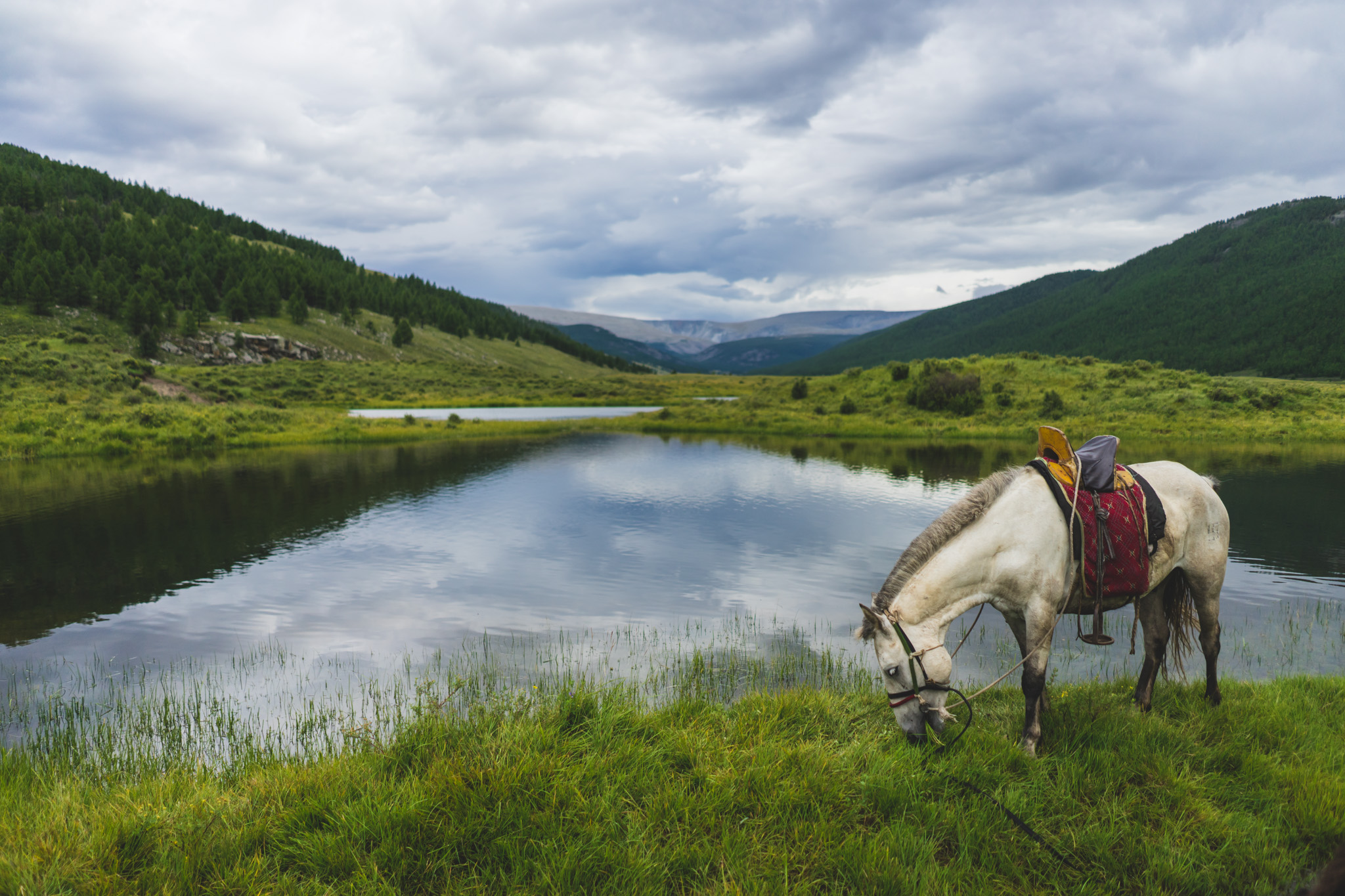
Backpacking Mongolia
Mongolia is the perfect backpacking destination. It’s got a ton of unique landscapes including the Gobi Desert to the Altai Mountains. Mongolians are very friendly and want to show tourists a good time. It’s an affordable country to travel in, especially if you’re willing to rough it a bit.
I definitely think more people need to add backpacking Mongolia to their bucket list. It’s a country like no other and is a must-see if you’re planning a long trip to Asia.
Visas for travelling to Mongolia
1 – Visa-free access to Mongolia: People from certain countries are lucky enough to get visa-free access to enter Mongolia by air or land! Visa-free length varies by passport, here is the current list:
90 days visa-free : Argentina, Belarus, Brazil, Chile, Kazakhstan, Kyrgyzstan, Macao, Serbia, Ukraine (with invitation), USA 30 days visa-free : Canada, Cuba, Germany, Israel, Japan, Laos, Malaysia, Russia, Singapore, Thailand, Turkey, Uruguay 21 days visa-free : Philippines 14 days visa-free : Hong Kong
2 – Mongolia visa at an embassy: If you’re not on the above list of countries, you should apply for your Mongolia visa at your nearest Mongolia embassy.
To apply for a tourist visa, you’ll need:
- Completed application form
- 3.5×4.5cm photo
- Copy of hotel booking in Mongolia
- Copy of flight/train tickets
For the most up-to-date requirements, contact the embassy that you wish to apply at.

3 – It is no longer possible to extend your visa in Mongolia: While you used to be able to apply for a 30-day visa extension in Ulaanbaatar, as of 2019 this is no longer the case.
Travellers have been reporting that they are told to simply pay a $4 per day overstay fee instead, as long as the overstay is less than 58 days. If you overstay longer than 58 days, you will be deported.
Safety in Mongolia
4 – Is it safe to travel to Mongolia?: I’d say that Mongolia is a pretty safe country to visit. According to the Canadian government (which is usually pretty conservative with travel advisories), you should simply exercise normal precautions while visiting Mongolia.
Be careful around drunk people. Unfortunately, certain people can become quite aggressive, especially if you’re a foreign dude talking to a Mongolian girl. Avoid walking around Ulaanbaatar in the dark – it’s better to take a taxi.
Carry some medical supplies if you’re going anywhere outside of Ulaanbaatar. It’s a long way to a pharmacy when you’re in the middle of the Gobi Desert.
Use common sense and you’ll be perfectly fine when backpacking Mongolia, but of course, you should purchase travel insurance before you visit Mongolia.
For more information, check out my post on staying safe in Mongolia .
Travel Insurance for Mongolia
5 – Travel insurance for Mongolia: No matter where you go, you should always have travel insurance – Mongolia is no exception. Even though Mongolia is safe, accidents can still happen.
I personally use and recommend World Nomads. It’s designed for adventurous travellers with cover for overseas medical, evacuation, baggage and a range of adventure sports and activities (important if you plan on doing any treks or other outdoor adventures while backpacking in Mongolia).
GET YOUR FREE QUOTE FROM WORLD NOMADS HERE
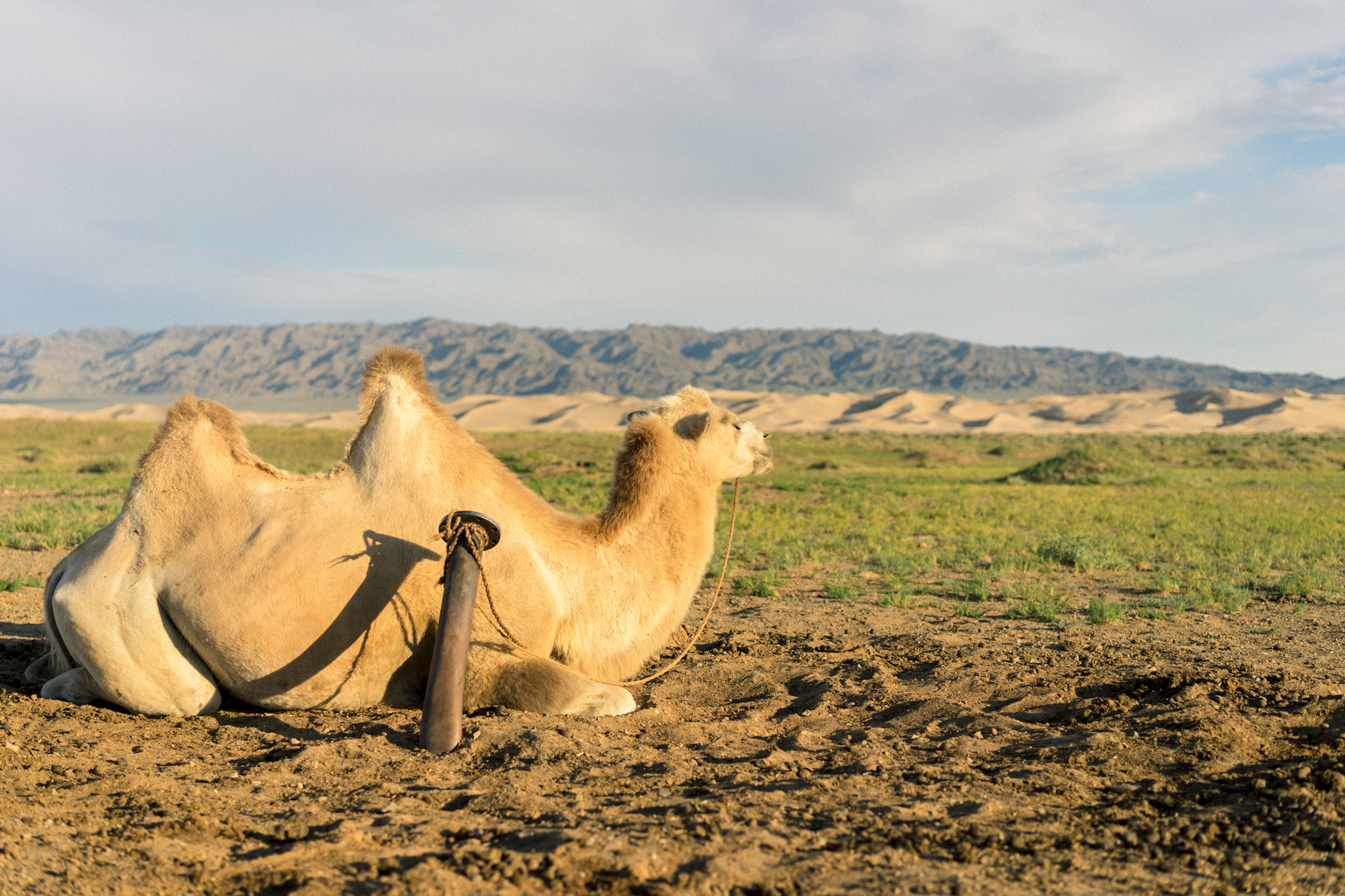
Money in Mongolia
6 – The Mongolian tugrik (MNT) is the official currency of Mongolia: Sometimes also written as tögrög, the Mongolian currency is quite low in value. The current rate as of January 2020 is 1 USD = 2740 MNT .
7 – There are plenty of ATM machines in Ulaanbaatar: In Ulaanbaatar, it’s easy to find an ATM machine that will accept an international Visa or Mastercard, and this is how I got all of my local currency during my trip to Mongolia. Credit cards are not commonly accepted at businesses in Mongolia, but you may have some luck at high-end hotels and restaurants.
8 – Outside of Ulaanbaatar, ATMs are unreliable: If you’re planning on heading out into the countryside, you should bring as much cash as you think you’ll need. It’s difficult to find a working ATM even in some of the larger towns, and even then it might be out of cash.
9 – Converting USD to MNT works too: You can also bring USD from home and convert it to tugrik when you’re in Mongolia, although you might not get quite as good a rate as if you’d used an ATM. It may be possible to change RMB, EUR, or RUB, but don’t count on this.
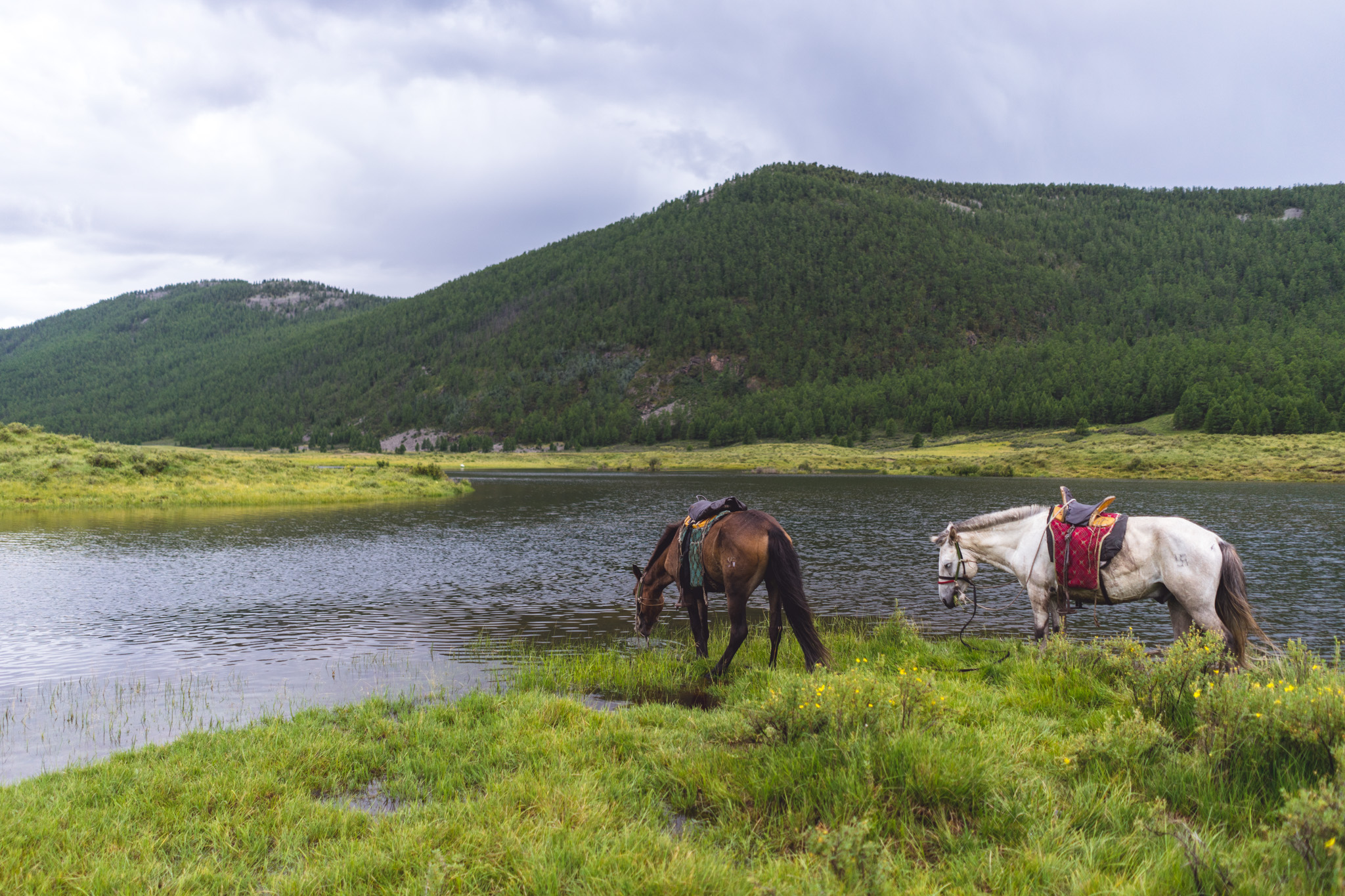
Communication in Mongolia
10 – Mongolian is the official language of Mongolia: Spoken by around 95% of the population, Mongolian is by far the most common language in Mongolia.
11 – In Mongolia, the language is written using the Cyrillic alphabet: While there is a traditional Mongolian script that is used in Inner Mongolia province of China, Mongolia uses the Cyrillic script to write Mongolian.
12 – You don’t need to know Mongolian to travel in Mongolia: You don’t need to know any Mongolian to travel in Mongolia, but knowing the Cyrillic alphabet can be a huge help. If you learn the Cyrillic alphabet, you’ll be able to read signs and certain words on menus. It only takes a few hours to learn the basics – check out this resource to learn more.
Luckily, most people who travel outside of Ulaanbataar will be with an English-speaking guide, so they’ll help you get over any language barriers in rural areas.
Really want to impress the locals? Pick up a Mongolian Phrasebook and try to use it while you’re in Mongolia!
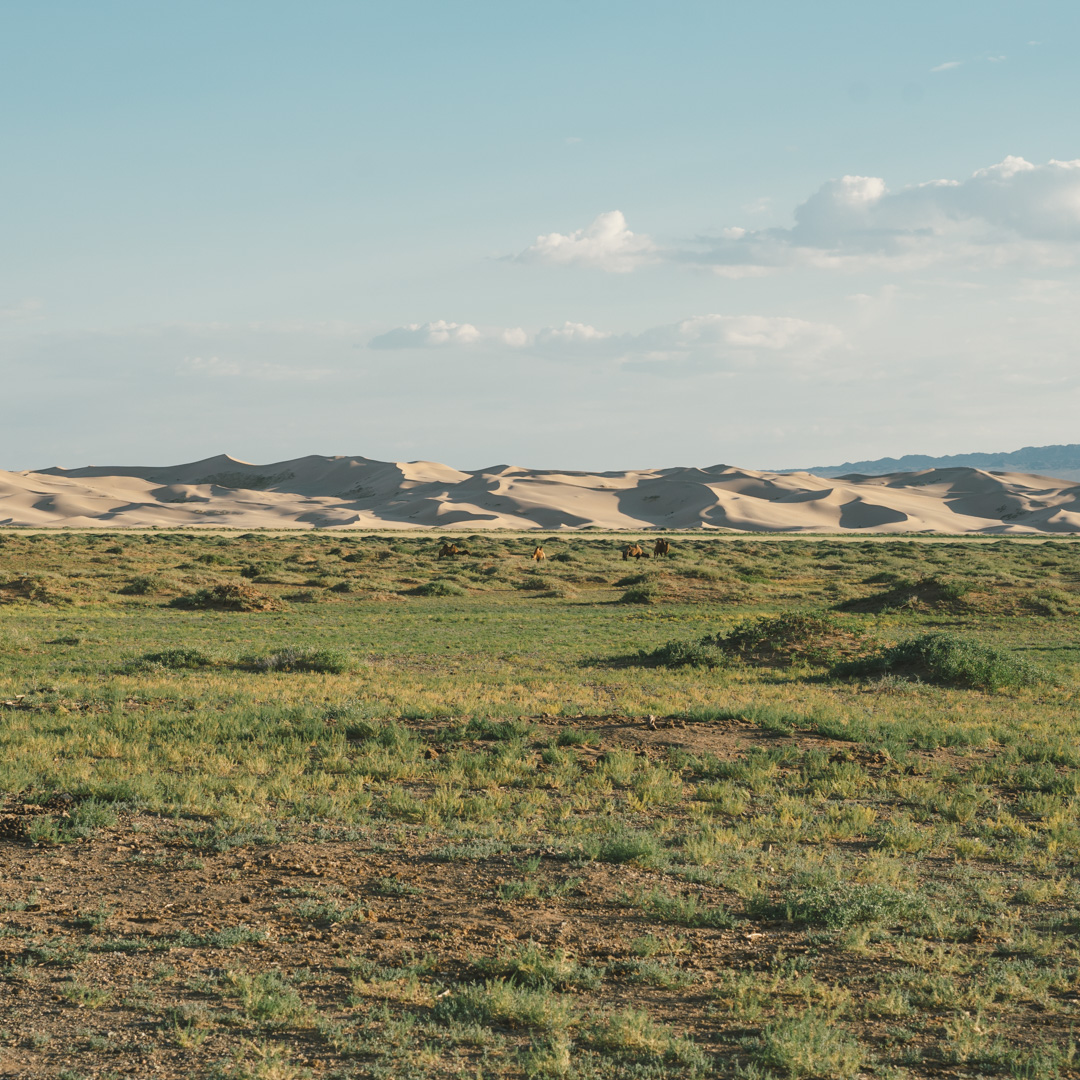
Getting to Mongolia
13 – Overlanding into Mongolia via either China or Russia is totally possible: There are a number of border crossings to both China and Russia that are open to foreigners. Border procedures are fairly straightforward, as long as you’ve got a valid visa (or don’t need one).
14 – The current border crossings with China are:
Erlian – Zamin Uud: This border crossing is quite straightforward. I wrote a complete guide to getting from Beijing to Ulaanbaatar , so check that out if you’re planning on taking that route (or that route in reverse).
Takashiken – Bulgan: Border crossing between Urumqi and the Mongolian Altai. It is possible to reach this border via public transport from Urumqi and continue onto Khovd by shared taxi. Expect long border procedures on the Chinese side (including a search of electronic devices).
One other lesser-used border that is open for tourists is the Khatavch – Bichigt Zuun crossing. Do note that the border crossings with Xinjiang Province are subject to random closures.
15 – The current border crossings with Russia are:
Kyakhta – Altanbulag : The main road border crossing between Ulan-Ude and Ulaanbaatar. There are direct buses between the two cities, taking about 12 hours to complete the trip.
Sükhbaatar – Naushki : This is the railroad border crossing for the Trans-Mongolian Railway between Ulan-Ude and Ulaanbaatar. Very straightforward – immigration officers will board your train and stamp you in.
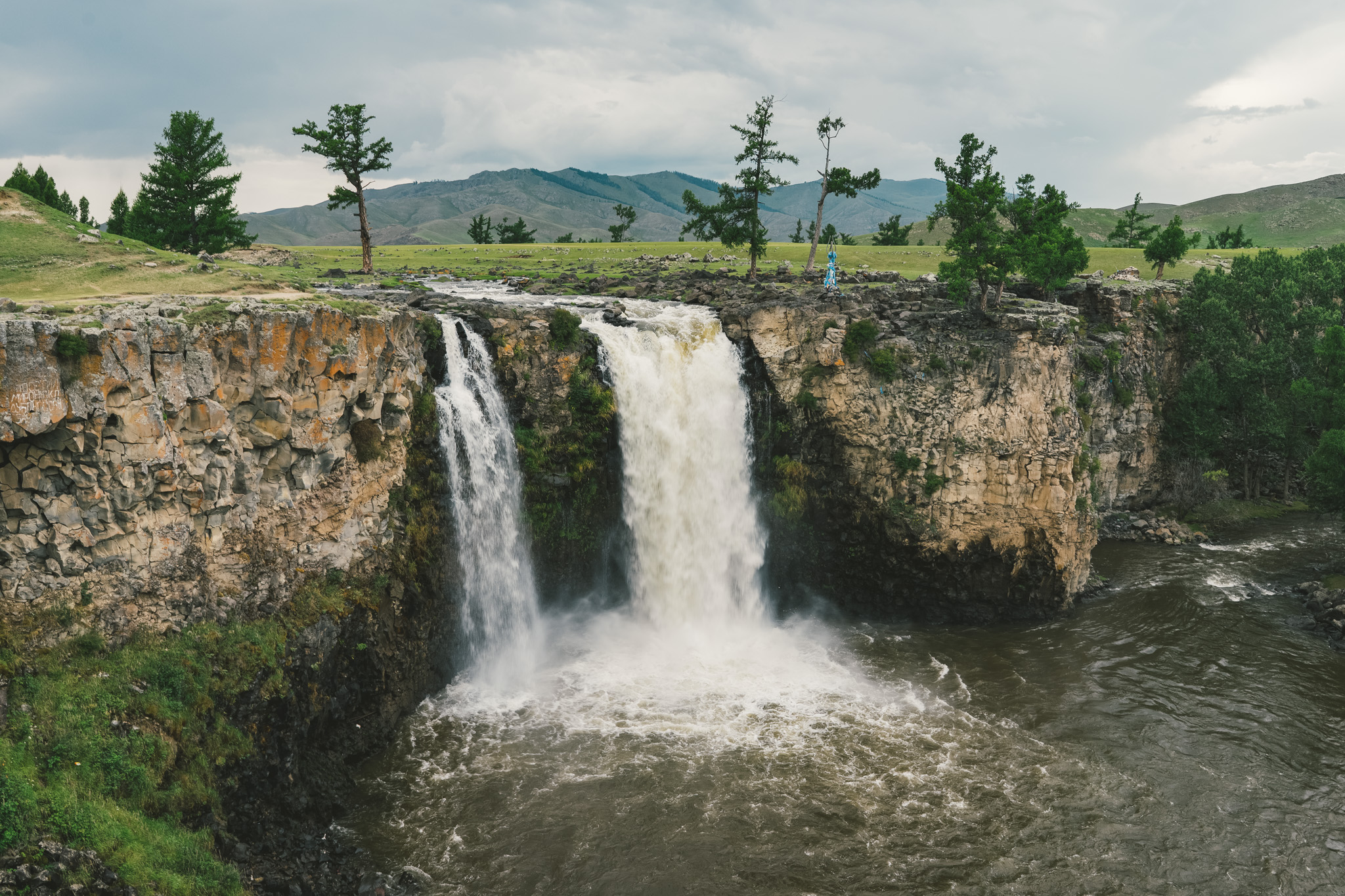
16 – Mongolia is an expensive country to fly into, and isn’t well connected by air: It can be a bit pricey to fly into Mongolia from Europe and North America. Ulaanbaatar (ULN) is the only airport in Mongolia with international flights, so you’ll most definitely be flying into here.
17 – Mongolia’s flag carrier is MIAT Mongolian Airlines: They offer direct flights to Frankfurt, Moscow, Bangkok, Beijing, Hong Kong, Guangzhou, Seoul, Busan, Tokyo, and Osaka.
Other airlines operate flights from Ulaanbaatar to Istanbul, Astana, Irkutsk, Tianjin, and Hohhot.
As you can see, there aren’t that many places you can fly to Mongolia from without a connecting flight.
I recommend using Google Flights to find the cheapest flights to Mongolia.
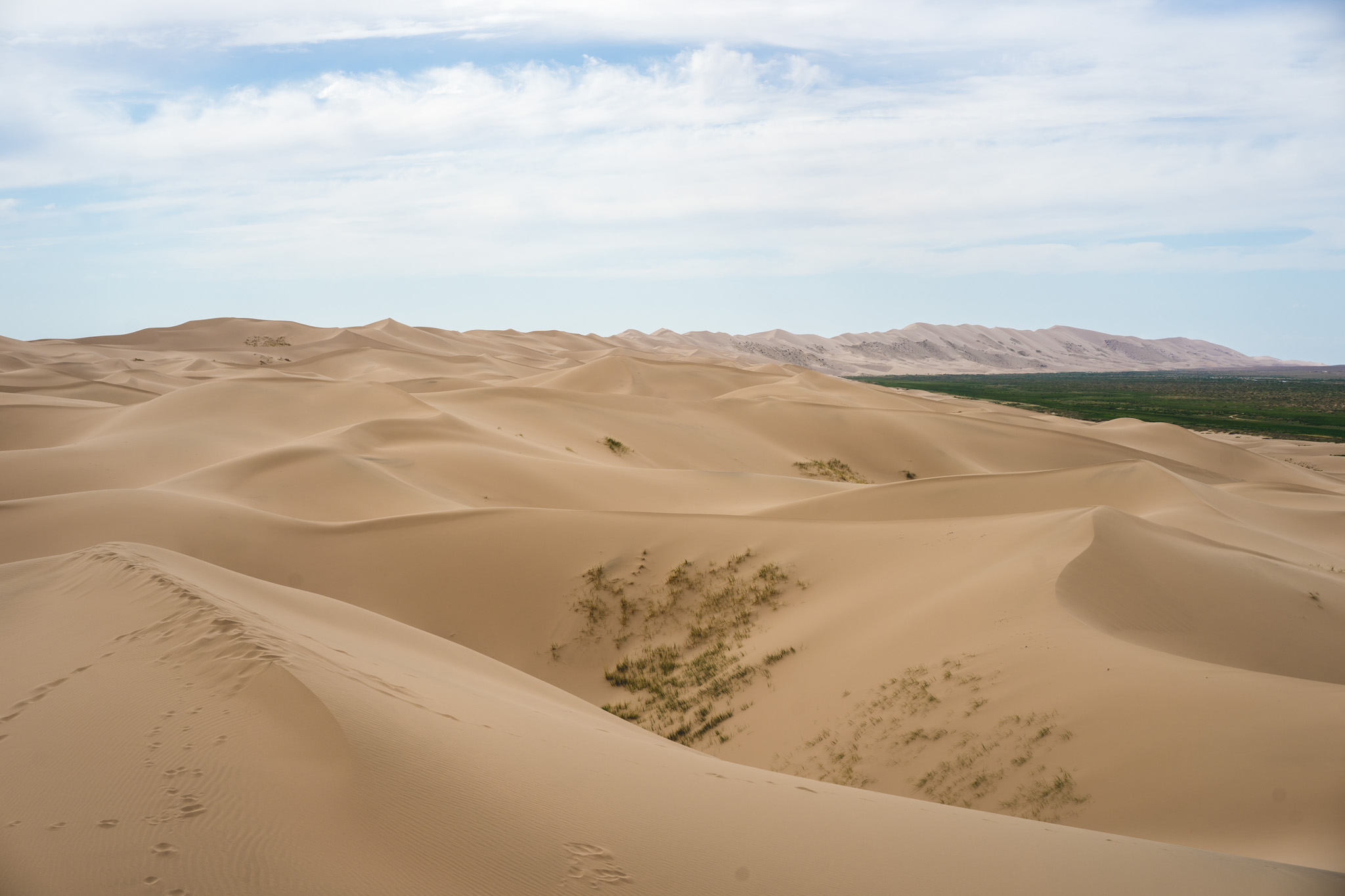
People & Culture of Mongolia
18 – Mongolia is the most sparsely populated country on Earth: A lot of the country’s traditions and culture stems from this fact.
19 – The country became independent from the Qing Dynasty in 1911: There is a lot of shared history between Mongolia and China, although nowadays Mongolians don’t look upon China very fondly.
20 – Most people in Mongolia are Mongolian: In fact, a whopping 96% of the population is Mongolian. The other 4% are Kazakhs in the far western Altai region of the country.
21 – Buddhism is the most popular religion in Mongolia: Over 50% of Mongolians are Buddhist, making it by far the most common religion. Another 39% are non-religious, and the remainders are split up between Islam, Shamanism, and Christianity.
22 – There isn’t really a dress code in Mongolia: There is no set dress code here, but it is still a conservative society so it’s best to dress modestly. In the central areas of Ulaanbaatar, things are a bit more liberal.
Where to visit in Mongolia
23 – Most of Mongolia is empty, so getting around can take a long time:
The country can be divided up into six distinct regions based on differences in culture and geography. Each region requires at least a week to properly visit (aside from Ulaanbaatar).
Let’s cover all of the best places to visit during your travels in Mongolia.
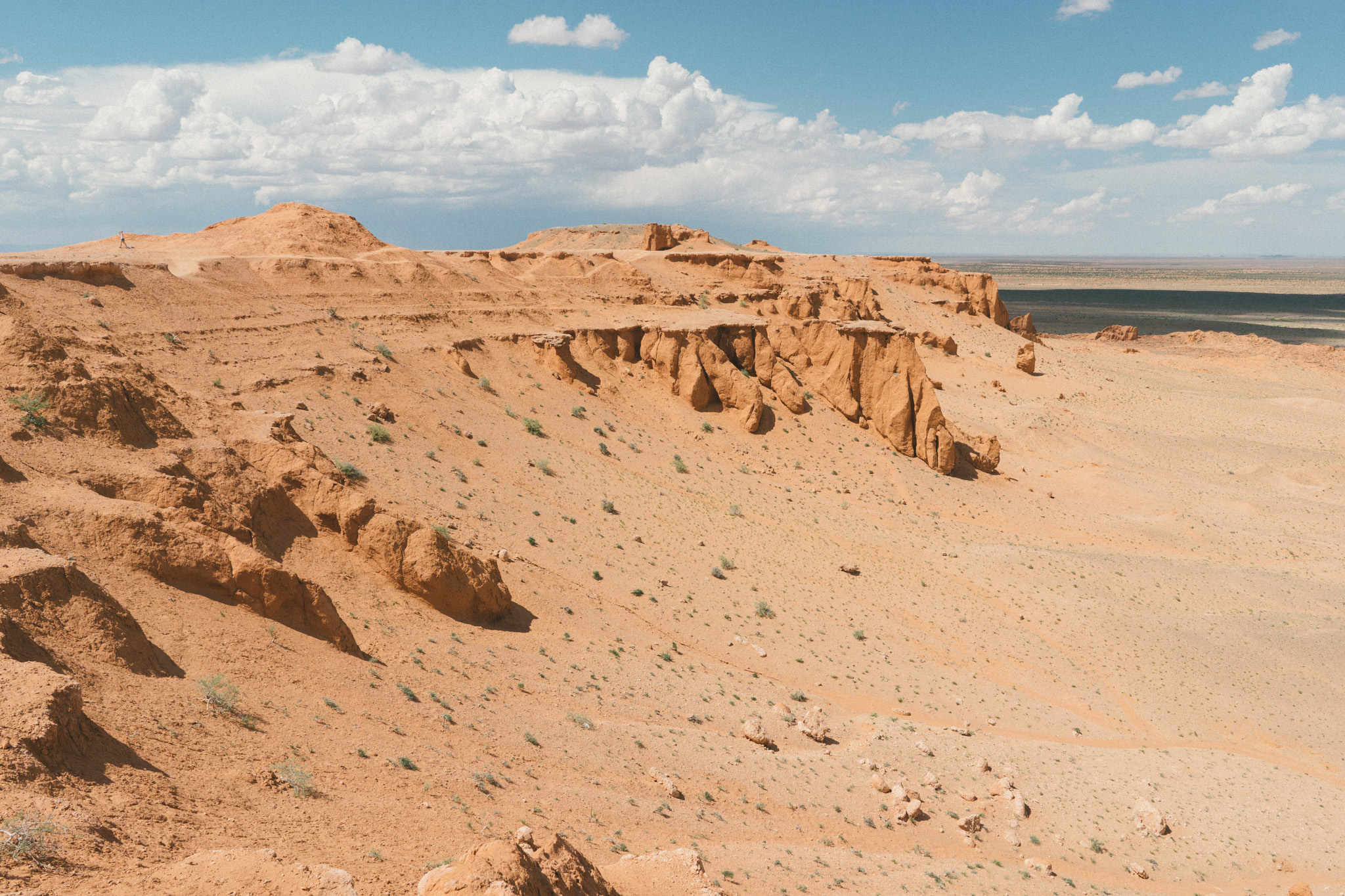
Backpacking Ulaanbaatar
24 – Almost every traveller will begin their adventure in Mongolia’s capital city of Ulaanbaatar: Ulaanbaatar is the only real city in Mongolia and is home to over half of the countries population. The city is connected to China and Russia via the Trans-Mongolian Railway and has an international airport.
The city is a great place to organize tours into the countryside, visit museums, eat, shop, and chill out after a long journey through the steppe.
I’ve met a lot of travellers who told me that they hated Ulaanbaatar, but I kinda liked it. There are some nice western-style cafes, good restaurants, and some malls if you need to get any gear.
25 – There isn’t much to do in Ulaanbaatar, but it’s alright for a couple of days: While most travellers visiting Ulaanbaatar are here to organize the rest of their Mongolia adventure, there are a few things worth checking out in the city itself.
When you arrive, pay a visit to the Genghis Khan Square and take in the atmosphere of the political center of Mongolia. Next, make your way to the Gandantegchenling Monastery for a look at some of Mongolia’s Buddhist traditions.
If you’ve got some extra time, you can also check out the National History Museum . For any shopping that you need to do, hit up the State Department Store.
26 – Ulaanbaatar is full of great hostels: It’s the perfect place to meet other people who want to travel around Mongolia.
I’d recommend staying at the Golden Gobi Hostel when you’re in Ulaanbaatar.
They’re super organized with arranging tours to the other parts of Mongolia, and the hostel is a great place to meet other travellers. I had a great time here!
Also, consider Sunpath Mongolia – they provide similar quality and services to the Golden Gobi hostel.

Backpacking Central Mongolia
27 – Central Mongolia one of the more popular regions among travellers: It’s not far from Ulaanbaatar and offers gorgeous natural beauty along with hospitable nomadic people.
The main tourist sights in Central Mongolia are the Gorkhi-Terelj National Park, the ancient city of Karakorum, and the incredible Orkhon Valley.
28 – Gorkhi-Terelj National Park: Located only 70 kilometres from Ulaanbaatar and is a great place to visit if you have a short amount of time in Mongolia. In the park, you can go hiking, horseback riding, and stay with nomadic families.
Gorkhi-Terelj NP is one of the most popular tourist destinations in Mongolia, so there are plenty of tourist camps offering all sorts of services.
You can access the park via 2 daily buses departing from Ulaanbaatar – do note that there is a 3000₮ entrance fee at the park gate.
29 – Karakorum: The city of Karakorum was the capital of the Mongol Empire and visited by Marco Polo on his during his travels through the area.
When you’re here, roam around the historic former capital of Mongolia and learn more about its history.
30 – The Orkhon Valley: This gorgeous valley is located about 300 kilometres from Ulaanbaatar and follows the banks of the Orkhon River. It’s a lush grassland home to many nomadic people who still live traditional lives in ger camps. Orkhon Valley is also home to Mongolia’s tallest waterfall.
The Orkhon Valley is the perfect place to embark on a multi-day horse trek or spend some time living with a local family. The landscapes here are beautiful, and it’d be a shame to only visit for a day! Try not to miss the Naiman Nuur National Park (Eight Lakes).
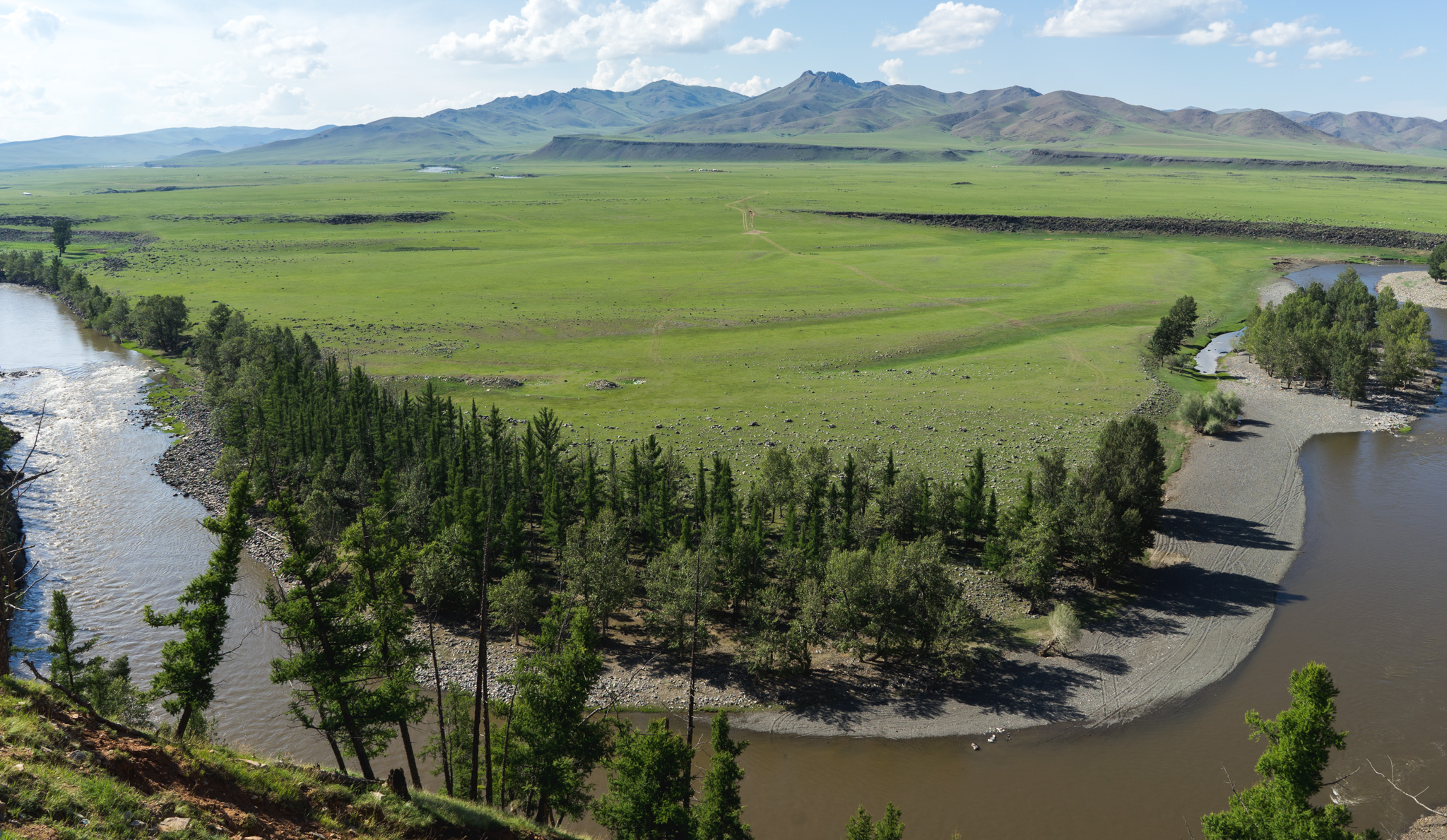
Backpacking the Gobi Desert
31 – Basically all of Southern Mongolia is covered by the Gobi Desert: It’s Asia’s largest desert and is home to camels, massive sand dunes, and a ton of other interesting sights.
This region is fairly accessible from Ulaanbaatar. Dalanzadgad is the capital of the region, and you can get there from Ulaanbaatar by bus in about 10 hours.
The main sights to visit in the Gobi Desert are:
32 – Yolyn Am: Yolyn Am is probably not what you would’ve expected from the Gobi Desert. It’s a deep, narrow gorge that often has snow left in it well into summer months.
When here, you should spend a couple of hours hiking (or horseback riding if you’re confident) through the gorge.
33 – Bayanzag (Flaming Cliffs): The Flaming Cliffs are one of the more famous spots in the Gobi Desert, for good reason! They’re absolutely stunning and make for epic photographs (especially at sunset).
In the 1920s, the first-ever dinosaur eggs were discovered here by an American paleontologist, and a number of subsequent fossil finds have occurred here.
34 – Khongoryn Els: When you think of the Gobi Desert, giant sand dunes probably come to mind. Don’t worry, Khongoryn Els has got you covered!
Some of the dunes are over 300 meters tall, and they go on for over 100 kilometres. Hiking up the tallest dune and watching the sunset was one of my favourite travel experiences.
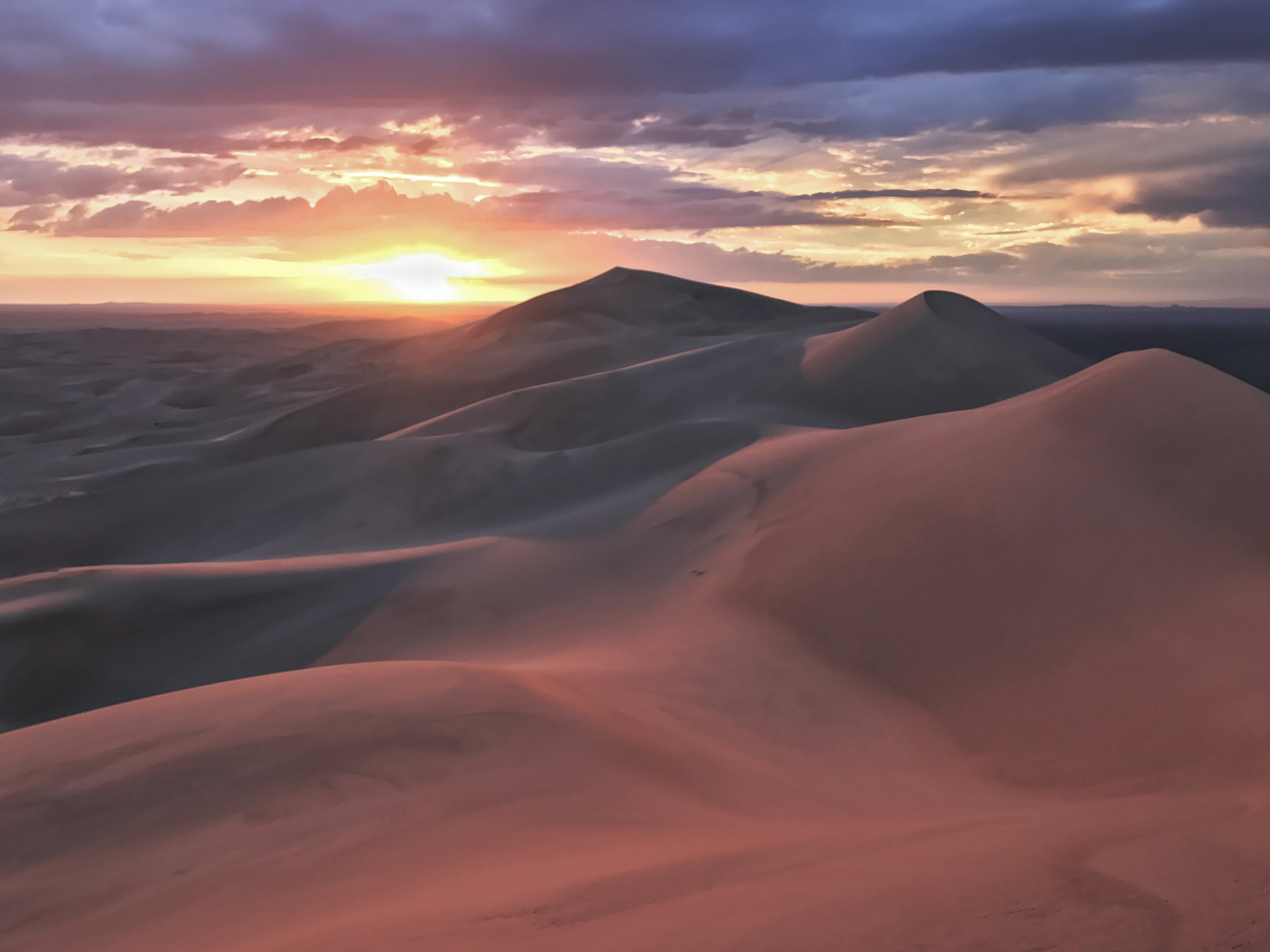
Backpacking Northern Mongolia
35 – Mongolia’s north is home to Lake Khuvsgul, the most beautiful lake in the country: In the northwest of Lake Khuvsgul, the Tsaatan tribe are one of the only remaining groups of nomadic reindeer herders.
Most travel around Northern Mongolia will be based out of the town of Moron. Getting to Moron can take a while – there are buses running from Ulaanbaatar that take about 12 hours, or you can take a flight for around $150 USD.
Visiting the Tsaatan tribe can take some time, requiring a multi-day horse riding journey. If you plan on visiting the Tsaatan, do your research and find an outfitter that places an importance on sustainability and preservation of the Tsaatan culture.
Backpacking Western Mongolia
36 – Western Mongolia is the most remote part of Mongolia: Most travellers will visit this region to journey into the Altai Mountains. Ölgii is the starting town for most adventurers in the region. Ölgii a 48-hour bus ride from Ulaanbaatar, or a short flight.
In early October, the Kazakh inhabitants of the region host the Golden Eagle Festival.
I haven’t visited this region yet, but I plan on making it a large focus of my next trip to Mongolia.
Backpacking Eastern Mongolia
37 – Eastern Mongolia is rarely visited but is home to the birthplace of Genghis Khan: Much of the region is a vast steppe without many interesting tourist sights. If you’ve been to Eastern Mongolia, let me know more about it and I’d love to update this section!
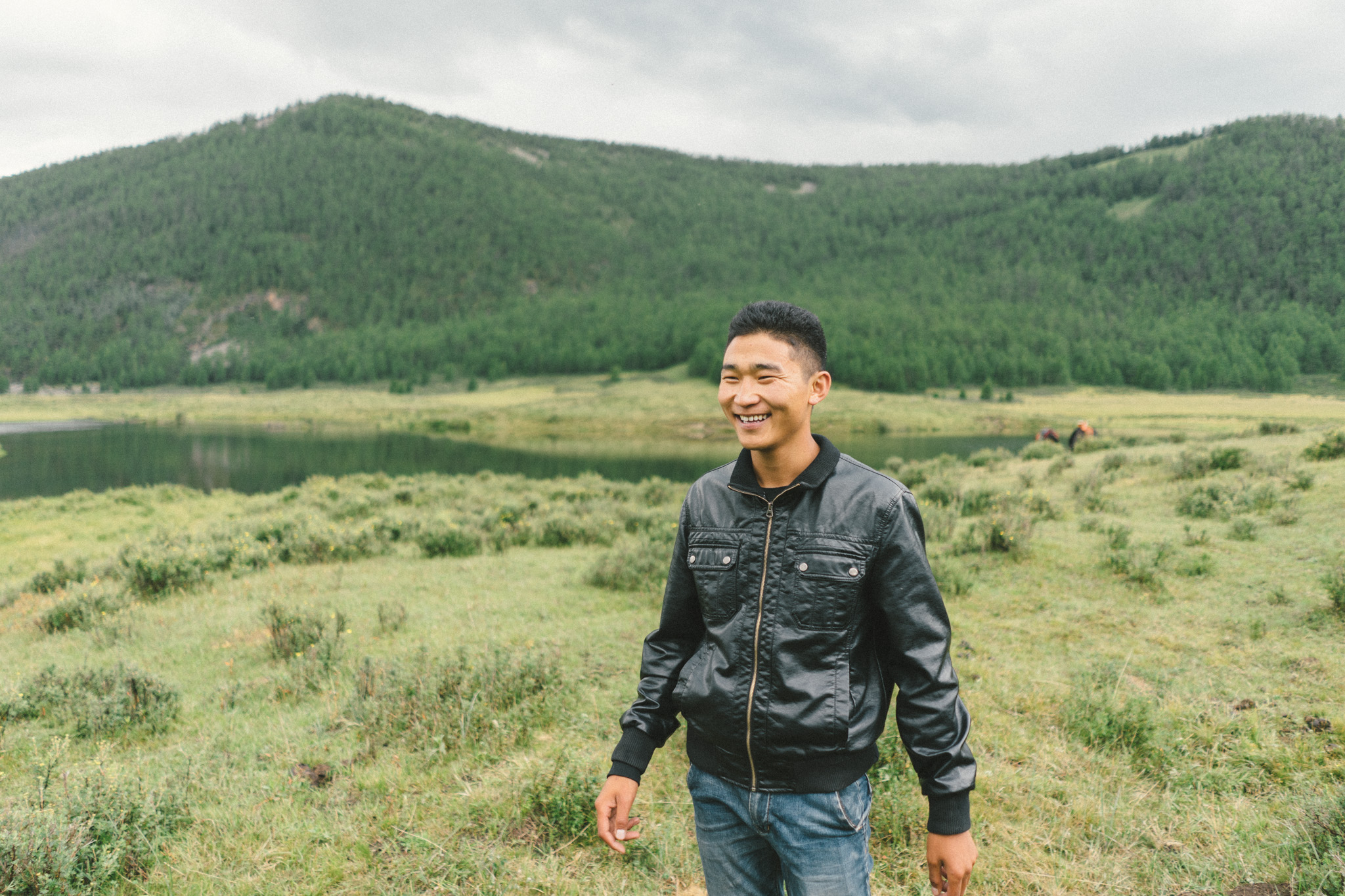
Tours in Mongolia
38 – So, how do you organize a trip in Mongolia?: Before my trip to Mongolia, my biggest challenge was figuring out how I was going to get around the country! Public transportation connects the main regional hubs to Ulaanbaatar, but other than that there isn’t any way of getting around.
All of the incredible sights are hours away from town and require a 4×4 vehicle to reach.
This means that the typical “backpacker” travel style of staying in hostels and taking public transportation doesn’t work here.
39 – Group tours in Mongolia are a great option: Almost every hotel, hostel, and guesthouse in Ulaanbaatar will offer group tours.
An organized group tour in Mongolia will typically include the following things:
- Vehicle and driver
- English-speaking guide
- Accommodation in gers or tents
- Food (not including snacks or alcohol)
- Entrance fees and activities
As you can see, a group tour will include pretty much everything you need!
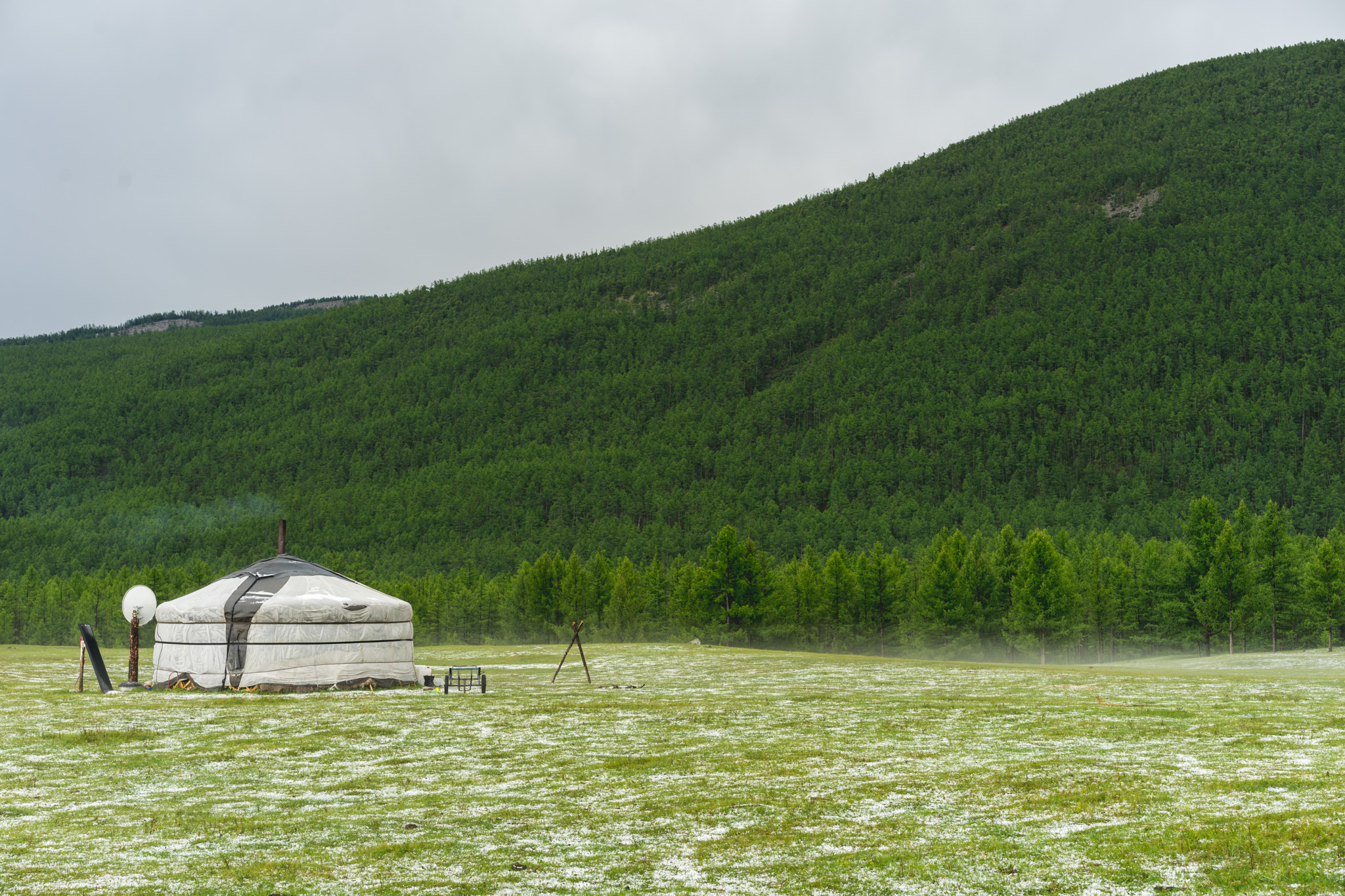
40 – How much do group tours typically cost?: The tour cost depends on the number of people who sign up. Expect to pay between $50-70 USD per day for a group tour that has a few other backpackers on it.
It’s hard to give an exact number, so make sure to budget for the high end to be safe.
When you are in Ulaanbaatar, I’d recommend staying at the Golden Gobi hostel . They’re very well organized and have multiple tours leaving every day in the summer.
Another hostel that I heard good things about is Sunpath Mongolia . If you can’t find the tour you’re looking for, or Golden Gobi is all sold out, consider staying there.
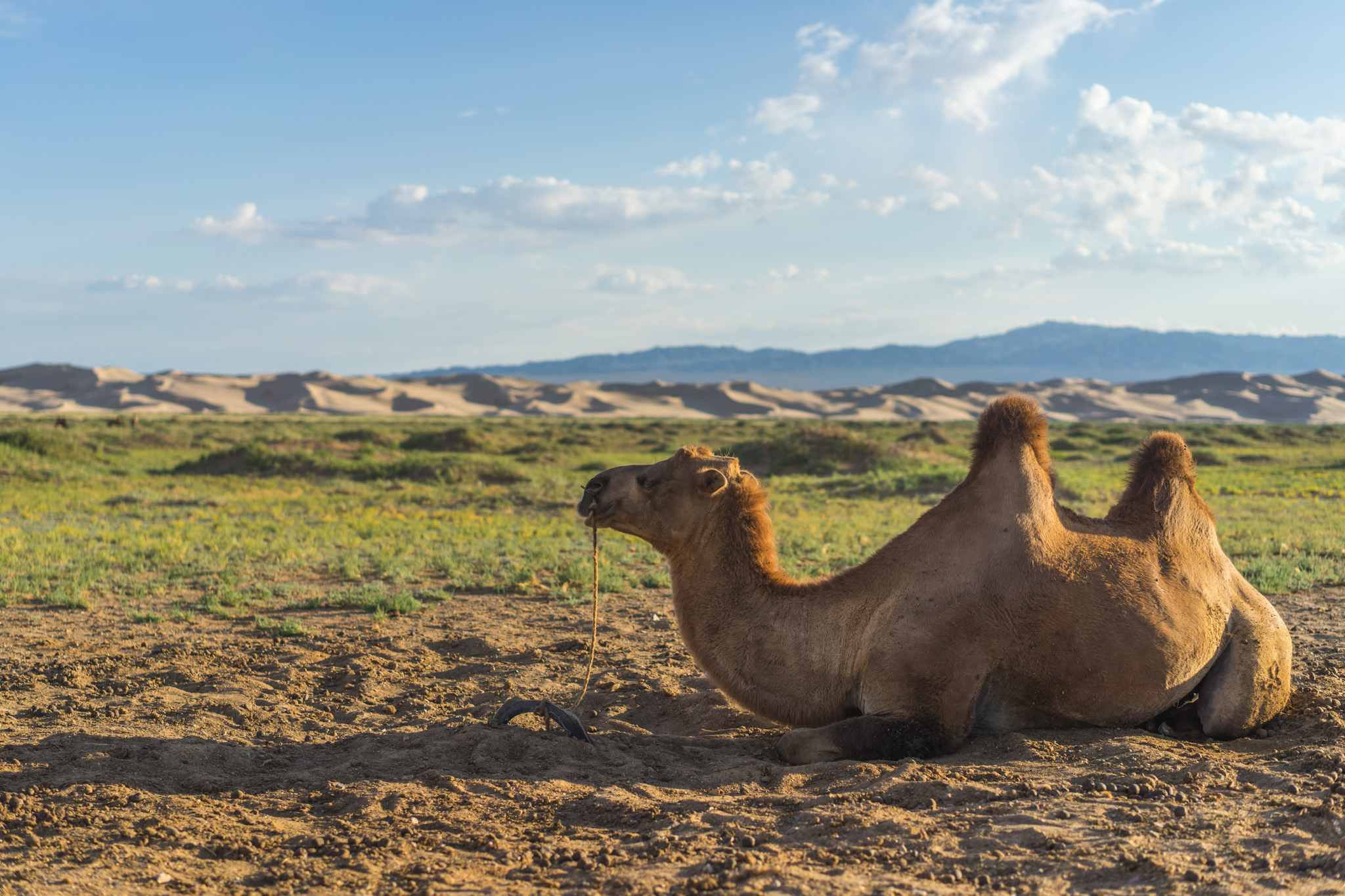
41 – Don’t arrange your group tour from outside of Mongolia: It will cost a lot more. It’s much easier to arrange things on the ground in Ulaanbaatar with any other travellers that you may meet.
Both of the above hostels have many tours leaving each day, so it’s easy to show up and join a group that’s leaving the next day.
Independent travel in Mongolia
42 – Independent travel is also possible, but much more challenging: If you want to independently backpack around Mongolia, you’re gonna need your own vehicle or a lot of cash.
If you have your own vehicle (4×4, bicycle, motorbike, horse), then getting around won’t be too difficult.
Most tourist sights have ger camps that you can pay to stay in, but you’ll need to bring a tent and cooking supplies for the places that don’t have ger camps.
If you don’t have your own form of transportation, you’ll need to hire a private vehicle and driver. Hiring a private vehicle will cost a couple of hundred dollars per day.
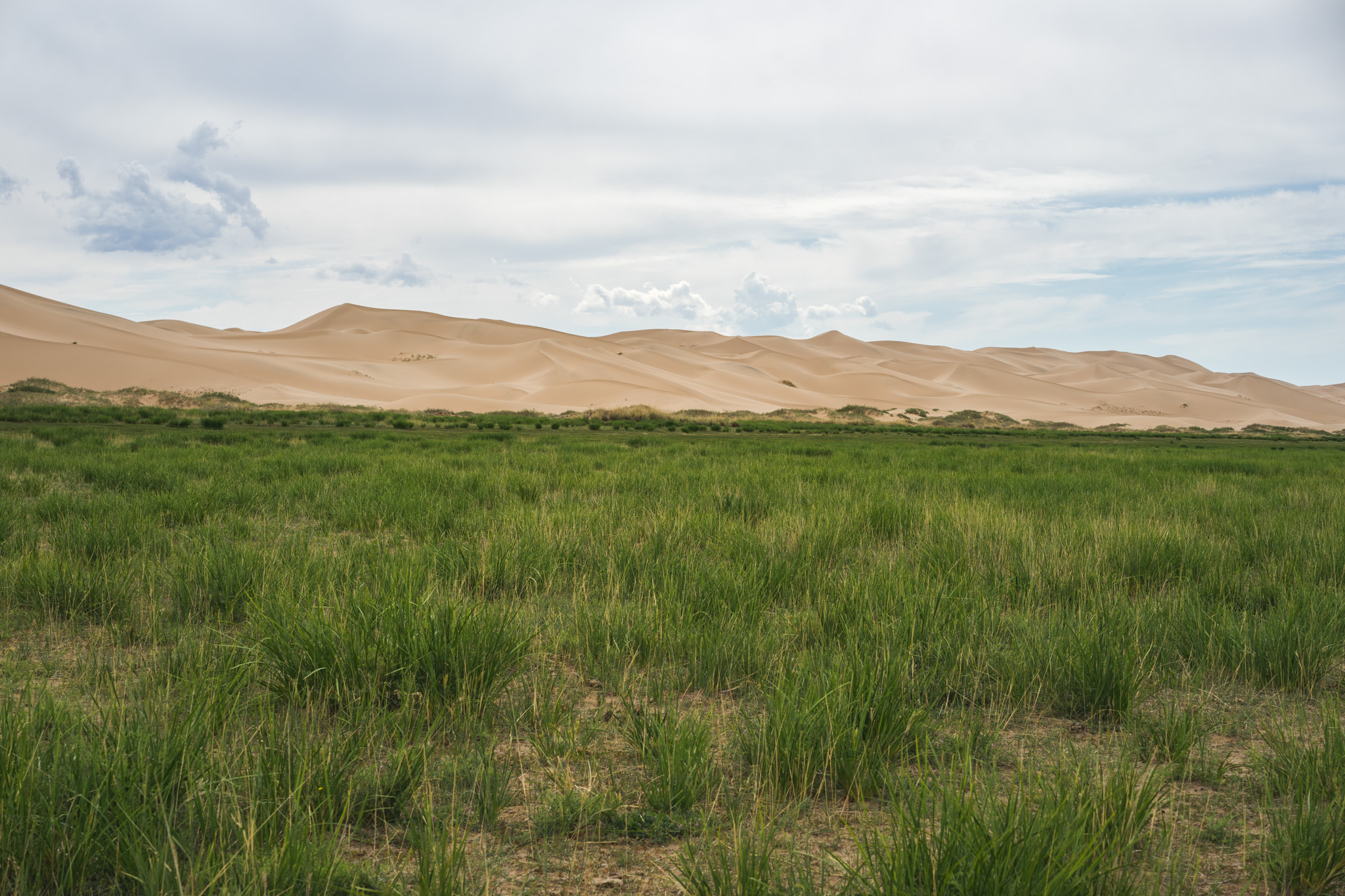
Food in Mongolia
43 – Outside of Ulaanbaatar, food in Mongolia is pretty basic: As many people still live nomadic lives in rural Mongolia, they aren’t able to grow things like fruits and vegetables. Because of this, their diets still consist of mostly meat and dairy products.
Ulaanbaatar has pretty decent options for food, however. There are some good Indian, Chinese, and Korean restaurants if you want some flavour after spending time in rural Mongolia.
44 – You need to try airag when you’re in Mongolia: Araig (called kumis in Central Asia) is a dairy product made from fermented horse milk. It’s sour is very unique, and it’s even got a light alcohol percentage due to the fermentation.
In rural parts of Mongolia, you’ll see people drinking this all the time! It’s served in a bowl, and if you finish your bowl you’ll instantly get a refill.
45 – It can be a bit challenging to travel here as a vegetarian: In Ulaanbaatar, you’ll find a few options for vegetarian-friendly food, but in rural areas don’t expect locals to know what you’re talking about.
If you travel on a tour, you should tell your guide in advance so they can make the appropriate accommodations.

Accommodation in Mongolia
46 – In Ulaanbaatar, all sorts of accommodation are available: Ulaanbaatar is full of hotels, hostels, and guesthouses. It’s up to you to choose which one you’d prefer, but hostels are usually the best bet if you also want to find people to group up with for a tour.
I’d recommend staying at the Golden Gobi hostel . I stayed here both times I was in Ulaanbaatar and arranged my tour through them and had no complaints.
47 – Rural areas have more basic accommodation: When travelling through the rural parts of Mongolia, accommodation will either be in basic homestays, ger stays, or camping. If you travel with an arranged tour, they’ll sort all of this out for you. Most places like these aren’t displayed online anywhere.
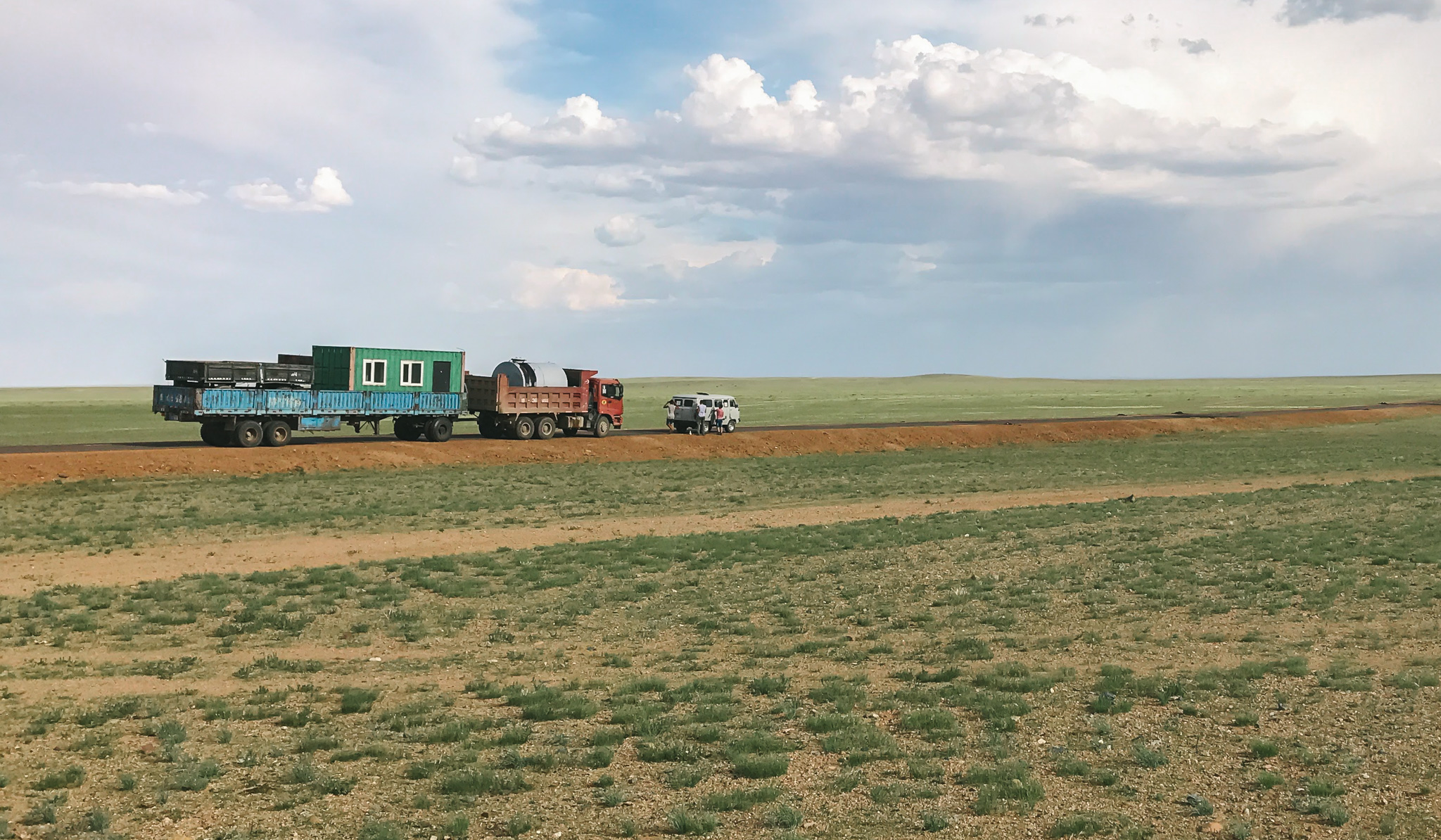
Transportation in Mongolia
48 – Getting around Mongolia takes a long time: Unless you’re travelling between a large town and Ulaanbaatar, there aren’t really paved roads in Mongolia. This makes getting around take forever.
49 – There is a decent bus network: There are buses running between Ulaanbaatar and all of the major towns, although these all take a long time. Getting from Ulaanbaatar to Khovd in Western Mongolia can take upwards of 40 hours.
50 – Hitchhiking is also possible: Although be prepared to be patient. Hitchhiking on main roads is doable, but if you want to go to touristy sights it will be rather difficult as there isn’t any local traffic.
51 – Flying long distances is a good idea: If you want to avoid taking a 40-hour bus ride from Ulaanbaatar to Khovd, there are some domestic airlines in Mongolia that fly routes such as that one. It isn’t the cheapest option, but it is your best bet if you’re short on time.

Mongolia Travel Itineraries
Mongolia 1-week itinerary.
With a week in Mongolia, you’ll want to stick around the Ulaanbaatar area.
Spend a couple of days in Ulaanbaatar visiting its main sights, and then head to the Gorkhi-Terelj National Park. I’d recommend spending a few nights here, you’ll get to stay in a ger, try fermented horse milk, and go horseback riding.
If you arrange a driver with your hostel in Ulaanbaatar, you could also take a trip to the ancient capital of Karakorum. It’s a good 5-6 hour drive from Ulaanbaatar, so plan accordingly. I’d only recommend this if you’re really info Mongolian history, as there isn’t much else to do in Karakorum.
Mongolia 2-week itinerary
Two weeks is the perfect amount of time to check out Ulaanbaatar, Central Mongolia, and the Gobi Desert.
A typical tour of Central Mongolia and the Gobi departing from Ulaanbaatar will take about 12 days, and you’ll get to spend time in all the major sights.
For info on arranging a tour like this, see the Group tours in Mongolia section above.
The Gobi and Central Mongolia offer a perfect intro to the country and are what I’d recommend for a first-time visitor.
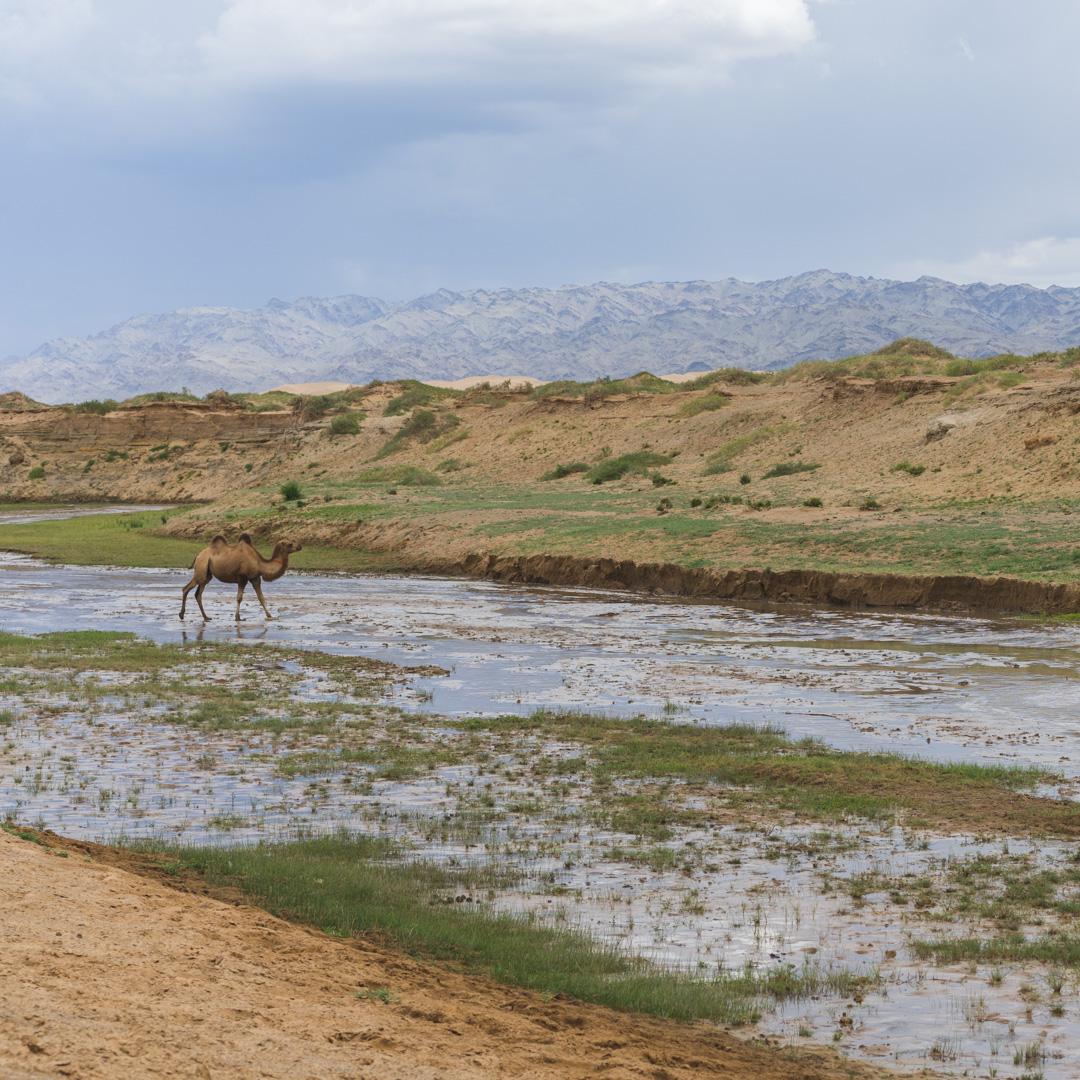
Mongolia 3-week itinerary
With three weeks, you’re able to add on another region to the above itinerary. Northern Mongolia would make the most sense, as you’re able to drive there pretty easily after visiting Central Mongolia.
A week in Northern Mongolia probably won’t be enough time to go and visit the Tsaatan people, so plan for a longer amount of time in the north if this is something you wish to do.
Mongolia 1-month itinerary
A month in Mongolia – I’m jealous! With this amount of time, you could make it all the way out to the western part of the country. You’ll be able to go hiking in the Altai mountains and meet the Kazakh people that inhabit that area.
Western Mongolia will take up about two weeks (the exact amount of time depends on if you fly or bus there). For your other two weeks in the country, consider checking out the Gobi and Central Mongolia. You’ll also probably want to plan some rest time in Ulaanbaatar.
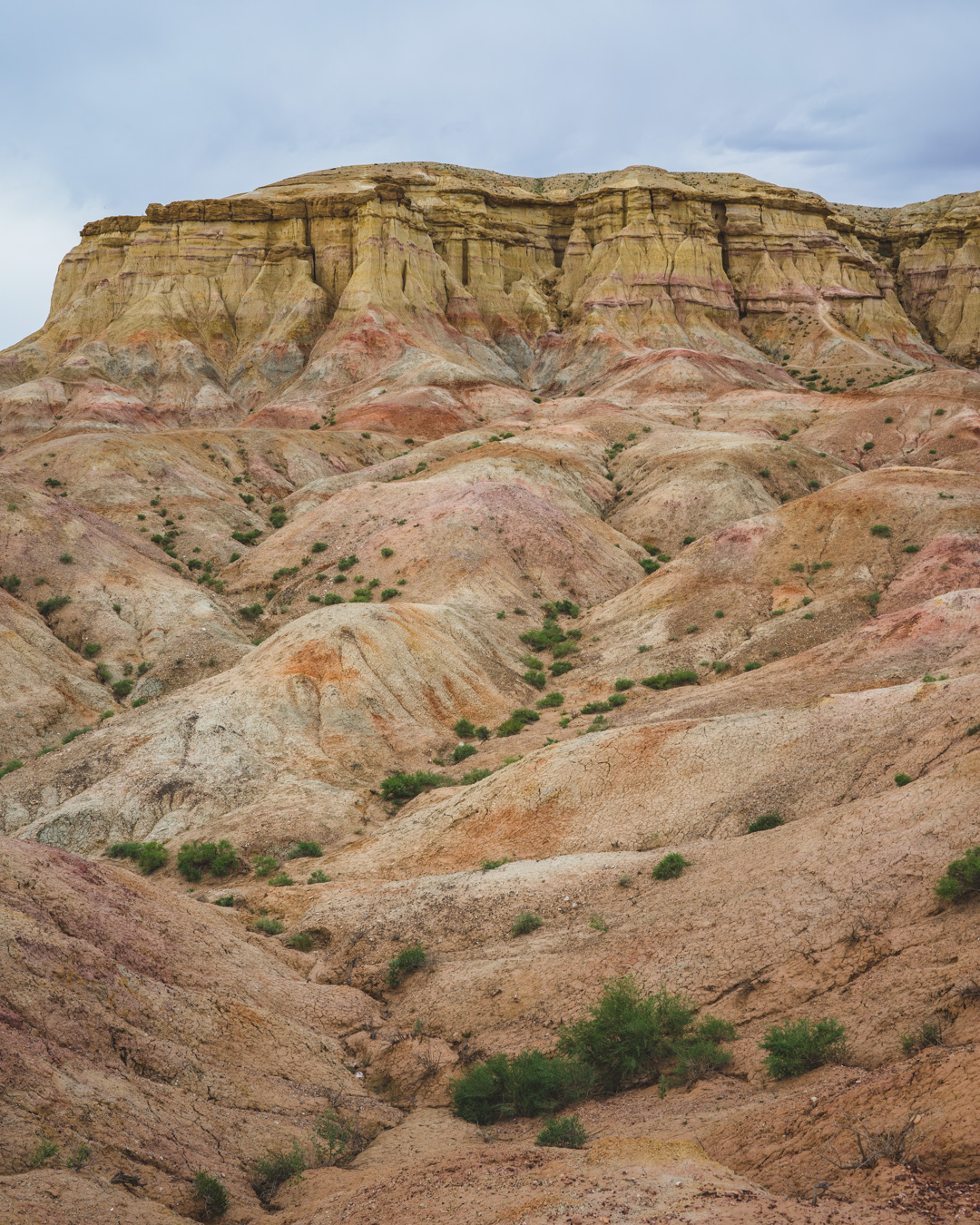
When to visit Mongolia
52 – Mongolia can be visited year-round: But.. you’ll have a vastly different experience in the summer than you would have in the winter. For most people, the best time to visit Mongolia is in summer, but let me go over the pros and cons of the different seasons.
53 – What is Mongolia like in the winter?: Unless you like -30°C weather, it’s probably best to avoid visiting Mongolia in the winter (November to March). If you do visit Mongolia in the winter, dress warm and you’ll experience a Mongolia that few other backpackers do!
Be warned – in the winter, Ulaanbaatar becomes one of the most polluted cities on Earth due to wood-burning heating.
54 – What is Mongolia like in the spring?: In the spring (April to May), weather can still be unpredictable and roads can be quite muddy as the snow is still melting.
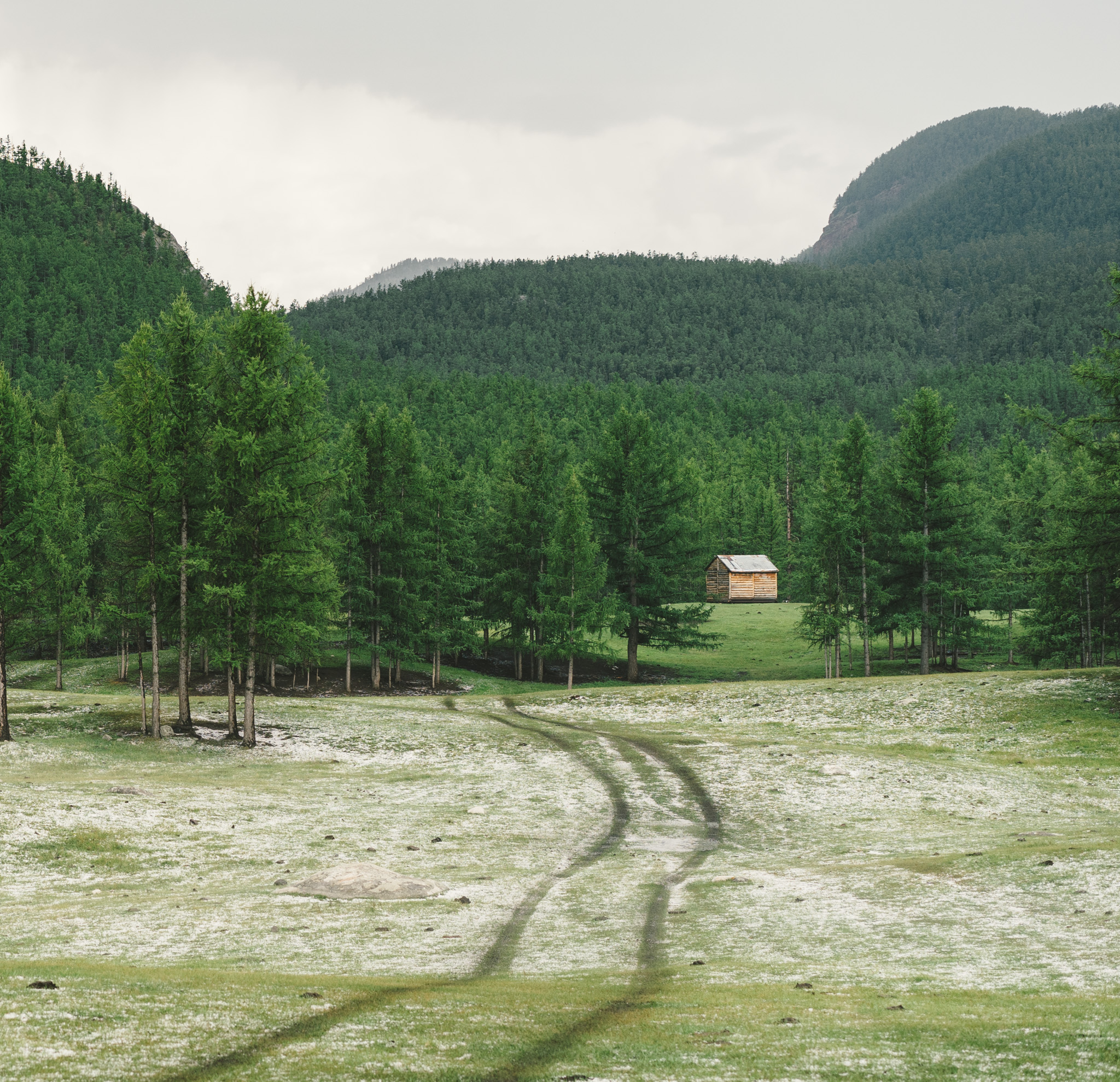
55 – What is Mongolia like in the summer?: Mongolia’s summer lasts from June to August and is definitely the best time of year to visit Mongolia. In the summer, the steppes will be green and the skies will be blue (for the most part). Still, be prepared for any type of weather.
I backpacked around Mongolia in August, and when I was in the Gobi Desert climbing the Khongoryn Els sand dunes, it started pouring rain. Later on, I was in the Orkhon Valley and we were hit with a hail storm that covered our ger in ice. Be sure to bring gear for any sort of situation.
In late July/early August, the Naadam festival takes place all over the country. It’s an incredible experience that shouldn’t be missed!
56 – What is Mongolia like in the fall?: In the fall temperatures begin to drop, but gorgeous fall colours help make up for it. After summer, fall is probably the best time to visit Mongolia.
If you’re in Mongolia in early October, try to make it out for the Golden Eagle Festival in Ölgii.
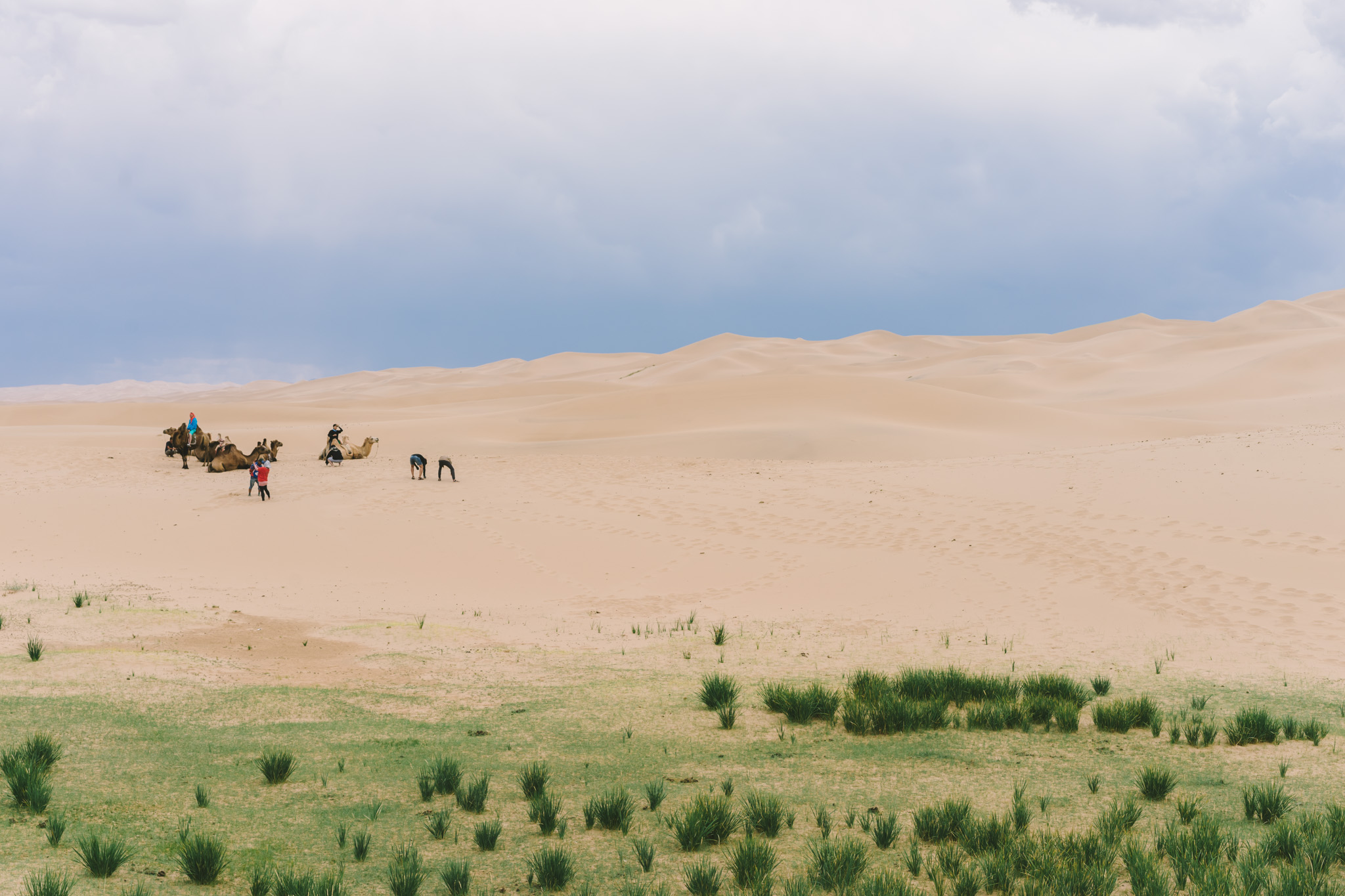
Travel Costs in Mongolia
57 – How much does it cost to backpack in Mongolia?: Well, Mongolia lies somewhere in the middle of the budget range. It’s more expensive to travel in than places like Vietnam or India, but cheaper than Japan or Korea. Due to its massive size and low population, a tour is pretty much required to see anything outside of Ulaanbaatar.
To be safe, budget between $50 and $70 per day in Mongolia if you plan on taking a group tour.
If you’re just visiting Ulaanbaatar, costs will be much lower. A hostel dorm bed (Again, I recommend the Golden Gobi ) will be less than $10 USD, and you can eat at local restaurants for only a few dollars.
Check out the State Department Store if you need to do any shopping – they have everything from camping gear to televisions.
Internet & SIM Cards in Mongolia
58 – In the countryside, internet access is non-existent: As most of Mongolia is extremely sparsely populated, expect to be offline most of the time while you’re travelling in Mongolia.
59 – What about in Ulaanbaatar and larger towns?: WiFi isn’t great, but I recommend picking up a local SIM card from either MobiCom or Unitel . With one of these local SIM cards, you’ll have 4G coverage in Ulaanbataar and quite a few towns around the country. You can purchase a SIM at any of the MobiCom or Unitel shops – just be sure to bring your passport.
Basic data packages are quite cheap – you can get about 10GB of data for around $5.
For detailed info about the different plans offered by the telecoms, check out the Mongolia Prepaid SIM Card Wiki.
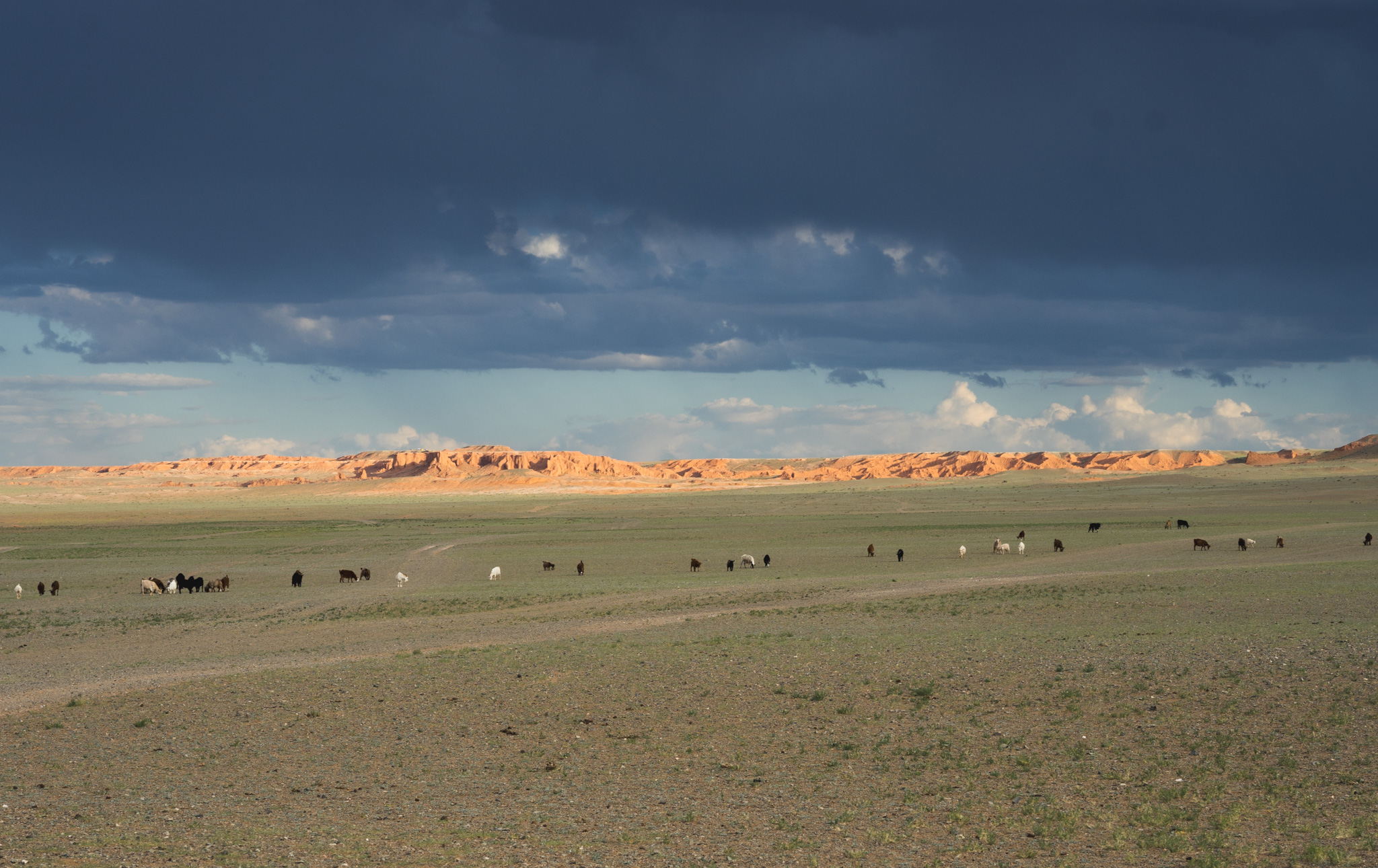
Solo Travel in Mongolia
60 – It’s easy to meet other backpackers in Ulaanbaatar: Before my trip to Mongolia, I was a bit worried about going solo. I was worried that I wouldn’t be able to find any other travellers who wanted to visit the same places as me, and therefore worried that I would be stuck paying a lot more money for my tour.
Fortunately, it’s super easy to find people to split your tour costs with in Ulaanbaatar. As long as you don’t plan on going wayyy off of the beaten path, you’ll be able to find someone. Most hostels in Ulaanbaatar communicate with each other, so they’ll ask the other hostels if they have anyone with your same plans and put you in contact.
Don’t worry about heading to Mongolia solo – you’ll be able to meet other travellers and make some new friends!
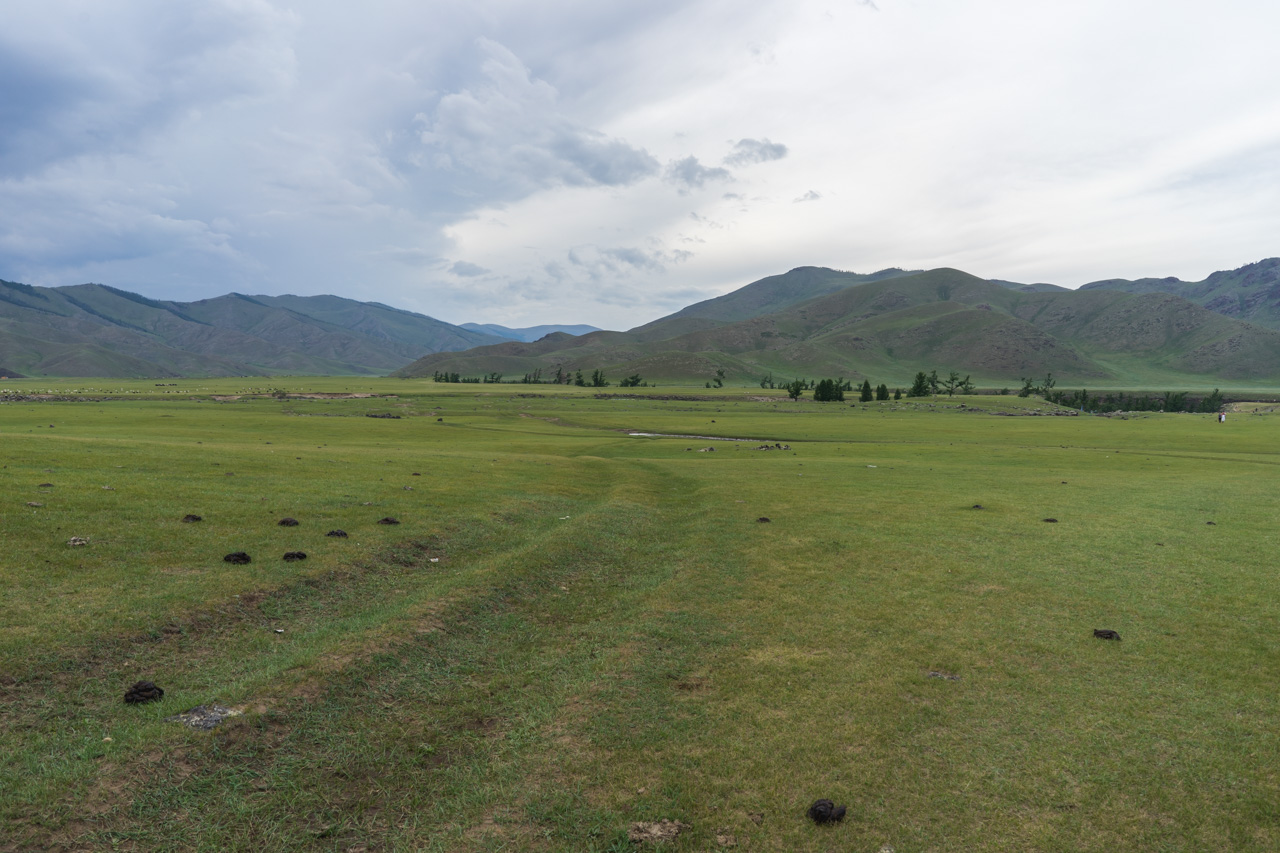
Female Travel in Mongolia
61 – Mongolia is a great destination for female travellers: Mongolia is a safe destination for female travellers, and you’ll definitely find plenty of others there.
You’ll need to be careful to dress somewhat conservatively and follow the female safety practices that you would anywhere else. Avoid heading out alone in the dark (in Ulaanbaatar), and you will be fine.
Here’s some great info on female travel in Asia – be sure to check it out if it’ll be your first time in Asia.
Travelling in Mongolia Wrap-Up
And that’s it for my guide to travelling in Mongolia! I hope this helped you plan your Mongolia adventure.
If you’ve got any questions about backpacking in Mongolia, feel free to ask me!
Remember to check out my guide to getting from Beijing to Ulaanbaatar , if you’re planning on taking that route.
I’ve also got a few other comprehensive backpacking guides – feel free to check them out if you’re planning a trip!
- China Backpacking Guide
- Pakistan Backpacking Guide
- Wakhan Corridor Travel Guide
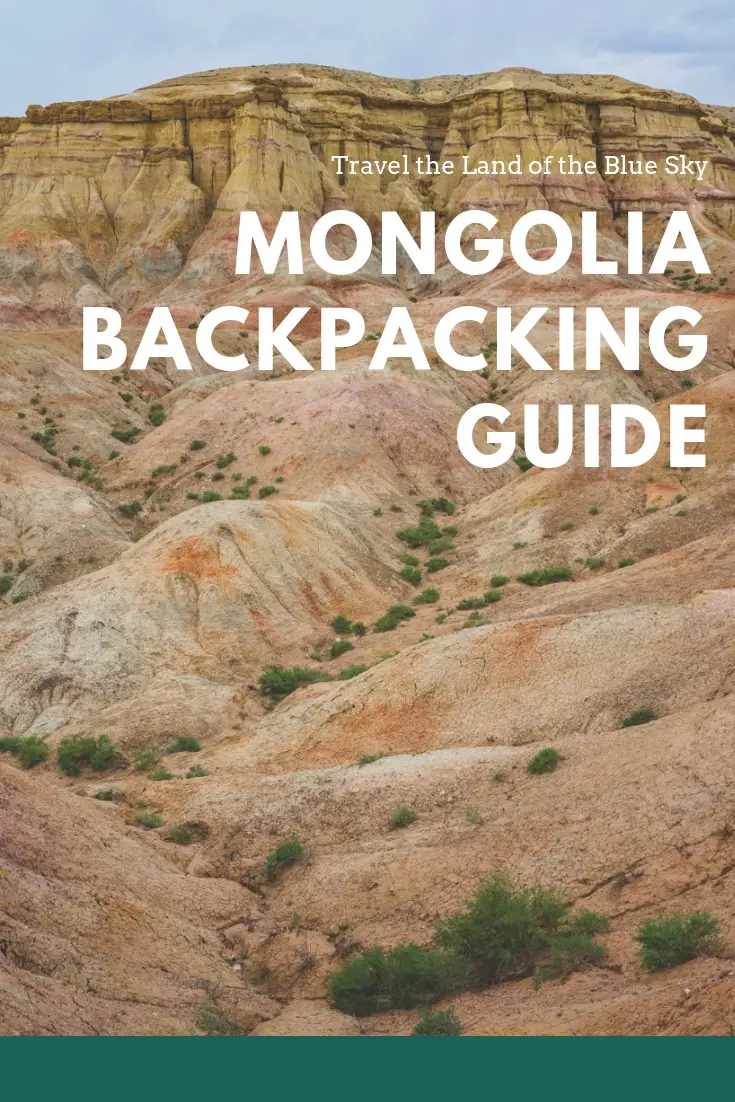
Yay transparency! There are affiliate links in this guide. If you book or buy something using my links, I’ll make a bit of money at no extra cost to you.
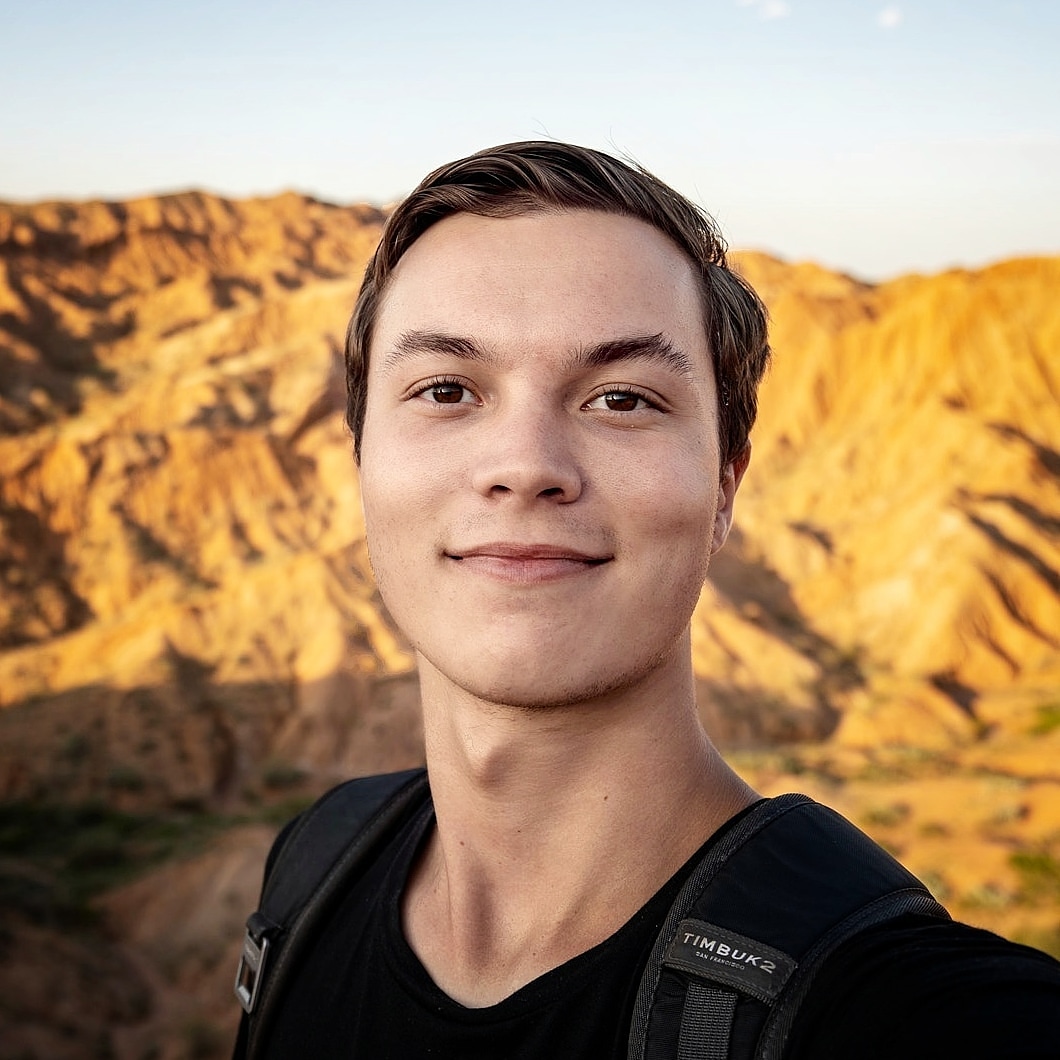
21-year old Canadian dude who loves to visit off-the-beaten-path places, climb tall mountains, and try delicious foods.
Read more about me
Want more like this?
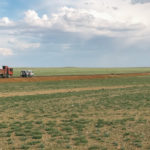
Leave a Reply Cancel reply
Your email address will not be published. Required fields are marked *

Borders Of Adventure
Leading Culture and Adventure Travel Blog by Becki Enright. Looking at the world with a different angle to change perceptions of misunderstood places, for the best in travel.
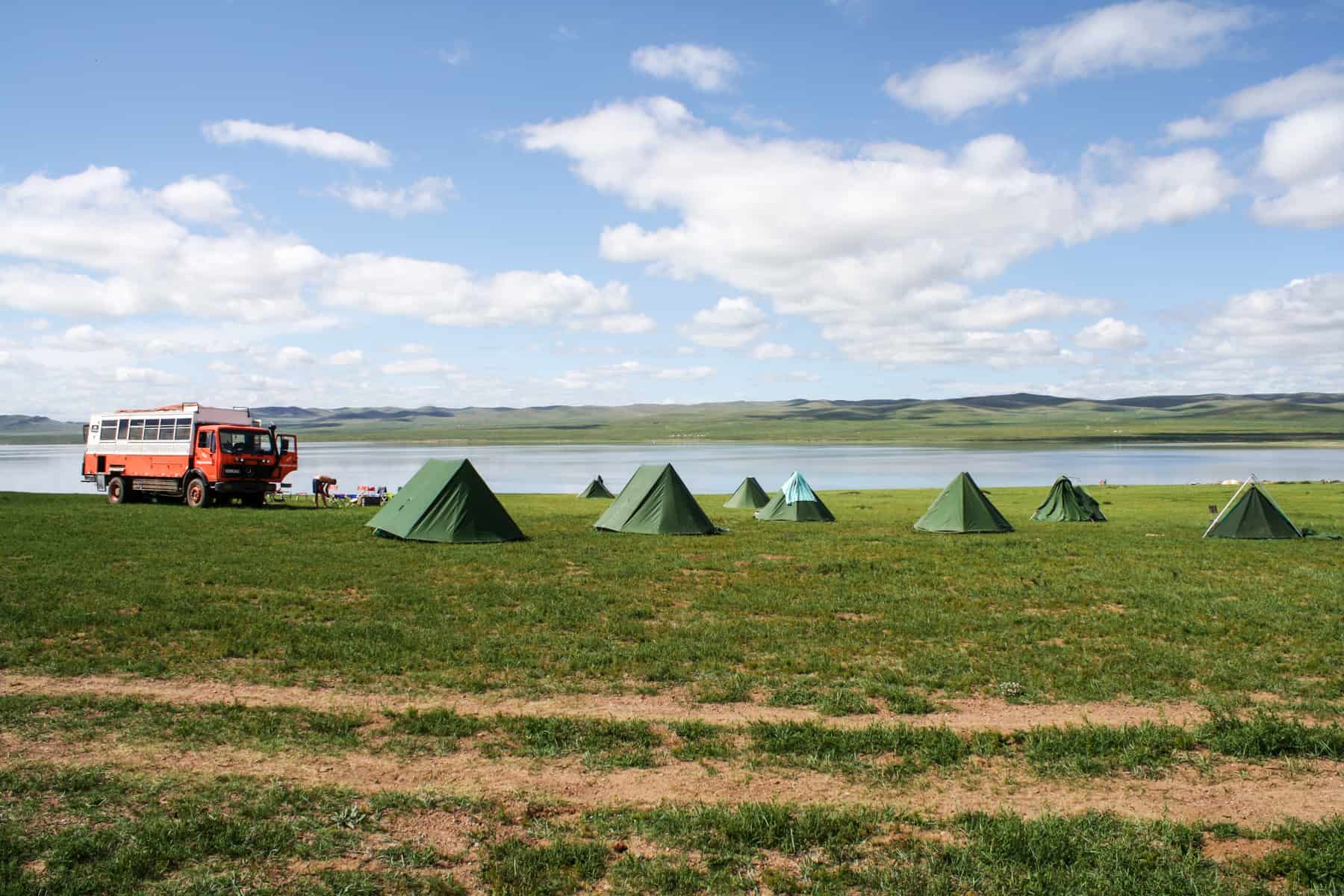
Adventure Travel , Mongolia
This is How to Travel to Mongolia – Overlanding the Least Densely Populated Country in the World
Disclaimer: This post contains affiliate links to handpicked partners, including tours, gear and booking sites. If you click through or buy something via one of them, I may receive a small commission. This is at no extra cost to you and allows this site to keep running.
Want to get to somewhere lesser-known and travel differently? This Mongolia travel guide shows how to go overlanding in the world’s least densely populated country.
Travel to Mongolia means tackling a land of extremes. Both in the landscape, from its vast desert lands and towering dunes to its lush green mountainous national parks, and in its lack of infrastructure, where you become just as frustrated as you are in awe by the country’s areas of extreme isolation.
Visiting Mongolia is to find a canvas of rugged beauty capped by a sky so blue that pollution isn’t even a word that exists here. Passing only wild horses, herds of cattle, an isolated ger in the distance, and the odd truck also on its way to the city, life here is at its purest and most beautiful.
Outside of its unkempt capital, Ulaanbaatar, Mongolia exists with limited facilities, but that’s what makes it attractive. On the road, it can take hours of driving before you pass a small ger community, a Mongolian on horseback or another vehicle, and in between blessed with the most stunning views of a country so desolate that you know you’ve reached the real heart of it.
Overlanding through Mongolia, rather than flying or taking the train, is one of the best decisions I have ever made. This guide will show you how to travel Mongolia from China by land, in a vast loop that takes in some of the country’s most treasured hotspots and wilderness hideaways.
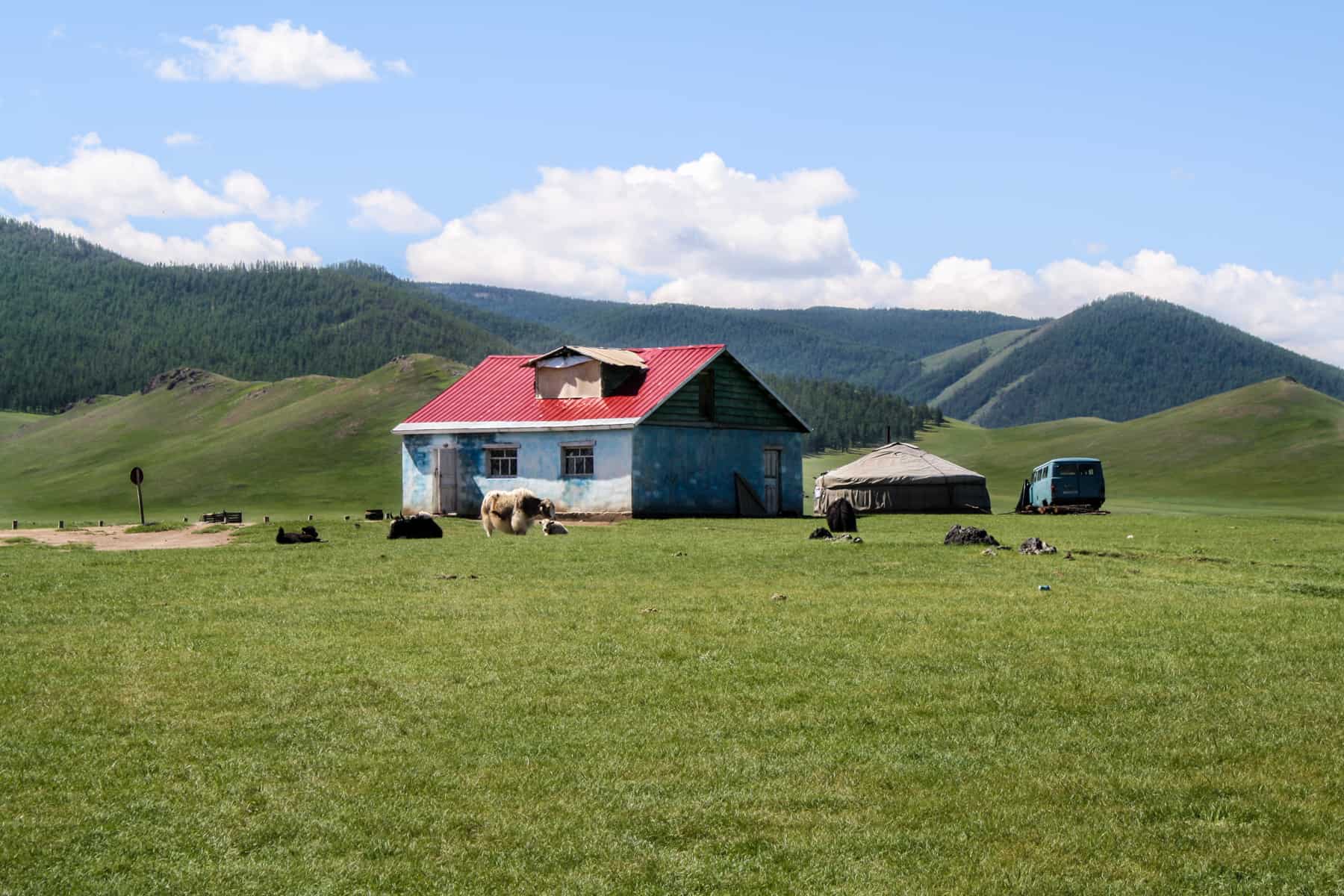
Visit the Least Densely Populated Country in the World
Off the beaten track adventure, when is the best time to go to mongolia, it pays to know a local, classic nomadic mongolia, local living mongolia, discover mongolia – national geographic journeys, experience the naadam festival in mongolia, is mongolia expensive to travel, mongolia visa on arrival, visa-free access to mongolia, day 1: visiting ulaanbaatar, day 2: getting from ulaanbaatar to the gobi desert, day 3: visit the baga gazryn chuluu rock formations, day 4: sleep at a ger camp in the gobi desert, day 5: dalanzagad to gobi discovery ger camp, day 6: hiking in yolin am – mongolia’s ice valley, day 7: a trip to the gobi desert khongoryn els sand dunes, day 8: visiting the bayanzag flaming cliffs, day 9: seeing ongii monastery and driving to arvaikhee, day 10: stuck in mongolia, day 11: hiking in orkhon valley, day 12: seeing the orkhon valley waterfalls, day 13: visiting a mongolian family in a ger, day 14: erdene zuu monastery in kharkhorin, day 15: camping at ugii lake, day 16: visiting hustain national park and seeing przewalski’s horses, day 17: driving to ulaanbaatar and visiting terelj national park, day 18: hiking terelj national park and seeing turtle rock, day 19: a trip to the ghengis khan statue on the tuul river, day 20: back to ulaanbaatar, how to overland in mongolia, building a road in mongolia, getting stuck in the mud, the unexpected river crossing, what to pack for mongolia, planning mongolia travel pin it, why travel to mongolia .
Mongolia travel changes you and makes you appreciate the beautiful patches on the earth’s surface not ruined by extreme modernisation, pollution and overpopulation.
My time in Mongolia meant experiencing everything from bush camping to ger camps, being at one with nature (and not care who sees you squatting in the process) and realising that animals like to roam and Mongolians love to chat – right outside your Ger from 5 am.
I saw a night sky so clear that I didn’t think you could ever see so many stars. I traversed a land so serene in isolation and culture so welcoming that I hope it never, ever becomes ruined by tourist traps or the tight grips of mass capitalism (currently contained to Ulaanbaatar).
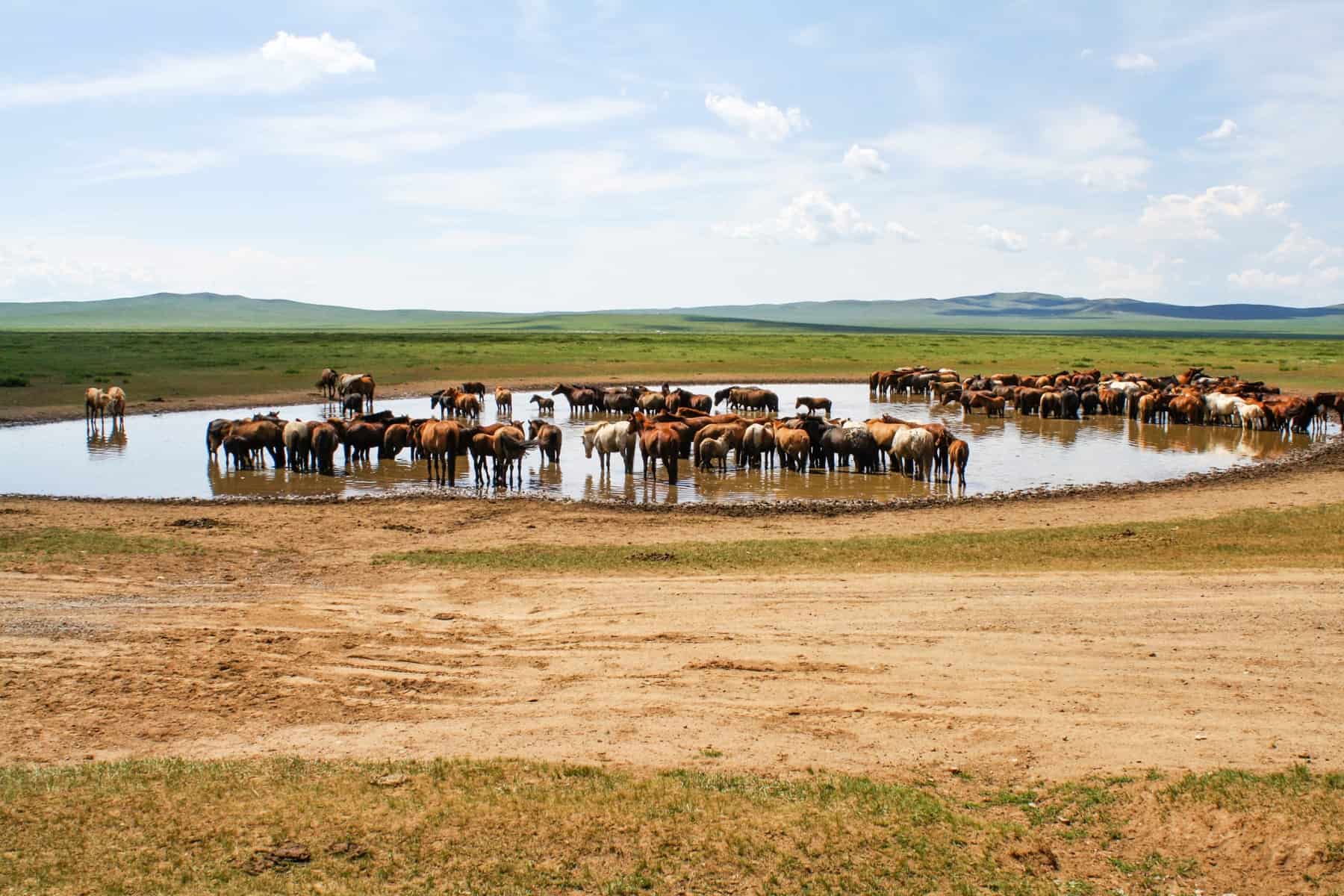
Wild horses in the vast Mongolian landscape
If you want to get off the beaten track, not be on any set grid and take each day as it comes, you will love Mongolia. But this also comes with its frustrations where you need droves of patience and a good chunk of travel time to spare.
There are hardly any roads. Roads are dirt tracks or pre-made grooves in the land pointing the way, and paved highroads are very few and far between.
Mongolia is prone to unpredictable weather conditions. That means random onslaughts of rain and the likelihood that you are likely to get bogged at some point. There were countless numbers of times where we had to dig out and push the truck or find locals to come to the rescue – tractors are a saving grace here.
It’s a vast country that you could get lost in for weeks on end, and when you accept the setbacks, you start to see them as part of the big adventure – travel at its most raw. Back to basics, getting dirty and struggling with the lack of modern amenities we too often take for granted is part of what travelling in Mongolia is all about.
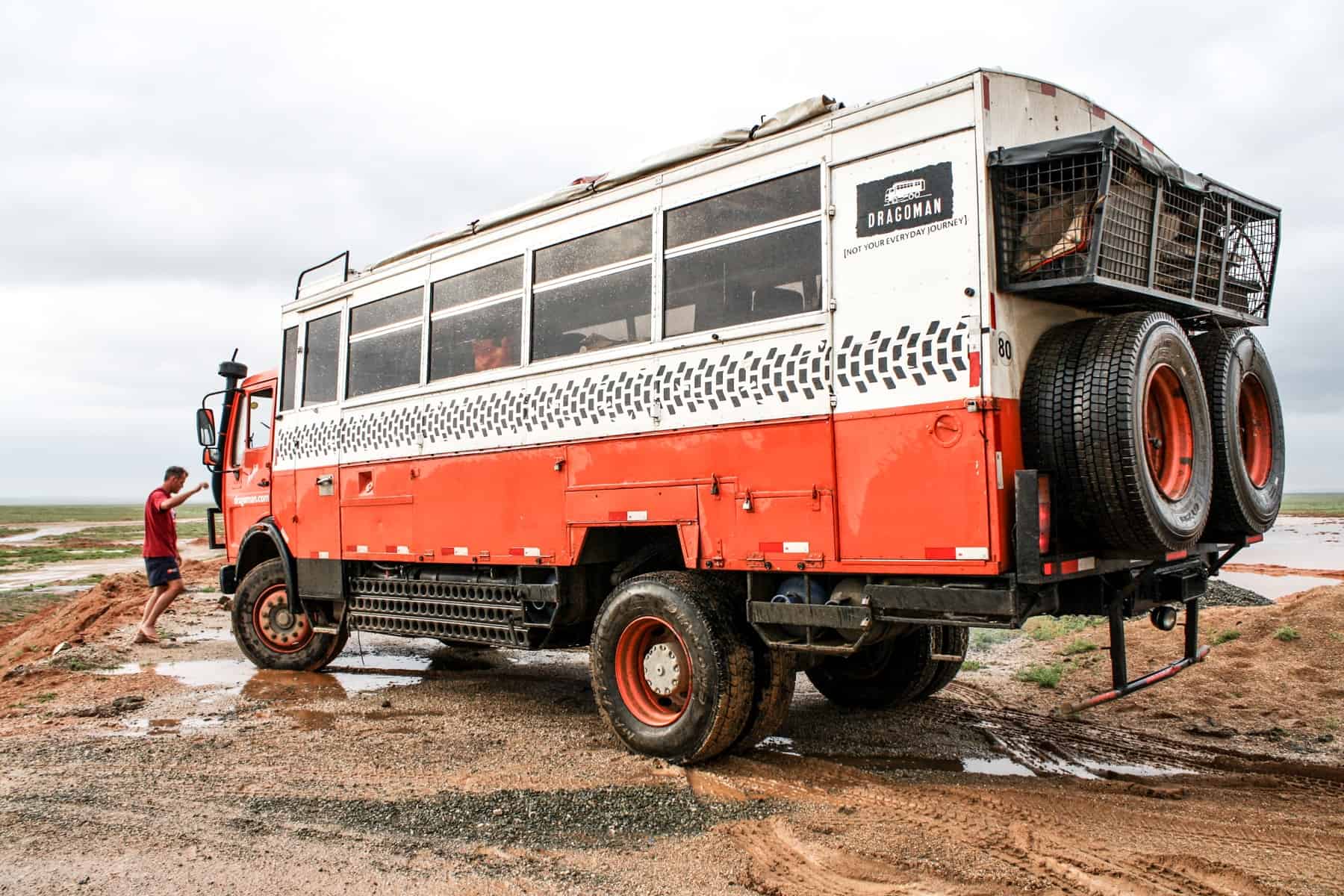
The Overlanding vehicle used to travel to Mongolia and around.
The summer season between May to September is said to be the best time to go to Mongolia. July and August are the hottest months, with temperatures in the Gobi Desert reaching 40°C. Rainfall is at its highest between June and September, balancing out the heat while keeping the forest and valley lands, in particular, lush and fertile. I travelled to Mongolia in July and experienced a lot of rainfall alongside high temperatures.
Mongolia’s winter season is from November to February. While some people like to experience the landscape in this snowy season, temperatures can drop to below minus 20°C – a harsh and challenging environment to travel in. You’ll find that not many companies run tours during this time.
Is it Safe to Travel to Mongolia Safe?
While petty crime and pickpocketing are common in the capital, Ulaanbataar, Mongolia is a relatively safe place to travel, and I never encountered any significant problems. It pays to be more streetwise and alert in the city, as you would in any other. As the landing and departure point for tourists, opportunism poses a higher risk.
Despite the lack of infrastructure and the relative isolation when travelling through the country, the only minor issue we encountered was related to the high levels of alcoholism in the country. We saw drunk drivers on our long drives and an occasion or two when inebriated locals came to our makeshift camp out of curiosity. Even then, it never felt threatening, and we were always within the safety of our group.
On the whole, we rarely saw other people, and when we did, we were met with kindness, invited into homes and welcomed into common spaces such as markets and small-town social spaces.
I also travelled alongside a Mongolian guide – someone who could speak the language when we got stuck, who could walk to a nearby home and explain the need for assistance and who understood the land’s general navigation. Therefore, in Mongolia, it pays to get yourself a local guide, join a small group tour, formulate a small group of your own in Ulaanbataar or be equipped with general wilderness survival skills if going out there entirely on your own.
Mongolia Tours
When I was planning my trip to Mongolia, Dragoman was the only company offering Mongolia tours that lasted from ten days to two weeks. The 21-day overland journey was the first trip itinerary of its kind they were running here, which included Inner Mongolia. Today the 21-day trip, called Nomads & Wilds of Mongolia, is on a loop from Ulaanbaatar and includes Khovsgol Lake in the north. Although Dragoman suspended operations during the pandemic, they are back in 2024.
Adventure travel experts G Adventures, offer Mongolia tours that all start and end in Ulaanbaatar.
A 14-day trip, including all the highlights at an affordable price (from €1999), this Mongolia trip includes a Gobi Desert and Mongolian Grasslands stay, alongside packing in the major historical must-sees and cultural experiences that make Mongolia an unforgettable adventure.
This 10-day local living trip includes staying with three different families in Gers to experience life as a nomad. Mix historical monuments with cultural moments, exploring pastures, forests, lakes and national parks by foot and horseback while helping your host families prepare traditional dinners and learn the skills of their nomadic trades.
G Adventures, in partnership with National Geographic Journeys, offers a two-week comfort adventure through Mongolia . You get to visit Khustai National Park, Karakorum (the ancient capital of Mongolia), Tsenkher Hot Springs, the Orkhon Valley and more. You will also see a nomadic camel-herding family and dive deeper into Mongolia’s culture, as well as support the local community where tourists pass through.
Want to experience the Naadam Festival’s horseracing, archery and wrestling tournaments? This mini adventure takes you to it and throws you right into the buzz of traditional Mongolian festivities.
Mongolia is expensive to travel in and around due to the very nature that it is not overly touristic. Due to the lack of infrastructure, a tour with a local guide and appropriate transport can often be necessary to cover more ground.
- You will need to budget between $2400-$3600 for an extensive trip around the country.
- An average meal (if not making your own on the trip) costs around $5.
- Entrance fees to historic sites and museums average around $2 per ticket.
For those on a budget, day trips can be taken from Ulaanbaatar, or you can try and plan some shorter 3-5 day trips from the city. However, this can often depend on having a minimum amount of people signed up for the trip to run and isn’t always guaranteed.
Do you need a Visa for Mongolia?
If you are not a national of one of the visa-exempt countries listed below, you will need a Mongolia visa.
- A single-entry visa (valid for three months from the date of issue) for up to 30 days – £40/$50
- A double-entry visa (valid for three months from the date of issue) for up to 30 days – £55/$65
It is cheaper to apply directly at a Mongolian Embassy (either at home before you leave or in the country you are travelling in prior). You will need a valid passport, passport photos and supporting trip documents alongside a completed application.
Allow one working week for processing. Some Embassies provide a one-day service for an extra charge.
A 30-day tourist visa on arrival is available for tourists coming from European and other countries where there are no Mongolian Embassies present, obtained at Ulanbataar Airport or the Mongolian land borders. I got my visa in London months before my trip.
The following countries are granted visa-free entry to Mongolia.
Visa-free entry for 90 days: Argentina, Belarus, Brazil, Chile, Kazakhstan, Kyrgyzstan, Serbia, United States (US). Those from Ukraine require a form of invitation.
Visa-free entry for 30 days: Canada, Cuba, Germany, Israel, Japan, Laos, Malaysia, Russia, Singapore, Turkey, Thailand, Uruguay.
Visa-free entry for 21 days: Philippines.
Visa-free entry for 14 days: Hong Kong.
You can find further information on the Embassy of Mongolia website .
Where to Go in Mongolia – Itinerary
I spent 20 days Overlanding in and across the central and western Mongolian plains. We travelled in a big clockwise circle from Ulaanbaatar, through the scorching Gobi Desert to beautiful lakes, forests, canyons and waterfalls, all the while passing vast herds of wild horses, camels, goats, yaks and cows.
Overlanding in Mongolia for Three Weeks:
Kilometres travelled: 2492
Number of significant times the truck got stuck: 2
Number of minor times the truck got stuck: 12
Number of incredible driving days: 15
We spent a full day in Ulaanbaatar exploring outside of the stark Soviet communist-style architecture and moving past the city’s general dodgy feeling. There’s plenty to see and do here, including a walk through the modern Sukhbaatar (Parliament) Square, the Gandan Monastery, the National History Museum and the shopping paradise of the Black Market . In the evening, check out the singing, dancing and contortion talent at the Cultural Show before hitting a few bars and pubs. There’s so many you won’t know where to start.
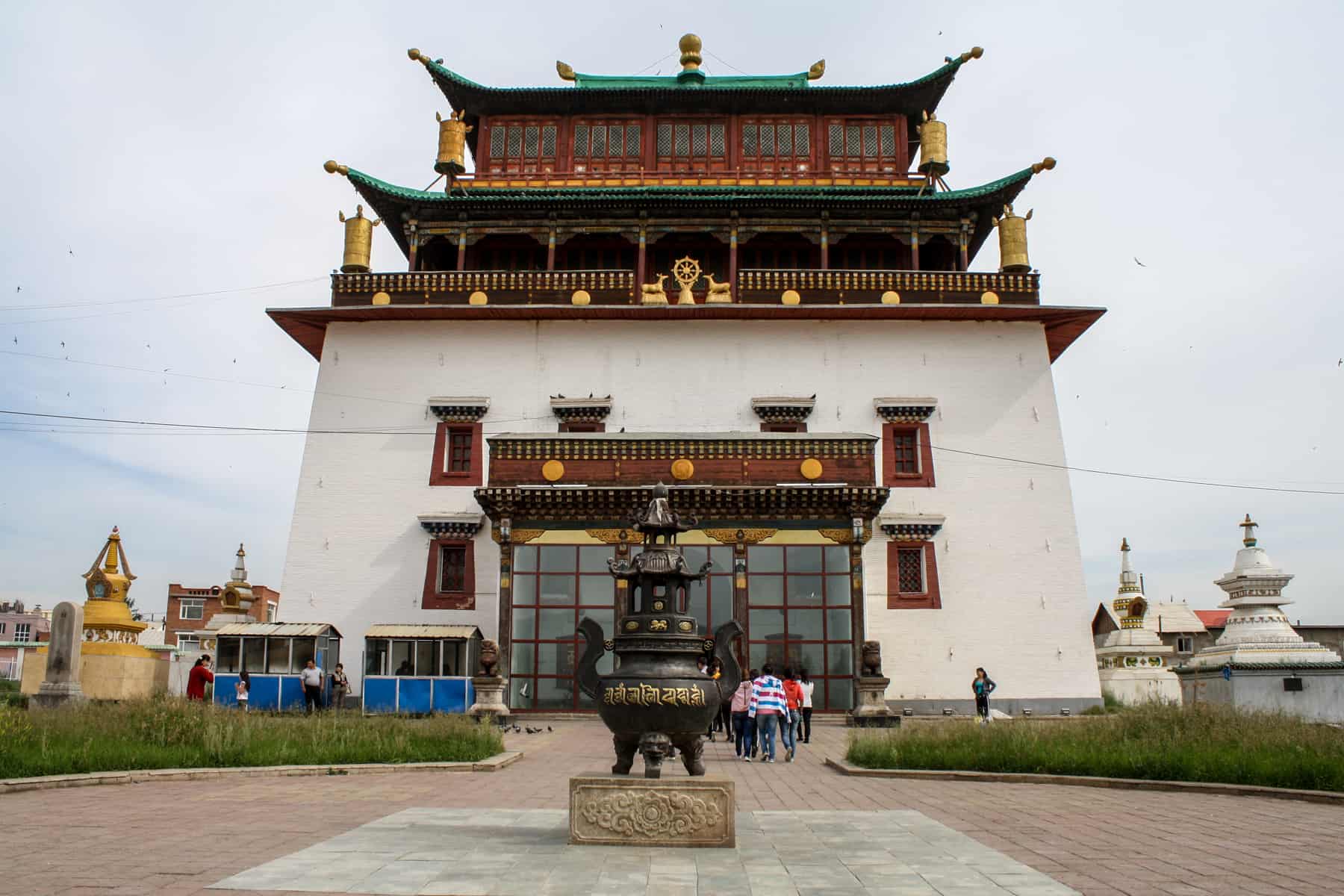
Gandan Monastery in Ulaanbaatar, Mongolia
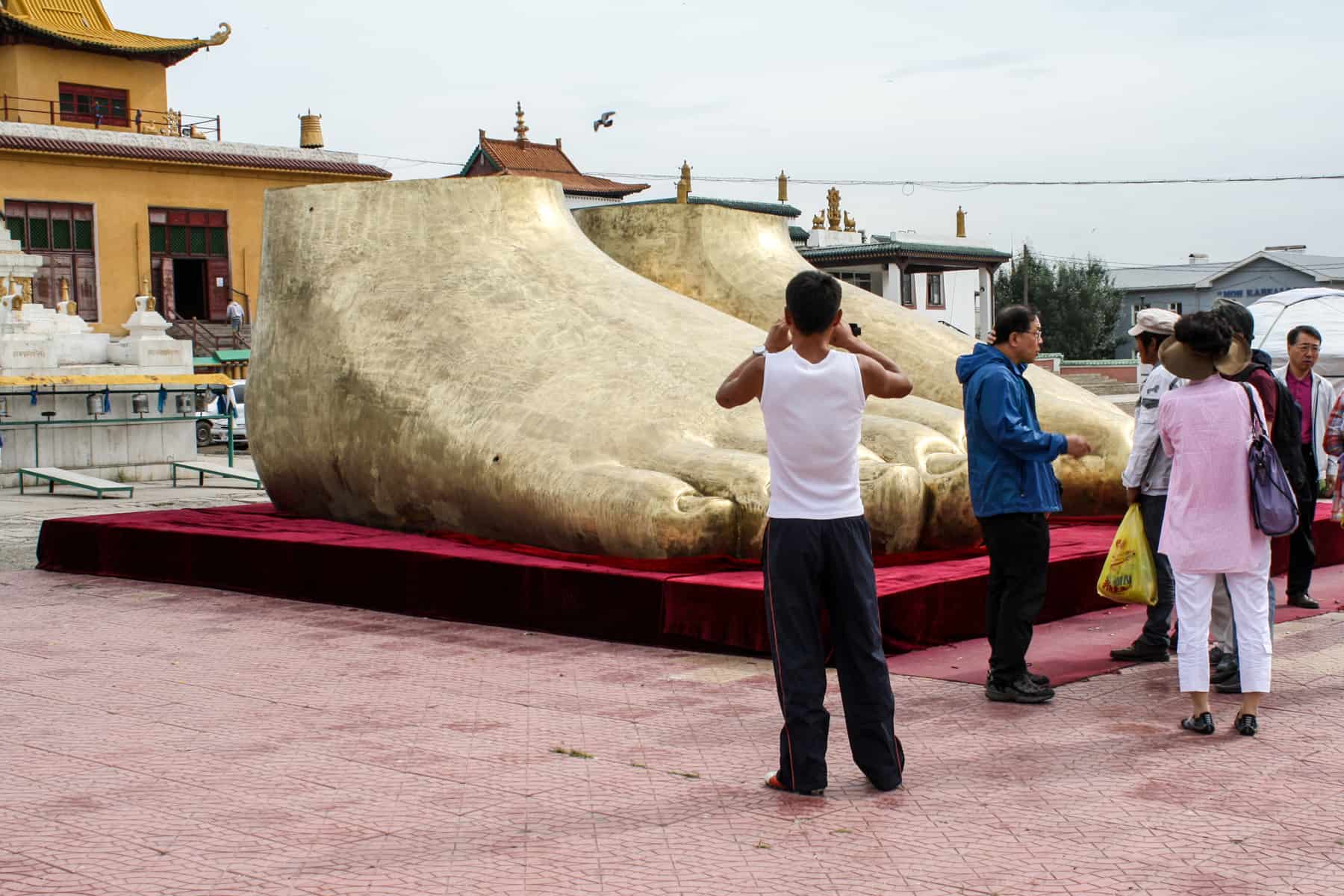
The golden feet outside the Gandan Monastery Ulaanbaatar
We set off in the truck from Ulaanbaatar to drive to the Baga Gazryn Chuluu rock formations in the Gobi desert. Due to heavy traffic when getting out of the city and general road conditions we got delayed and so decided to set up bush camp for the evening. Be prepared for delays in Mongolia but delight in being the only people in the area. All the space is yours.
We got to Baga Gazryn Chuluu – rock formations worshipped by locals who make pilgrimages here partly because legend states that Ghengis Khan camped here – before journeying to the Gobi Desert.
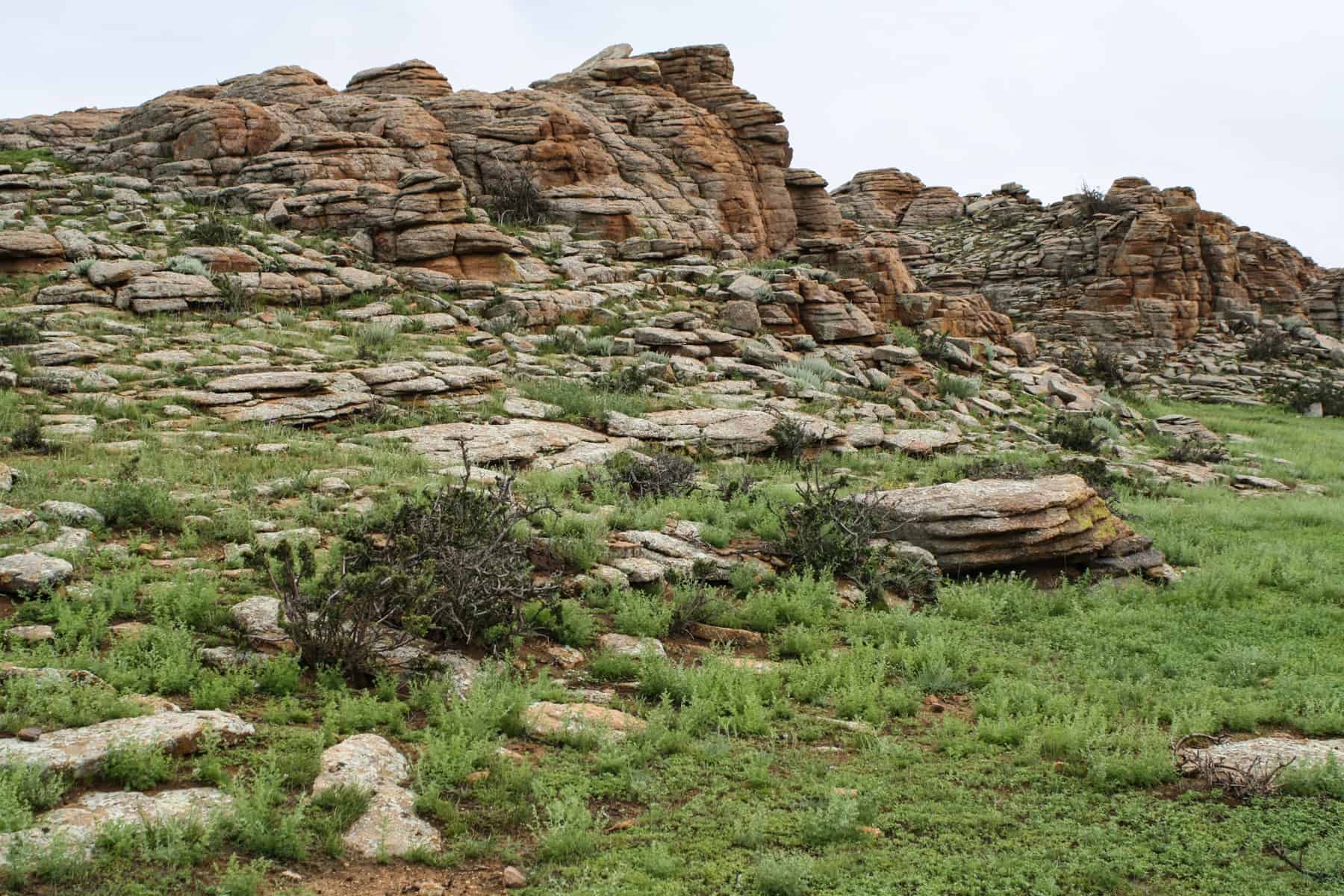
Layers of Baga Gazryn Chuluu rock formations in Mongolia
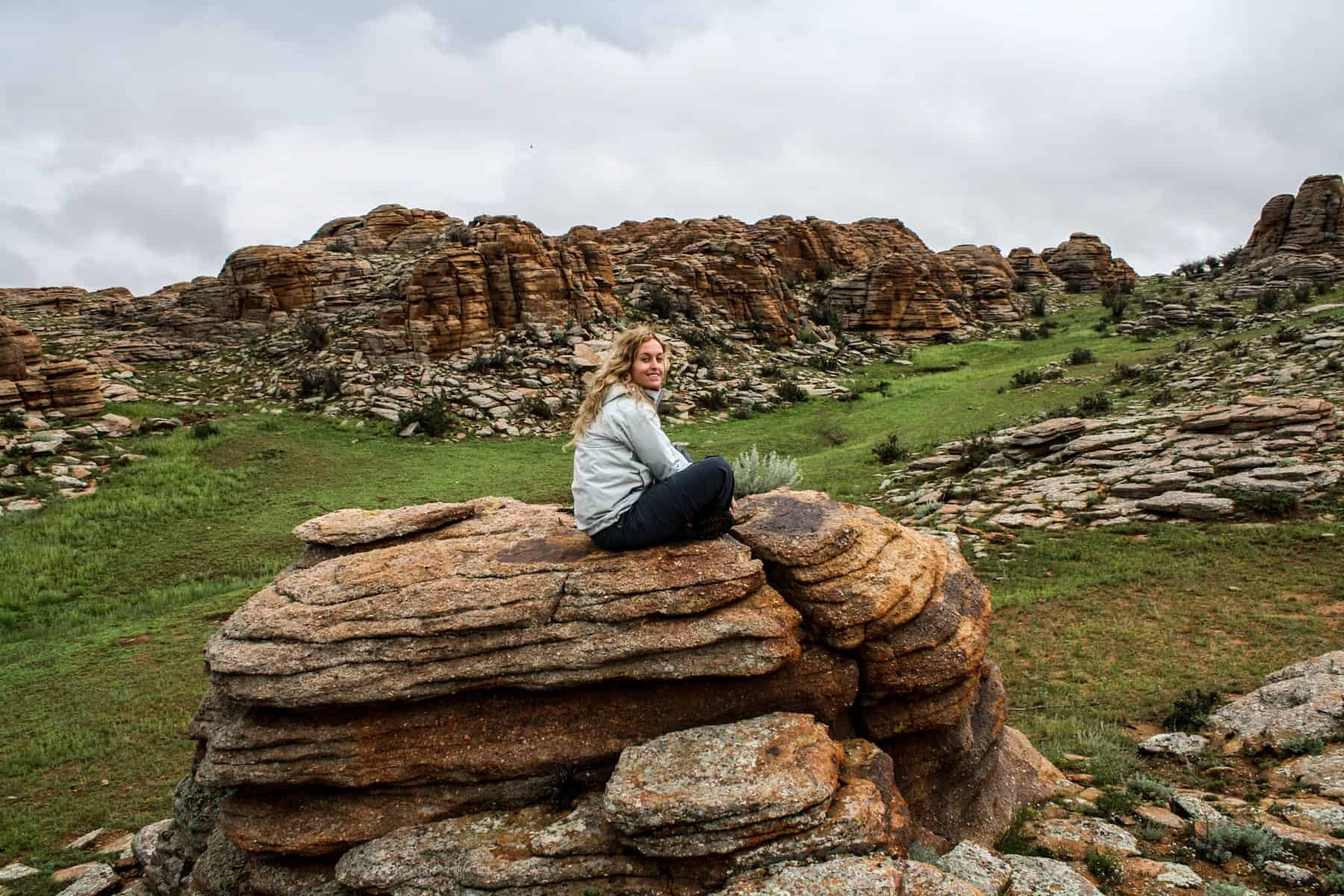
A hike to Baga Gazryn Chuluu as part of a Mongolia travel itinerary
On the way, we got to experience the famous Nadaam Festival when we passed through the local town of Mandal Govi . It was full of wrestling, horse racing, archery and fairground style fun. Nadaam means ‘games’, and the buzz was all around us as the only Westerners there. It was great to be a part of a traditional Mongolian community celebration, even if the afternoon was marred by a bogging, which resulted in the truck not being released from the soft mud until midnight.
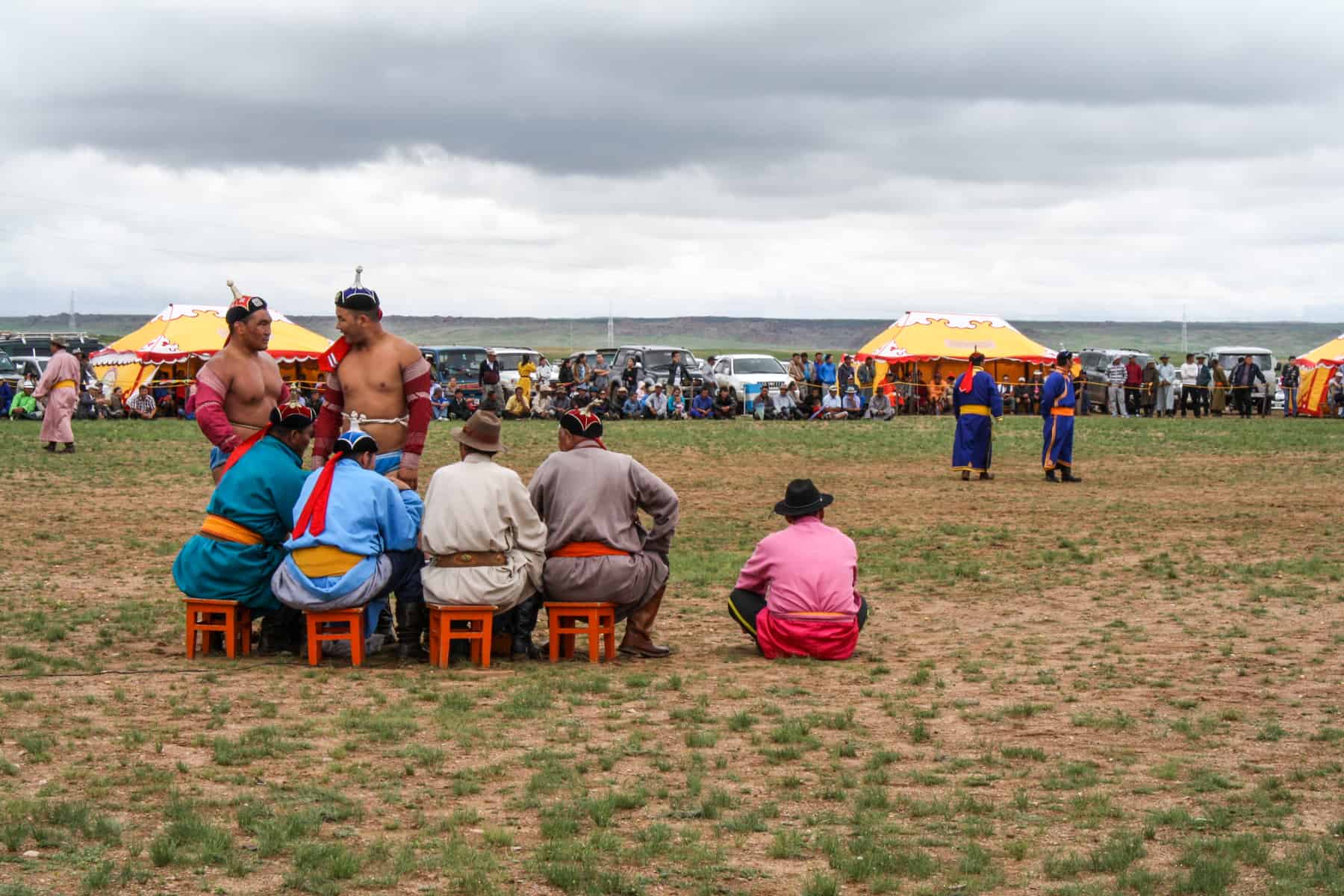
Watching the wrestling at the Nadaam Festival in Mongolia
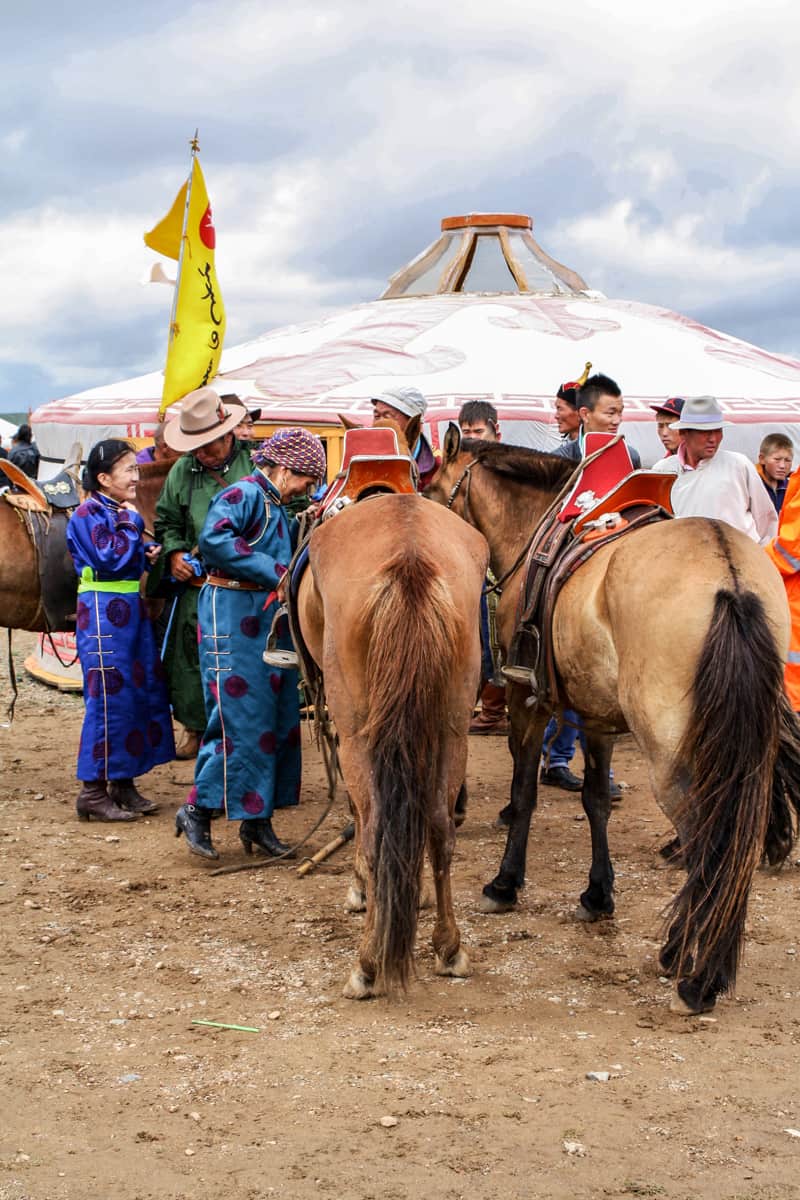
Mongolian locals enjoy the Nadaam Festival.
The plan was to get to our first ger camp, but after approximately 30 kilometres, we encountered a large ditch of water on the road. It resulted in us having to drain the water by hand and build a road and a dam for most of the afternoon to help us get across. Although this sounds horrendous, it created a great sense of camaraderie and, ultimately, an immense sense of achievement. We got to camp on a high point of the Gobi Desert instead near the town of Tsogoovi .
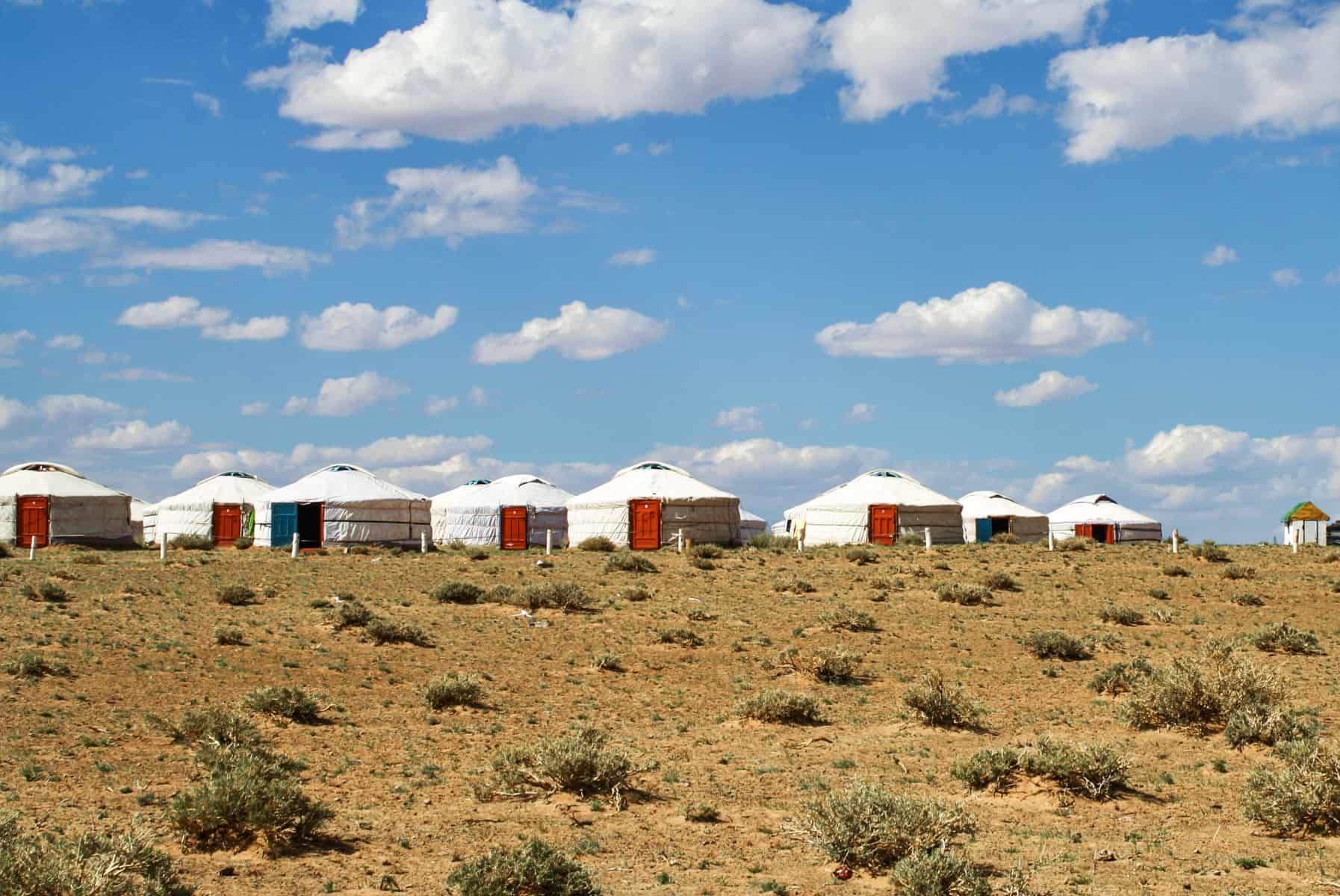
A Ger Camp on a hilltop in the Gobi Desert, Mongolia
We began our journey without a hitch to the ger Camp called Gobi Discovery, stopping at the town of Dalanzagad on the way. Mongolian towns are typically tiny and compact settlements that are reasonably large but without the ruin of a city like Ulaanbaatar.
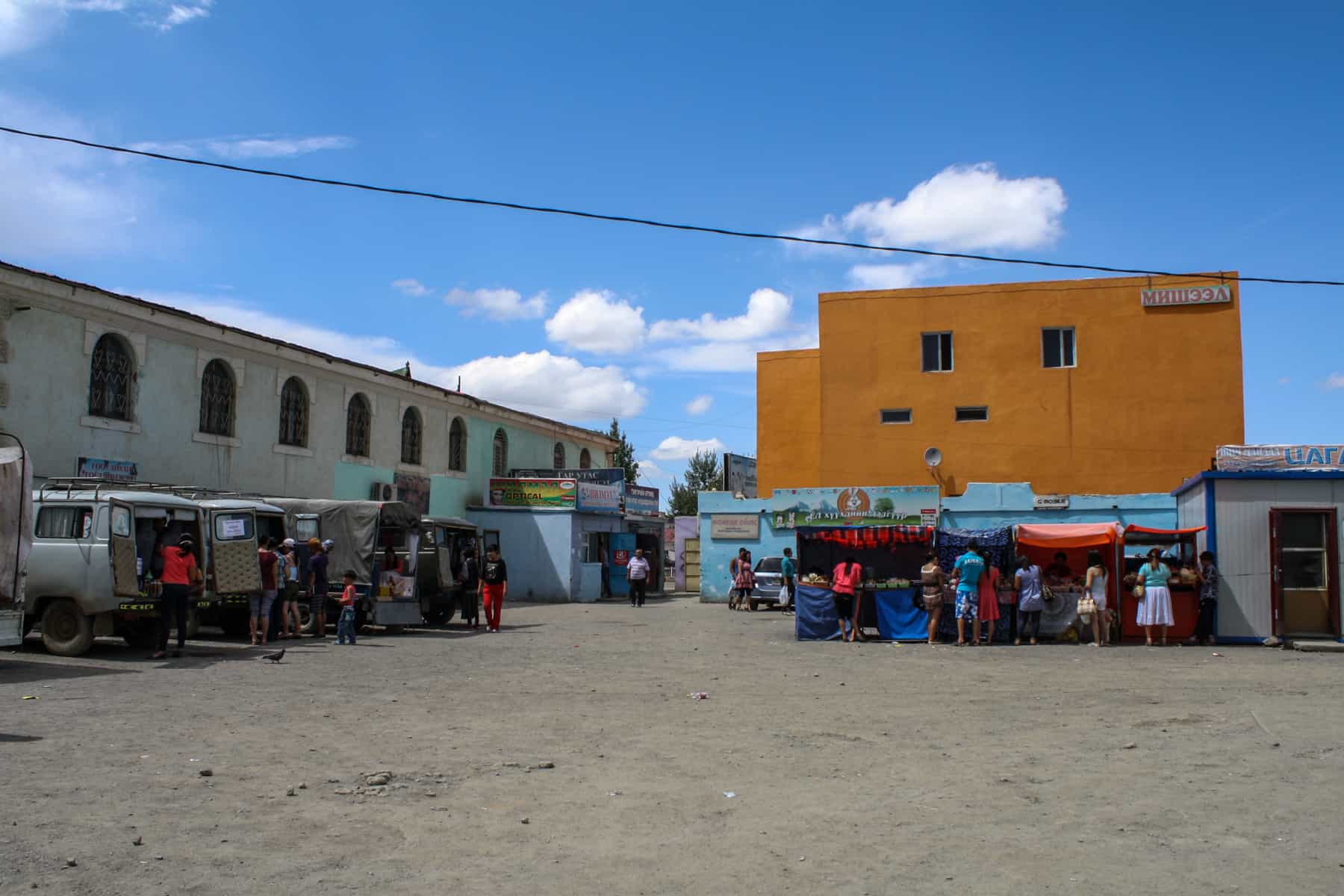
Market time in the town of Dalanzagad, Mongolia
We hiked in Yolin Am , a beautiful canyon in the Gobi, an ice valley, which hosts a colossal glacier all year round. The hike was spectacular, but, unfortunately for us, little of the iceberg remained, although we had lots of fun playing with what little ice there was regardless.
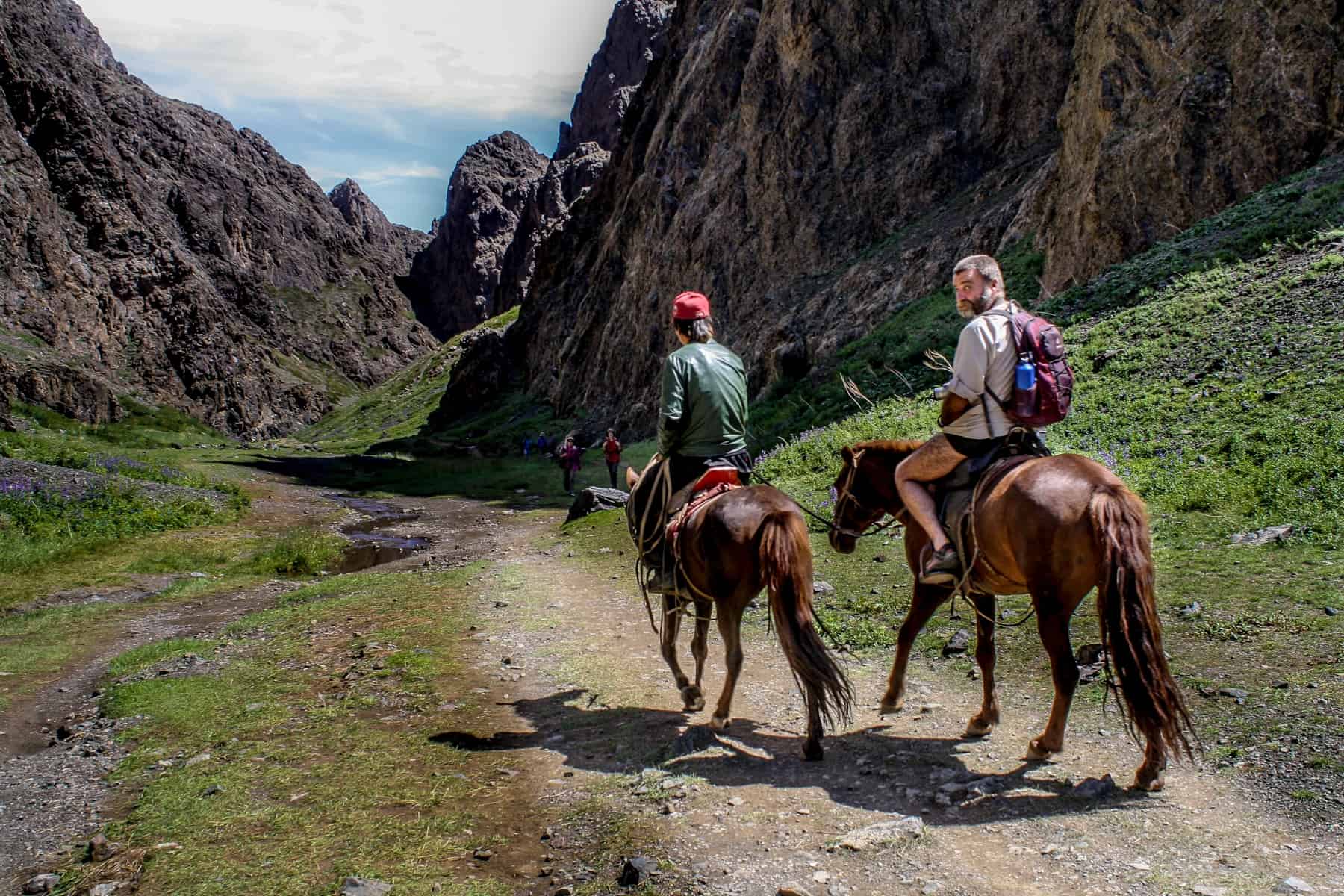
Hike or horseback in the Yolin Am Valley in Mongolia
Many sandy riverbed crossings eventually led us to our second Ger camp, Khongoryn Els Ger Camp. Here, you only have to open your ger door to be greeted with a breathtaking view of the Gobi and the Khongoryn Els Sand Dunes , which I later climbed, drank beer on and ran down. That was after a camel ride, of course.
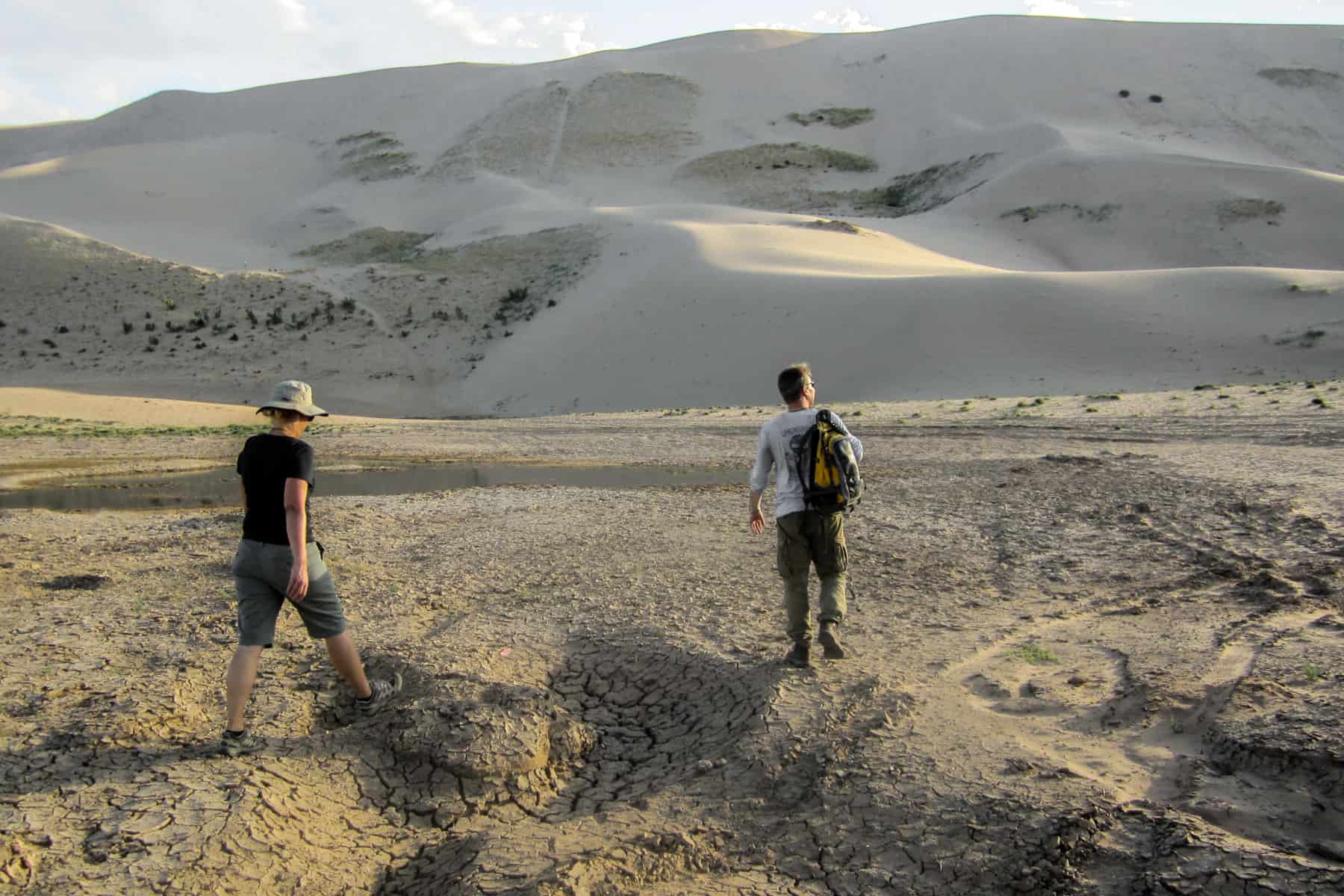
The glorious Gobi Desert Khongoryn Els Sand Dunes
Bumpy mountain roads took us to the spectacular Bayanzag Flaming Cliffs , which are a Mongolian version of the Grand Canyon, but smaller. It’s a significant site that unearthed many dinosaur fossils and eggs, and it is also a stunning backdrop for bush camping.
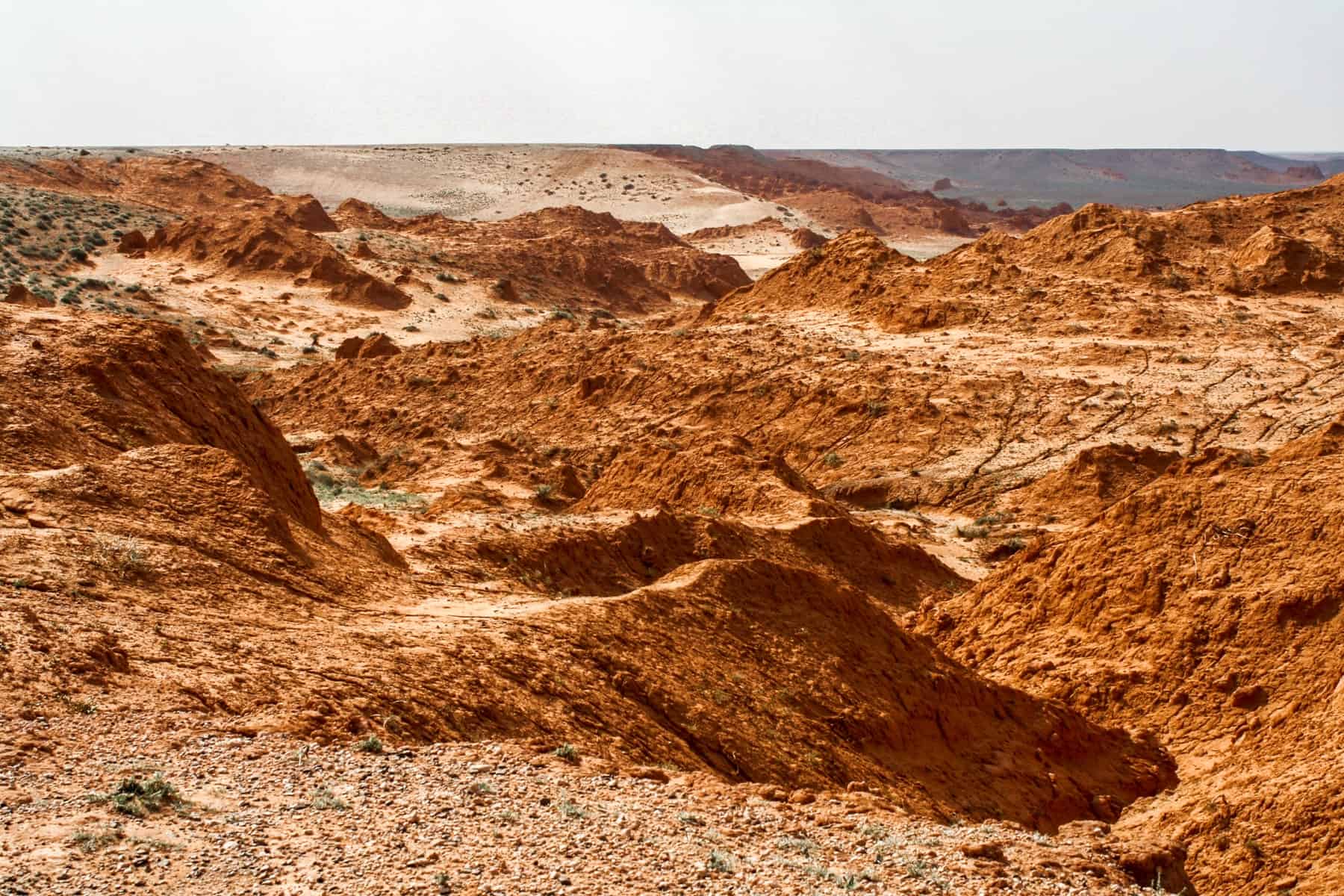
The blazing ochre colours of Mongolia’s Bayanzag Flaming Cliffs
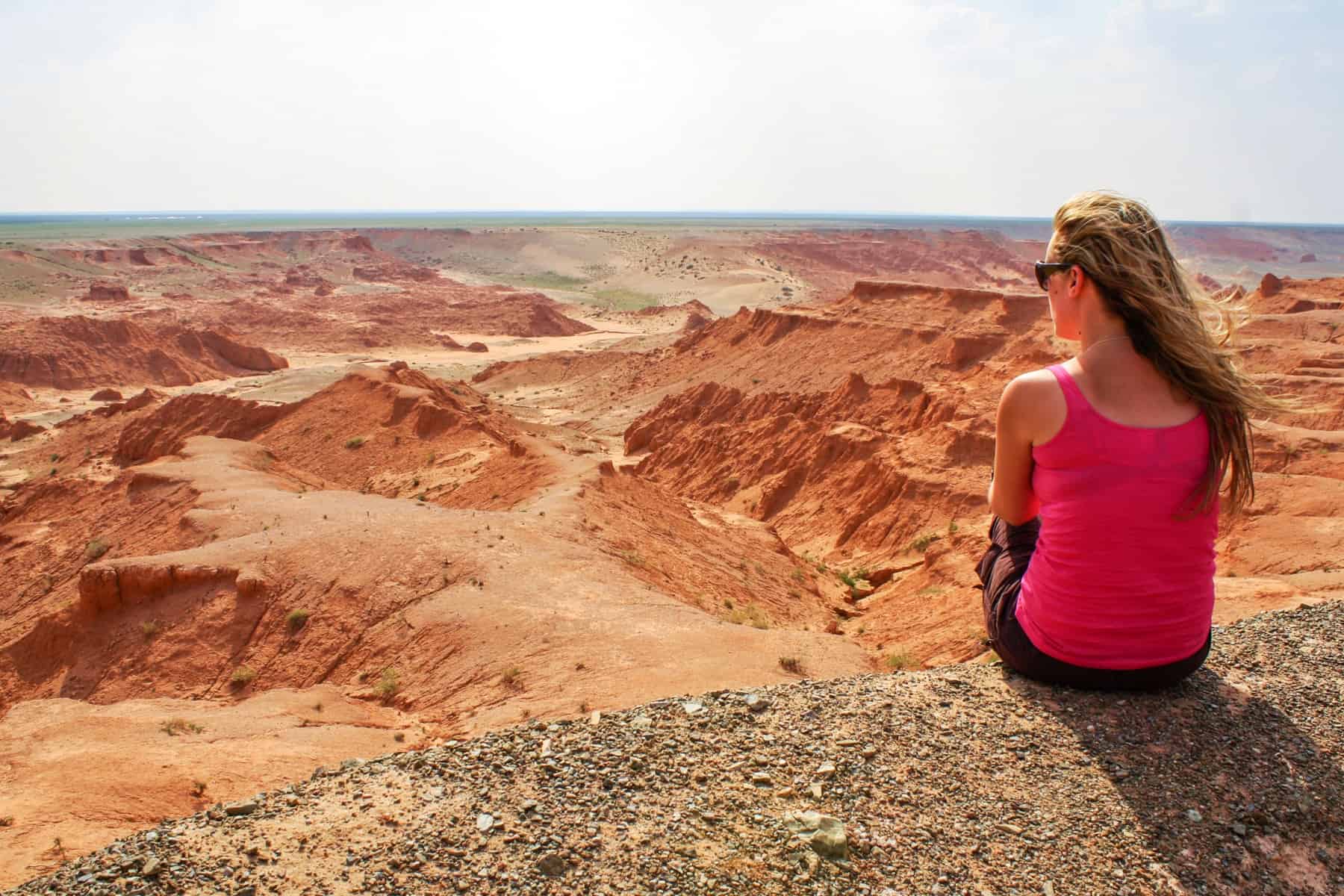
Marvel the mars-like landscape of Bayanzag Flaming Cliffs when you travel to Mongolia
When the communists invaded Mongolia in the 1930s (known as the Purges), nearly all Monasteries were destroyed. Ongii Monastery was one of them, and we visited the ruins here before driving to Arvaikheer, where heavy rain forced us into a hotel for the night. At times, random bad weather makes bush camping in Mongolia impossible, so it is essential to prepare for a budget recount at any given time.
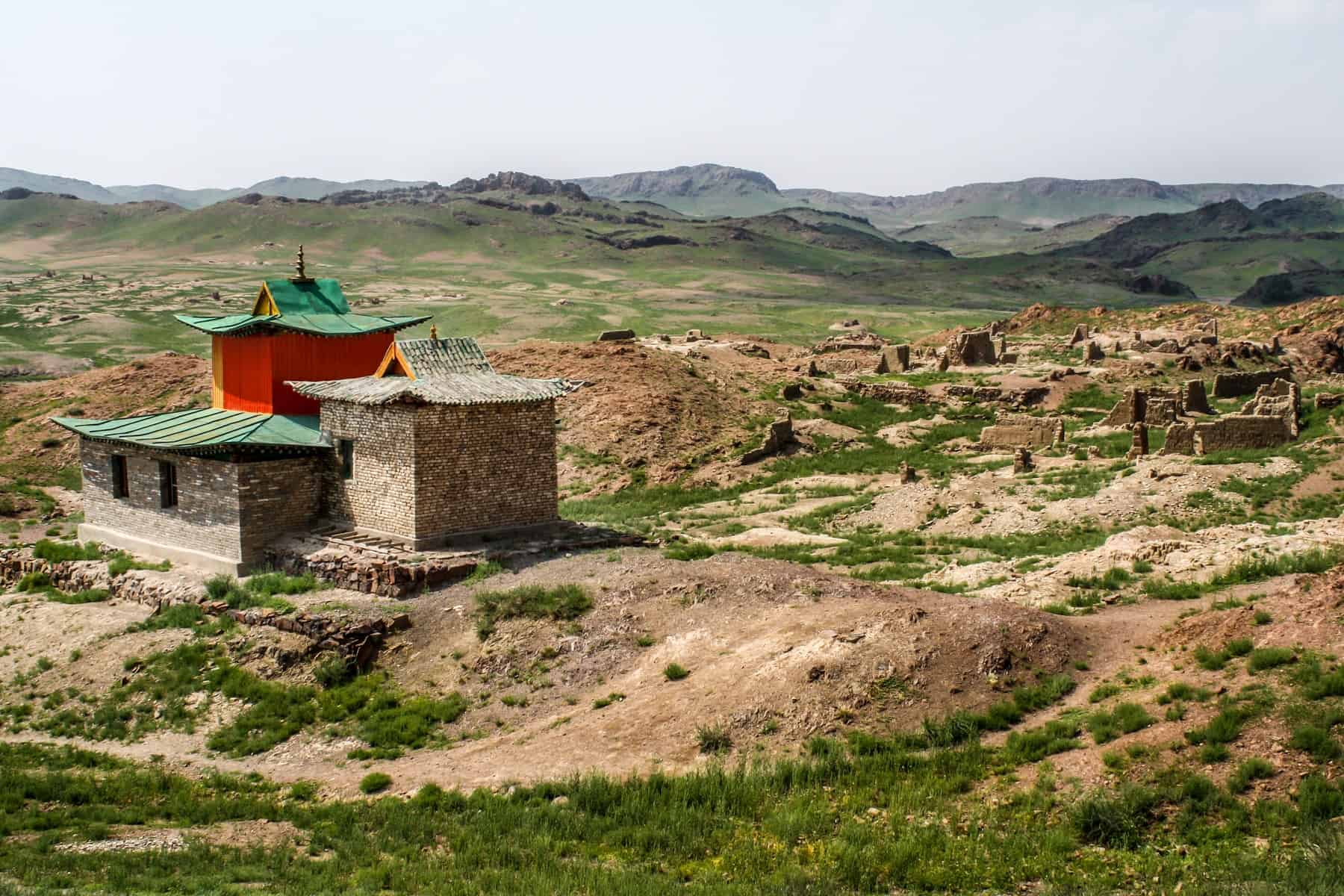
The site of the Ongii Monastery in Mongolia
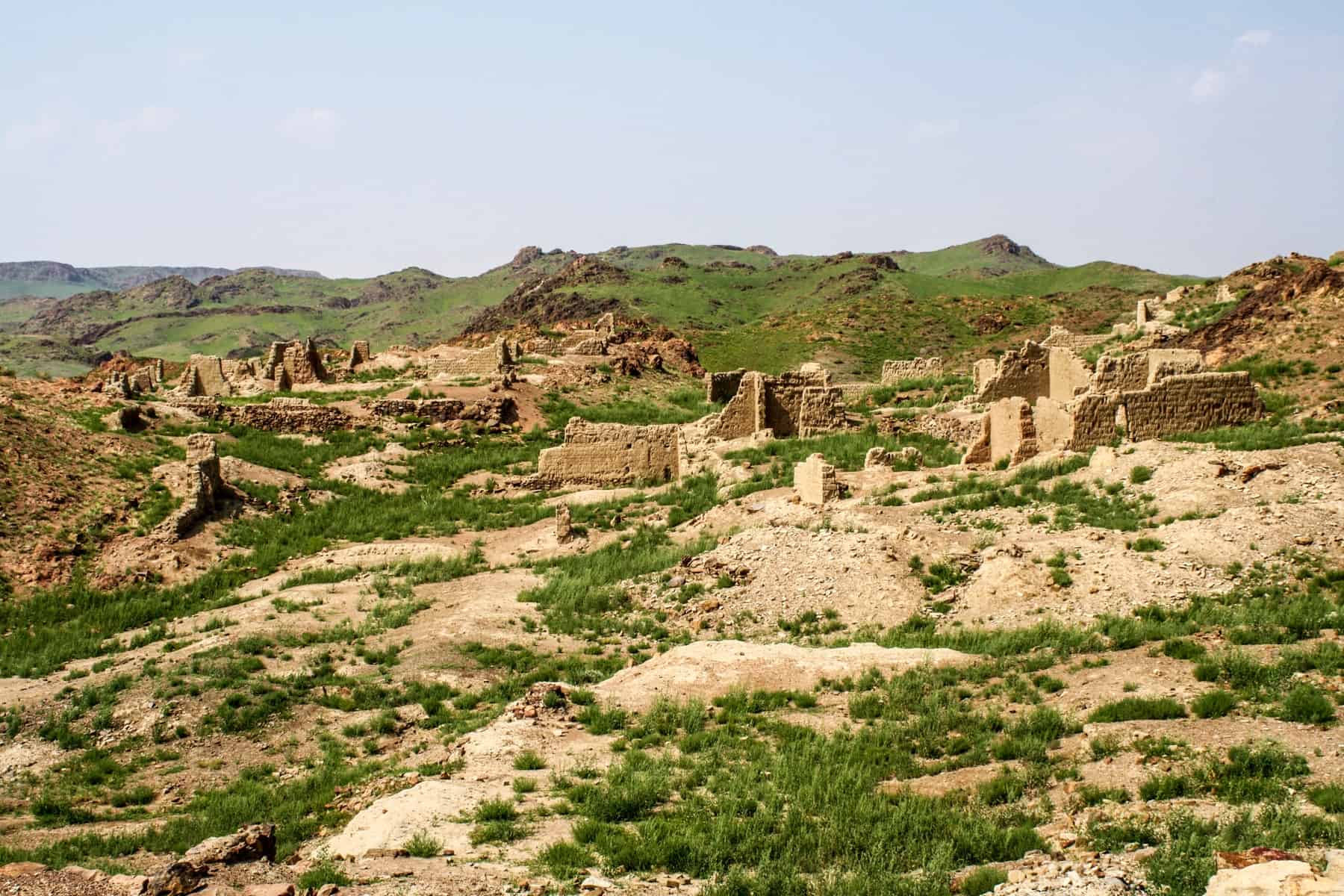
The scattered stone ruins of Ongii Monastery in Mongolia
We began our journey to the third ger camp but got badly bogged around midday after the truck had to swerve slightly, of course, to miss a drunk driver who came in our path (sadly, a lot of people drink and drive here). It took over five hours to get out, with the help of a small local tractor, and during that time, a few of us who remained to help with the truck (local jeeps rescued a few) lost our minds. It was a hilarious few hours that would have made an excellent documentary, probably how a Lord of the Flies scenario starts.
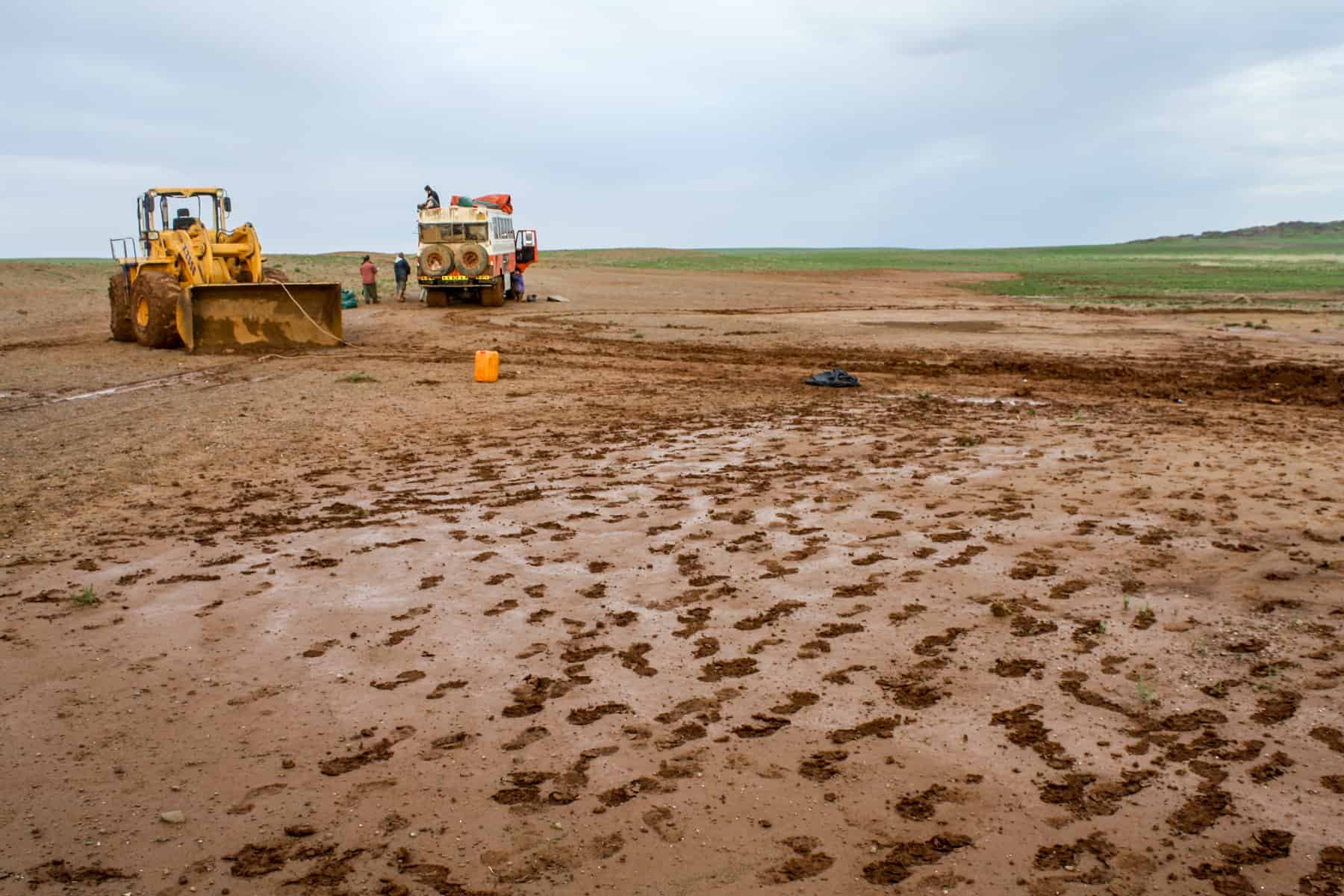
Tractors help pull the Overlanding truck out of the sticky mud in Mongolia’s rural landscape.
The roads were not rigid and stable enough for the truck to continue, especially with all the hills. After setting up tents and cooking dinner, two small vans came to the rescue to take us on our two-hour journey to the Ger Camp. It was a scary ride in the dark, where we stopped at the driver’s backyard and where a small boy jumped into the hold of the van for the rest of the journey.
I highly recommend staying in a ger camp in the beautiful Orkhon Valley . There’s nothing like a pleasant hike through the beautiful forest to reach the Tuvkhon Monastery and see the surrounding area. Pure bliss.
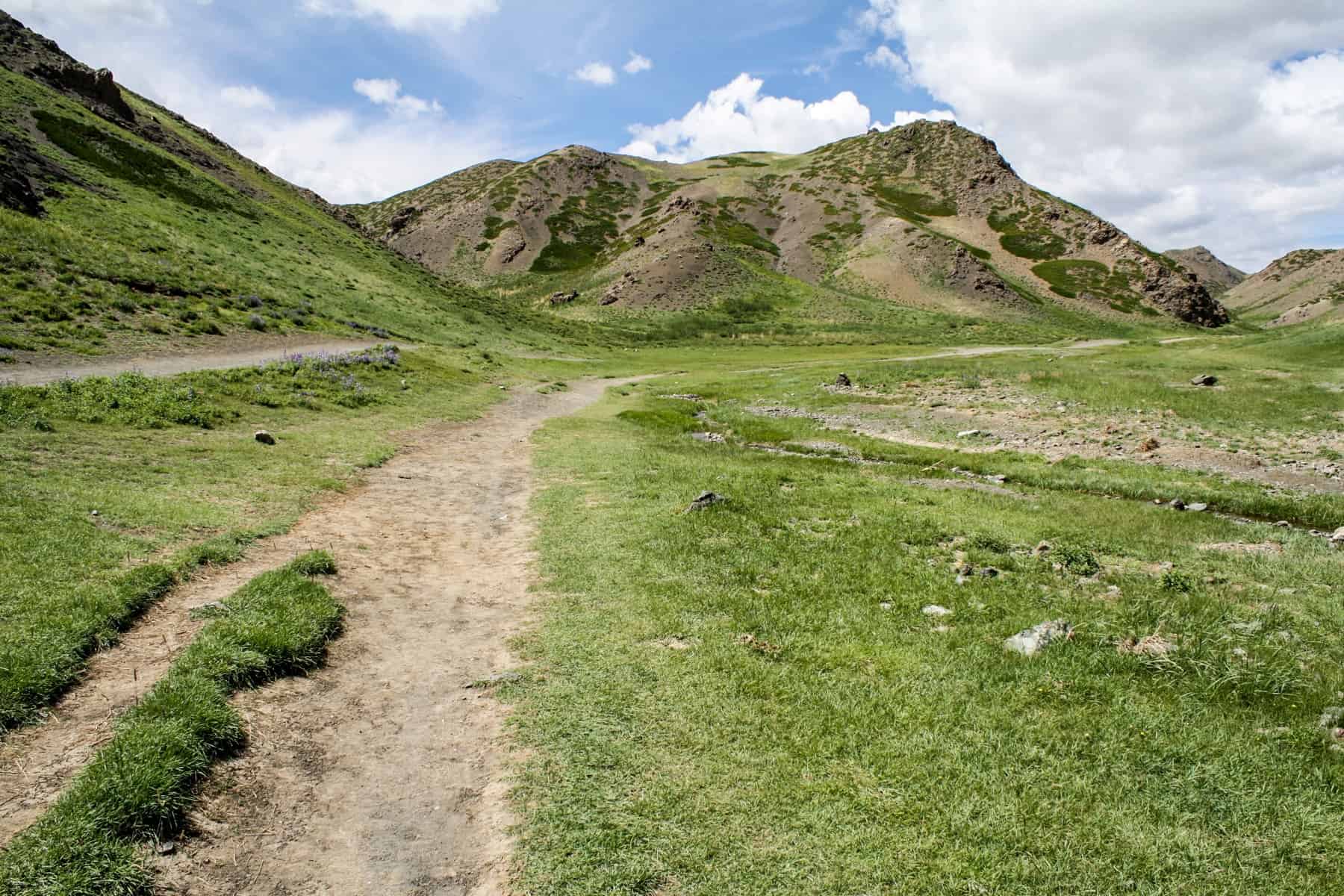
The lush green leading to the soft peaks in the Orkhon Valley Mongolia
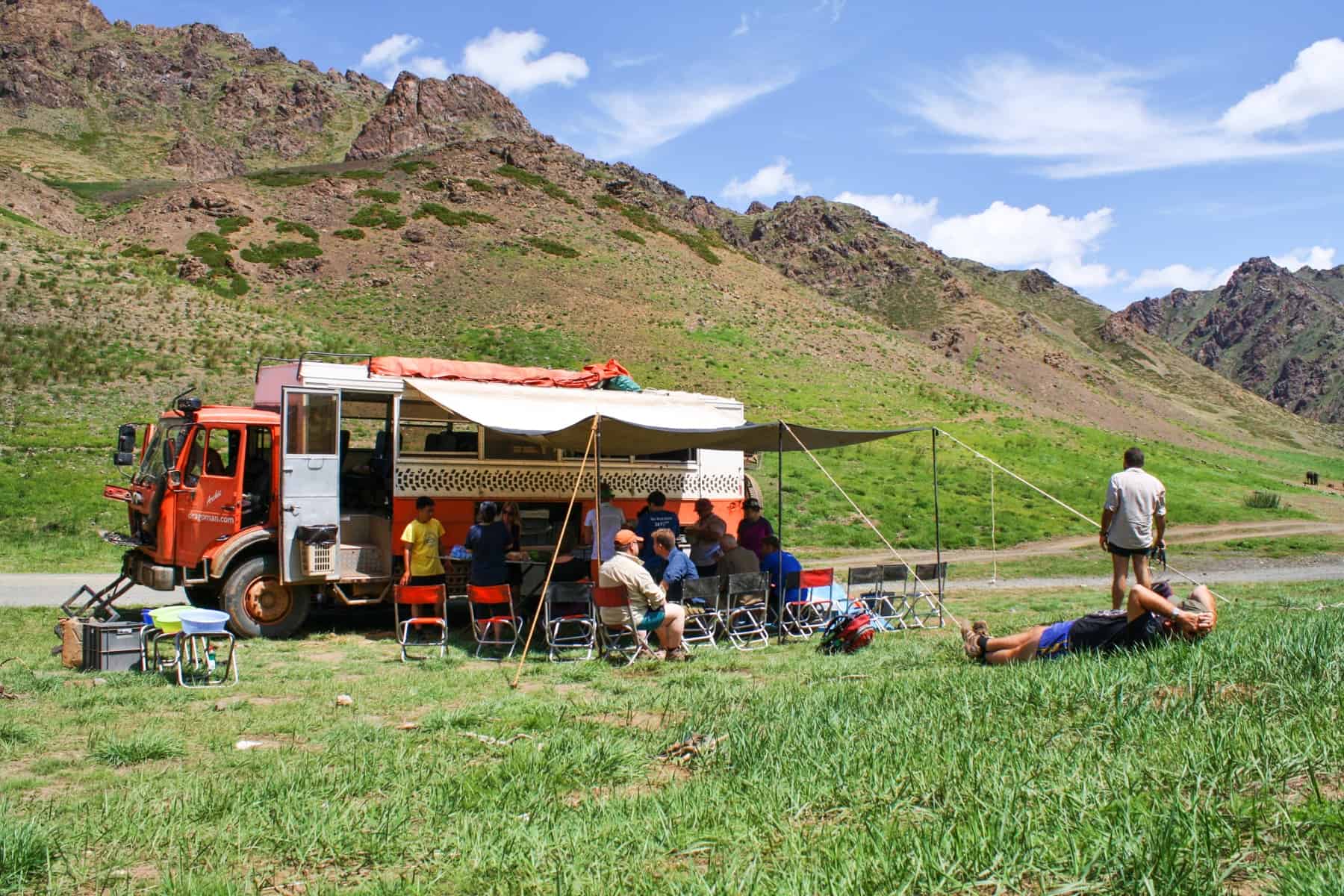
A rest stop in the scenic Orkhon Valley landscape
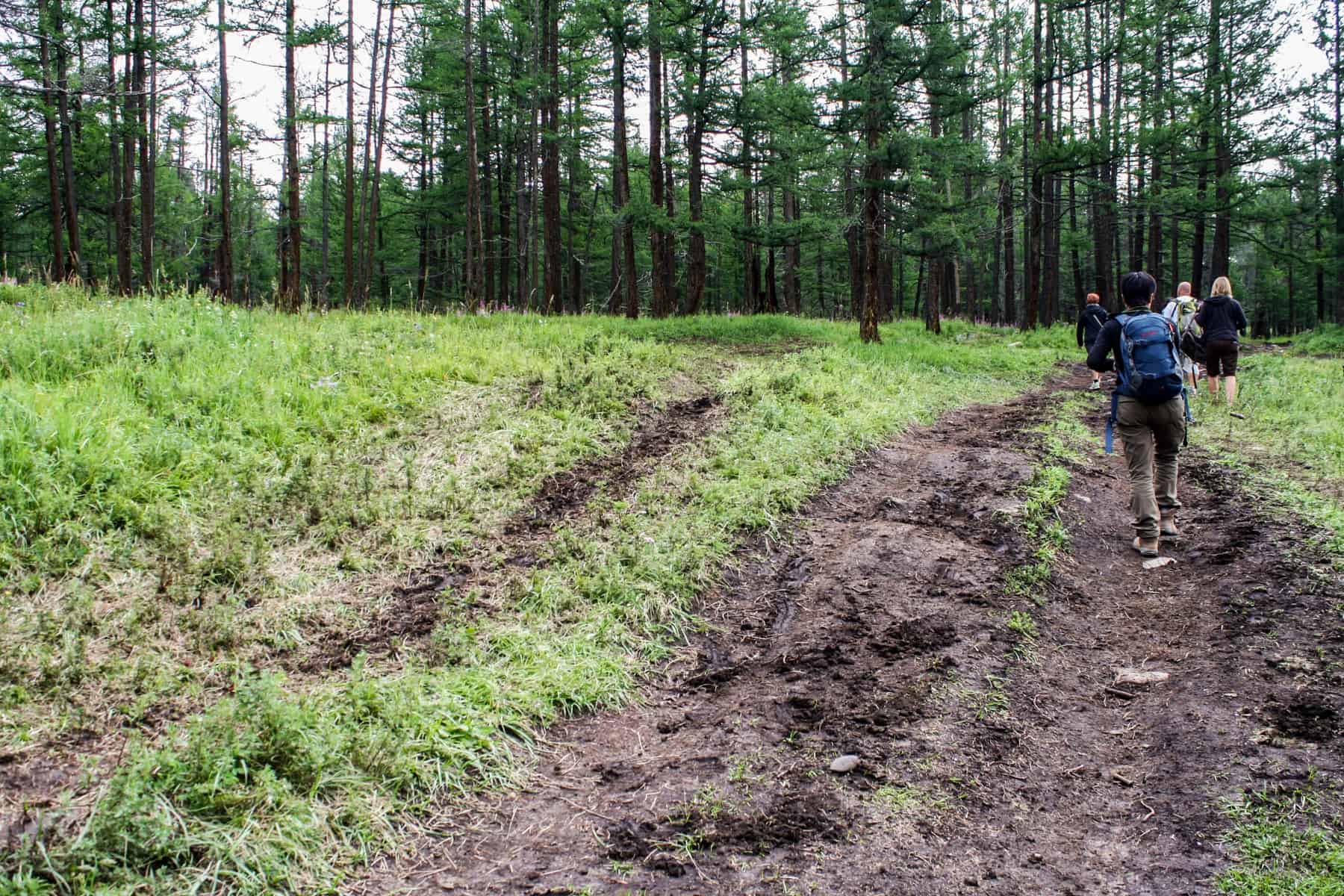
Hiking the forest trails of Mongolia’s Orkhon Valley

The rocky plateau that surrounds the Tövkhön Monastery in Mongolia

The colourful entrance to the Tövkhön Monastery
The Orkhon Valley waterfall was the next stop on our five-hour drive to the next ger camp. This camp plays host to the famous hot springs in the region, where we went skinny dipping and enjoyed a few refreshing beers.
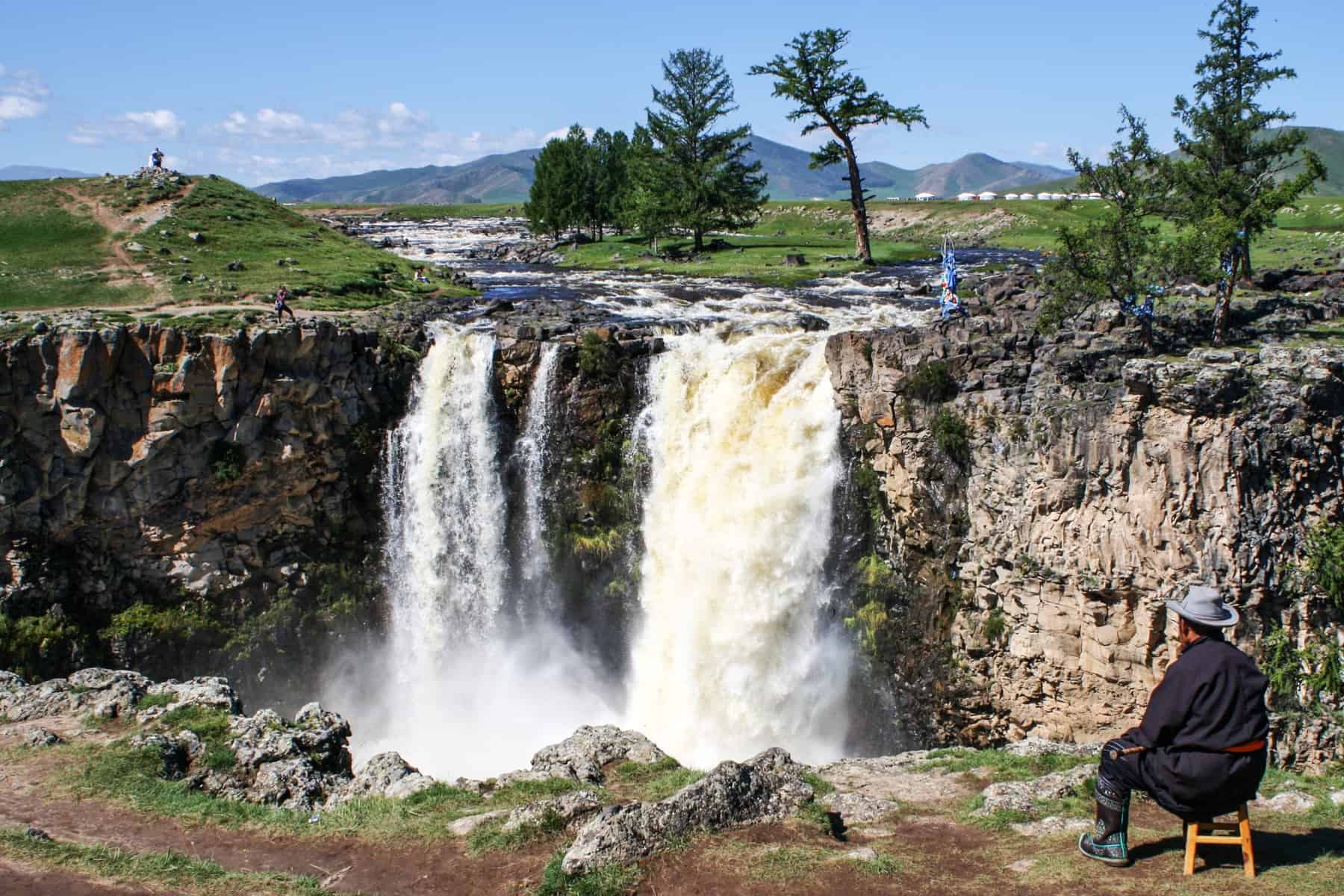
A Mongolian man sits in a chair peacefully enjoying the backdrop of the Orkhon Valley Waterfalls in Mongolia.
Fully clothed, of course, we took a short hike through the lush green forest to visit the source of the hot springs. When you come across your first sighting of trees after two weeks of barren land, you begin to appreciate such incredible surroundings.
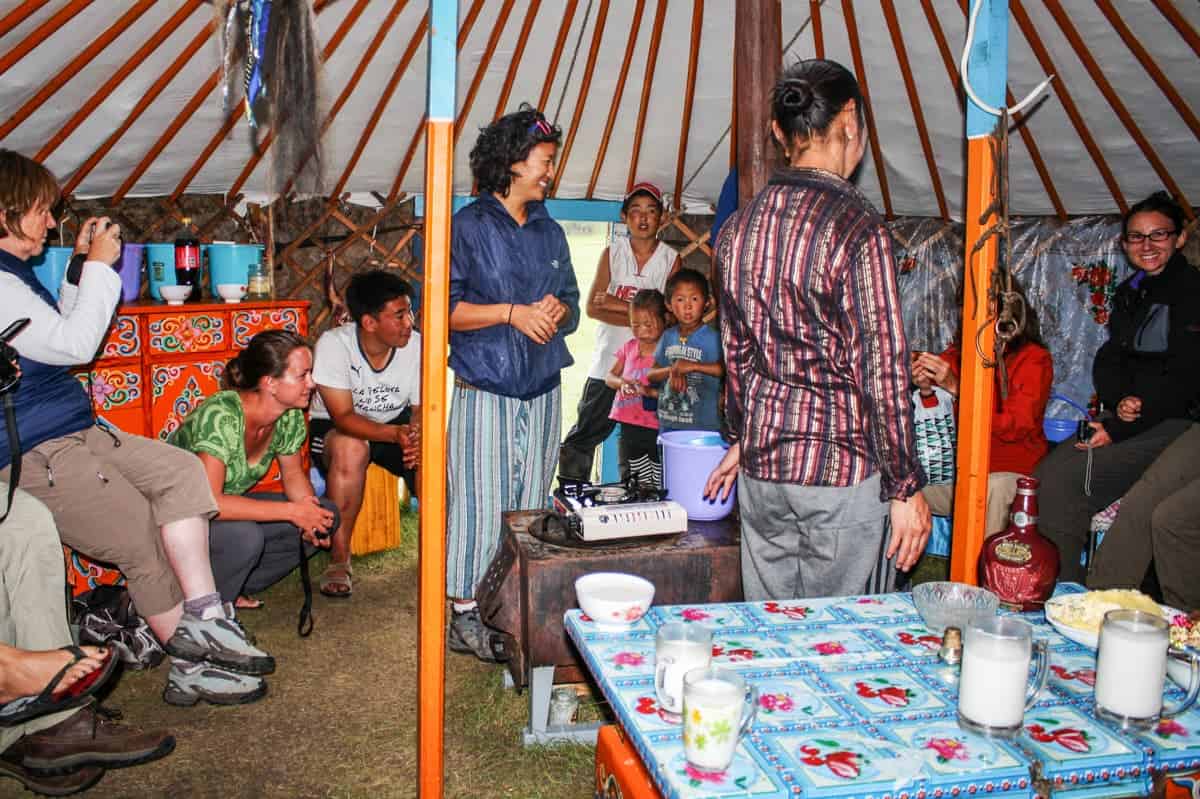
Visiting a local nomadic family in their ger in Mongolia
As we had two Mongolian guides with us (invaluable support in a country where very little or no English is spoken or understood), we could visit a Mongolian ger and a local family to learn about nomadic life.
It wasn’t a tourist set up, but a traditional, local family who lived on an isolated patch of land in the valley. We tried their dairy products (their source of income), including fermented mare’s milk, curd and butter, before learning about ger rules and traditions and asking each other many questions!
READ MORE: Visiting a Mongolian Ger – Understanding the Nomadic Culture of Mongolia
We needed a quick stop in the nearby town of Tsetserleg to stock up on food supplies. It was a market day with an electric atmosphere. I get a high from moments when you don’t know where you are and what to do, and where you have to work hard to communicate and negotiate.
We later visited the most important Monastery in the country, Erdene Zuu Monastery in Kharkhorin – the first Buddhist monastery in Mongolia that had up to 100 temples and 1,000 monks before the purges in 1937. Only three temples remained, alongside several statues and other items.
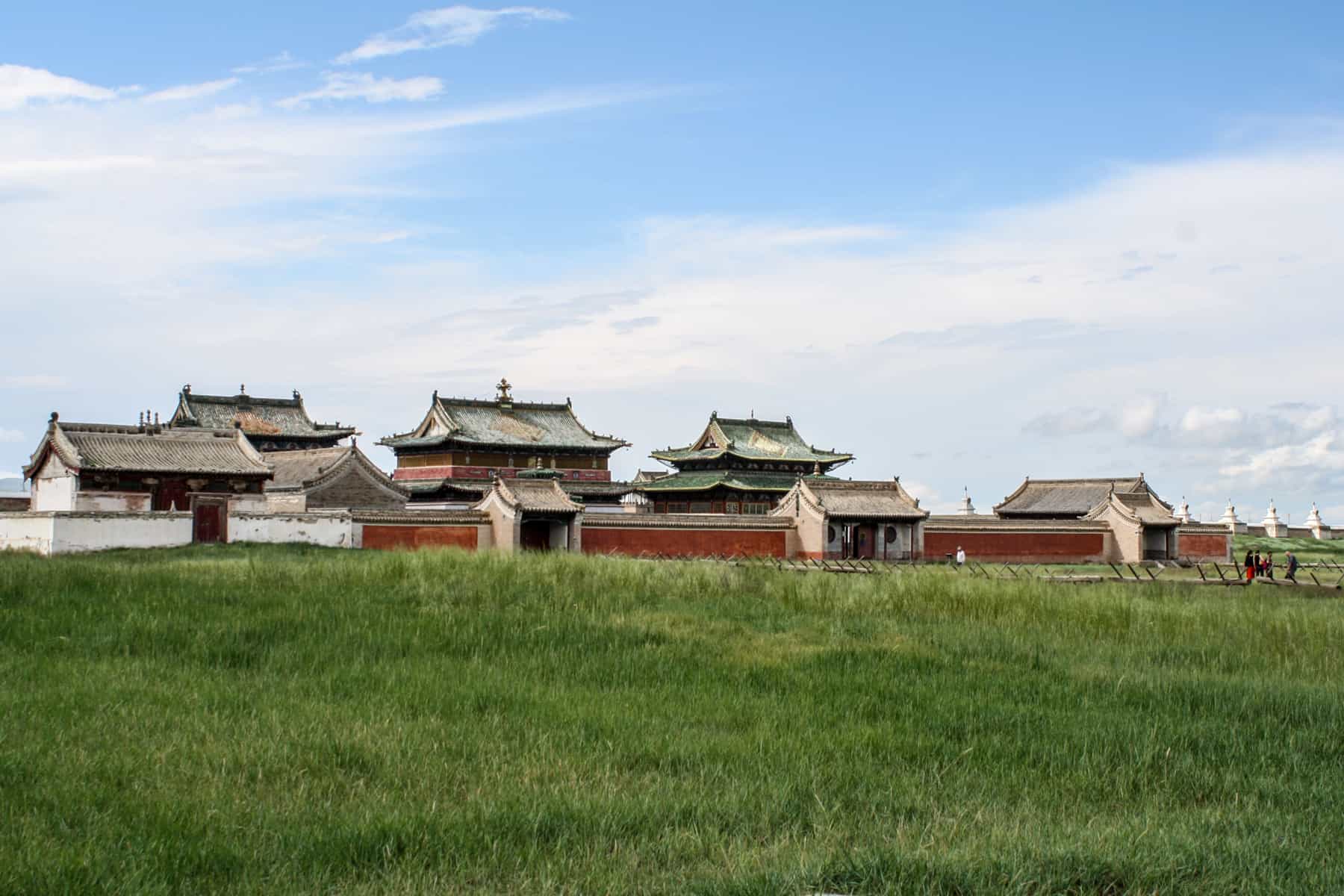
The exterior walls of the Erdene Zuu Monastery, Mongolia
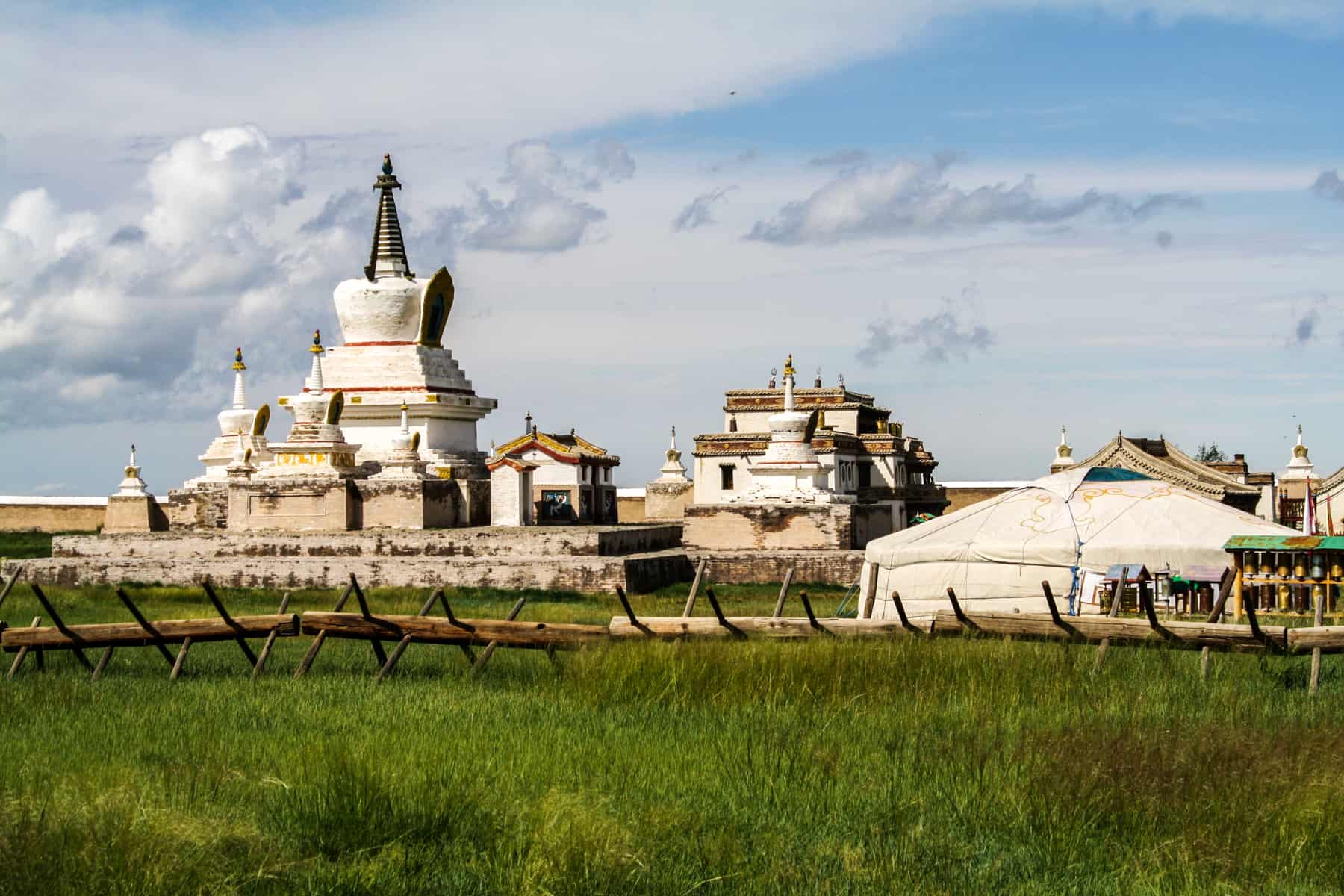
Part of the temple complex inside Mongolia’s Erdene Zuu Monastery
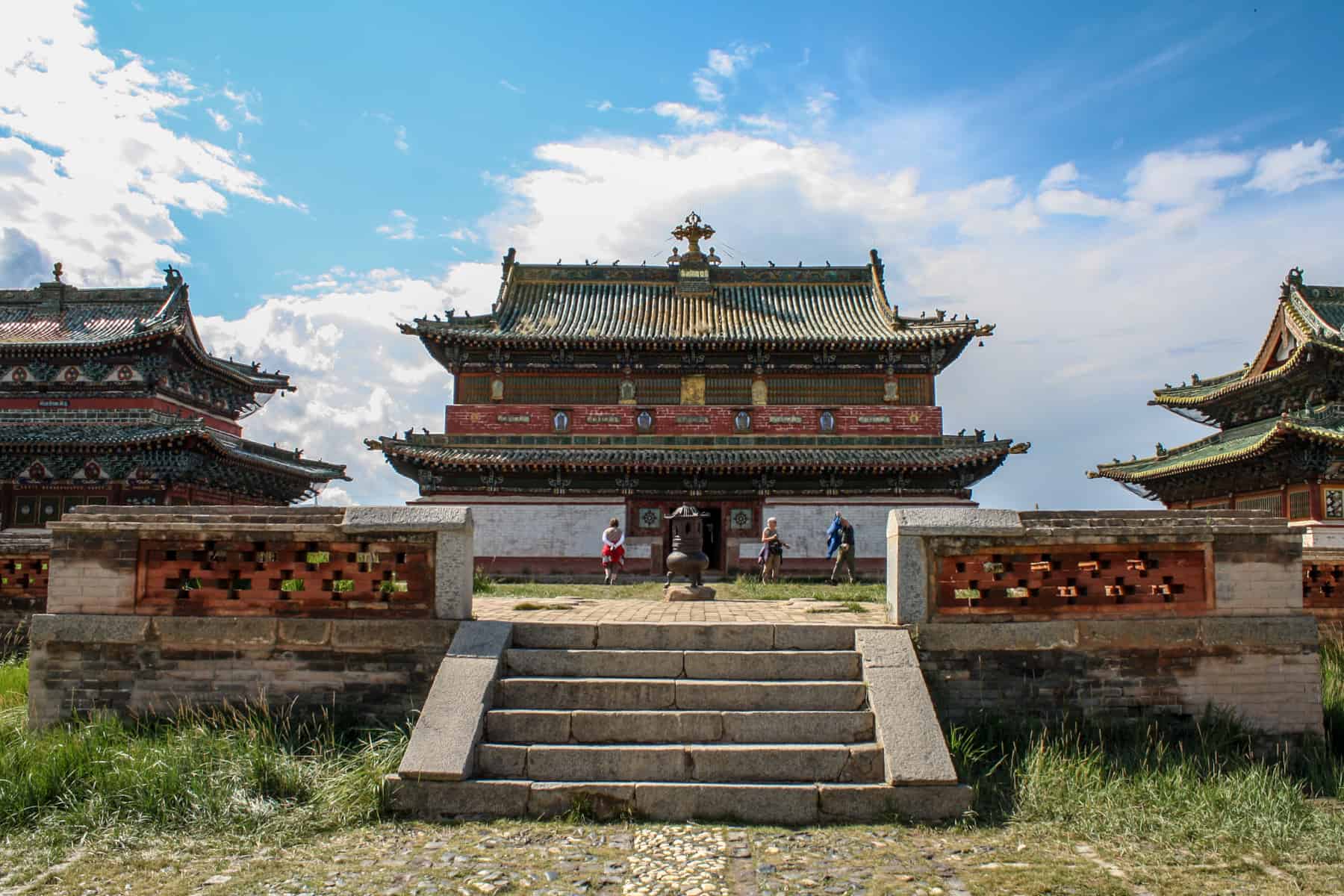
The red, gold and green temple structures at Erdene Zuu Monastery
A visit to the museum we camped next to – the Kultigen Monument, housing artefacts from the Turkish empire – set us on the way to the nearby Ugii Lake, where we would relax all day and camp for one night.
Ugii lake emits a calming atmosphere and invites you to traverse it slowly. While it would take almost a day to walk around, it’s a great place to unwind and reflect. I count this as one of my most favourite spots in all of Mongolia.
Our camping set-up beside Ugii Lake in Mongolia
We arrived at Hustain National Park in the afternoon to settle into a ger camp. This National Park is known for the rare Przewalski’s horse, unique to Mongolia. When you finally track down a small group, it’s still hard to see their beauty up close as you can’t get that close to them.
Still, we got to meet the ‘Best Mongolian Folk Band in Mongolia’ called Domog in the evening after a fantastic show where they performed rock-style tunes via the famed throat singing. I guess it is the equivalent of meeting Westlife in Ireland. Seriously.
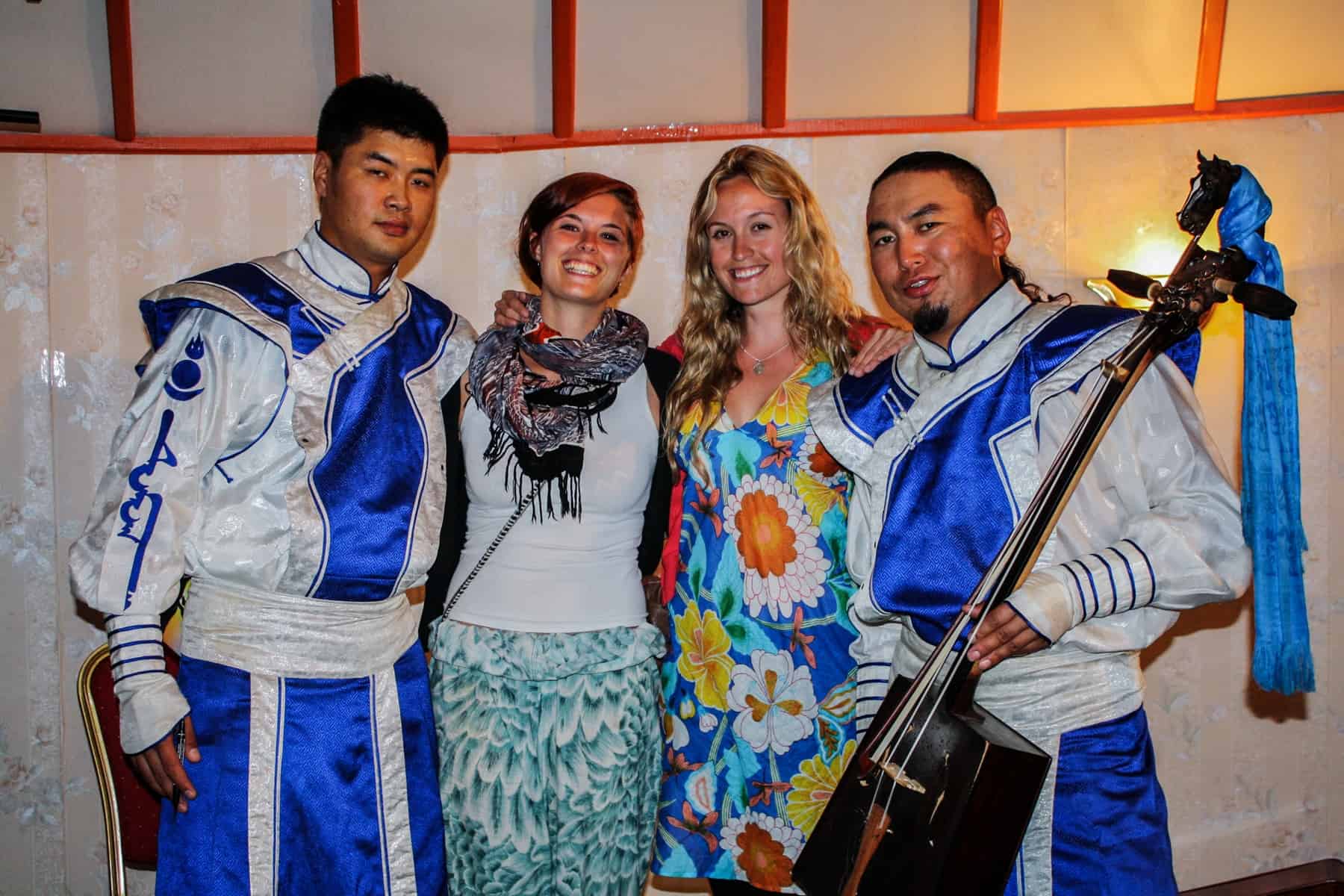
Meeting Damog, the Best Mongolian Folk Band in Mongolia
We had to journey back through the crazy, construction-overloaded, traffic-ridden Ulaanbaatar to get to Terelj National Park and the last ger camp of the trip (we were due to bush camp the weather put a stop to that).
It’s incredible how a few hours down the road from the capital brings you to some of the country’s most spectacular landscapes.
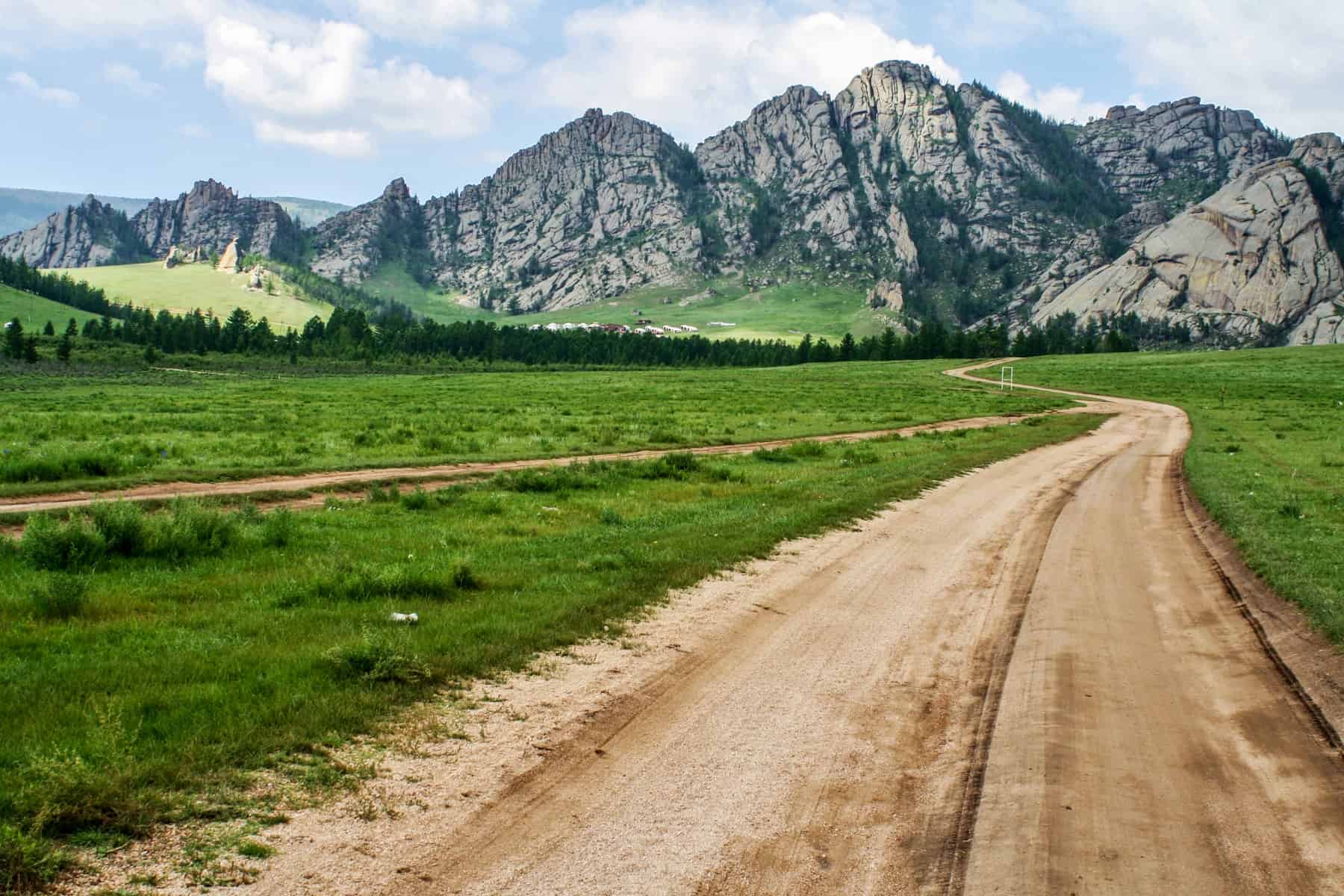
The road that leads to the heart of Terelj National Park, Mongolia
If you love walking and hiking, you will love Terelj National Park. Here you can wander for hours, hike to a Monastery and horse ride through the forests and rocky hilltops. Make sure you check out ‘Turtle Rock’ too. You may think it looks like something else from a certain angle!
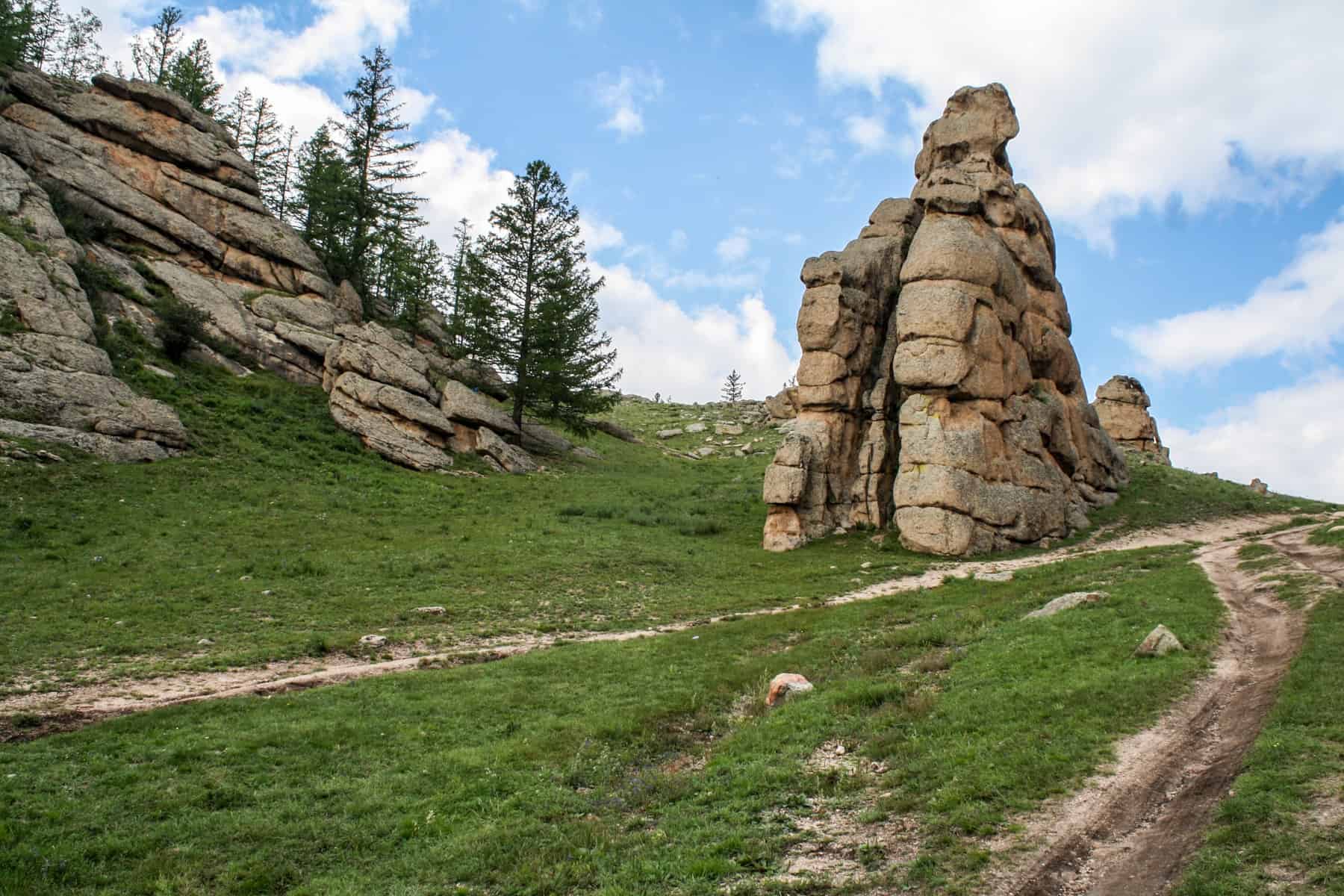
One of the layered rock formations in Terelj National Park in Mongolia
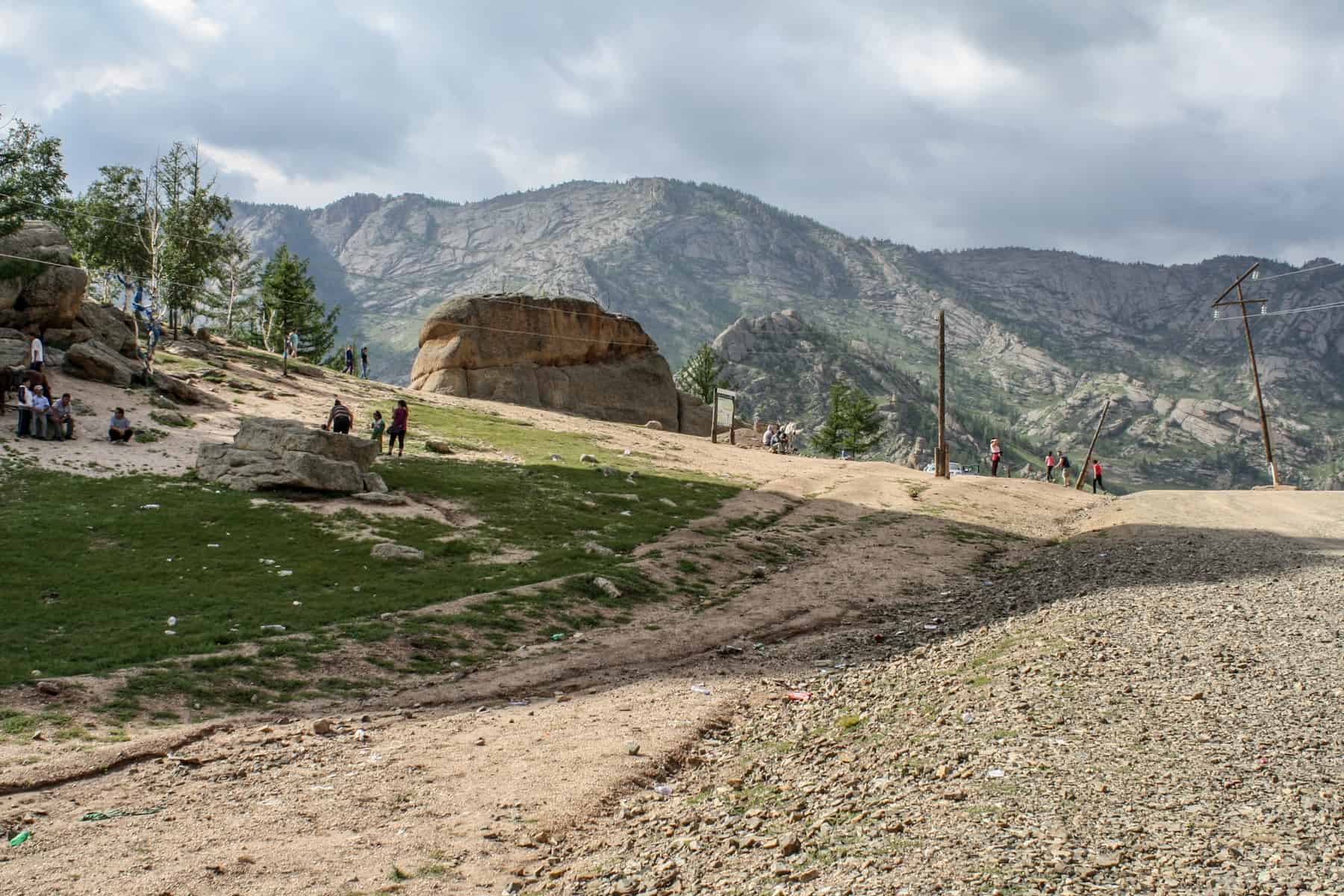
Visiting Turtle Rock in Terelj National Park Mongolia, named for its shape similar to the animal
Nothing beats the end of the wilderness journey than a visit to the giant 40-metre tall silver Ghengis Khan statue just outside of Ulaanbaatar on the banks of the Tuul River. Legend has it that it was at this spot that Ghengis Khan found his golden whip. Anyhow, a bit of a pilgrimage spot for locals, it was fascinating (if not a bit odd and imposing in the same way a colossal silver statue of Hitler in Germany would probably evoke the same feeling).
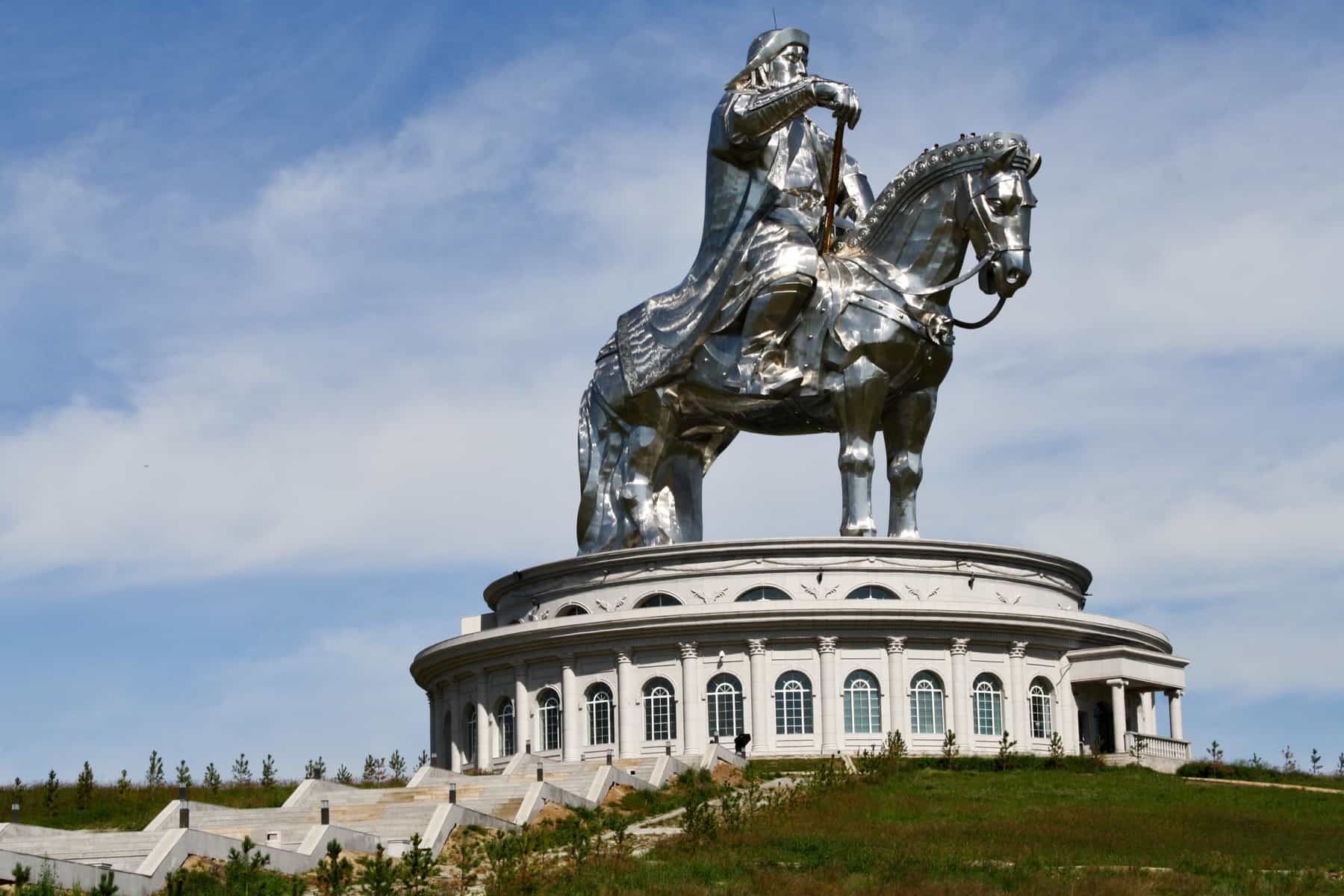
40-metre tall silver Ghengis Khan statue just outside of Ulaanbaatar, Mongolia
Back in Ulaanbaatar, I turned my hostel room into an office and distracted myself with a pizza slice, cake and coffee at Wendy’s Bakery – worth a visit alongside the State Department Store, which is right next to the hostel area. It’s an excellent chance to rest up after adventure through the vast landscapes of Mongolia.
The Dragoman overland truck is what we called home, except we didn’t sleep on it overnight. Instead, we went wild camping and every night, checking into a hotel once when the rains were too much to settle a tent comfortably.
The Outside
The truck’s exterior has lots of compartments – storage for luggage and tents and a clean water supply, mealtime equipment and food supplies. It’s a travelling transformer, and everyone has to lend a hand setting up and packing down for breakfast, lunch and dinner.
If you have no sense of camaraderie or hate getting dirty, then this isn’t the kind of adventure trip for you. I embraced it and loved every minute of ‘roughing it’.
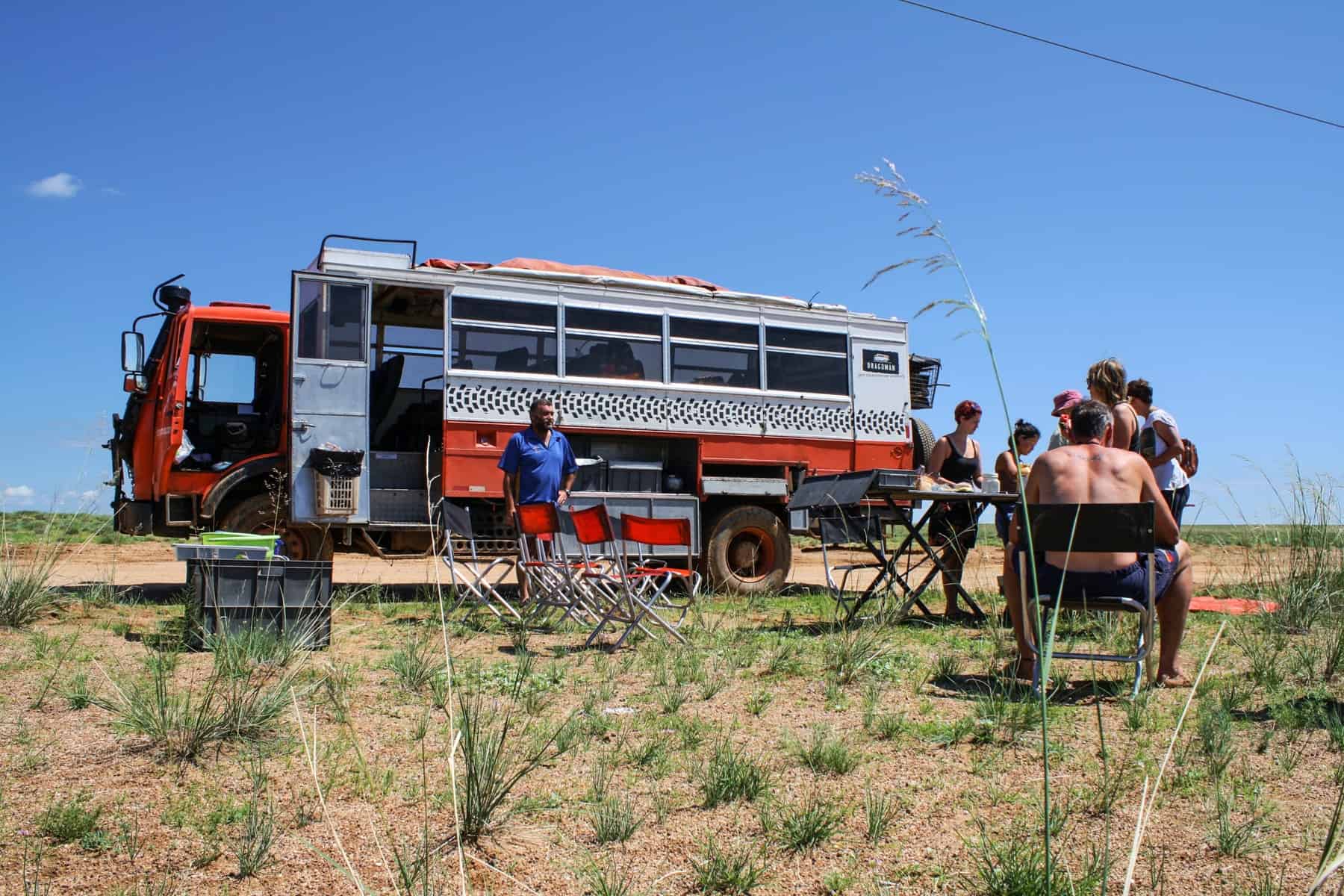
Travel in Mongolia was mostly about camping.
Twenty-three seats, a fridge, a safe, a bookshelf, prominent speakers and a place to recharge equipment, this is where we spend hours at a time, or what could end up being an entire day, traversing the landscape. We filled it with our belongings like a messy bedroom and made it cosy.
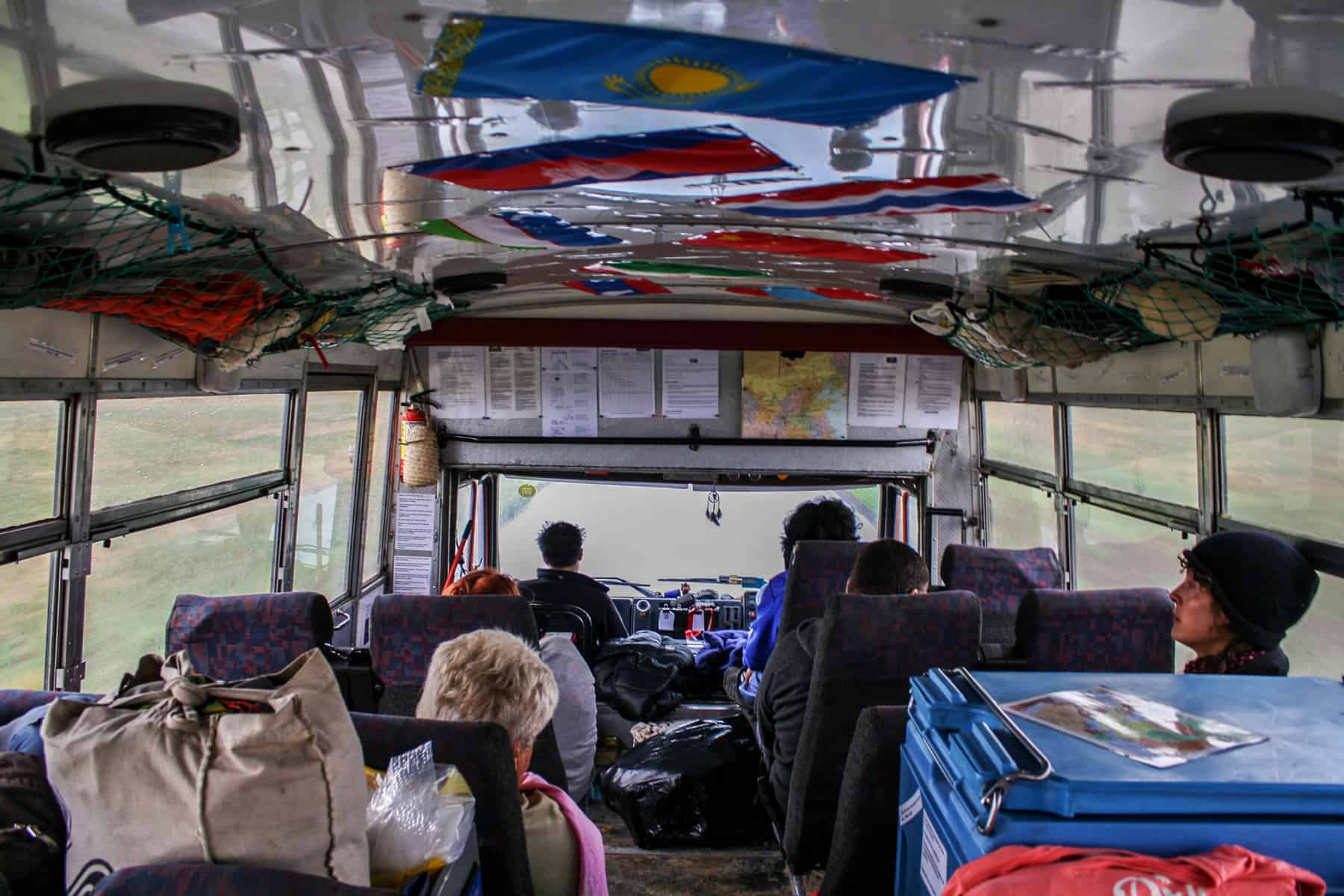
Inside the Overlanding truck on the journey travelling Mongolia
Along the Way
The two drivers are the mechanics, the navigators and the troubleshooters. Everything about the truck, from where it goes and how it gets there, hangs on their decision making, alongside our Mongolian guide who knew the land better than anyone else and could speak the language when we needed to call upon locals for help.
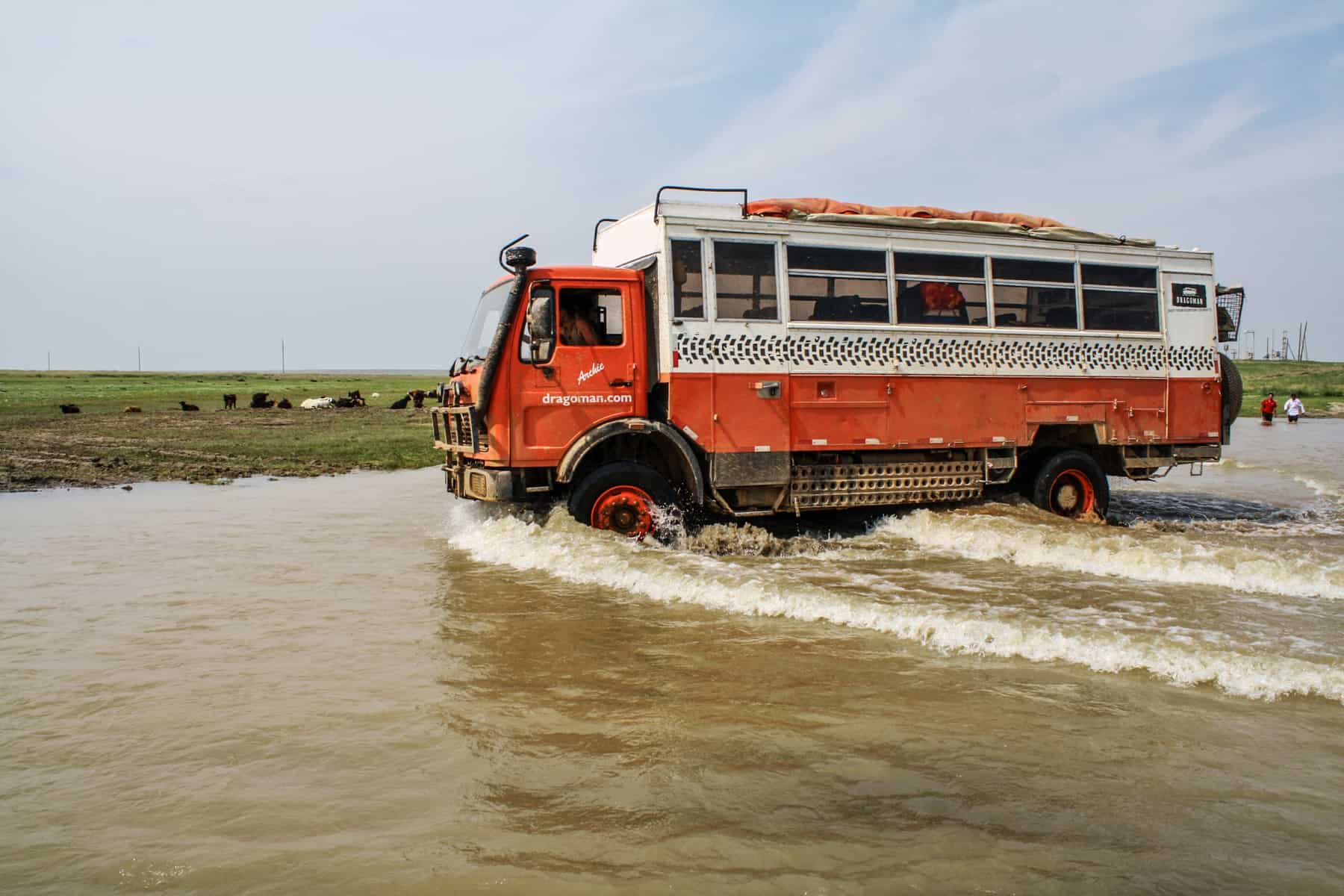
Overlanding in Mongolia was a real adventure.
Although the drivers would jump out to check the road, walking far ahead to determine the best track to take or check waterlogged areas (often by getting in the water) to limit the truck’s chances of getting bogged. We often stopped to help locals whose cars were stuck, knowing that karma would need to be returned one day.
The Realities of Rural Travel in Mongolia
“Ok, guys, you have to get off. It’s not looking good.” This phrase, accompanied by the engine’s low hum and strain as it finally gave up, became a regular occurrence during the three weeks I spent in Mongolia. Getting dirty in Mongolia is a given, but I never thought on my travels that I would push a truck out of thick, stodgy mud, build a road complete with a dam or wade knee-deep through a river to get to the other side.
In Mongolia, aside from the small handful of roads available, you will take the path less travelled, one that hasn’t been used for days or worn in by other vehicles for an easy pass. You could call it bad luck, or you could call it a reality, but travel comes with its challenges and getting stuck in Mongolia is by far the most common. While I wasn’t expecting substantial bogging incidents on this trip, I began to embrace them when they did happen. After all, the locals have to face these situations regularly. It became a part of what Mongolia is and what it means to cross her lands.
The drivers of the truck were responsible for assessing each situation when it arose. They were the first to get dirty, walk through the water and determine the outcome. At times it put you on edge, wondering how long you would be stuck somewhere with no one passing by for hours. At other times it merely meant us having to walk a short distance to lighten the truck.
Either way, the result was a massive whoop and roar for our truck, Archie, when he made it through. It felt good, and we then knew the next stage of the journey could begin. These are the times I’ll always remember.
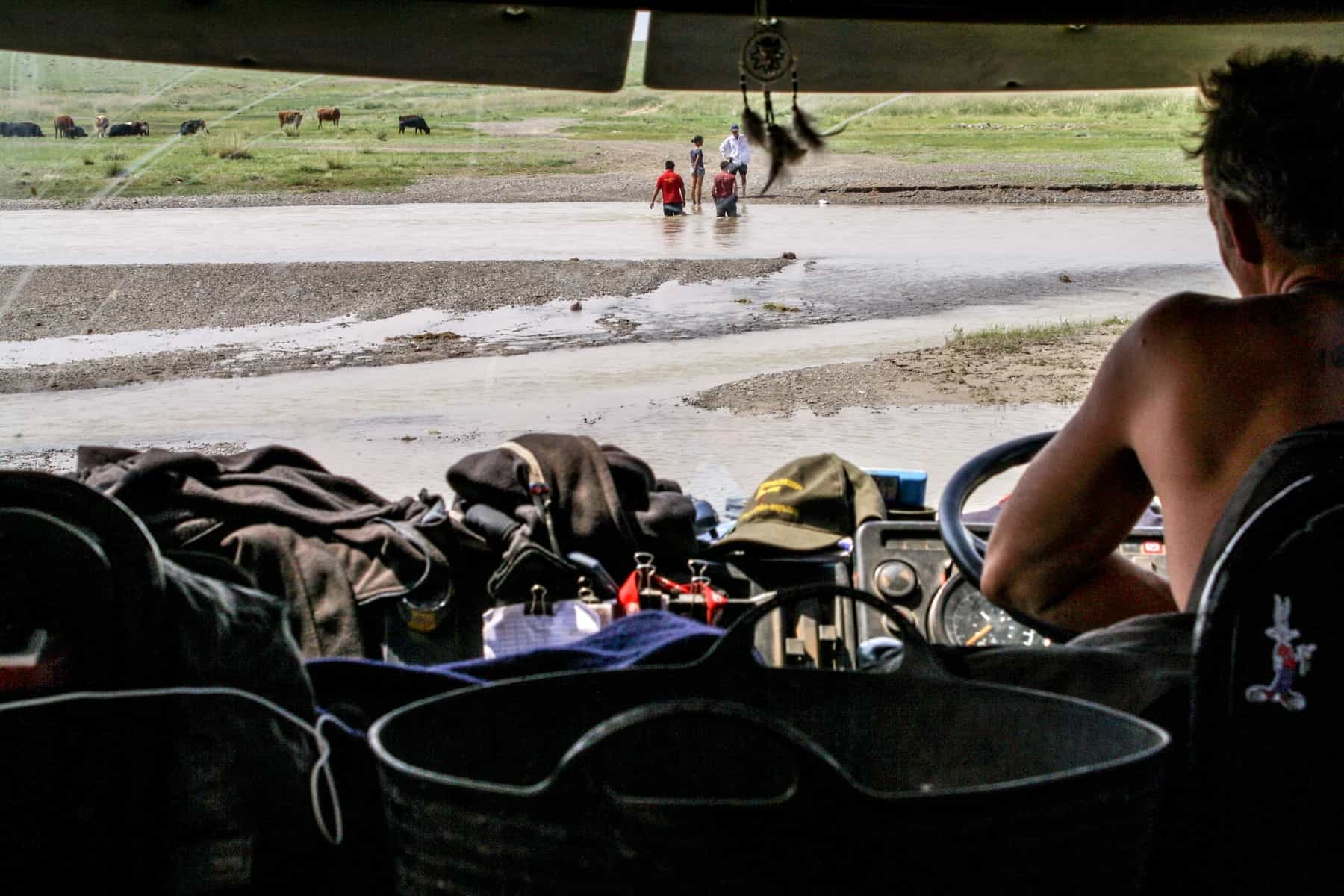
Our group helps find a track in the water for the truck to pass in Mongolia.
It had been raining on and off for a few days, mainly in short spurts in the evenings, and we were bumping along the wet dirt tracks just fine. When the truck stopped, and we saw that two pools of water had filled two road tracks, we knew a bogging incident was imminent. The drivers walked, pondered and walked through the water. Could we drive through it without getting stuck?
The usual scenario rested on two possibilities – drive through it or find hard enough ground around it. Except that this time it was different. We were told: “We need to empty this road of water and then let the ground dry out so we can cross over it.”
Cue the mad dash to empty our camping gear to find our plastic washing-up bowls and any other form of a plastic container to begin the removal process. The ladies rolled up their shorts to get right in there and scoop out the water as the men started digging to create a road. Everyone built a dam by hand on each side of the tyre track grooves so that the emptied water wouldn’t flow back in.
It was hard work, but we became a team, a great team. The sun was shining that day which meant we only had to wait a couple of hours while the heat dried out our creation. We ate, we played, we sang, and we marvelled at what resourceful people we were. It was a scary moment when Archie made his move to cross our road (our beautifully crafted highway that could be crushed in seconds and need rebuilding), but he made it in one unbeaten run, and our handmade route was left to the land and in nature’s control.
Happening upon grassy, muddy areas is sporadic. You can never tell exactly how hard the ground is beneath it. After bouts of rain, the ground softens, and even though there were times when the truck had to work a little harder, it made it through.
We had just had a fantastic afternoon checking out a local Nadaam festival and were in high spirits, which we needed knowing that we would be driving for the rest of the day. Except we didn’t – we were soon stuck in thick, sticky mud, and no amount of pushing and revving was going to change it.
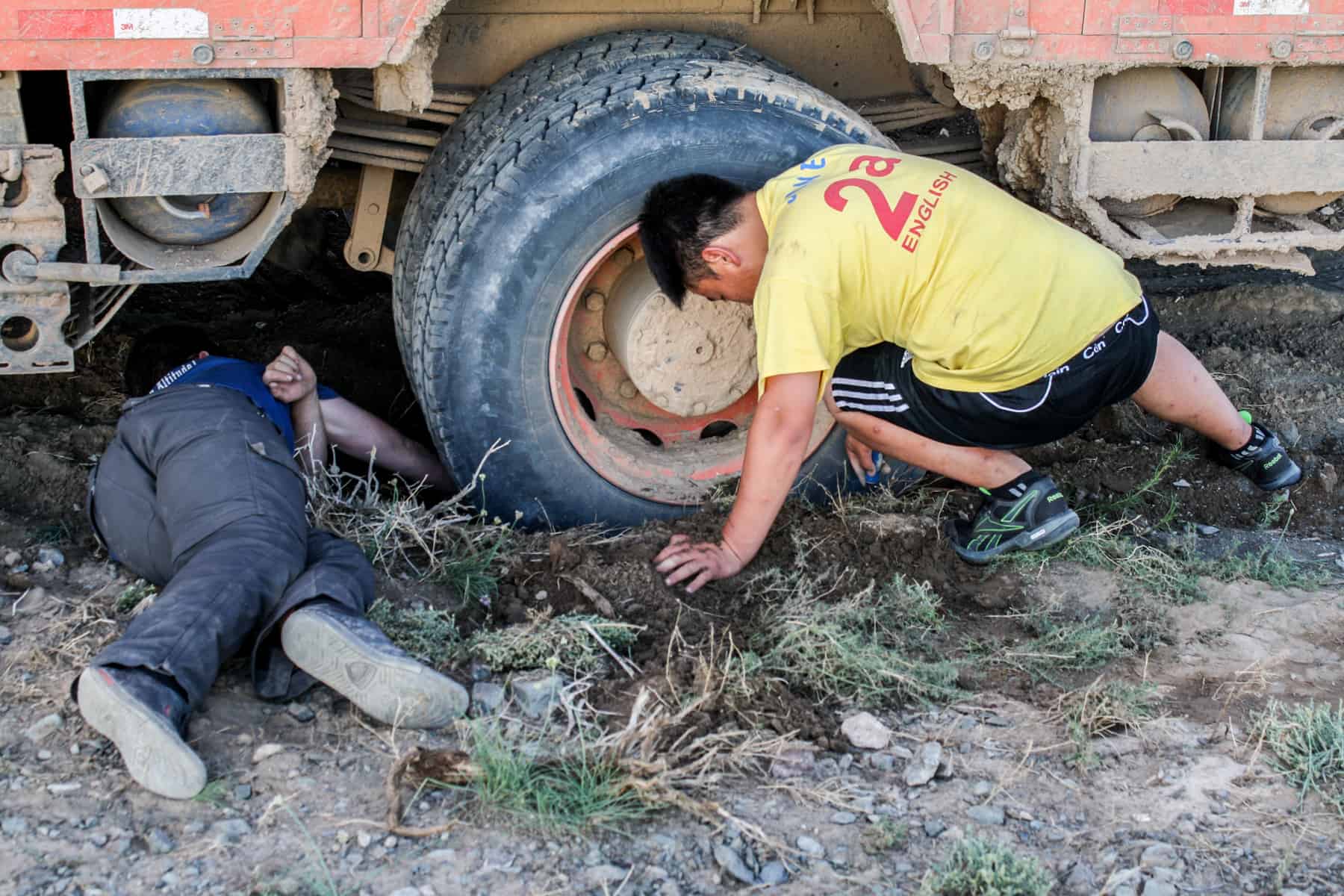
Digging out the truck wheels from the deep, wet mud in Mongolia
Our Mongolian guide walked to the nearest ger to get help, and the locals later returned on a motorbike to check out the situation. The whole family came out – we regularly became a source of fascination or amusement en route through the country. However, they kindly decided to use their big, industrial tractor to help pull the truck out of the mud – that too got stuck.
With two vehicles out of action and night starting to fall, we decided to set up camp on a drier patch of land nearby, and the drivers worked relentlessly with the locals throughout the evening. We got bogged at 5 pm, and it took until midnight for the truck to be pulled from sludge. It was a day wasted, but another example of how unpredictable travelling here can be.
When the truck stops dead at a deep area of water, you know the situation isn’t going to be resolved quickly. Can a truck this size pass through a river without sinking or getting stuck? Although we enjoyed paddling in the freshwater, we didn’t know whether we could have to completely re-route to get around it and lose more time.
The conclusion was that there was a distinct lack of knowledge about alternative roads around the river, and somehow we would have to find a way to get through it. With a small truck already stuck right in the middle, it was a scary prospect.
The drivers identified the most shallow and hard ground area in the water to pass, although we couldn’t be on the truck, unfortunately. You can imagine the chaos – a group of locals trying to rescue their vehicle and 20 non-locals trying to navigate through the water, knee-deep and screeching, scared of falling in.
My heart skipped a beat watching our truck splash through the water and wondering whether it would stop dead in its tracks and slowly swim in a sea of mud, taking all our belongings with it. But Archie made it, and this time, he got the biggest cheer. And a giant sigh of relief.
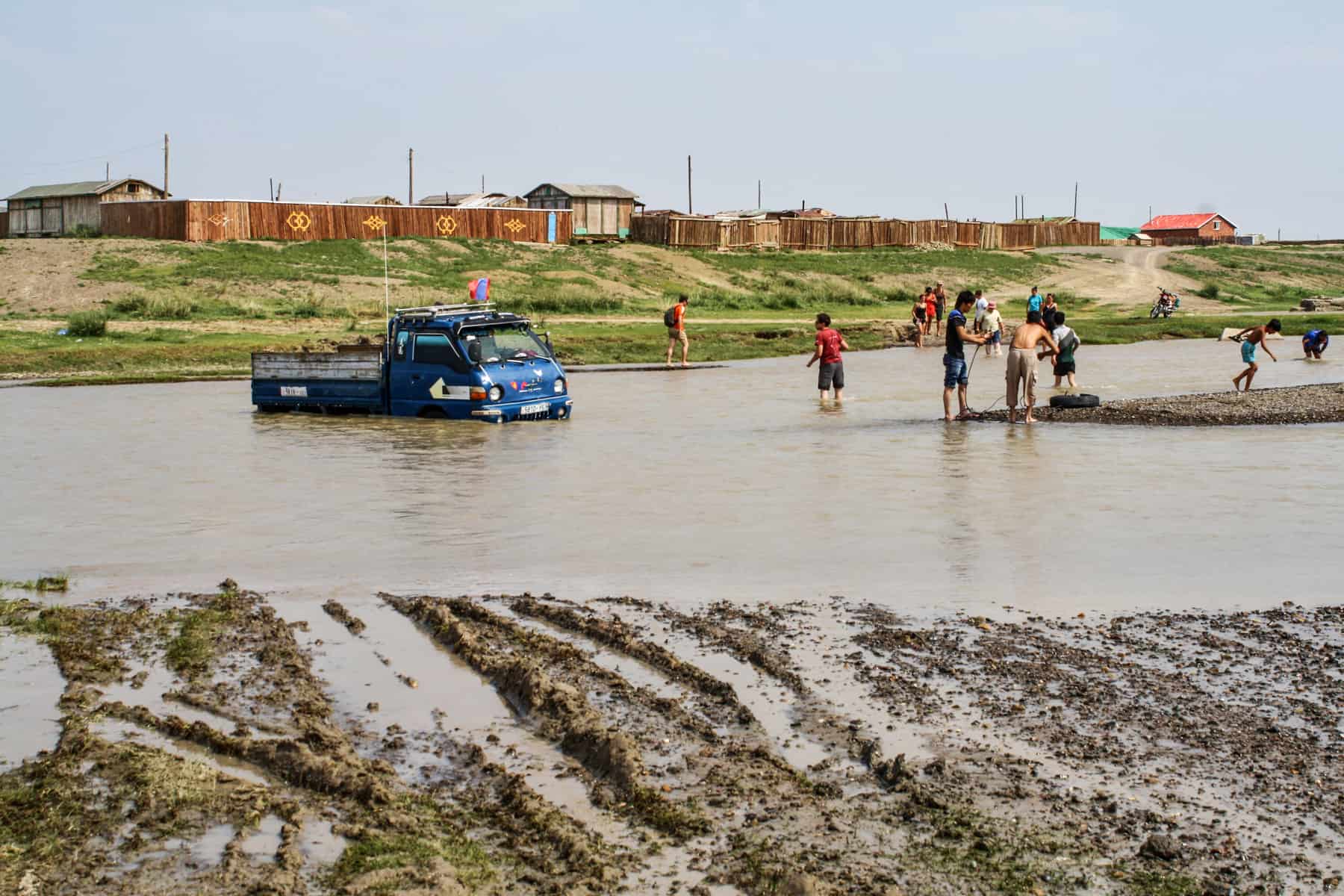
Typical river crossings in Mongolia and helping out locals who were also stuck
With unpredictable weather conditions, a challenging landscape to navigate and a trip mostly comprised of wild camping, packing for Mongolia requires some planning. In short, you need to factor in the following:
- Items of clothing that you don’t mind getting dirty and wholly ruined.
- Clothing layers for the constant switch of hot and cold climates – thermals to moisture-wicking and waterproof items.
- Sun protection and bug spray for mosquitos and sandflies.
- All medications you need as you’ll often be far from any significant stores or aid.
- Snacks from home as the food variation can get very repetitive.
For a more extensive overview, read my full Mongolia Packing List .
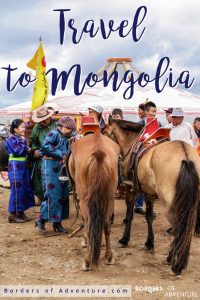
About Becki
Becki Enright is a British Travel Press Award-winning writer whose work focuses on changing perceptions about misunderstood aspects of destinations. Her writing combines storytelling with insight into the social, historical, political and economic factors that shape the country or place in relation to tourism. Becki has appeared live on Sky News and CNN and has contributed to high profile media including National Geographic, Time.com, Guardian online, New York Times, Grazia and Buzzfeed.
- Article Archives
- Work with me
- Privacy Policy

- About Zavkhan Trekking
- Ethical Policy
- Community Project
- The Wider World
Amazing Horse Riding & Hiking Adventures in Mongolia, Kazakhstan, and Siberia
No hotels, no hot showers, no tourism, just fantastic riding and hiking, and fascinating culture in untouched corners of the world!
Looking for the adventure of a lifetime?
One of our off-the-beaten-track horse treks or hikes may be just what you are looking for.
Meet the local people and experience their unique culture
Whether by horse, or on foot, our 'slow travel' will immerse you in the traditional lifestyle of Mongolia's nomadic herders.
Come travel with us to...
A little about Zavkhan Trekking
Zavkhan Trekking is a Mongolian-New Zealand partnership, offering you the opportunity to get far off the beaten track and explore Mongolia, Kazakhstan, Siberia, and beyond, in the most authentic way possible - by horse.
Not tempted by horse riding? We also arrange hiking trips and other adventures.
Six good reasons to travel with Zavkhan Trekking
Team up with adventurous travellers just like you. When we say 'small group', we mean just that - a maximum of 10 people. A perfect number for sitting around the campfire in the evening.
We specialise in taking you to remote areas where tourism has barely reached - the sort of places we like to travel ourselves. Immerse yourself in the fascinating traditional cultures of our local friends.
To really experience this region the most authentic way is on horseback, and these are the world's best horses! Don't worry if you're not a rider, we have horses that will look after you.
When we say remote we mean really remote, so your safety and enjoyment while travelling with Zavkhan Trekking is our priority. With our local team, you are in safe hands.
2024 will be our 20th year of running treks in this part of the world, so you can trust our team to give you a truly memorable adventure.
By trekking with us you help support sustainable livelihoods in the communities you visit, while minimising the impacts of your travels on the local environment and traditional cultures.
Let us create your perfect trip
Gather up a group of friends and let's talk about private trip options. The countries we visit have many hidden corners just waiting for intrepid riders to explore.
If the thought of riding off over the horizon on a horse doesn't fill you with joy, perhaps a ground-based hiking trip will be more to your liking. How about cycling? Ask us what we can do.
Check out our Mongolian team in action in Zavkhan Province.
To see more videos from our past treks, go to our Gallery page
Are you ready for an ultimate trekking adventure?
Get in touch with our team today, we're always keen to chat about how we can help..

IMAGES
VIDEO
COMMENTS
Rome2Rio makes travelling from Mongolia to Kazakhstan easy. Rome2Rio is a door-to-door travel information and booking engine, helping you get to and from any location in the world. Find all the transport options for your trip from Mongolia to Kazakhstan right here.
How to get from Mongolia to Kazakhstan without flying. From my research, I found two ways to get to Kazakhstan from Mongolia: A bus from Olgii, a city in west Mongolia, that travels to Astana via Russia. This is a cheaper option, but it is unreliable - only leaving every 7-10 days, making visa planning a logistical nightmare.
Mongolian citizens do not need a tourist visa when travelling to Kazakhstan in 2024. Mongolian passport holders can stay in Kazakhstan for a short period of time (for 90 days). Please, read all the information below to make your trip easy and safe. Don't rely on information from only one source. Please, with at least one more source listed in ...
Khovd - Urumqi - Almaty. From Mongolia, a van leaves Khovd for Bulgan in the afternoon most days (25$/seat). From there, take a taxi to the border, and once across, a taxi or bus to Takashiken or Urumqi. To Urumqi, it will be 7 hours by taxi for approx. 40$/seat, or 10 hours by bus for 30$.
The cheapest flight deals from Mongolia to Kazakhstan. Almaty.$605 per passenger.Departing Thu, Apr 4, returning Thu, Apr 11.Round-trip flight with Hunnu Air.Outbound direct flight with Hunnu Air departing from Chinggis Khaan on Thu, Apr 4, arriving in Almaty.Inbound direct flight with Hunnu Air departing from Almaty on Thu, Apr 11, arriving in ...
Kazakhstan shares borders with Russia, China, Kyrgyzstan, Uzbekistan and Turkmenistan. For an exact location of these and all other border crossings on the Silk Road, see the border crossing map. For more info on visas, check out the Kazakhstan visa chapter. Table of Contents. Kazakhstan - Mongolia.
Rome2Rio makes travelling from Kazakhstan to Mongolia easy. Rome2Rio is a door-to-door travel information and booking engine, helping you get to and from any location in the world. Find all the transport options for your trip from Kazakhstan to Mongolia right here.
Kazakhstan's landscapes are beautiful year-round. In winter, the steppe is covered in a light dusting of snow. Spring brings a brief flush of tulips and green grass, summer a scorching sun and the sound of crickets. In autumn, the golden foliage of mountain trees serves as a final reminder of the fading heat.
The cheapest flight deals from Mongolia to Kazakhstan. Almaty. ₹ 21,475 per passenger.Departing Thu, 15 Feb.One-way flight with Hunnu Air.Outbound direct flight with Hunnu Air departs from Chinggis Khaan on Thu, 15 Feb, arriving in Almaty.Price includes taxes and charges.From ₹ 21,475, select. Ulaanbaatar to Almaty.
The cheapest flight deals from Mongolia to Kazakhstan. Almaty. £423 per passenger.Departing Mon, 29 Apr, returning Mon, 6 May.Return flight with Hunnu Air.Outbound direct flight with Hunnu Air departs from Chinggis Khaan on Mon, 29 Apr, arriving in Almaty.Inbound direct flight with Hunnu Air departs from Almaty on Mon, 6 May, arriving in ...
If you decide to travel to Kazakhstan: Enroll in the Smart Traveler Enrollment Program ( STEP) to receive Alerts and make it easier to locate you in an emergency. Follow the Department of State on Facebook and Twitter. Review the Country Security Report for Kazakhstan. Visit the CDC page for the latest Travel Health Information related to your ...
This is the most complete and updated online guide to travel in Kazakhstan. If you find yourself fascinated by this vast, beautiful country and love unusual destinations, this travel guide will tell you everything you need to know to prepare you to visit Kazakhstan.. Kazakhstan, a former Soviet republic, is a Central Asian country that extends West from the Caspian Sea to the Altai Mountains ...
Altai Explorer. Join us on this truly groundbreaking tour as we travel through the forgotten lands of Kazakhstan, Russia and Mongolia. We journey to the heart of the Altai Mountains to a land steeped in shamanism and ancient traditions. We start in Kazakhstan, flying from Almaty to the eastern capital of Ust-Kamenogorsk, the gateway to the Altai.
I'm taking a gap year next year with some friends and part of our chosen route involves getting from Mongolia to Kazakhstan. We are on a budget and have 2 options. We can either take a plane which has a connection in Beijing (yes it fits backwards for some reason) which'll cost around $650.
Table of Contents. One Week in Kazakhstan: A Sample Itinerary. Day 0: Arrive in Almaty. Day 1: Almaty City Tour. Day 2: Hiking in Medeu and Shymbulak (Chimbulak) Day 3: Day Trip to Big Almaty Lake. Day 4: Charyn Canyon. Day 5: Kaindy Lake. Day 6: Kolsai Lakes National Park.
Compare cheap Kazakhstan to Mongolia flight deals from over 1,000 providers. Then choose the cheapest plane tickets or fastest journeys. Flight tickets to Mongolia start from $287 one-way. Set up a Price Alert. We price-check with over 1,000 travel companies so you don't have to.
The cheapest flight deals from Mongolia to Kazakhstan. Almaty.$882 per passenger.Departing Sat, 18 May, returning Tue, 21 May.Return flight with Hunnu Air.Outbound direct flight with Hunnu Air departs from Chinggis Khaan on Sat, 18 May, arriving in Almaty.Inbound direct flight with Hunnu Air departs from Almaty on Tue, 21 May, arriving in ...
Do Kazakhstan citizens need a visa for Mongolia? Kazakhstan citizens do not need a tourist visa when travelling to Mongolia in 2024. Kazakhstan passport holders can stay in Mongolia for a short period of time (for 90 days). Please, read all the information below to make your trip easy and safe.
With the In-depth Cultural tour Central Asia 5 Stans and Mongolia, you have a 31 days tour package taking you through Tashkent, Uzbekistan and 17 other destinations in Asia. Central Asia 5 Stans and Mongolia includes accommodation in a hotel as well as flights, an expert guide, insurance, meals, transport and more. Expand All.
Just do it. Trust me. It personally saved me $3,000 when I broke my collarbone in Mongolia last summer. [Note: For travel insurance, Live Like it's the Weekend recommends World Nomads or SafetyWing for the best budget options with the most coverage. If you want to read more about my experience with travel insurance, click here).
Call us in Washington, D.C. at 1-888-407-4747 (toll-free in the United States and Canada) or 1-202-501-4444 (from all other countries) from 8:00 a.m. to 8:00 p.m., Eastern Standard Time, Monday through Friday (except U.S. federal holidays). See the State Department's travel website for the Worldwide Caution and Travel Advisories.
21 days visa-free: Philippines. 14 days visa-free: Hong Kong. 2 - Mongolia visa at an embassy: If you're not on the above list of countries, you should apply for your Mongolia visa at your nearest Mongolia embassy. To apply for a tourist visa, you'll need: Completed application form. 3.5×4.5cm photo.
Where to Go in Mongolia - Itinerary. Day 1: Visiting Ulaanbaatar. Day 2: Getting from Ulaanbaatar to the Gobi desert. Day 3: Visit the Baga Gazryn Chuluu Rock Formations. Day 4: Sleep at a Ger Camp in the Gobi Desert. Day 5: Dalanzagad to Gobi Discovery Ger Camp. Day 6: Hiking in Yolin Am - Mongolia's Ice Valley.
A little about Zavkhan Trekking. Zavkhan Trekking is a Mongolian-New Zealand partnership, offering you the opportunity to get far off the beaten track and explore Mongolia, Kazakhstan, Siberia, and beyond, in the most authentic way possible - by horse. Not tempted by horse riding?